Saccharine Black & White Stock Photos
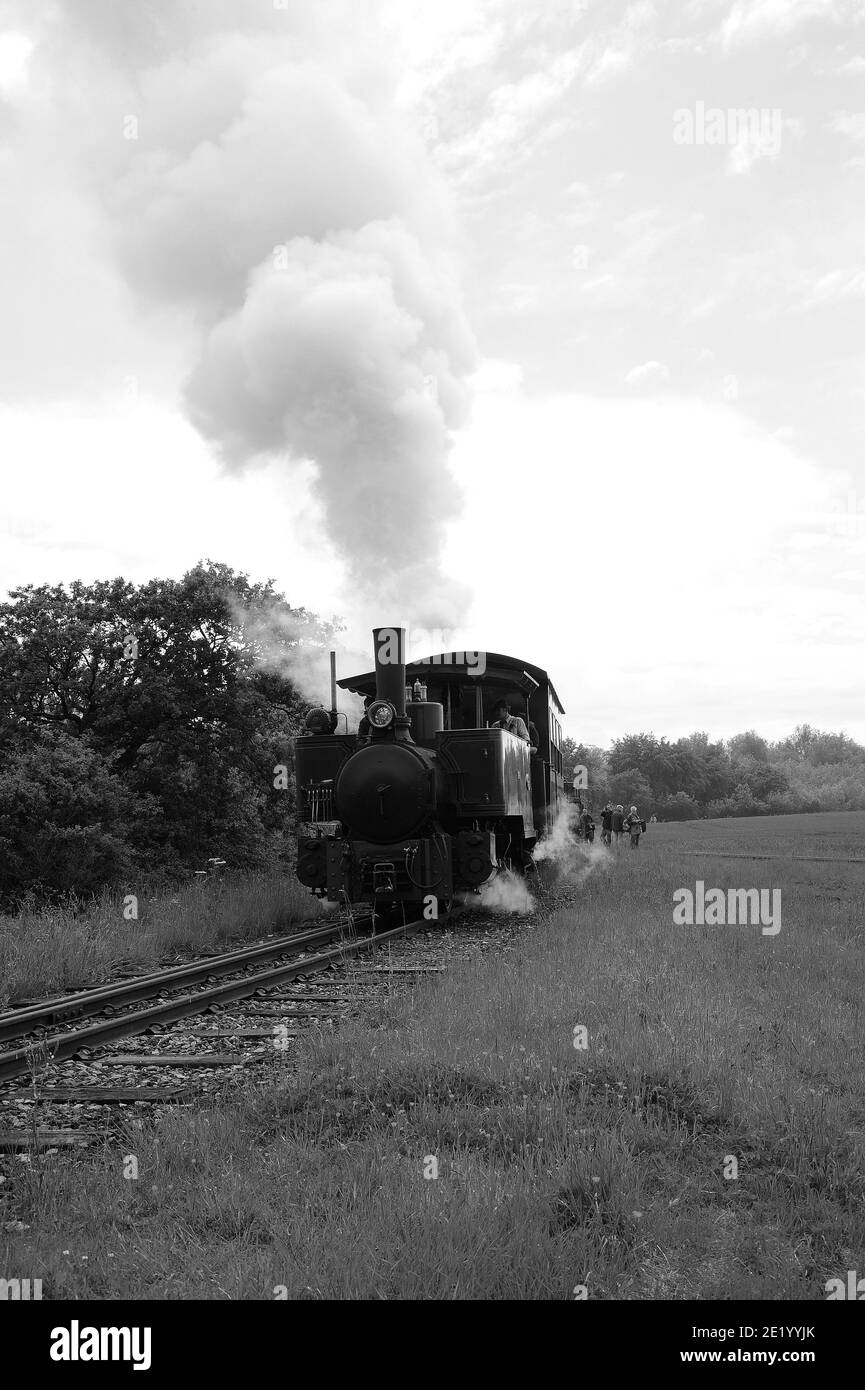 'Saccharine' entering the balloon loop. Stock Photohttps://www.alamy.com/image-license-details/?v=1https://www.alamy.com/saccharine-entering-the-balloon-loop-image397067515.html
'Saccharine' entering the balloon loop. Stock Photohttps://www.alamy.com/image-license-details/?v=1https://www.alamy.com/saccharine-entering-the-balloon-loop-image397067515.htmlRF2E1YYJK–'Saccharine' entering the balloon loop.
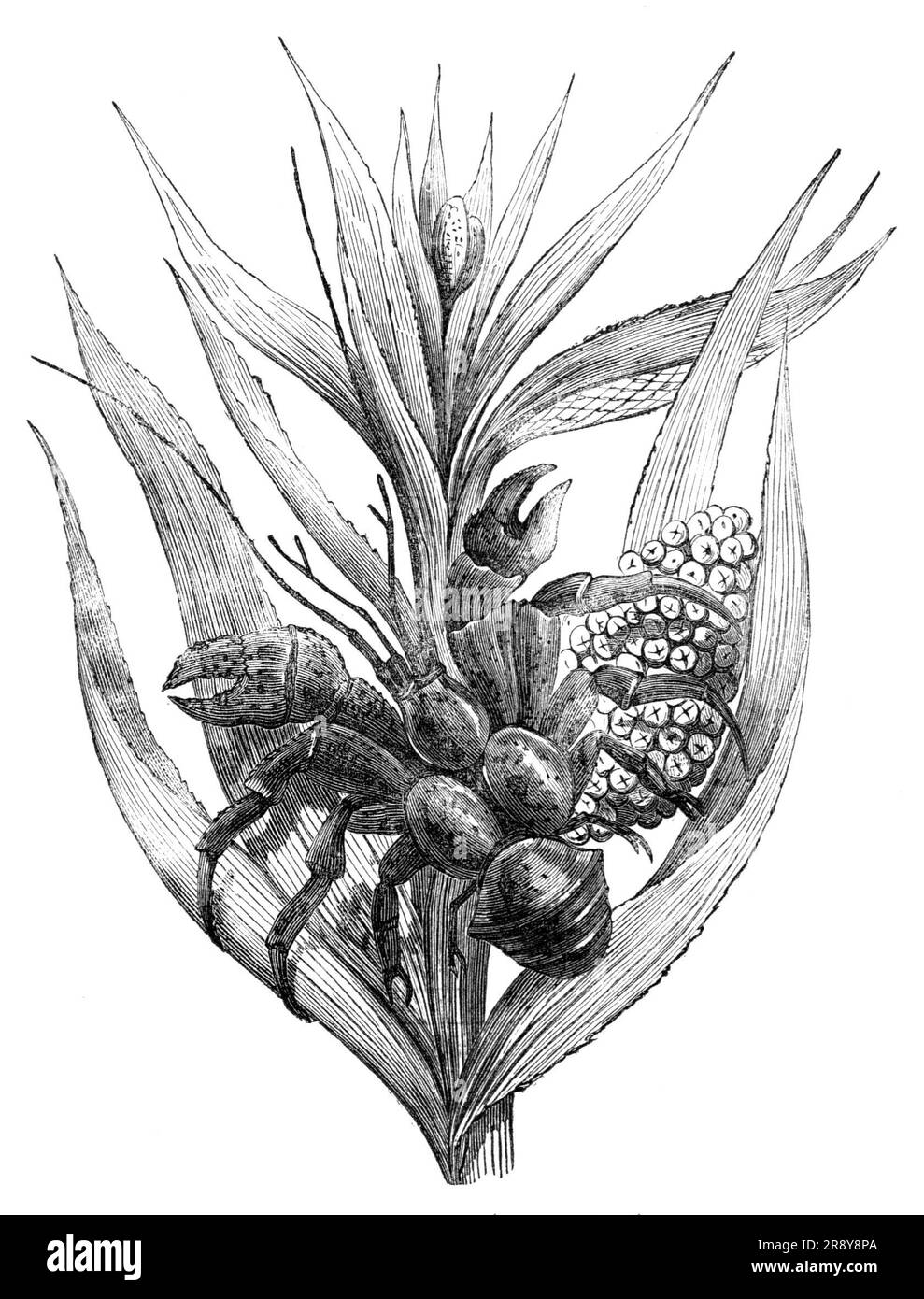 The Robber Crab (Birgus latro), 1857. Charles Darwin: 'The young are hatched and live for some time on the coast. At this period of existence we cannot suppose that cocoa- nuts form any part of their diet; most probably soft saccharine grasses, tender fruits, and animal matters constitute their food, until they attain to a certain degree of size and strength...It has been stated by some authors that the Birgus latro crawls up the cocoa-nut trees, for the purpose of stealing the nuts. I very much doubt the possibility of this; but with Pandanus (to which Mr. Cuming refers as being ascended by t Stock Photohttps://www.alamy.com/image-license-details/?v=1https://www.alamy.com/the-robber-crab-birgus-latro-1857-charles-darwin-the-young-are-hatched-and-live-for-some-time-on-the-coast-at-this-period-of-existence-we-cannot-suppose-that-cocoa-nuts-form-any-part-of-their-diet-most-probably-soft-saccharine-grasses-tender-fruits-and-animal-matters-constitute-their-food-until-they-attain-to-a-certain-degree-of-size-and-strengthit-has-been-stated-by-some-authors-that-the-birgus-latro-crawls-up-the-cocoa-nut-trees-for-the-purpose-of-stealing-the-nuts-i-very-much-doubt-the-possibility-of-this-but-with-pandanus-to-which-mr-cuming-refers-as-being-ascended-by-t-image556248626.html
The Robber Crab (Birgus latro), 1857. Charles Darwin: 'The young are hatched and live for some time on the coast. At this period of existence we cannot suppose that cocoa- nuts form any part of their diet; most probably soft saccharine grasses, tender fruits, and animal matters constitute their food, until they attain to a certain degree of size and strength...It has been stated by some authors that the Birgus latro crawls up the cocoa-nut trees, for the purpose of stealing the nuts. I very much doubt the possibility of this; but with Pandanus (to which Mr. Cuming refers as being ascended by t Stock Photohttps://www.alamy.com/image-license-details/?v=1https://www.alamy.com/the-robber-crab-birgus-latro-1857-charles-darwin-the-young-are-hatched-and-live-for-some-time-on-the-coast-at-this-period-of-existence-we-cannot-suppose-that-cocoa-nuts-form-any-part-of-their-diet-most-probably-soft-saccharine-grasses-tender-fruits-and-animal-matters-constitute-their-food-until-they-attain-to-a-certain-degree-of-size-and-strengthit-has-been-stated-by-some-authors-that-the-birgus-latro-crawls-up-the-cocoa-nut-trees-for-the-purpose-of-stealing-the-nuts-i-very-much-doubt-the-possibility-of-this-but-with-pandanus-to-which-mr-cuming-refers-as-being-ascended-by-t-image556248626.htmlRM2R8Y8PA–The Robber Crab (Birgus latro), 1857. Charles Darwin: 'The young are hatched and live for some time on the coast. At this period of existence we cannot suppose that cocoa- nuts form any part of their diet; most probably soft saccharine grasses, tender fruits, and animal matters constitute their food, until they attain to a certain degree of size and strength...It has been stated by some authors that the Birgus latro crawls up the cocoa-nut trees, for the purpose of stealing the nuts. I very much doubt the possibility of this; but with Pandanus (to which Mr. Cuming refers as being ascended by t
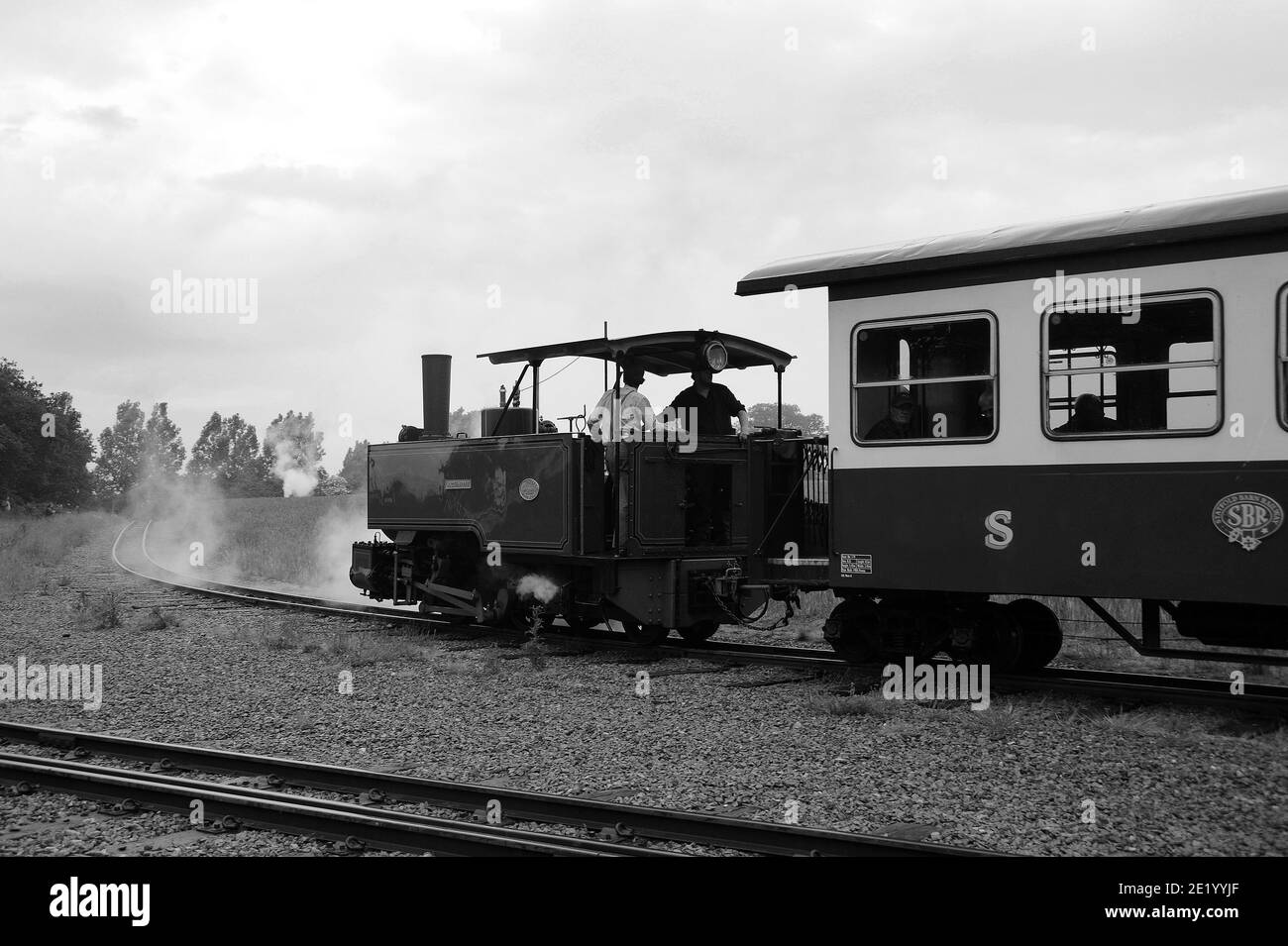 'Saccharine' at the rear of a train hauled by SBR No. 9 as it heads for the balloon loop. Stock Photohttps://www.alamy.com/image-license-details/?v=1https://www.alamy.com/saccharine-at-the-rear-of-a-train-hauled-by-sbr-no-9-as-it-heads-for-the-balloon-loop-image397067511.html
'Saccharine' at the rear of a train hauled by SBR No. 9 as it heads for the balloon loop. Stock Photohttps://www.alamy.com/image-license-details/?v=1https://www.alamy.com/saccharine-at-the-rear-of-a-train-hauled-by-sbr-no-9-as-it-heads-for-the-balloon-loop-image397067511.htmlRF2E1YYJF–'Saccharine' at the rear of a train hauled by SBR No. 9 as it heads for the balloon loop.
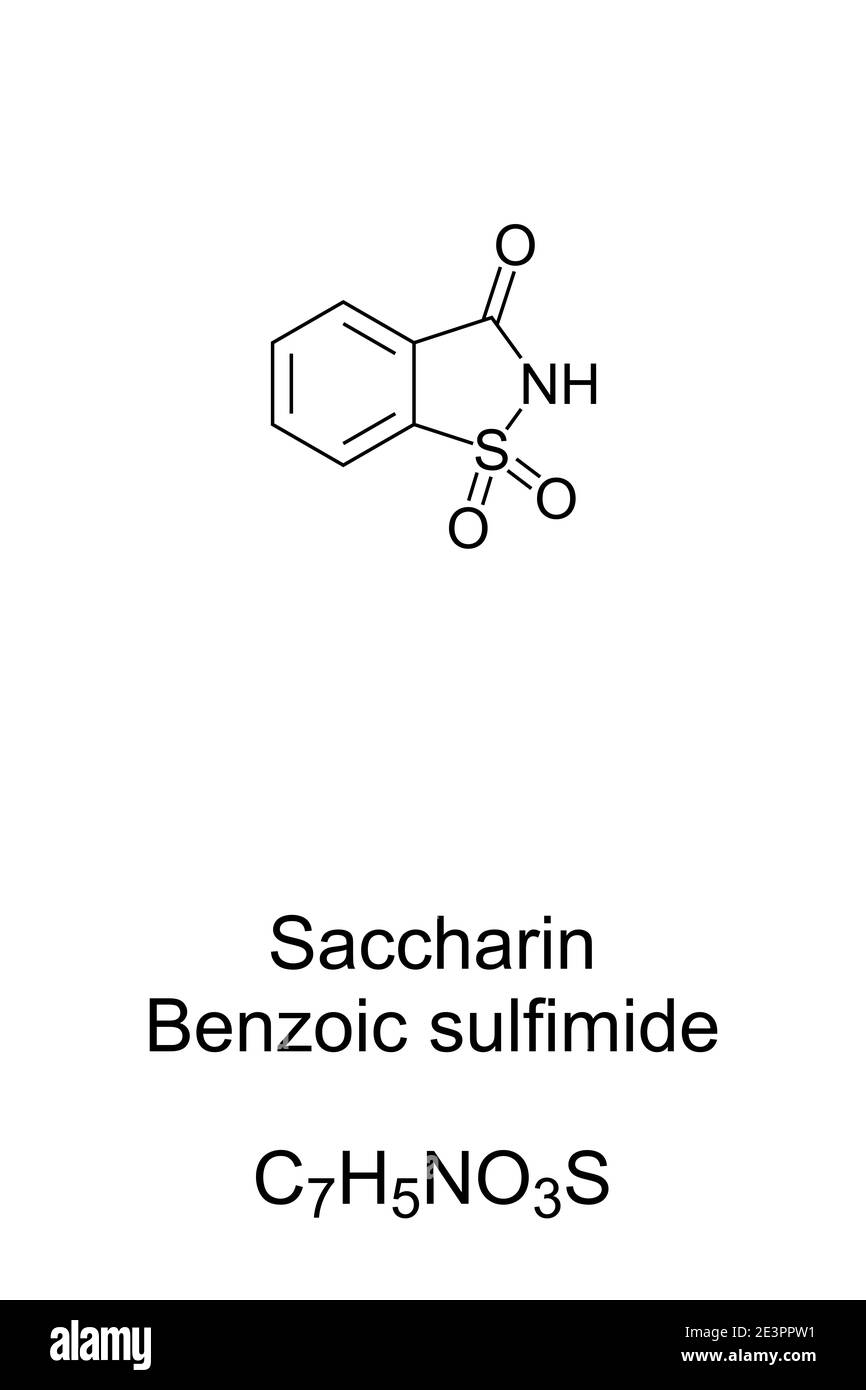 Saccharin, benzoic sulfimide, chemical formula and skeletal structure. Artificial sweetener with no food energy. Code 954. Stock Photohttps://www.alamy.com/image-license-details/?v=1https://www.alamy.com/saccharin-benzoic-sulfimide-chemical-formula-and-skeletal-structure-artificial-sweetener-with-no-food-energy-code-954-image398183325.html
Saccharin, benzoic sulfimide, chemical formula and skeletal structure. Artificial sweetener with no food energy. Code 954. Stock Photohttps://www.alamy.com/image-license-details/?v=1https://www.alamy.com/saccharin-benzoic-sulfimide-chemical-formula-and-skeletal-structure-artificial-sweetener-with-no-food-energy-code-954-image398183325.htmlRF2E3PPW1–Saccharin, benzoic sulfimide, chemical formula and skeletal structure. Artificial sweetener with no food energy. Code 954.
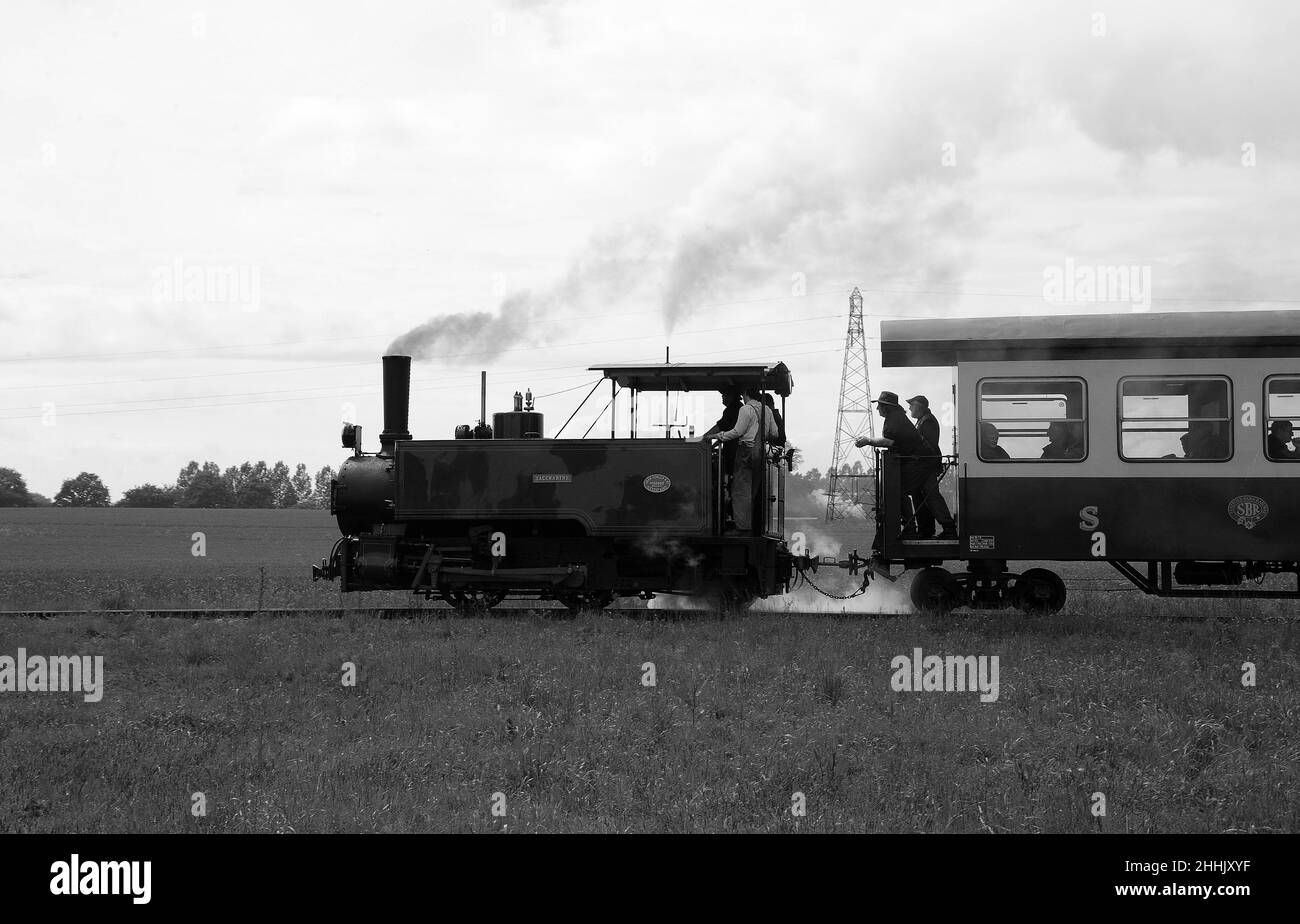 'Saccharine' on the balloon loop. Stock Photohttps://www.alamy.com/image-license-details/?v=1https://www.alamy.com/saccharine-on-the-balloon-loop-image458335011.html
'Saccharine' on the balloon loop. Stock Photohttps://www.alamy.com/image-license-details/?v=1https://www.alamy.com/saccharine-on-the-balloon-loop-image458335011.htmlRF2HHJXYF–'Saccharine' on the balloon loop.
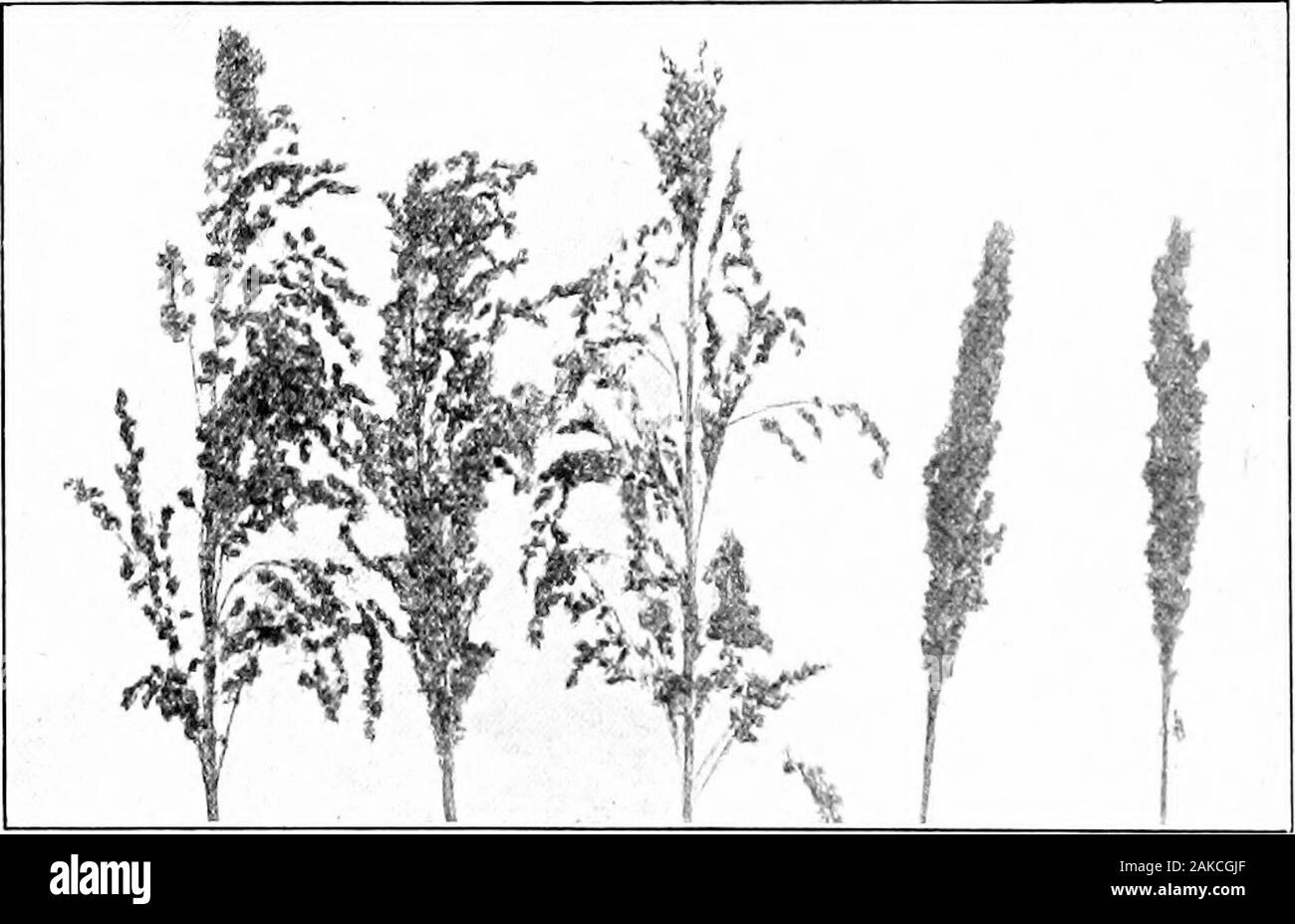 Southern field crops (exclusive of forage plants) . ghum kernel smut (Sphacelotheca sorghi) is a diseasecaused by a fungus which destroys the individual grains.It is easily prevented by either of the followdng methods: (1) by soaking the seed for planting for one hour in a solu-tion of 1 ounce of formahn for each 2 gallons of water; or (2) by scalding the planting seed for 10 to 12 minutesin water kept at a temperature between 134° and 140° F.Either of these treatments kills the germs of the diseasewithout injuring the seed. 2?A SOUTHERN FIELD CROPS Saccharine or Sweet Sorghums 214. Descriptio Stock Photohttps://www.alamy.com/image-license-details/?v=1https://www.alamy.com/southern-field-crops-exclusive-of-forage-plants-ghum-kernel-smut-sphacelotheca-sorghi-is-a-diseasecaused-by-a-fungus-which-destroys-the-individual-grainsit-is-easily-prevented-by-either-of-the-followdng-methods-1-by-soaking-the-seed-for-planting-for-one-hour-in-a-solu-tion-of-1-ounce-of-formahn-for-each-2-gallons-of-water-or-2-by-scalding-the-planting-seed-for-10-to-12-minutesin-water-kept-at-a-temperature-between-134-and-140-feither-of-these-treatments-kills-the-germs-of-the-diseasewithout-injuring-the-seed-2a-southern-field-crops-saccharine-or-sweet-sorghums-214-descriptio-image338951943.html
Southern field crops (exclusive of forage plants) . ghum kernel smut (Sphacelotheca sorghi) is a diseasecaused by a fungus which destroys the individual grains.It is easily prevented by either of the followdng methods: (1) by soaking the seed for planting for one hour in a solu-tion of 1 ounce of formahn for each 2 gallons of water; or (2) by scalding the planting seed for 10 to 12 minutesin water kept at a temperature between 134° and 140° F.Either of these treatments kills the germs of the diseasewithout injuring the seed. 2?A SOUTHERN FIELD CROPS Saccharine or Sweet Sorghums 214. Descriptio Stock Photohttps://www.alamy.com/image-license-details/?v=1https://www.alamy.com/southern-field-crops-exclusive-of-forage-plants-ghum-kernel-smut-sphacelotheca-sorghi-is-a-diseasecaused-by-a-fungus-which-destroys-the-individual-grainsit-is-easily-prevented-by-either-of-the-followdng-methods-1-by-soaking-the-seed-for-planting-for-one-hour-in-a-solu-tion-of-1-ounce-of-formahn-for-each-2-gallons-of-water-or-2-by-scalding-the-planting-seed-for-10-to-12-minutesin-water-kept-at-a-temperature-between-134-and-140-feither-of-these-treatments-kills-the-germs-of-the-diseasewithout-injuring-the-seed-2a-southern-field-crops-saccharine-or-sweet-sorghums-214-descriptio-image338951943.htmlRM2AKCGJF–Southern field crops (exclusive of forage plants) . ghum kernel smut (Sphacelotheca sorghi) is a diseasecaused by a fungus which destroys the individual grains.It is easily prevented by either of the followdng methods: (1) by soaking the seed for planting for one hour in a solu-tion of 1 ounce of formahn for each 2 gallons of water; or (2) by scalding the planting seed for 10 to 12 minutesin water kept at a temperature between 134° and 140° F.Either of these treatments kills the germs of the diseasewithout injuring the seed. 2?A SOUTHERN FIELD CROPS Saccharine or Sweet Sorghums 214. Descriptio
 'Saccharine' shoruded in steam at Oak Tree Halt. Stock Photohttps://www.alamy.com/image-license-details/?v=1https://www.alamy.com/saccharine-shoruded-in-steam-at-oak-tree-halt-image462436622.html
'Saccharine' shoruded in steam at Oak Tree Halt. Stock Photohttps://www.alamy.com/image-license-details/?v=1https://www.alamy.com/saccharine-shoruded-in-steam-at-oak-tree-halt-image462436622.htmlRF2HT9PHJ–'Saccharine' shoruded in steam at Oak Tree Halt.
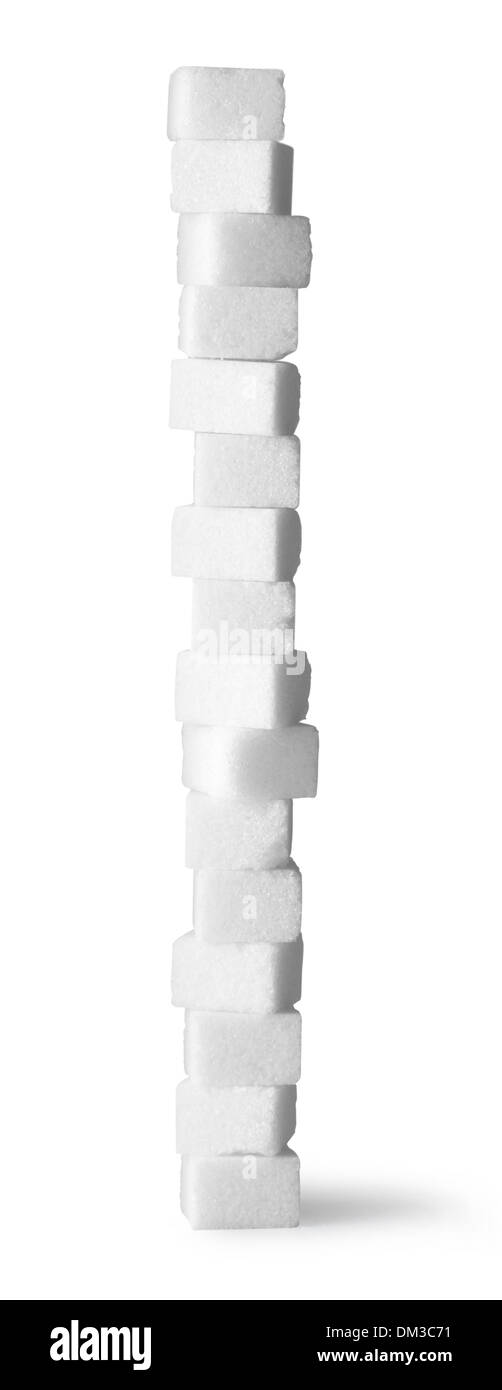 Stack of white sugar cubes, cut out on a white background Stock Photohttps://www.alamy.com/image-license-details/?v=1https://www.alamy.com/stack-of-white-sugar-cubes-cut-out-on-a-white-background-image63999685.html
Stack of white sugar cubes, cut out on a white background Stock Photohttps://www.alamy.com/image-license-details/?v=1https://www.alamy.com/stack-of-white-sugar-cubes-cut-out-on-a-white-background-image63999685.htmlRFDM3C71–Stack of white sugar cubes, cut out on a white background
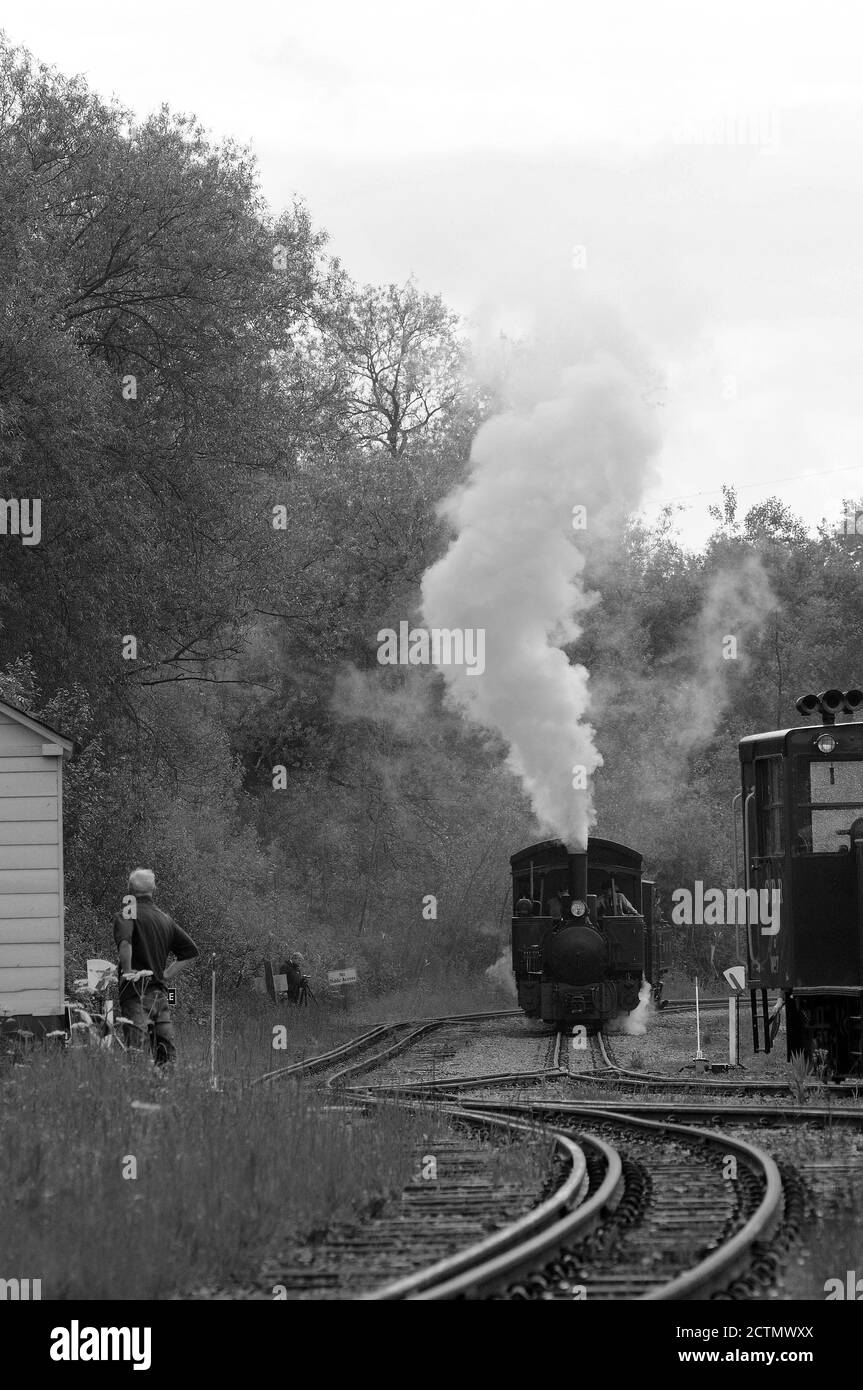 'Saccharine' (with SBR No. 9 at the rear of the train) approaching the balloon loop. Stock Photohttps://www.alamy.com/image-license-details/?v=1https://www.alamy.com/saccharine-with-sbr-no-9-at-the-rear-of-the-train-approaching-the-balloon-loop-image376628866.html
'Saccharine' (with SBR No. 9 at the rear of the train) approaching the balloon loop. Stock Photohttps://www.alamy.com/image-license-details/?v=1https://www.alamy.com/saccharine-with-sbr-no-9-at-the-rear-of-the-train-approaching-the-balloon-loop-image376628866.htmlRF2CTMWXX–'Saccharine' (with SBR No. 9 at the rear of the train) approaching the balloon loop.
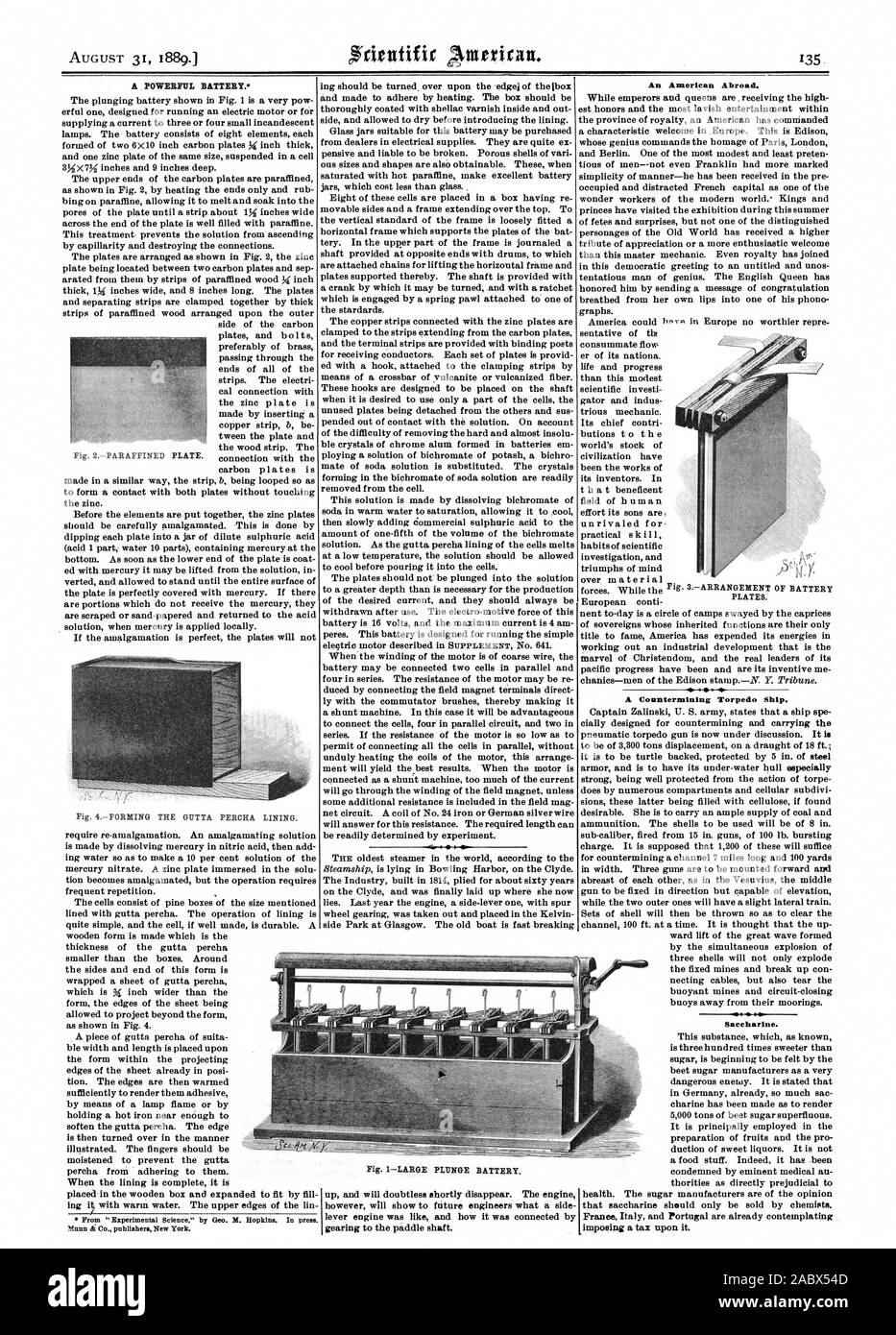 A POWERFUL BATTERY. 46- An American Abroad. A Countermining Torpedo Ship. Saccharine., scientific american, 1889-08-31 Stock Photohttps://www.alamy.com/image-license-details/?v=1https://www.alamy.com/a-powerful-battery-46-an-american-abroad-a-countermining-torpedo-ship-saccharine-scientific-american-1889-08-31-image334333005.html
A POWERFUL BATTERY. 46- An American Abroad. A Countermining Torpedo Ship. Saccharine., scientific american, 1889-08-31 Stock Photohttps://www.alamy.com/image-license-details/?v=1https://www.alamy.com/a-powerful-battery-46-an-american-abroad-a-countermining-torpedo-ship-saccharine-scientific-american-1889-08-31-image334333005.htmlRM2ABX54D–A POWERFUL BATTERY. 46- An American Abroad. A Countermining Torpedo Ship. Saccharine., scientific american, 1889-08-31
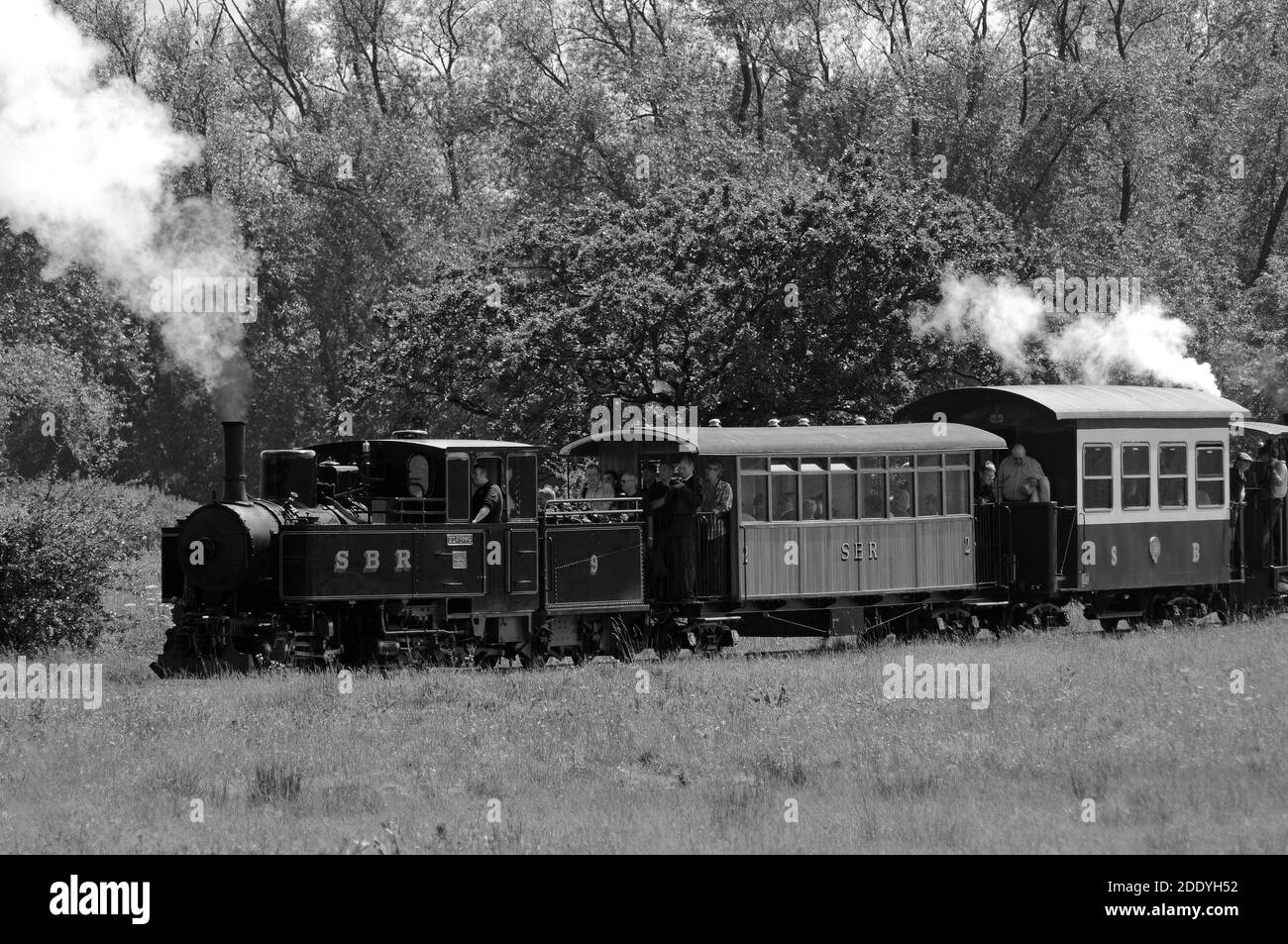 SBR No. 9 (leading) and 'Saccharine' (at the rear) on the balloon loop. Stock Photohttps://www.alamy.com/image-license-details/?v=1https://www.alamy.com/sbr-no-9-leading-and-saccharine-at-the-rear-on-the-balloon-loop-image387224798.html
SBR No. 9 (leading) and 'Saccharine' (at the rear) on the balloon loop. Stock Photohttps://www.alamy.com/image-license-details/?v=1https://www.alamy.com/sbr-no-9-leading-and-saccharine-at-the-rear-on-the-balloon-loop-image387224798.htmlRF2DDYH52–SBR No. 9 (leading) and 'Saccharine' (at the rear) on the balloon loop.
RF2XDDM3P–Icon for sweet,sugary
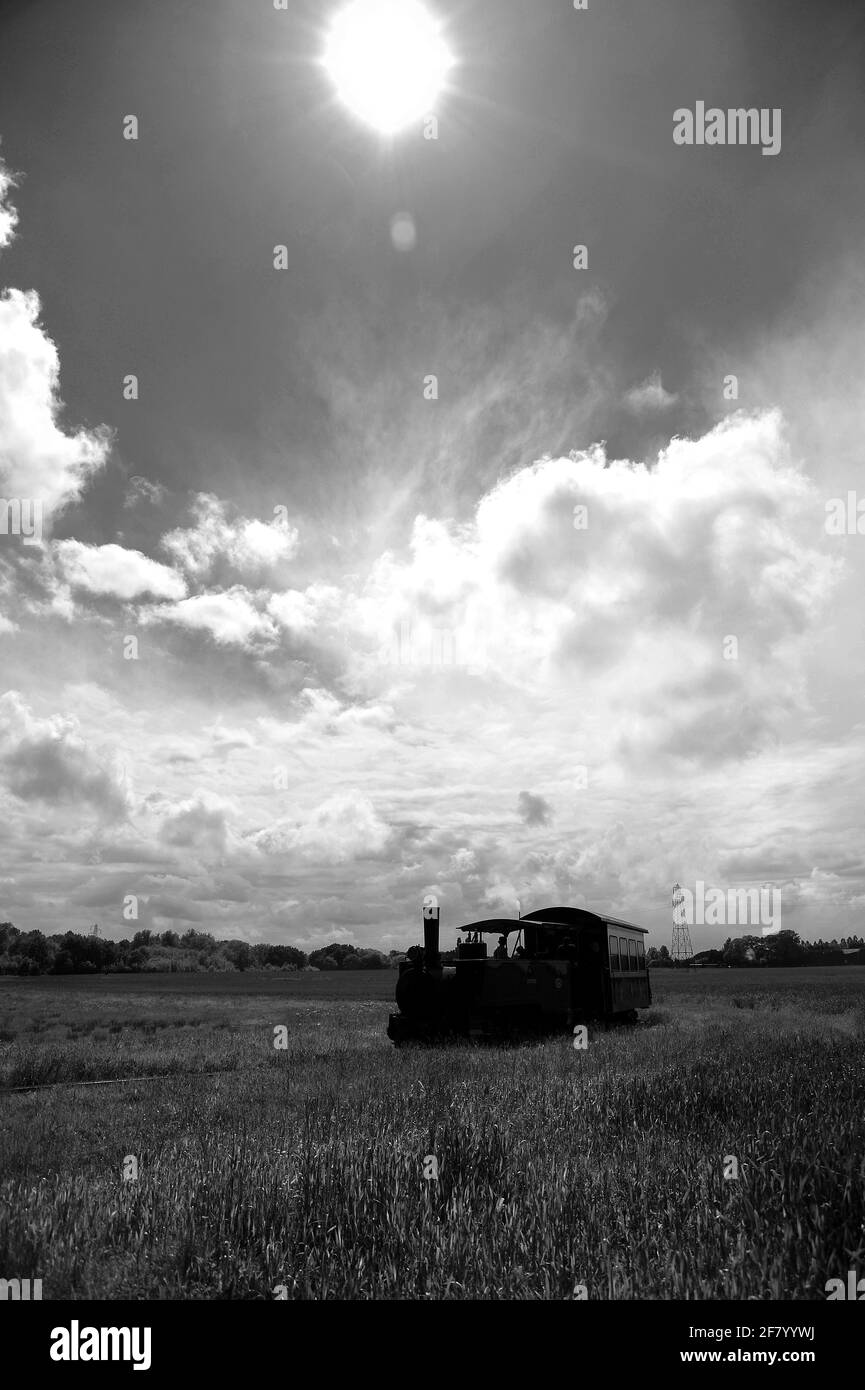 'SBR No. 9' leads its train around the balloon loop with 'Saccharine' at the rear. Stock Photohttps://www.alamy.com/image-license-details/?v=1https://www.alamy.com/sbr-no-9-leads-its-train-around-the-balloon-loop-with-saccharine-at-the-rear-image417966014.html
'SBR No. 9' leads its train around the balloon loop with 'Saccharine' at the rear. Stock Photohttps://www.alamy.com/image-license-details/?v=1https://www.alamy.com/sbr-no-9-leads-its-train-around-the-balloon-loop-with-saccharine-at-the-rear-image417966014.htmlRF2F7YYWJ–'SBR No. 9' leads its train around the balloon loop with 'Saccharine' at the rear.
 This agricultural work focuses on non-saccharine sorghum varieties, specifically four distinct types: White Kafir, Guinea Kafir, Blackhull Kafir, and Red Kafir. These sorghums are important for the cotton-belt region and are studied for their agricultural value, with applications in food and forage production. Stock Photohttps://www.alamy.com/image-license-details/?v=1https://www.alamy.com/this-agricultural-work-focuses-on-non-saccharine-sorghum-varieties-specifically-four-distinct-types-white-kafir-guinea-kafir-blackhull-kafir-and-red-kafir-these-sorghums-are-important-for-the-cotton-belt-region-and-are-studied-for-their-agricultural-value-with-applications-in-food-and-forage-production-image216361515.html
This agricultural work focuses on non-saccharine sorghum varieties, specifically four distinct types: White Kafir, Guinea Kafir, Blackhull Kafir, and Red Kafir. These sorghums are important for the cotton-belt region and are studied for their agricultural value, with applications in food and forage production. Stock Photohttps://www.alamy.com/image-license-details/?v=1https://www.alamy.com/this-agricultural-work-focuses-on-non-saccharine-sorghum-varieties-specifically-four-distinct-types-white-kafir-guinea-kafir-blackhull-kafir-and-red-kafir-these-sorghums-are-important-for-the-cotton-belt-region-and-are-studied-for-their-agricultural-value-with-applications-in-food-and-forage-production-image216361515.htmlRMPG038Y–This agricultural work focuses on non-saccharine sorghum varieties, specifically four distinct types: White Kafir, Guinea Kafir, Blackhull Kafir, and Red Kafir. These sorghums are important for the cotton-belt region and are studied for their agricultural value, with applications in food and forage production.
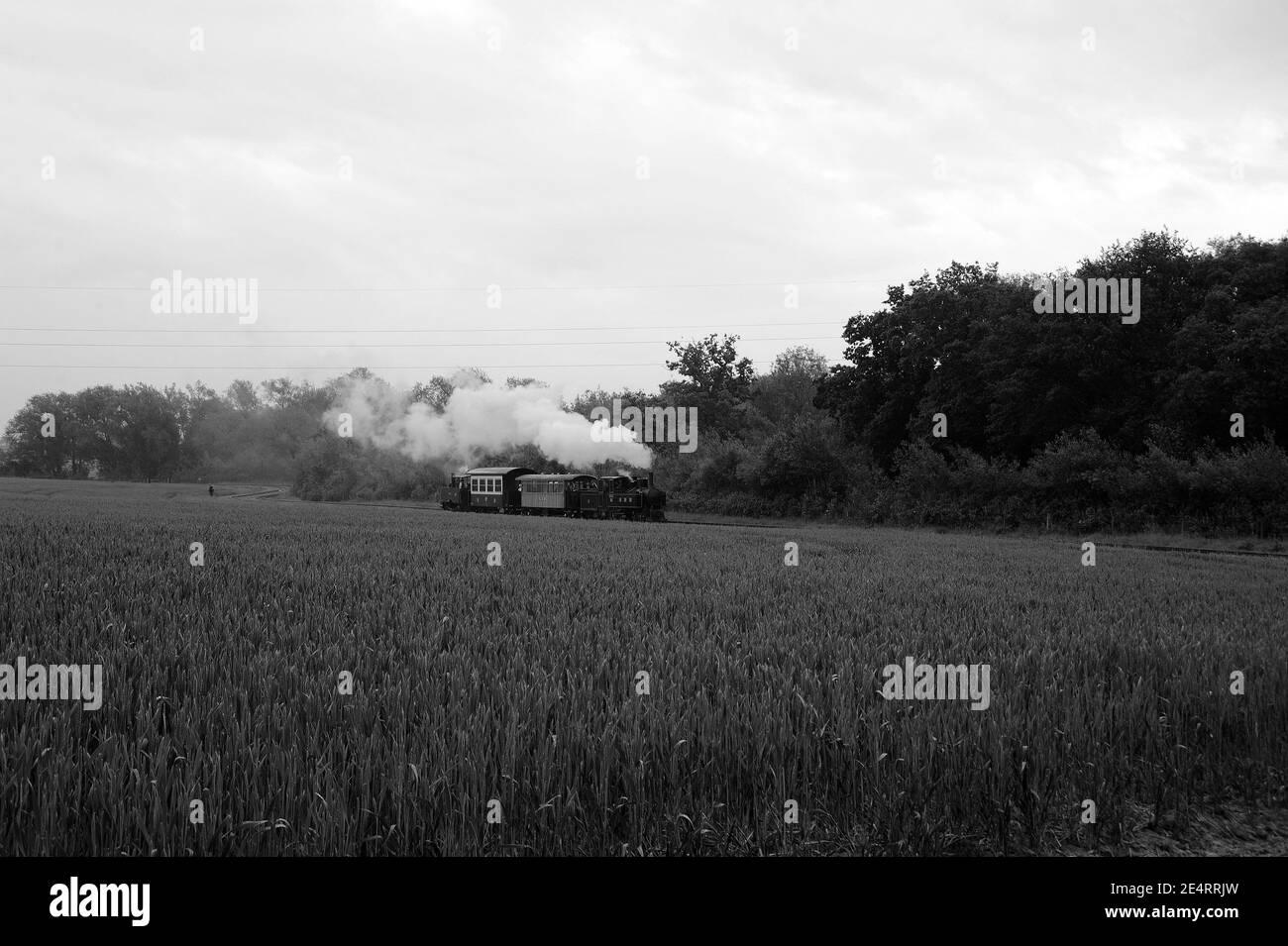 SBR No. 9 and 'Saccharine' between the balloon loop and Oak Tree Halt. Stock Photohttps://www.alamy.com/image-license-details/?v=1https://www.alamy.com/sbr-no-9-and-saccharine-between-the-balloon-loop-and-oak-tree-halt-image398820545.html
SBR No. 9 and 'Saccharine' between the balloon loop and Oak Tree Halt. Stock Photohttps://www.alamy.com/image-license-details/?v=1https://www.alamy.com/sbr-no-9-and-saccharine-between-the-balloon-loop-and-oak-tree-halt-image398820545.htmlRF2E4RRJW–SBR No. 9 and 'Saccharine' between the balloon loop and Oak Tree Halt.
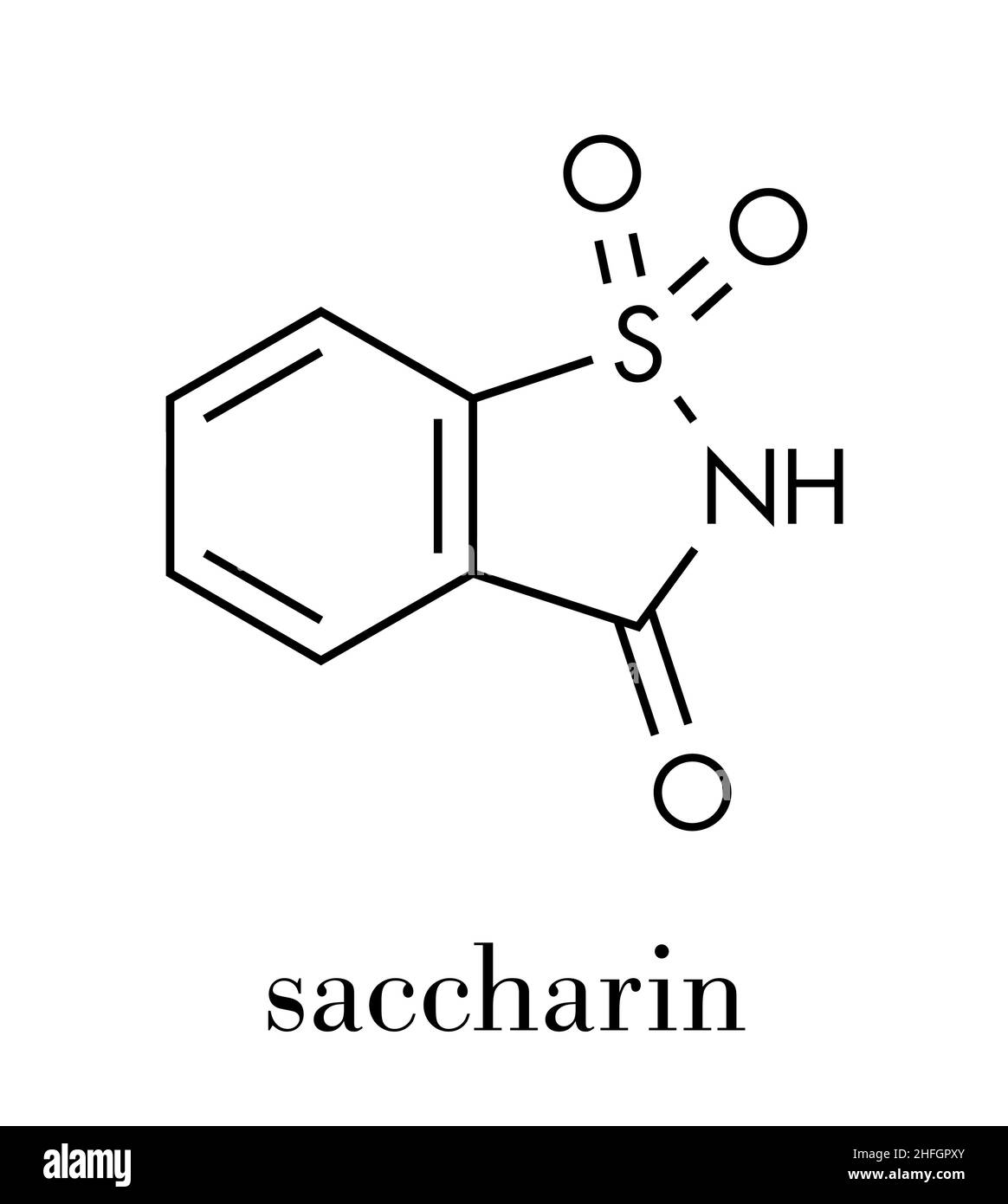 Saccharin artificial sweetener molecule. Skeletal formula. Stock Vectorhttps://www.alamy.com/image-license-details/?v=1https://www.alamy.com/saccharin-artificial-sweetener-molecule-skeletal-formula-image457058643.html
Saccharin artificial sweetener molecule. Skeletal formula. Stock Vectorhttps://www.alamy.com/image-license-details/?v=1https://www.alamy.com/saccharin-artificial-sweetener-molecule-skeletal-formula-image457058643.htmlRF2HFGPXY–Saccharin artificial sweetener molecule. Skeletal formula.
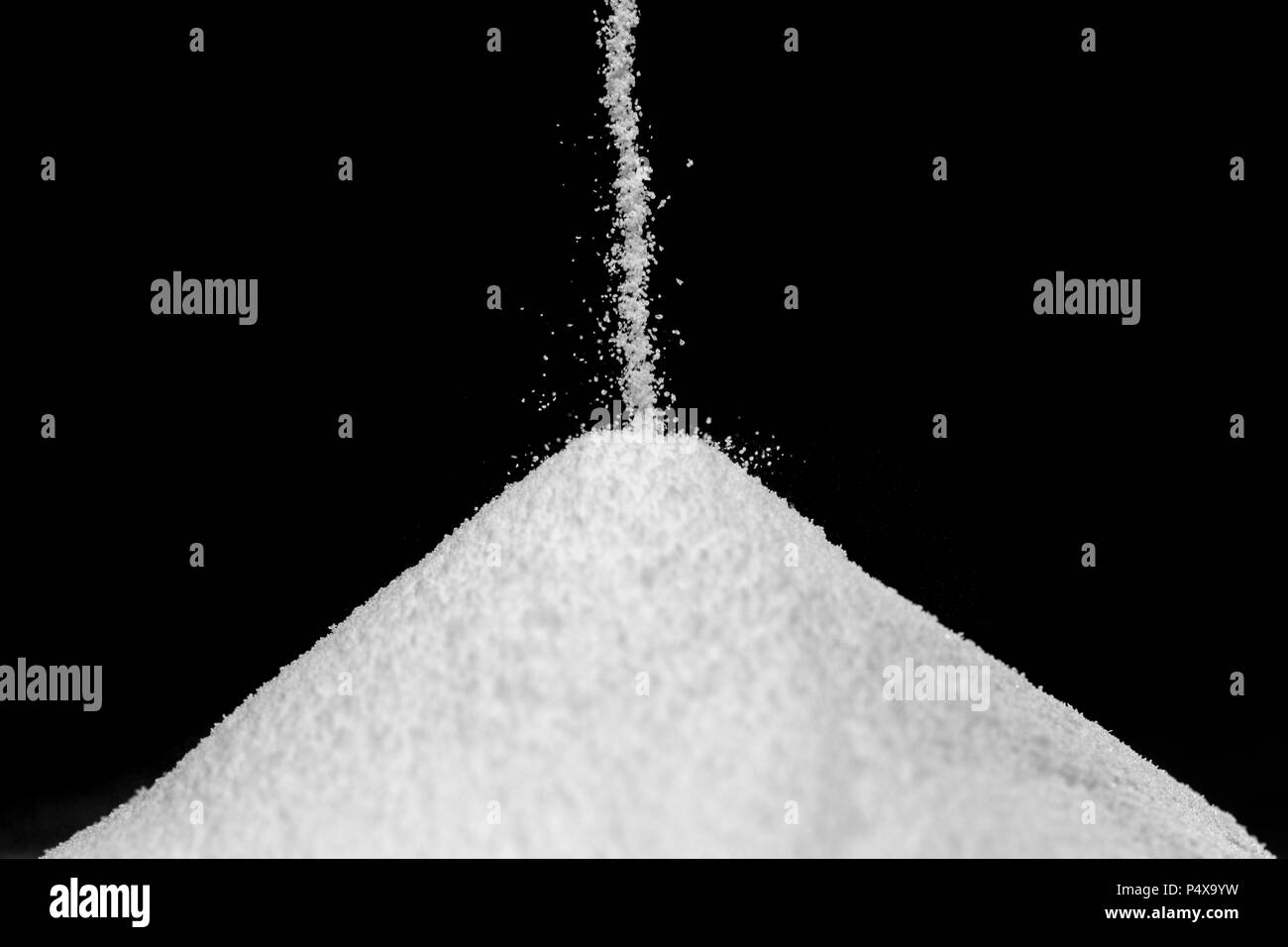 Stevia Sugar Mountain Stock Photohttps://www.alamy.com/image-license-details/?v=1https://www.alamy.com/stevia-sugar-mountain-image209561629.html
Stevia Sugar Mountain Stock Photohttps://www.alamy.com/image-license-details/?v=1https://www.alamy.com/stevia-sugar-mountain-image209561629.htmlRFP4X9YW–Stevia Sugar Mountain
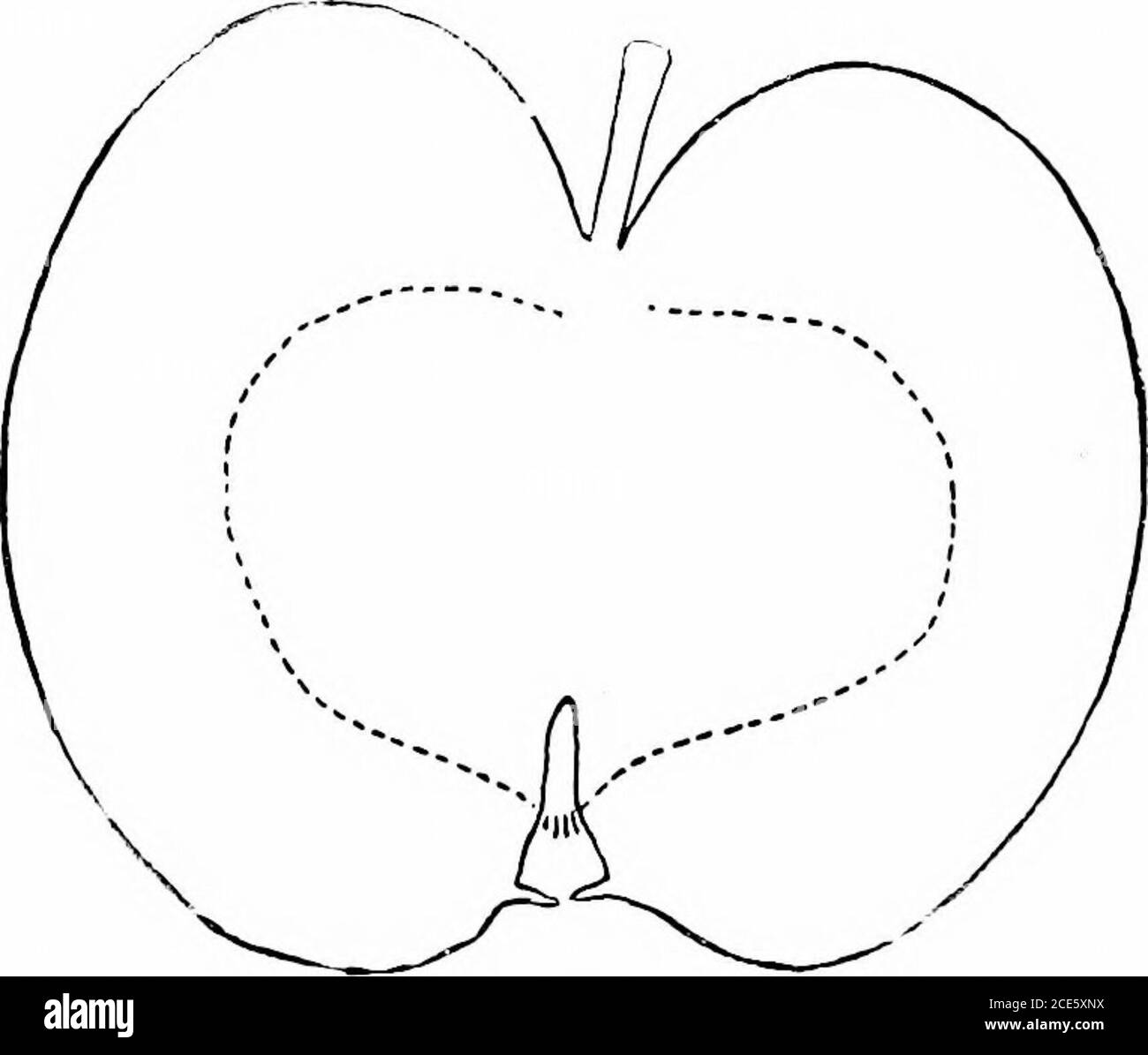 . American horticultural manual .. . regular, ol)tuse, often russeted; stem medium; basin smooth,wide, sliallow or medium depth; calyx closed; segments flat con-vergent. Core closed; cells ovate, axile; tube funnel-sliaped; stamensmarginal; seeds few, short, plump; flesh yellow, fine-grained, firm,juicy, mild, pleasant, saccharine, subacid, very good. Late winterand spring, even keeping till .July. Tetofsky (Tctofski).—Origin, Russia; tree hardy, very upright,an early annual bearer. Bowlings spelling Tetofsky is usually pre-ferred to Warders version Tctofski. Fruit medium or below, oblate to r Stock Photohttps://www.alamy.com/image-license-details/?v=1https://www.alamy.com/american-horticultural-manual-regular-oltuse-often-russeted-stem-medium-basin-smoothwide-sliallow-or-medium-depth-calyx-closed-segments-flat-con-vergent-core-closed-cells-ovate-axile-tube-funnel-sliaped-stamensmarginal-seeds-few-short-plump-flesh-yellow-fine-grained-firmjuicy-mild-pleasant-saccharine-subacid-very-good-late-winterand-spring-even-keeping-till-july-tetofsky-tctofskiorigin-russia-tree-hardy-very-uprightan-early-annual-bearer-bowlings-spelling-tetofsky-is-usually-pre-ferred-to-warders-version-tctofski-fruit-medium-or-below-oblate-to-r-image370153670.html
. American horticultural manual .. . regular, ol)tuse, often russeted; stem medium; basin smooth,wide, sliallow or medium depth; calyx closed; segments flat con-vergent. Core closed; cells ovate, axile; tube funnel-sliaped; stamensmarginal; seeds few, short, plump; flesh yellow, fine-grained, firm,juicy, mild, pleasant, saccharine, subacid, very good. Late winterand spring, even keeping till .July. Tetofsky (Tctofski).—Origin, Russia; tree hardy, very upright,an early annual bearer. Bowlings spelling Tetofsky is usually pre-ferred to Warders version Tctofski. Fruit medium or below, oblate to r Stock Photohttps://www.alamy.com/image-license-details/?v=1https://www.alamy.com/american-horticultural-manual-regular-oltuse-often-russeted-stem-medium-basin-smoothwide-sliallow-or-medium-depth-calyx-closed-segments-flat-con-vergent-core-closed-cells-ovate-axile-tube-funnel-sliaped-stamensmarginal-seeds-few-short-plump-flesh-yellow-fine-grained-firmjuicy-mild-pleasant-saccharine-subacid-very-good-late-winterand-spring-even-keeping-till-july-tetofsky-tctofskiorigin-russia-tree-hardy-very-uprightan-early-annual-bearer-bowlings-spelling-tetofsky-is-usually-pre-ferred-to-warders-version-tctofski-fruit-medium-or-below-oblate-to-r-image370153670.htmlRM2CE5XNX–. American horticultural manual .. . regular, ol)tuse, often russeted; stem medium; basin smooth,wide, sliallow or medium depth; calyx closed; segments flat con-vergent. Core closed; cells ovate, axile; tube funnel-sliaped; stamensmarginal; seeds few, short, plump; flesh yellow, fine-grained, firm,juicy, mild, pleasant, saccharine, subacid, very good. Late winterand spring, even keeping till .July. Tetofsky (Tctofski).—Origin, Russia; tree hardy, very upright,an early annual bearer. Bowlings spelling Tetofsky is usually pre-ferred to Warders version Tctofski. Fruit medium or below, oblate to r
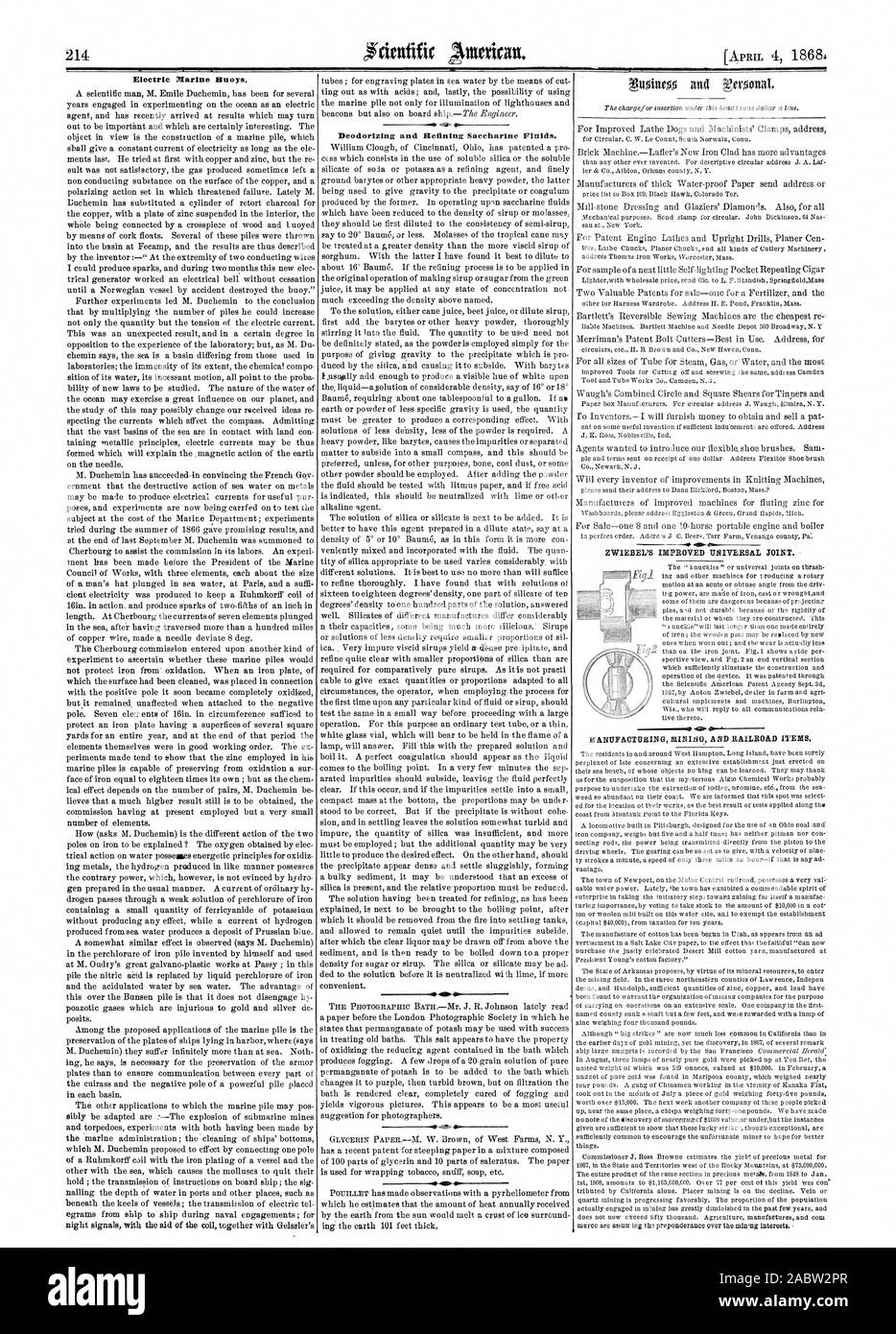 Electric Marine Buoys. 4. Deodorizing and Refining Saccharine Fluids. ZWIEBEL'S IMPROVED UNIVERSAL JOINT. MANUFACTURINmime AND RAILROAD ITEMS., scientific american, 1868-04-04 Stock Photohttps://www.alamy.com/image-license-details/?v=1https://www.alamy.com/electric-marine-buoys-4-deodorizing-and-refining-saccharine-fluids-zwiebels-improved-universal-joint-manufacturinmime-and-railroad-items-scientific-american-1868-04-04-image334309215.html
Electric Marine Buoys. 4. Deodorizing and Refining Saccharine Fluids. ZWIEBEL'S IMPROVED UNIVERSAL JOINT. MANUFACTURINmime AND RAILROAD ITEMS., scientific american, 1868-04-04 Stock Photohttps://www.alamy.com/image-license-details/?v=1https://www.alamy.com/electric-marine-buoys-4-deodorizing-and-refining-saccharine-fluids-zwiebels-improved-universal-joint-manufacturinmime-and-railroad-items-scientific-american-1868-04-04-image334309215.htmlRM2ABW2PR–Electric Marine Buoys. 4. Deodorizing and Refining Saccharine Fluids. ZWIEBEL'S IMPROVED UNIVERSAL JOINT. MANUFACTURINmime AND RAILROAD ITEMS., scientific american, 1868-04-04
RF2XD2K8Y–Icon for sweet,sugary
RF3CD9RHA–Icon for sugar, sweetened
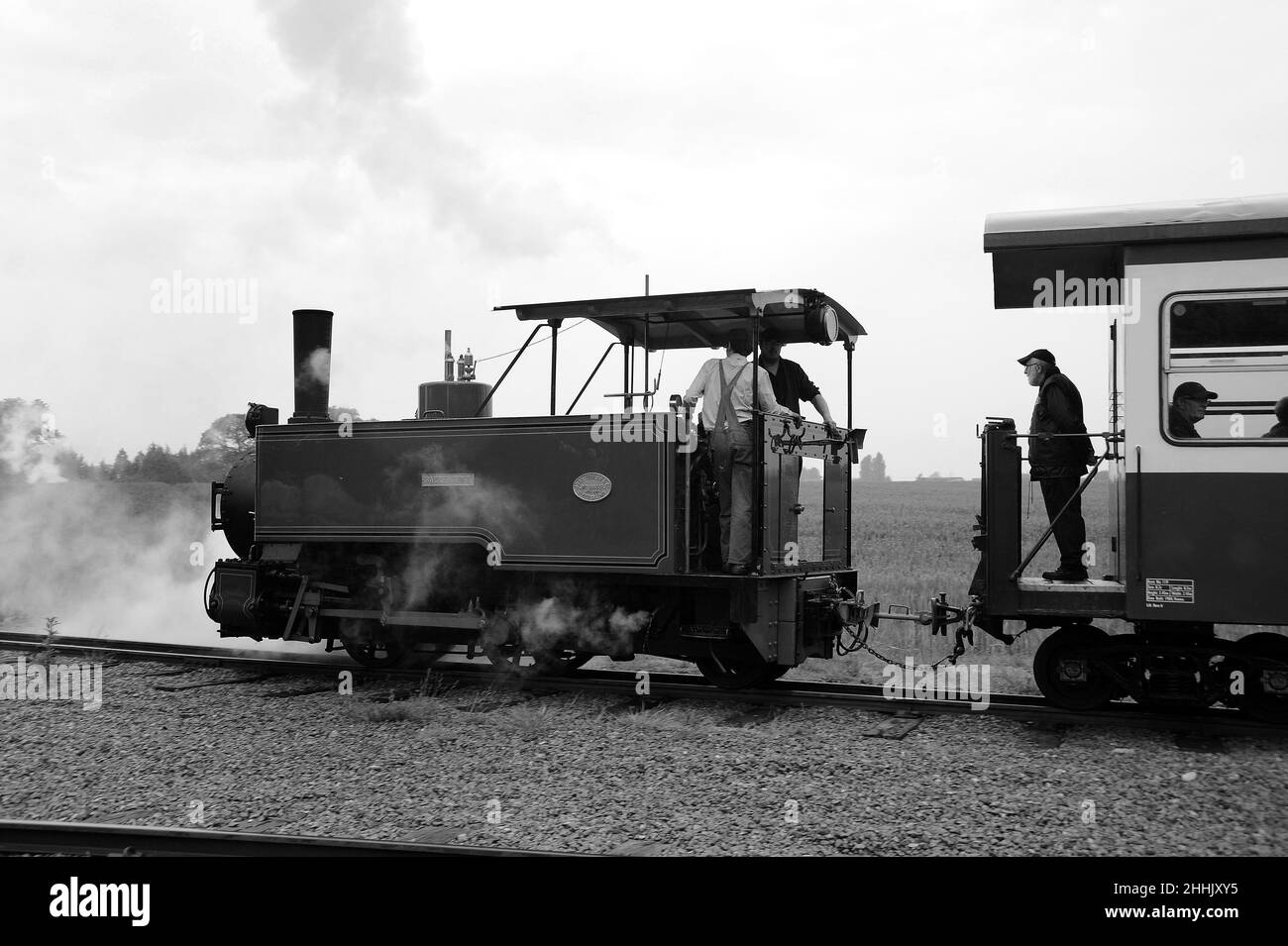 'Saccharine' at the rear of a train hauled by SBR No. 9 as it heads for the balloon loop. Stock Photohttps://www.alamy.com/image-license-details/?v=1https://www.alamy.com/saccharine-at-the-rear-of-a-train-hauled-by-sbr-no-9-as-it-heads-for-the-balloon-loop-image458335001.html
'Saccharine' at the rear of a train hauled by SBR No. 9 as it heads for the balloon loop. Stock Photohttps://www.alamy.com/image-license-details/?v=1https://www.alamy.com/saccharine-at-the-rear-of-a-train-hauled-by-sbr-no-9-as-it-heads-for-the-balloon-loop-image458335001.htmlRF2HHJXY5–'Saccharine' at the rear of a train hauled by SBR No. 9 as it heads for the balloon loop.
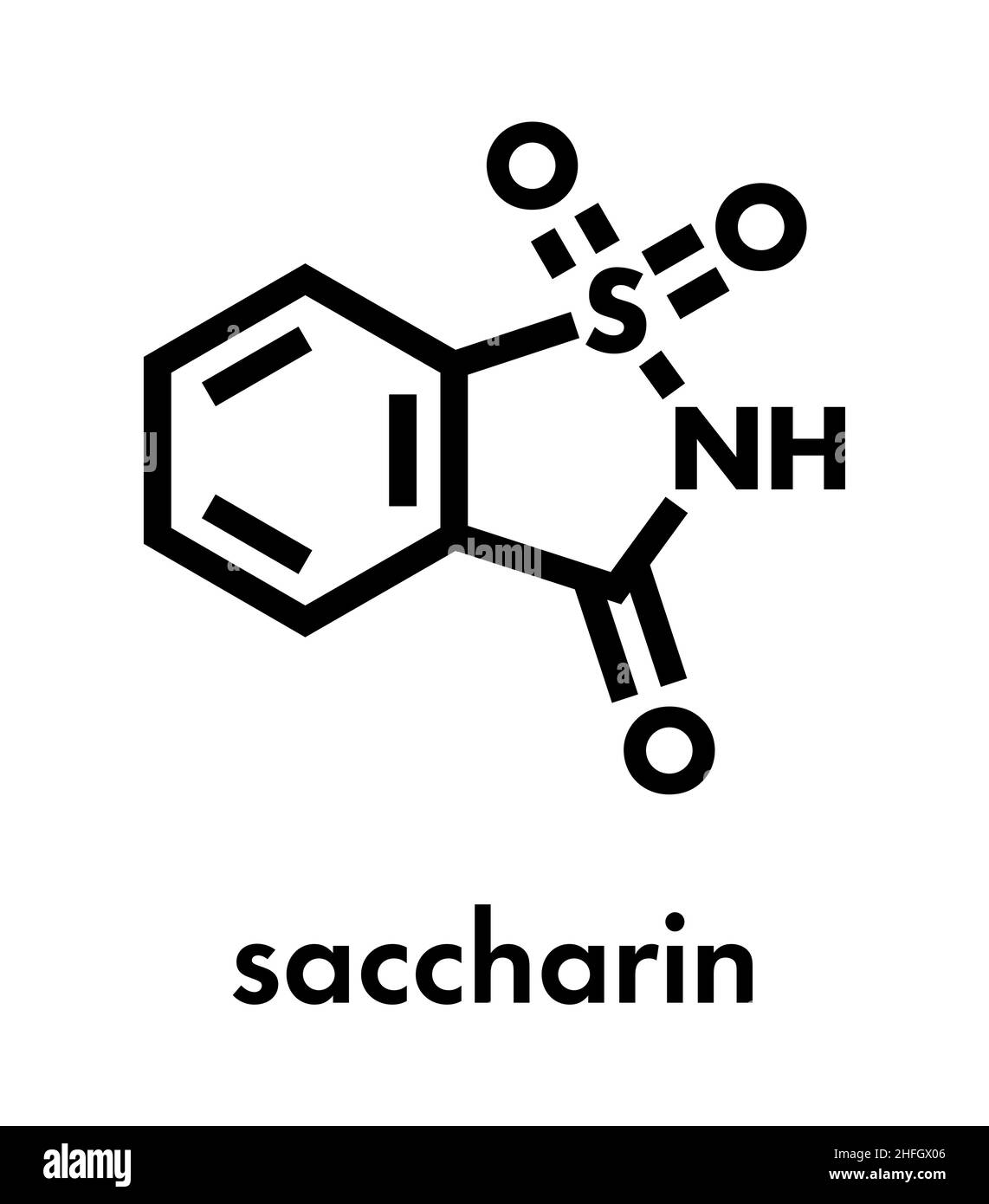 Saccharin artificial sweetener molecule. Skeletal formula. Stock Vectorhttps://www.alamy.com/image-license-details/?v=1https://www.alamy.com/saccharin-artificial-sweetener-molecule-skeletal-formula-image457061030.html
Saccharin artificial sweetener molecule. Skeletal formula. Stock Vectorhttps://www.alamy.com/image-license-details/?v=1https://www.alamy.com/saccharin-artificial-sweetener-molecule-skeletal-formula-image457061030.htmlRF2HFGX06–Saccharin artificial sweetener molecule. Skeletal formula.
 'Isibutu' (right) and 'Saccharine' (left) running parallel on the approach to the balloon loop. SBR No. 9 is at the rear of the train hauled by 'Sacch Stock Photohttps://www.alamy.com/image-license-details/?v=1https://www.alamy.com/isibutu-right-and-saccharine-left-running-parallel-on-the-approach-to-the-balloon-loop-sbr-no-9-is-at-the-rear-of-the-train-hauled-by-sacch-image415432568.html
'Isibutu' (right) and 'Saccharine' (left) running parallel on the approach to the balloon loop. SBR No. 9 is at the rear of the train hauled by 'Sacch Stock Photohttps://www.alamy.com/image-license-details/?v=1https://www.alamy.com/isibutu-right-and-saccharine-left-running-parallel-on-the-approach-to-the-balloon-loop-sbr-no-9-is-at-the-rear-of-the-train-hauled-by-sacch-image415432568.htmlRF2F3TGDC–'Isibutu' (right) and 'Saccharine' (left) running parallel on the approach to the balloon loop. SBR No. 9 is at the rear of the train hauled by 'Sacch
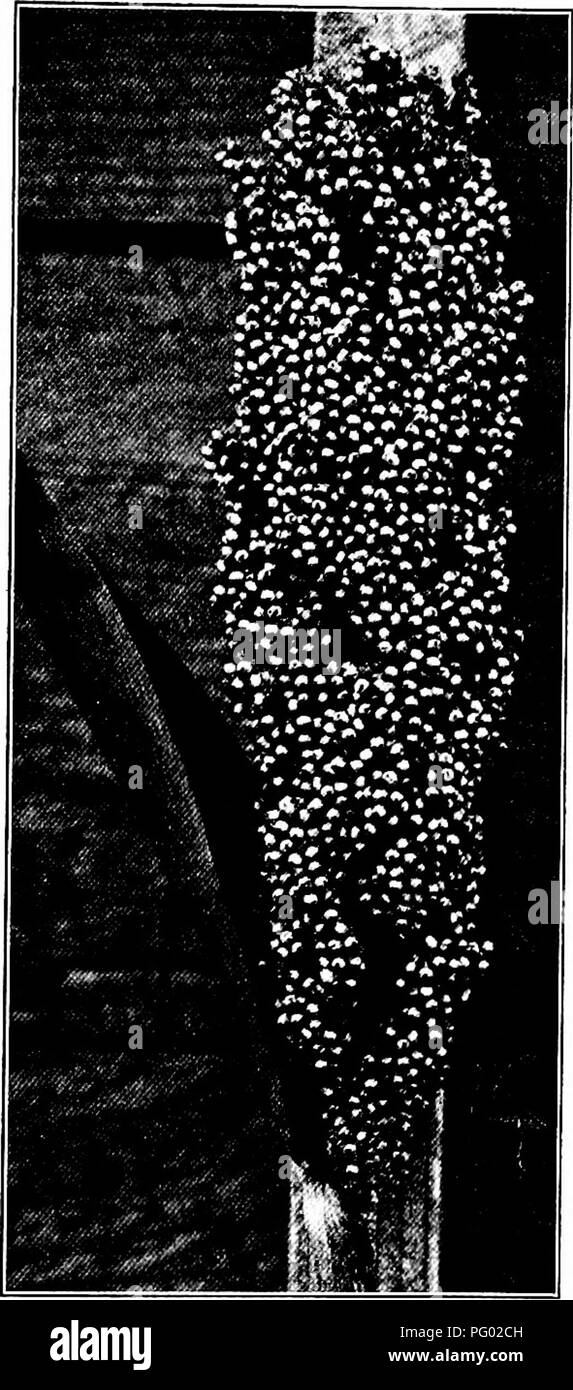 This resource examines the cultivation of maize, kafir corn, and sorghums in North America, particularly focusing on the non-saccharine varieties such as Milo. It discusses the widespread use of Milo and other varieties in the late 19th and early 20th centuries, especially for regions like southwestern Nebraska. Stock Photohttps://www.alamy.com/image-license-details/?v=1https://www.alamy.com/this-resource-examines-the-cultivation-of-maize-kafir-corn-and-sorghums-in-north-america-particularly-focusing-on-the-non-saccharine-varieties-such-as-milo-it-discusses-the-widespread-use-of-milo-and-other-varieties-in-the-late-19th-and-early-20th-centuries-especially-for-regions-like-southwestern-nebraska-image216360833.html
This resource examines the cultivation of maize, kafir corn, and sorghums in North America, particularly focusing on the non-saccharine varieties such as Milo. It discusses the widespread use of Milo and other varieties in the late 19th and early 20th centuries, especially for regions like southwestern Nebraska. Stock Photohttps://www.alamy.com/image-license-details/?v=1https://www.alamy.com/this-resource-examines-the-cultivation-of-maize-kafir-corn-and-sorghums-in-north-america-particularly-focusing-on-the-non-saccharine-varieties-such-as-milo-it-discusses-the-widespread-use-of-milo-and-other-varieties-in-the-late-19th-and-early-20th-centuries-especially-for-regions-like-southwestern-nebraska-image216360833.htmlRMPG02CH–This resource examines the cultivation of maize, kafir corn, and sorghums in North America, particularly focusing on the non-saccharine varieties such as Milo. It discusses the widespread use of Milo and other varieties in the late 19th and early 20th centuries, especially for regions like southwestern Nebraska.
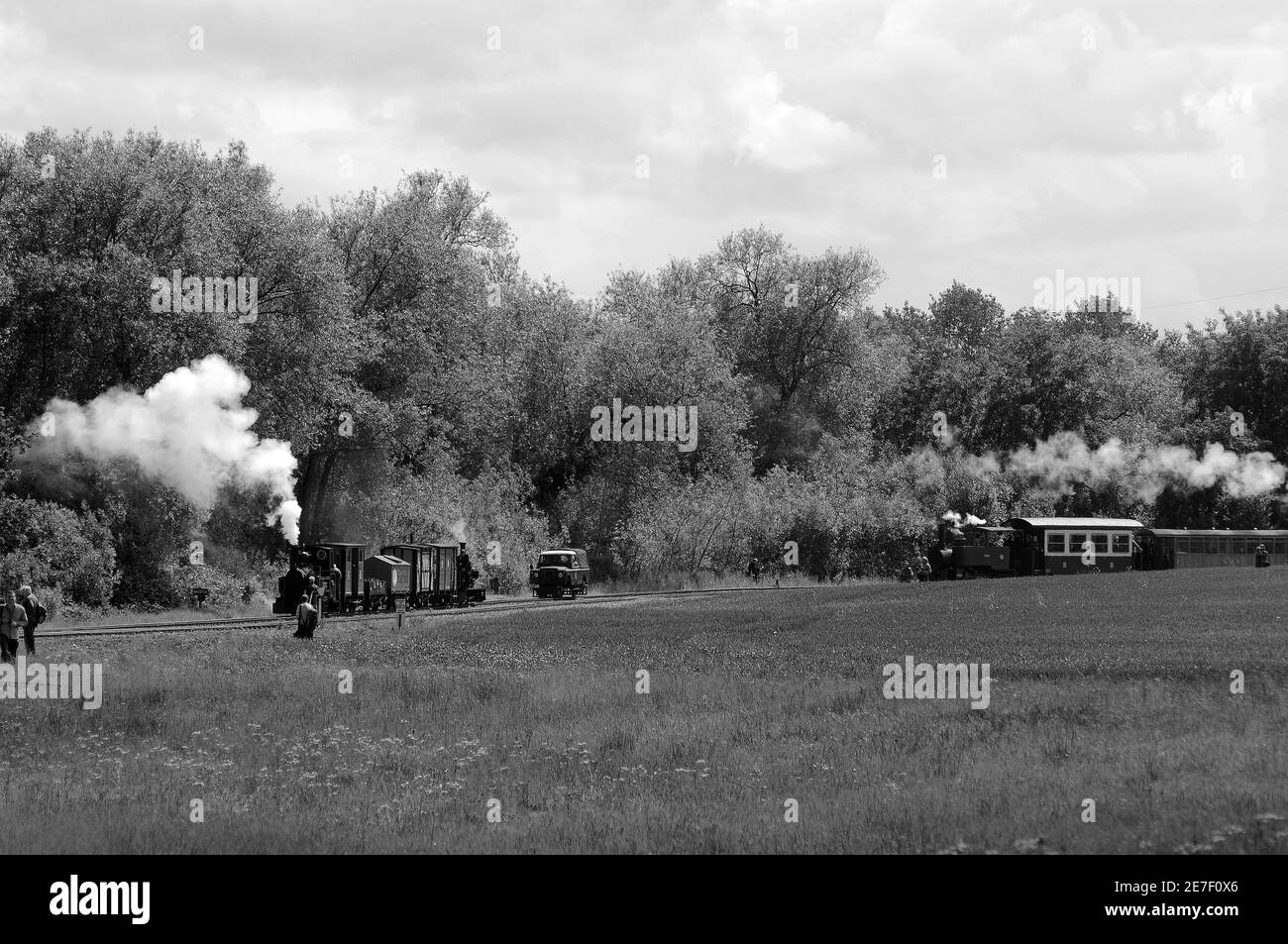 'Marchlyn' (leading) and 'Sybil Mary' (at the rear) with a goods train and the Rail Landrover approach the balloon loop as 'Saccharine' tails a train Stock Photohttps://www.alamy.com/image-license-details/?v=1https://www.alamy.com/marchlyn-leading-and-sybil-mary-at-the-rear-with-a-goods-train-and-the-rail-landrover-approach-the-balloon-loop-as-saccharine-tails-a-train-image400471070.html
'Marchlyn' (leading) and 'Sybil Mary' (at the rear) with a goods train and the Rail Landrover approach the balloon loop as 'Saccharine' tails a train Stock Photohttps://www.alamy.com/image-license-details/?v=1https://www.alamy.com/marchlyn-leading-and-sybil-mary-at-the-rear-with-a-goods-train-and-the-rail-landrover-approach-the-balloon-loop-as-saccharine-tails-a-train-image400471070.htmlRF2E7F0X6–'Marchlyn' (leading) and 'Sybil Mary' (at the rear) with a goods train and the Rail Landrover approach the balloon loop as 'Saccharine' tails a train
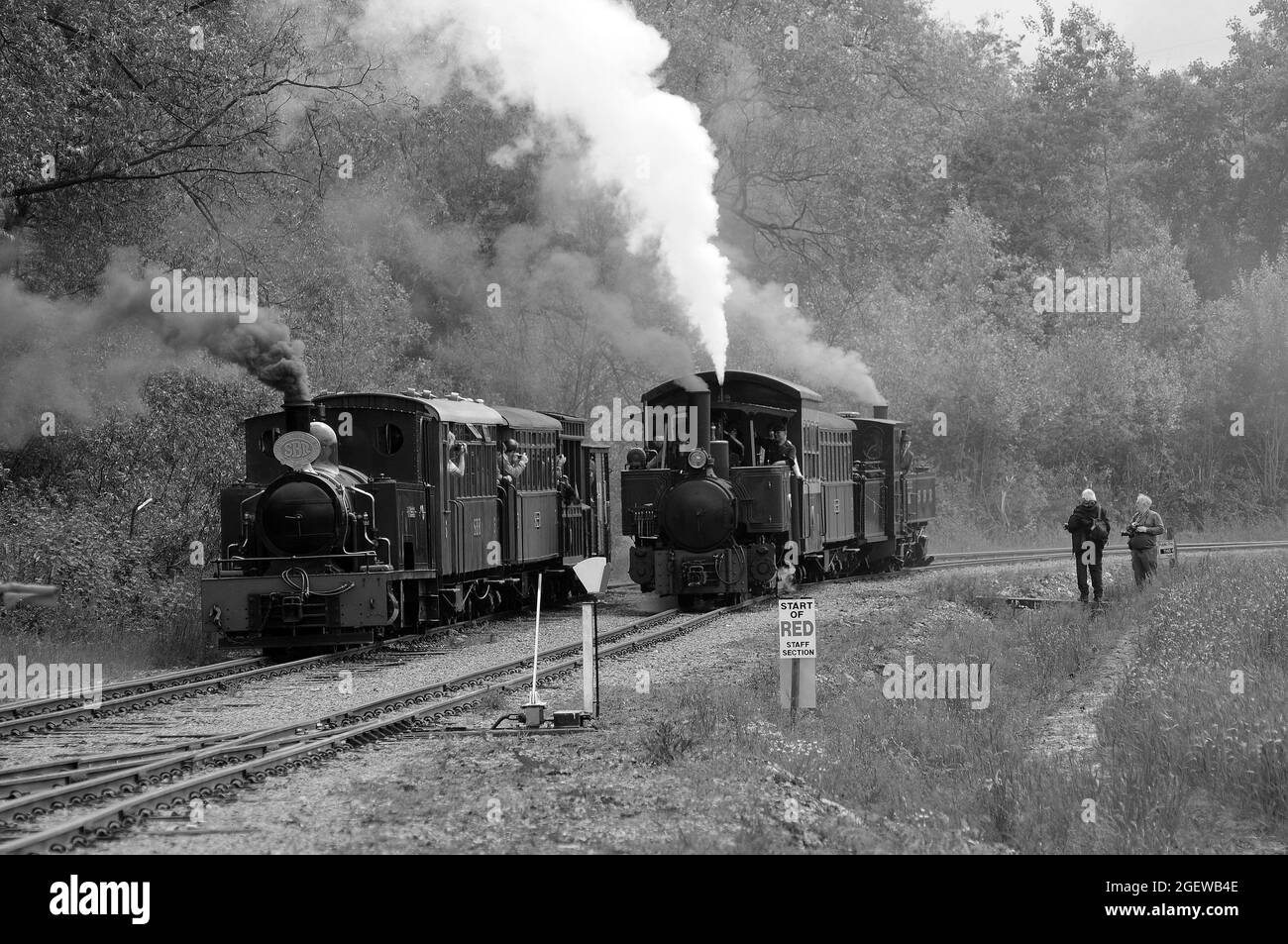 'Isibutu' (right) and 'Saccharine' (left) running parallel on the approach to the balloon loop. SBR No. 9 is at the rear of the train hauled by 'Sacch Stock Photohttps://www.alamy.com/image-license-details/?v=1https://www.alamy.com/isibutu-right-and-saccharine-left-running-parallel-on-the-approach-to-the-balloon-loop-sbr-no-9-is-at-the-rear-of-the-train-hauled-by-sacch-image439421934.html
'Isibutu' (right) and 'Saccharine' (left) running parallel on the approach to the balloon loop. SBR No. 9 is at the rear of the train hauled by 'Sacch Stock Photohttps://www.alamy.com/image-license-details/?v=1https://www.alamy.com/isibutu-right-and-saccharine-left-running-parallel-on-the-approach-to-the-balloon-loop-sbr-no-9-is-at-the-rear-of-the-train-hauled-by-sacch-image439421934.htmlRF2GEWB4E–'Isibutu' (right) and 'Saccharine' (left) running parallel on the approach to the balloon loop. SBR No. 9 is at the rear of the train hauled by 'Sacch
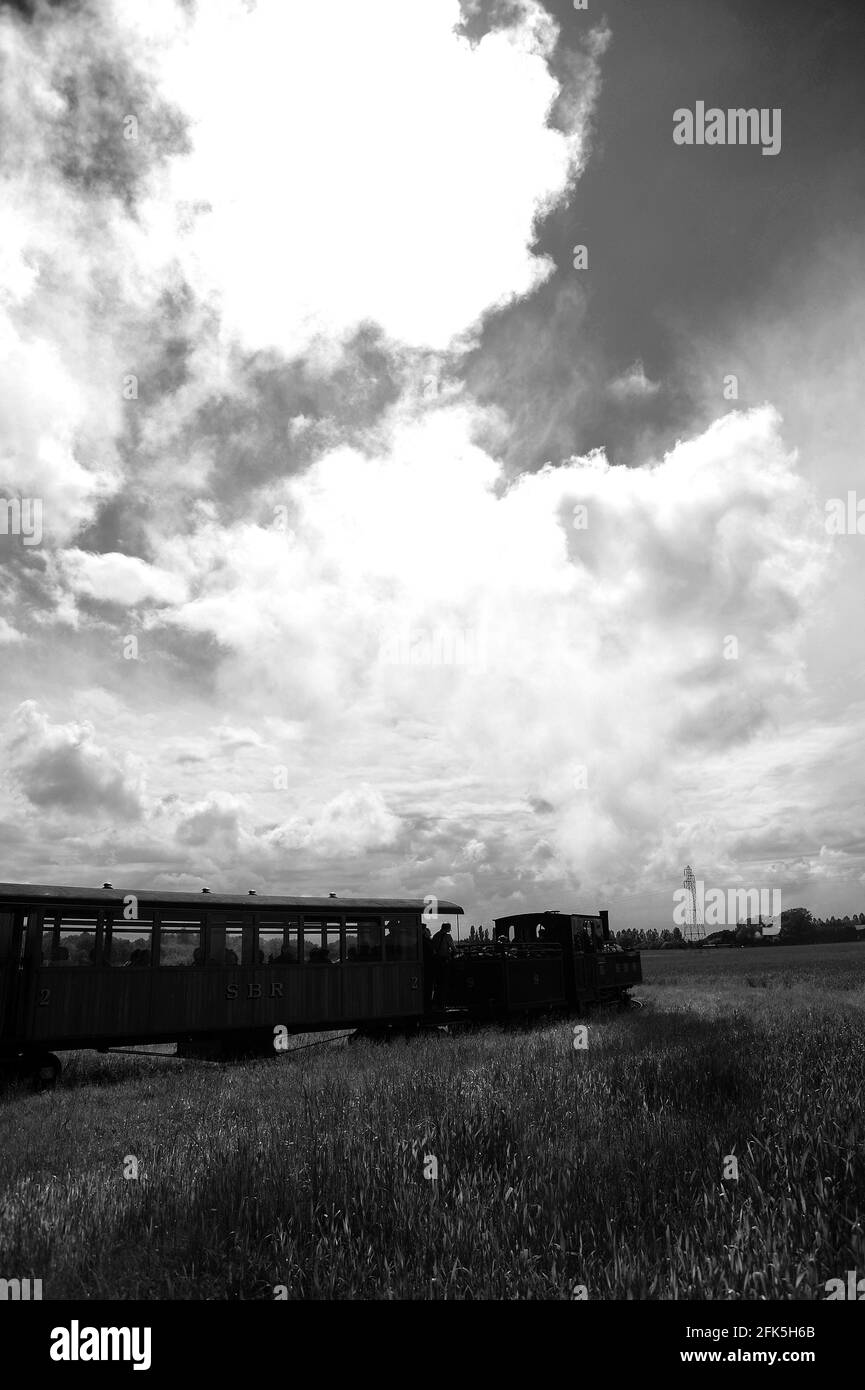 'SBR No. 9' leads its train around the balloon loop with 'Saccharine' at the rear. Stock Photohttps://www.alamy.com/image-license-details/?v=1https://www.alamy.com/sbr-no-9-leads-its-train-around-the-balloon-loop-with-saccharine-at-the-rear-image424850563.html
'SBR No. 9' leads its train around the balloon loop with 'Saccharine' at the rear. Stock Photohttps://www.alamy.com/image-license-details/?v=1https://www.alamy.com/sbr-no-9-leads-its-train-around-the-balloon-loop-with-saccharine-at-the-rear-image424850563.htmlRF2FK5H6B–'SBR No. 9' leads its train around the balloon loop with 'Saccharine' at the rear.
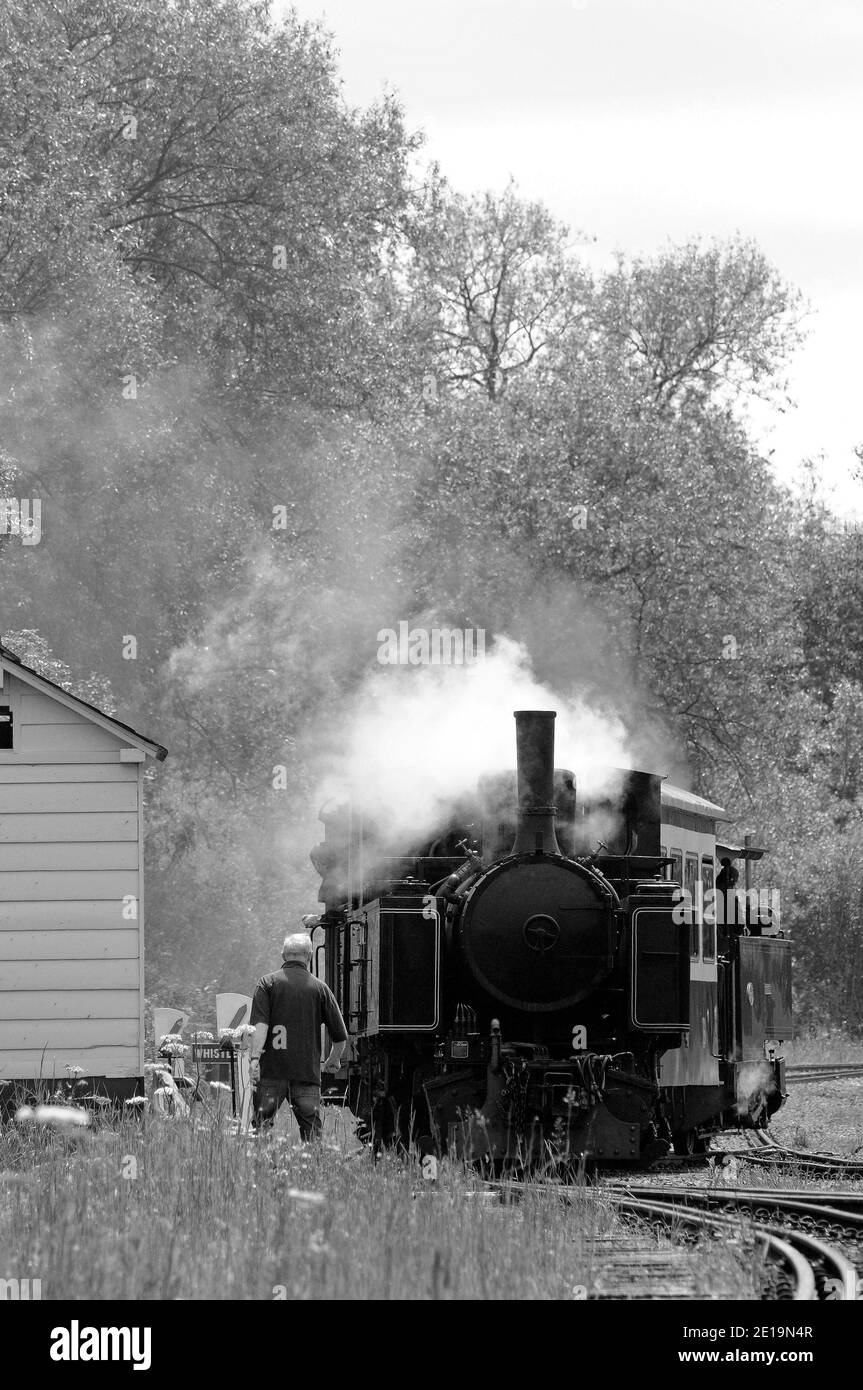 SBR No. 9 at the rear of a train hauled by 'Saccharine', leaving the balloon loop. Stock Photohttps://www.alamy.com/image-license-details/?v=1https://www.alamy.com/sbr-no-9-at-the-rear-of-a-train-hauled-by-saccharine-leaving-the-balloon-loop-image396667287.html
SBR No. 9 at the rear of a train hauled by 'Saccharine', leaving the balloon loop. Stock Photohttps://www.alamy.com/image-license-details/?v=1https://www.alamy.com/sbr-no-9-at-the-rear-of-a-train-hauled-by-saccharine-leaving-the-balloon-loop-image396667287.htmlRF2E19N4R–SBR No. 9 at the rear of a train hauled by 'Saccharine', leaving the balloon loop.
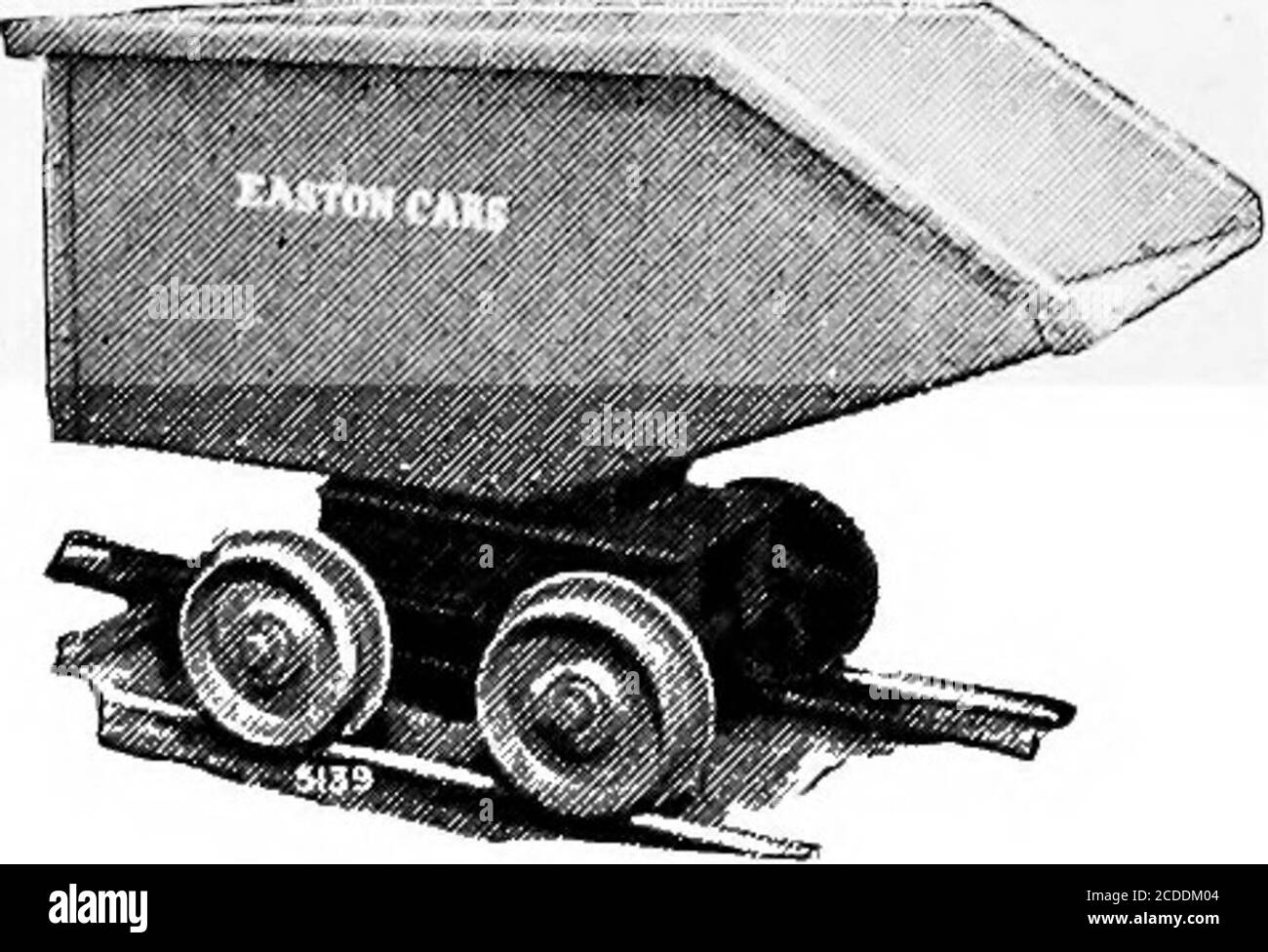 . Material handling cyclopedia; a reference book covering definitions, descriptions, illustrations and methods of use of material handling machines employed in industry . Fig. 1005. STANDARD PLATFORM CAB Platfm. = s Code Word Dim en. 5 1 1 S XI 0) M 0 (5 •^3 g w ^ <) ^S Isw ^Ci s a.s ^.s Stobrorum 49 S-O IB 12 1% S 20 20 1%* ?,-ii EOO Staehetto bli/- S4» 15 12 1% 5 24 24 !?-8 650 Stockblind «0 40 15 12 1% 5 24 24 1% 2-3 640 Saber 60« 4-0 18 14 2 6 80 24 1% B 825 Sable B-O idf 19 16 2yv 6 42 3fl iy 5 1,200 Saccharine 120* BO 22 16 i?4 7 1 72 48% i% 6 2,C00. Fig. 5139. STANDARD SCOOP CAR a Bo Stock Photohttps://www.alamy.com/image-license-details/?v=1https://www.alamy.com/material-handling-cyclopedia-a-reference-book-covering-definitions-descriptions-illustrations-and-methods-of-use-of-material-handling-machines-employed-in-industry-fig-1005-standard-platform-cab-platfm-=-s-code-word-dim-en-5-1-1-s-xi-0-m-0-5-3-g-w-lt-s-isw-ci-s-as-s-stobrorum-49-s-o-ib-12-1-s-20-20-1-ii-eoo-staehetto-bli-s4-15-12-1-5-24-24-!-8-650-stockblind-0-40-15-12-1-5-24-24-1-2-3-640-saber-60-4-0-18-14-2-6-80-24-1-b-825-sable-b-o-idf-19-16-2yv-6-42-3fl-iy-5-1200-saccharine-120-bo-22-16-i4-7-1-72-48-i-6-2c00-fig-5139-standard-scoop-car-a-bo-image369709316.html
. Material handling cyclopedia; a reference book covering definitions, descriptions, illustrations and methods of use of material handling machines employed in industry . Fig. 1005. STANDARD PLATFORM CAB Platfm. = s Code Word Dim en. 5 1 1 S XI 0) M 0 (5 •^3 g w ^ <) ^S Isw ^Ci s a.s ^.s Stobrorum 49 S-O IB 12 1% S 20 20 1%* ?,-ii EOO Staehetto bli/- S4» 15 12 1% 5 24 24 !?-8 650 Stockblind «0 40 15 12 1% 5 24 24 1% 2-3 640 Saber 60« 4-0 18 14 2 6 80 24 1% B 825 Sable B-O idf 19 16 2yv 6 42 3fl iy 5 1,200 Saccharine 120* BO 22 16 i?4 7 1 72 48% i% 6 2,C00. Fig. 5139. STANDARD SCOOP CAR a Bo Stock Photohttps://www.alamy.com/image-license-details/?v=1https://www.alamy.com/material-handling-cyclopedia-a-reference-book-covering-definitions-descriptions-illustrations-and-methods-of-use-of-material-handling-machines-employed-in-industry-fig-1005-standard-platform-cab-platfm-=-s-code-word-dim-en-5-1-1-s-xi-0-m-0-5-3-g-w-lt-s-isw-ci-s-as-s-stobrorum-49-s-o-ib-12-1-s-20-20-1-ii-eoo-staehetto-bli-s4-15-12-1-5-24-24-!-8-650-stockblind-0-40-15-12-1-5-24-24-1-2-3-640-saber-60-4-0-18-14-2-6-80-24-1-b-825-sable-b-o-idf-19-16-2yv-6-42-3fl-iy-5-1200-saccharine-120-bo-22-16-i4-7-1-72-48-i-6-2c00-fig-5139-standard-scoop-car-a-bo-image369709316.htmlRM2CDDM04–. Material handling cyclopedia; a reference book covering definitions, descriptions, illustrations and methods of use of material handling machines employed in industry . Fig. 1005. STANDARD PLATFORM CAB Platfm. = s Code Word Dim en. 5 1 1 S XI 0) M 0 (5 •^3 g w ^ <) ^S Isw ^Ci s a.s ^.s Stobrorum 49 S-O IB 12 1% S 20 20 1%* ?,-ii EOO Staehetto bli/- S4» 15 12 1% 5 24 24 !?-8 650 Stockblind «0 40 15 12 1% 5 24 24 1% 2-3 640 Saber 60« 4-0 18 14 2 6 80 24 1% B 825 Sable B-O idf 19 16 2yv 6 42 3fl iy 5 1,200 Saccharine 120* BO 22 16 i?4 7 1 72 48% i% 6 2,C00. Fig. 5139. STANDARD SCOOP CAR a Bo
 S.B.R. 'no.9' approaching Oak Tree Halt. 'Saccharine' is at the rear of the train. Stock Photohttps://www.alamy.com/image-license-details/?v=1https://www.alamy.com/sbr-no9-approaching-oak-tree-halt-saccharine-is-at-the-rear-of-the-train-image386484745.html
S.B.R. 'no.9' approaching Oak Tree Halt. 'Saccharine' is at the rear of the train. Stock Photohttps://www.alamy.com/image-license-details/?v=1https://www.alamy.com/sbr-no9-approaching-oak-tree-halt-saccharine-is-at-the-rear-of-the-train-image386484745.htmlRF2DCNW6H–S.B.R. 'no.9' approaching Oak Tree Halt. 'Saccharine' is at the rear of the train.
 THE AQUATIC ARENA AT PARIS. Sugar as an Anti.Incrustator in Steam Boilers. The Brennan Torpedo. Saccharine. Avoid Lawsuits. GENERAL VIEW OF THE SWIMMING BATHS AT, scientific american, 1886-10-30 Stock Photohttps://www.alamy.com/image-license-details/?v=1https://www.alamy.com/the-aquatic-arena-at-paris-sugar-as-an-antiincrustator-in-steam-boilers-the-brennan-torpedo-saccharine-avoid-lawsuits-general-view-of-the-swimming-baths-at-scientific-american-1886-10-30-image334329943.html
THE AQUATIC ARENA AT PARIS. Sugar as an Anti.Incrustator in Steam Boilers. The Brennan Torpedo. Saccharine. Avoid Lawsuits. GENERAL VIEW OF THE SWIMMING BATHS AT, scientific american, 1886-10-30 Stock Photohttps://www.alamy.com/image-license-details/?v=1https://www.alamy.com/the-aquatic-arena-at-paris-sugar-as-an-antiincrustator-in-steam-boilers-the-brennan-torpedo-saccharine-avoid-lawsuits-general-view-of-the-swimming-baths-at-scientific-american-1886-10-30-image334329943.htmlRM2ABX173–THE AQUATIC ARENA AT PARIS. Sugar as an Anti.Incrustator in Steam Boilers. The Brennan Torpedo. Saccharine. Avoid Lawsuits. GENERAL VIEW OF THE SWIMMING BATHS AT, scientific american, 1886-10-30
RF3CC9G79–Icon for sweet, sweetened
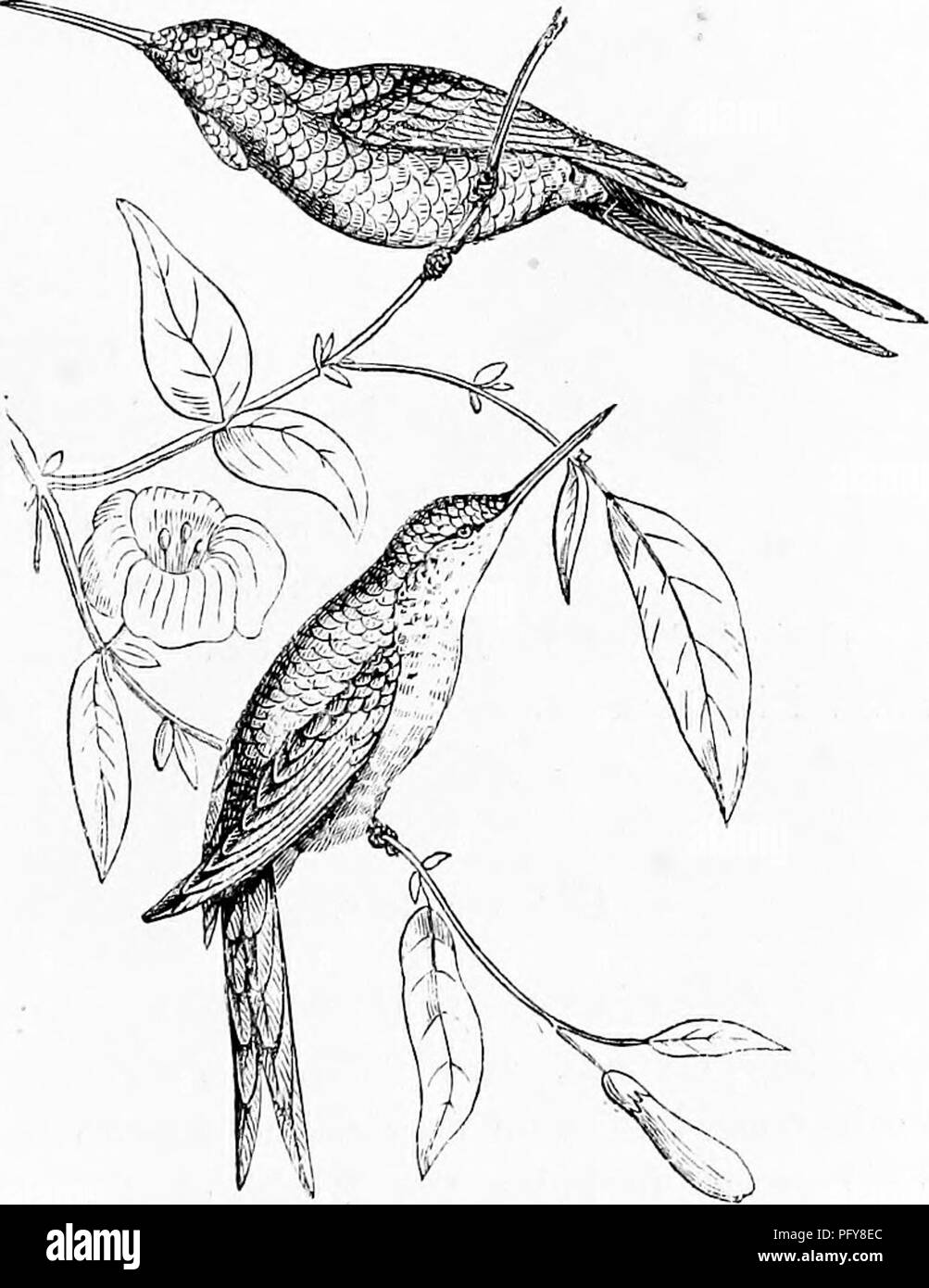 . Reptiles and birds. A popular account of the various orders; with a description of the habits and economy of the most interesting. Birds; Reptiles. SUCEIERS. 497 tliat of tlie Annumhi is fifteen inches in diameter by twenty- inches in height. The SucRTEKS (Cinnyridm) are American birds, so called from their attachment to saccharine substances. They feed on honey they extract from flowers, and the sap from the sugar-cane, the juice of which they suck through crevices in the stem. Like the Humming-birds, they have the tongue divided into two parts, by which they are enabled to seize insects, w Stock Photohttps://www.alamy.com/image-license-details/?v=1https://www.alamy.com/reptiles-and-birds-a-popular-account-of-the-various-orders-with-a-description-of-the-habits-and-economy-of-the-most-interesting-birds-reptiles-suceiers-497-tliat-of-tlie-annumhi-is-fifteen-inches-in-diameter-by-twenty-inches-in-height-the-sucrteks-cinnyridm-are-american-birds-so-called-from-their-attachment-to-saccharine-substances-they-feed-on-honey-they-extract-from-flowers-and-the-sap-from-the-sugar-cane-the-juice-of-which-they-suck-through-crevices-in-the-stem-like-the-humming-birds-they-have-the-tongue-divided-into-two-parts-by-which-they-are-enabled-to-seize-insects-w-image216343636.html
. Reptiles and birds. A popular account of the various orders; with a description of the habits and economy of the most interesting. Birds; Reptiles. SUCEIERS. 497 tliat of tlie Annumhi is fifteen inches in diameter by twenty- inches in height. The SucRTEKS (Cinnyridm) are American birds, so called from their attachment to saccharine substances. They feed on honey they extract from flowers, and the sap from the sugar-cane, the juice of which they suck through crevices in the stem. Like the Humming-birds, they have the tongue divided into two parts, by which they are enabled to seize insects, w Stock Photohttps://www.alamy.com/image-license-details/?v=1https://www.alamy.com/reptiles-and-birds-a-popular-account-of-the-various-orders-with-a-description-of-the-habits-and-economy-of-the-most-interesting-birds-reptiles-suceiers-497-tliat-of-tlie-annumhi-is-fifteen-inches-in-diameter-by-twenty-inches-in-height-the-sucrteks-cinnyridm-are-american-birds-so-called-from-their-attachment-to-saccharine-substances-they-feed-on-honey-they-extract-from-flowers-and-the-sap-from-the-sugar-cane-the-juice-of-which-they-suck-through-crevices-in-the-stem-like-the-humming-birds-they-have-the-tongue-divided-into-two-parts-by-which-they-are-enabled-to-seize-insects-w-image216343636.htmlRMPFY8EC–. Reptiles and birds. A popular account of the various orders; with a description of the habits and economy of the most interesting. Birds; Reptiles. SUCEIERS. 497 tliat of tlie Annumhi is fifteen inches in diameter by twenty- inches in height. The SucRTEKS (Cinnyridm) are American birds, so called from their attachment to saccharine substances. They feed on honey they extract from flowers, and the sap from the sugar-cane, the juice of which they suck through crevices in the stem. Like the Humming-birds, they have the tongue divided into two parts, by which they are enabled to seize insects, w
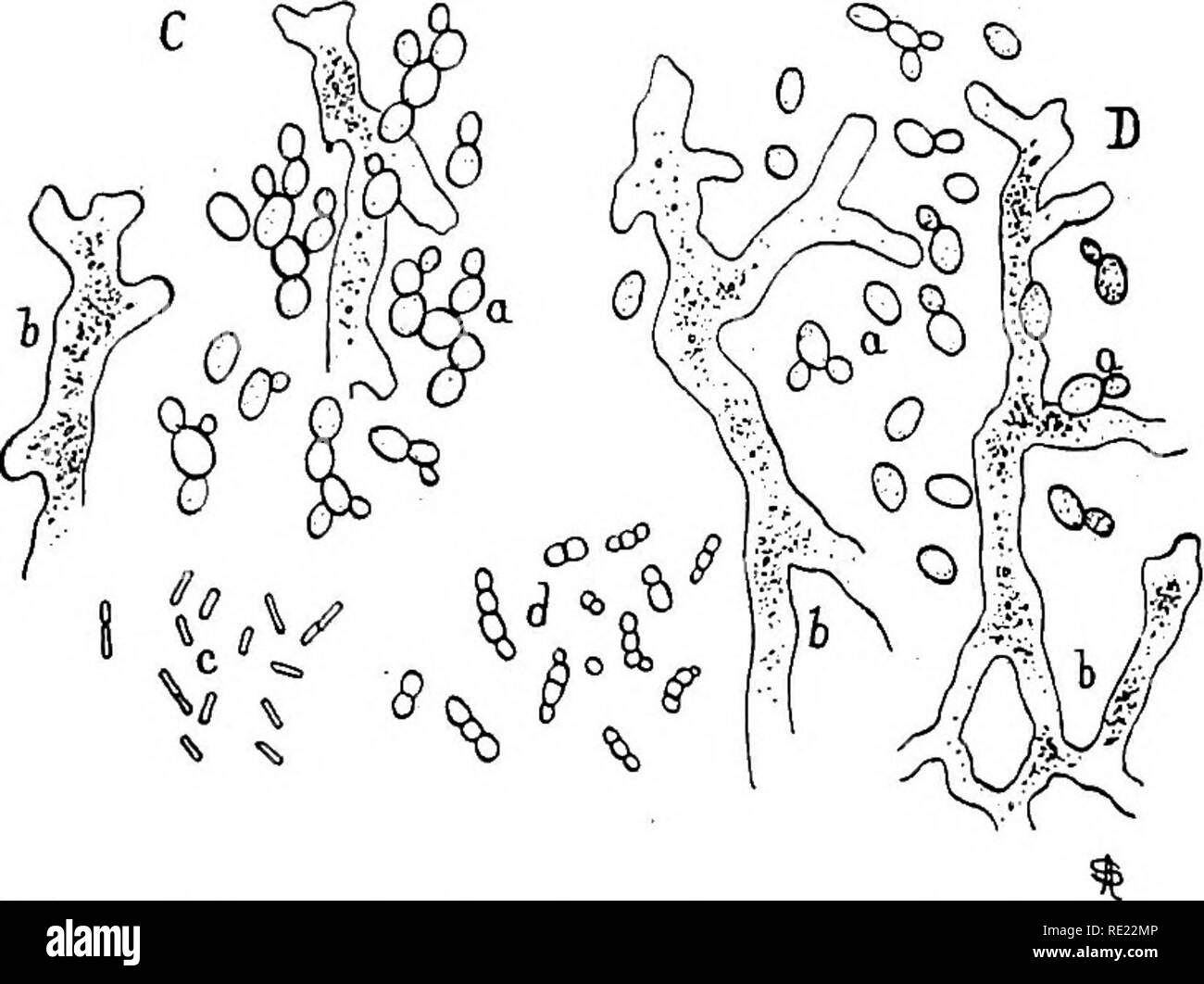 . Pharmaceutical bacteriology. Bacteriology; Disinfection and disinfectants. ^0 ^^ B 0 ®. Fig. 78.—Sak6 making. A, Dead or dying yeast cells; B, active yeast cells which convert the saccharine substances formed by the aspergillus into alcohol. C, D, yeast cells and hyphas of aspergillus from the fermenting vats. that of sake. More generally, however, arrak is made from fermented mo- lasses. There are many other species of mold, including the very com- mon Penicillium glaucum, which have the power of converting starch into saccharine compounds in the presence of moisture, but thus far these are Stock Photohttps://www.alamy.com/image-license-details/?v=1https://www.alamy.com/pharmaceutical-bacteriology-bacteriology-disinfection-and-disinfectants-0-b-0-fig-78sak6-making-a-dead-or-dying-yeast-cells-b-active-yeast-cells-which-convert-the-saccharine-substances-formed-by-the-aspergillus-into-alcohol-c-d-yeast-cells-and-hyphas-of-aspergillus-from-the-fermenting-vats-that-of-sake-more-generally-however-arrak-is-made-from-fermented-mo-lasses-there-are-many-other-species-of-mold-including-the-very-com-mon-penicillium-glaucum-which-have-the-power-of-converting-starch-into-saccharine-compounds-in-the-presence-of-moisture-but-thus-far-these-are-image232386022.html
. Pharmaceutical bacteriology. Bacteriology; Disinfection and disinfectants. ^0 ^^ B 0 ®. Fig. 78.—Sak6 making. A, Dead or dying yeast cells; B, active yeast cells which convert the saccharine substances formed by the aspergillus into alcohol. C, D, yeast cells and hyphas of aspergillus from the fermenting vats. that of sake. More generally, however, arrak is made from fermented mo- lasses. There are many other species of mold, including the very com- mon Penicillium glaucum, which have the power of converting starch into saccharine compounds in the presence of moisture, but thus far these are Stock Photohttps://www.alamy.com/image-license-details/?v=1https://www.alamy.com/pharmaceutical-bacteriology-bacteriology-disinfection-and-disinfectants-0-b-0-fig-78sak6-making-a-dead-or-dying-yeast-cells-b-active-yeast-cells-which-convert-the-saccharine-substances-formed-by-the-aspergillus-into-alcohol-c-d-yeast-cells-and-hyphas-of-aspergillus-from-the-fermenting-vats-that-of-sake-more-generally-however-arrak-is-made-from-fermented-mo-lasses-there-are-many-other-species-of-mold-including-the-very-com-mon-penicillium-glaucum-which-have-the-power-of-converting-starch-into-saccharine-compounds-in-the-presence-of-moisture-but-thus-far-these-are-image232386022.htmlRMRE22MP–. Pharmaceutical bacteriology. Bacteriology; Disinfection and disinfectants. ^0 ^^ B 0 ®. Fig. 78.—Sak6 making. A, Dead or dying yeast cells; B, active yeast cells which convert the saccharine substances formed by the aspergillus into alcohol. C, D, yeast cells and hyphas of aspergillus from the fermenting vats. that of sake. More generally, however, arrak is made from fermented mo- lasses. There are many other species of mold, including the very com- mon Penicillium glaucum, which have the power of converting starch into saccharine compounds in the presence of moisture, but thus far these are
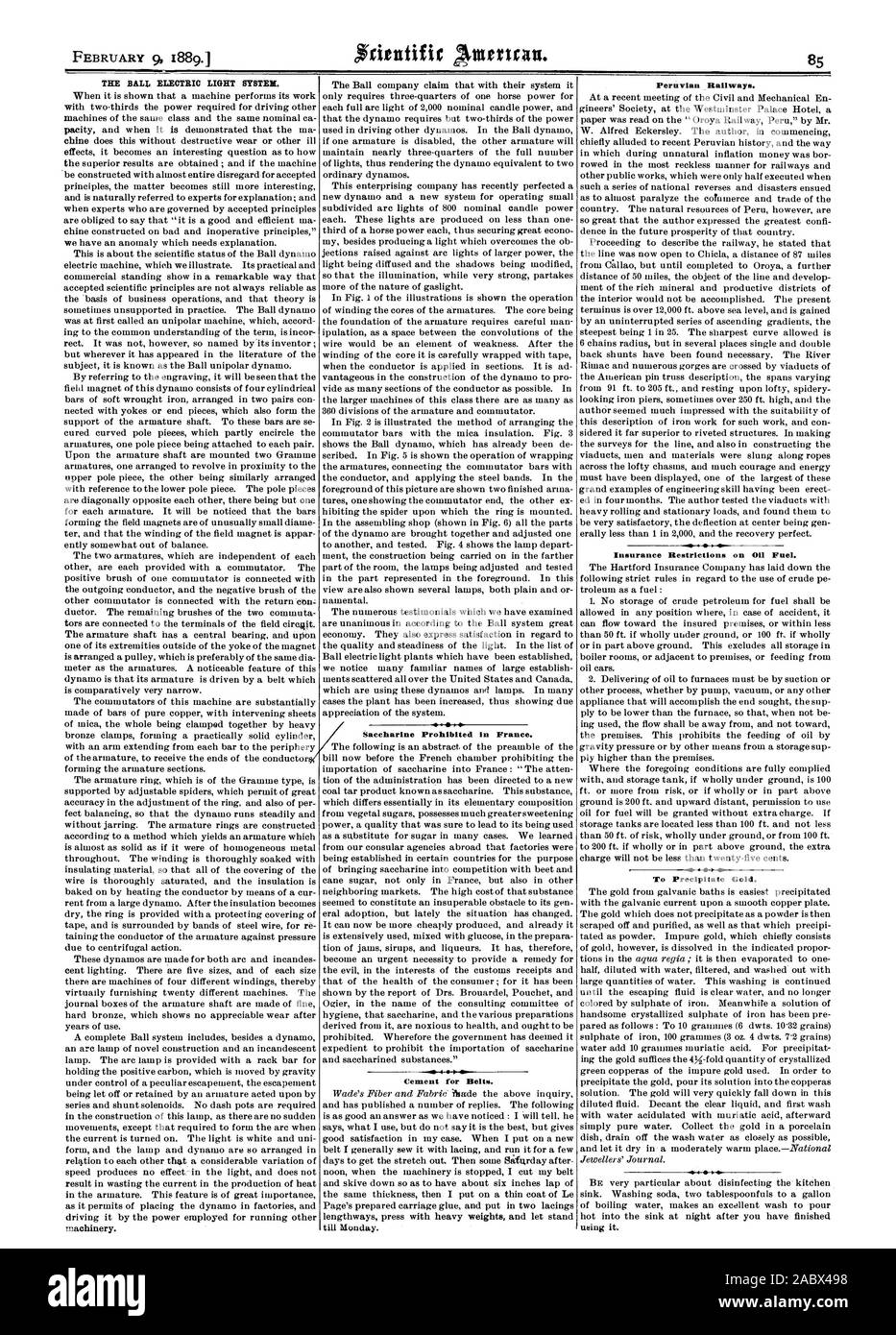 THE BALL ELECTRIC LIGHT SYSTEM. machinery. The Ball company claim that with their system it ob. Saccharine Prohibited in France. Cement for Belts. Peruvian Railways. Insurance Restrictions on 0 Fuel. To Precipitate Gold., scientific american, 1889-02-09 Stock Photohttps://www.alamy.com/image-license-details/?v=1https://www.alamy.com/the-ball-electric-light-system-machinery-the-ball-company-claim-that-with-their-system-it-ob-saccharine-prohibited-in-france-cement-for-belts-peruvian-railways-insurance-restrictions-on-0-fuel-to-precipitate-gold-scientific-american-1889-02-09-image334332356.html
THE BALL ELECTRIC LIGHT SYSTEM. machinery. The Ball company claim that with their system it ob. Saccharine Prohibited in France. Cement for Belts. Peruvian Railways. Insurance Restrictions on 0 Fuel. To Precipitate Gold., scientific american, 1889-02-09 Stock Photohttps://www.alamy.com/image-license-details/?v=1https://www.alamy.com/the-ball-electric-light-system-machinery-the-ball-company-claim-that-with-their-system-it-ob-saccharine-prohibited-in-france-cement-for-belts-peruvian-railways-insurance-restrictions-on-0-fuel-to-precipitate-gold-scientific-american-1889-02-09-image334332356.htmlRM2ABX498–THE BALL ELECTRIC LIGHT SYSTEM. machinery. The Ball company claim that with their system it ob. Saccharine Prohibited in France. Cement for Belts. Peruvian Railways. Insurance Restrictions on 0 Fuel. To Precipitate Gold., scientific american, 1889-02-09
RF3BMNJK5–Icon for sugar, sweetened
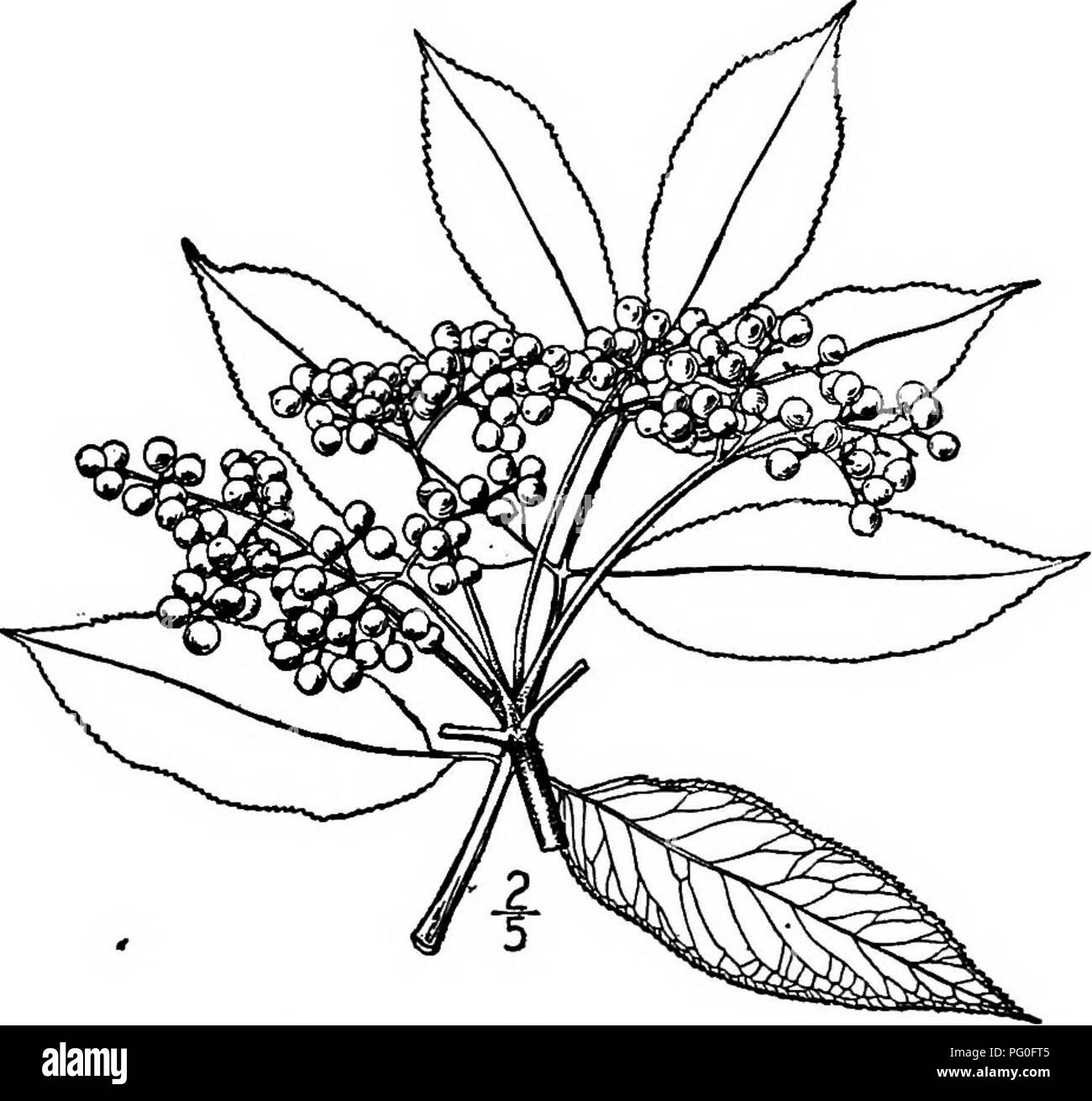 . North American trees : being descriptions and illustrations of the trees growing independently of cultivation in North America, north of Mexico and the West Indies . Trees. 852 The Elders with saccharine matter they are fermented into "elder-flower wine." The dried flowers are used in decoction as a diaphoretic. The fruit is likewise made into wine, and when mixed with some acidulous fruit, as apples, is made into pies and jeUies. The woody stems with the large pith removed have been used as tubes, especially for tapping maple-sugar trees. The bark and root are said to be poisonous Stock Photohttps://www.alamy.com/image-license-details/?v=1https://www.alamy.com/north-american-trees-being-descriptions-and-illustrations-of-the-trees-growing-independently-of-cultivation-in-north-america-north-of-mexico-and-the-west-indies-trees-852-the-elders-with-saccharine-matter-they-are-fermented-into-quotelder-flower-winequot-the-dried-flowers-are-used-in-decoction-as-a-diaphoretic-the-fruit-is-likewise-made-into-wine-and-when-mixed-with-some-acidulous-fruit-as-apples-is-made-into-pies-and-jeuies-the-woody-stems-with-the-large-pith-removed-have-been-used-as-tubes-especially-for-tapping-maple-sugar-trees-the-bark-and-root-are-said-to-be-poisonous-image216371349.html
. North American trees : being descriptions and illustrations of the trees growing independently of cultivation in North America, north of Mexico and the West Indies . Trees. 852 The Elders with saccharine matter they are fermented into "elder-flower wine." The dried flowers are used in decoction as a diaphoretic. The fruit is likewise made into wine, and when mixed with some acidulous fruit, as apples, is made into pies and jeUies. The woody stems with the large pith removed have been used as tubes, especially for tapping maple-sugar trees. The bark and root are said to be poisonous Stock Photohttps://www.alamy.com/image-license-details/?v=1https://www.alamy.com/north-american-trees-being-descriptions-and-illustrations-of-the-trees-growing-independently-of-cultivation-in-north-america-north-of-mexico-and-the-west-indies-trees-852-the-elders-with-saccharine-matter-they-are-fermented-into-quotelder-flower-winequot-the-dried-flowers-are-used-in-decoction-as-a-diaphoretic-the-fruit-is-likewise-made-into-wine-and-when-mixed-with-some-acidulous-fruit-as-apples-is-made-into-pies-and-jeuies-the-woody-stems-with-the-large-pith-removed-have-been-used-as-tubes-especially-for-tapping-maple-sugar-trees-the-bark-and-root-are-said-to-be-poisonous-image216371349.htmlRMPG0FT5–. North American trees : being descriptions and illustrations of the trees growing independently of cultivation in North America, north of Mexico and the West Indies . Trees. 852 The Elders with saccharine matter they are fermented into "elder-flower wine." The dried flowers are used in decoction as a diaphoretic. The fruit is likewise made into wine, and when mixed with some acidulous fruit, as apples, is made into pies and jeUies. The woody stems with the large pith removed have been used as tubes, especially for tapping maple-sugar trees. The bark and root are said to be poisonous
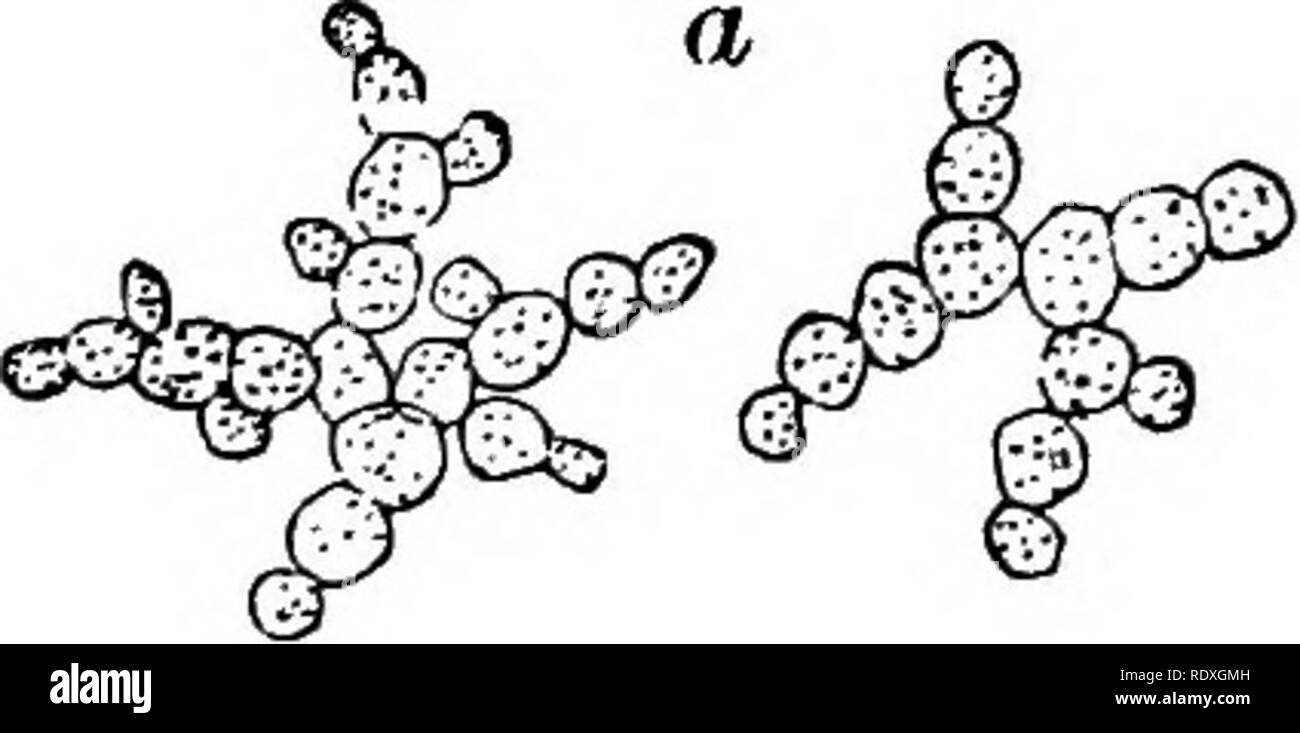 . Introduction to the study of fungi; their organography, classification, and distribution, for the use of collectors. Fungi. SCH1Z0MYCETES AND SACCHAROMYCETES 301 All saccharine fluids which contain glucose, or grape sugar, or a sugar which can be changed into glucose, and also all nitrogenous substances, phosphates, and ammoniacal salts, produce alcohol at a given temperature. The process of con- version is by fermentation. Pasteur states that every fermentation has its specific ferment; in all fermentations in which the presence of an organised ferment has been ascer- tained that ferment is Stock Photohttps://www.alamy.com/image-license-details/?v=1https://www.alamy.com/introduction-to-the-study-of-fungi-their-organography-classification-and-distribution-for-the-use-of-collectors-fungi-sch1z0mycetes-and-saccharomycetes-301-all-saccharine-fluids-which-contain-glucose-or-grape-sugar-or-a-sugar-which-can-be-changed-into-glucose-and-also-all-nitrogenous-substances-phosphates-and-ammoniacal-salts-produce-alcohol-at-a-given-temperature-the-process-of-con-version-is-by-fermentation-pasteur-states-that-every-fermentation-has-its-specific-ferment-in-all-fermentations-in-which-the-presence-of-an-organised-ferment-has-been-ascer-tained-that-ferment-is-image232309185.html
. Introduction to the study of fungi; their organography, classification, and distribution, for the use of collectors. Fungi. SCH1Z0MYCETES AND SACCHAROMYCETES 301 All saccharine fluids which contain glucose, or grape sugar, or a sugar which can be changed into glucose, and also all nitrogenous substances, phosphates, and ammoniacal salts, produce alcohol at a given temperature. The process of con- version is by fermentation. Pasteur states that every fermentation has its specific ferment; in all fermentations in which the presence of an organised ferment has been ascer- tained that ferment is Stock Photohttps://www.alamy.com/image-license-details/?v=1https://www.alamy.com/introduction-to-the-study-of-fungi-their-organography-classification-and-distribution-for-the-use-of-collectors-fungi-sch1z0mycetes-and-saccharomycetes-301-all-saccharine-fluids-which-contain-glucose-or-grape-sugar-or-a-sugar-which-can-be-changed-into-glucose-and-also-all-nitrogenous-substances-phosphates-and-ammoniacal-salts-produce-alcohol-at-a-given-temperature-the-process-of-con-version-is-by-fermentation-pasteur-states-that-every-fermentation-has-its-specific-ferment-in-all-fermentations-in-which-the-presence-of-an-organised-ferment-has-been-ascer-tained-that-ferment-is-image232309185.htmlRMRDXGMH–. Introduction to the study of fungi; their organography, classification, and distribution, for the use of collectors. Fungi. SCH1Z0MYCETES AND SACCHAROMYCETES 301 All saccharine fluids which contain glucose, or grape sugar, or a sugar which can be changed into glucose, and also all nitrogenous substances, phosphates, and ammoniacal salts, produce alcohol at a given temperature. The process of con- version is by fermentation. Pasteur states that every fermentation has its specific ferment; in all fermentations in which the presence of an organised ferment has been ascer- tained that ferment is
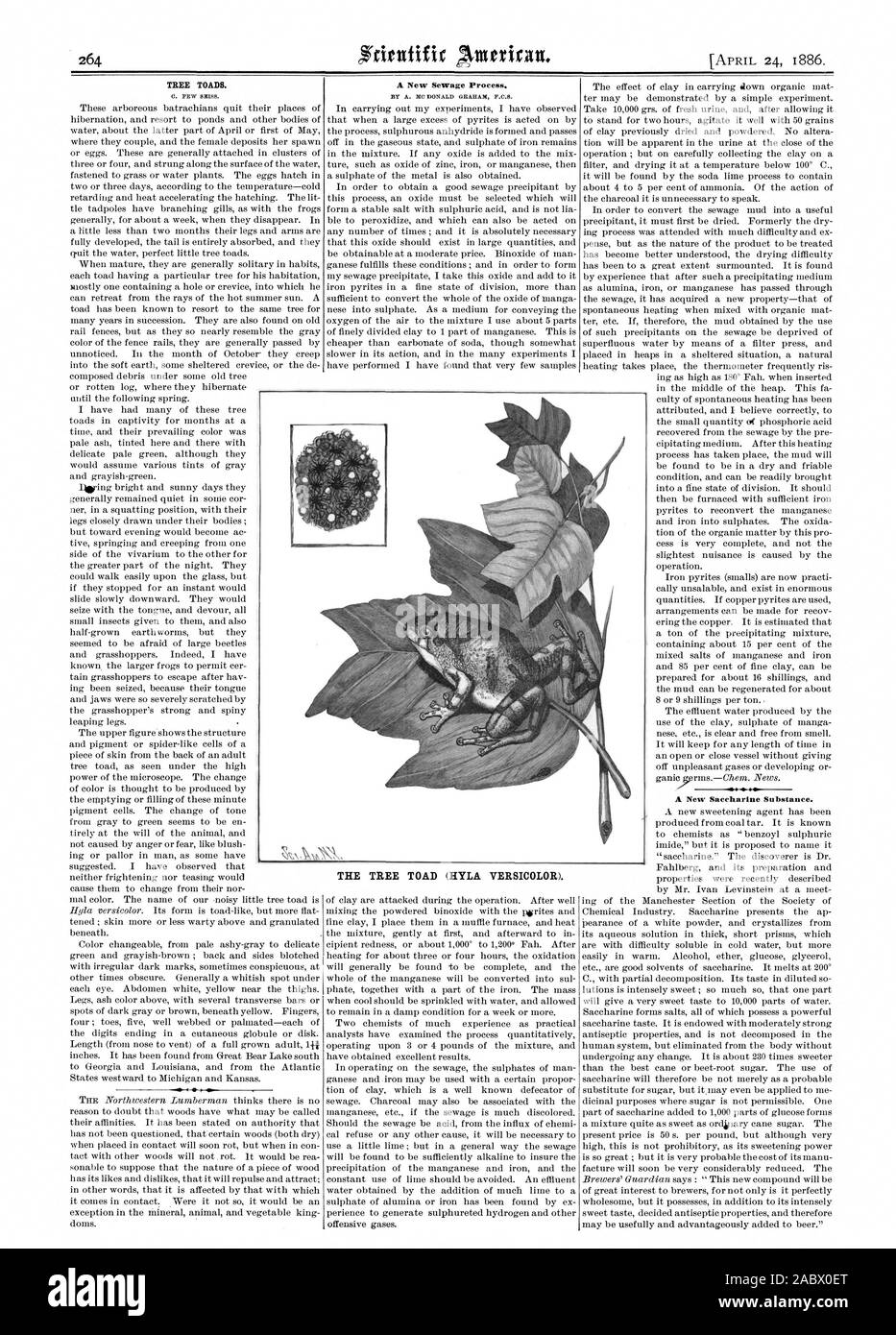 TREE TOADS. C. FEW SEM. A New Sewage Process. BY A. MC DONALD GRAHAM P.0.13. S A New Saccharine Substance. THE TREE TOAD (HYLA VERSICOLOR)., scientific american, 1886-04-24 Stock Photohttps://www.alamy.com/image-license-details/?v=1https://www.alamy.com/tree-toads-c-few-sem-a-new-sewage-process-by-a-mc-donald-graham-p013-s-a-new-saccharine-substance-the-tree-toad-hyla-versicolor-scientific-american-1886-04-24-image334329376.html
TREE TOADS. C. FEW SEM. A New Sewage Process. BY A. MC DONALD GRAHAM P.0.13. S A New Saccharine Substance. THE TREE TOAD (HYLA VERSICOLOR)., scientific american, 1886-04-24 Stock Photohttps://www.alamy.com/image-license-details/?v=1https://www.alamy.com/tree-toads-c-few-sem-a-new-sewage-process-by-a-mc-donald-graham-p013-s-a-new-saccharine-substance-the-tree-toad-hyla-versicolor-scientific-american-1886-04-24-image334329376.htmlRM2ABX0ET–TREE TOADS. C. FEW SEM. A New Sewage Process. BY A. MC DONALD GRAHAM P.0.13. S A New Saccharine Substance. THE TREE TOAD (HYLA VERSICOLOR)., scientific american, 1886-04-24
RF3CD9RJ4–Icon for sweet, ladoo
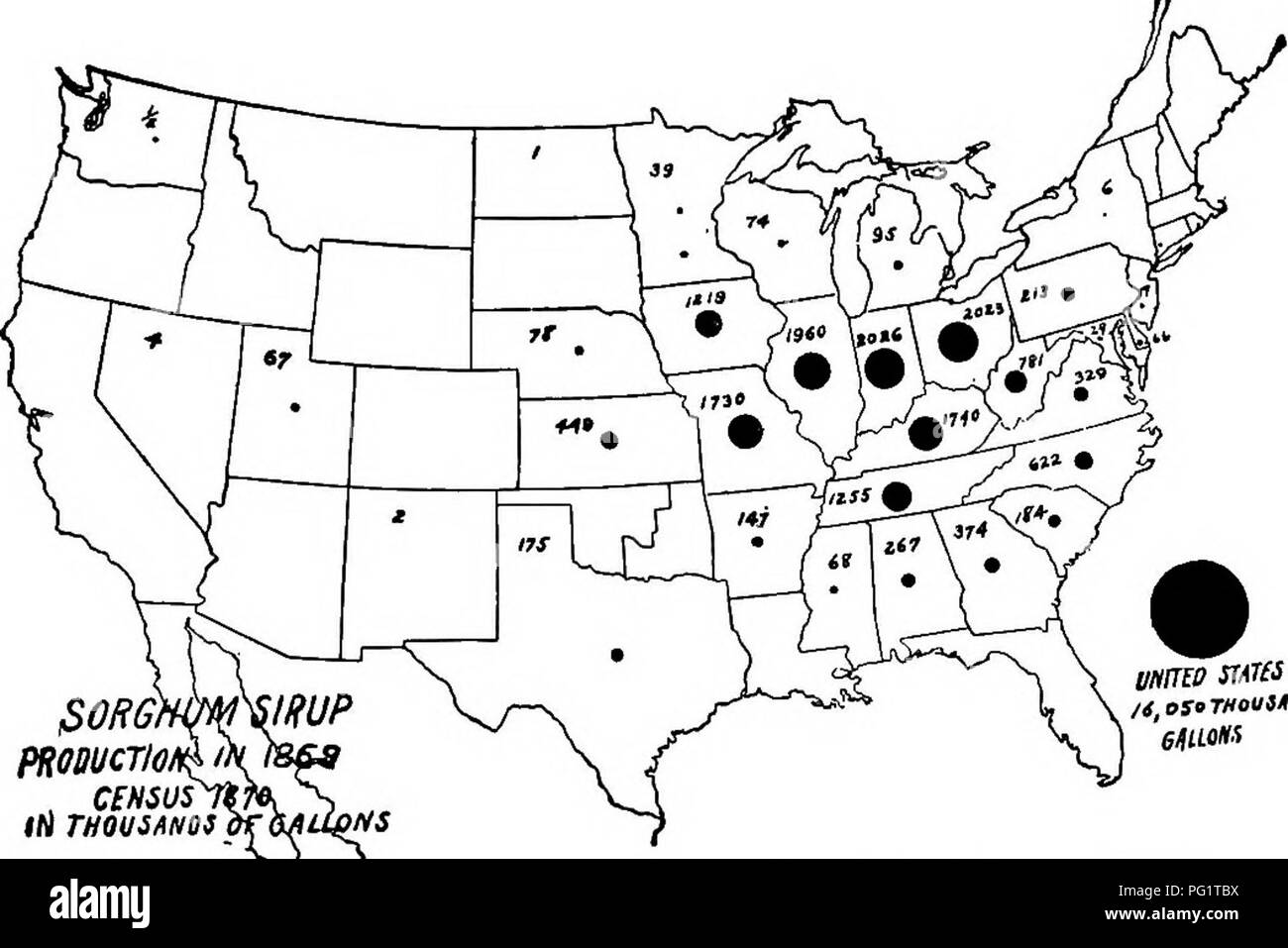 . The corn crops: a discussion of maize, kafirs, and sorghums as grown in the United States and Canada. Corn; Kafir corn; Sorghum. THE SACCHARINE SORGHUMS 295. $ORGi , CCMSUV1 II) THOUUNOS Fig. 97—Production of sorghum sirup middle of laat century.. Please note that these images are extracted from scanned page images that may have been digitally enhanced for readability - coloration and appearance of these illustrations may not perfectly resemble the original work.. Montgomery, Edward Gerrard, 1878-. New York, The Macmillan company Stock Photohttps://www.alamy.com/image-license-details/?v=1https://www.alamy.com/the-corn-crops-a-discussion-of-maize-kafirs-and-sorghums-as-grown-in-the-united-states-and-canada-corn-kafir-corn-sorghum-the-saccharine-sorghums-295-orgi-ccmsuv1-ii-thouunos-fig-97production-of-sorghum-sirup-middle-of-laat-century-please-note-that-these-images-are-extracted-from-scanned-page-images-that-may-have-been-digitally-enhanced-for-readability-coloration-and-appearance-of-these-illustrations-may-not-perfectly-resemble-the-original-work-montgomery-edward-gerrard-1878-new-york-the-macmillan-company-image216400014.html
. The corn crops: a discussion of maize, kafirs, and sorghums as grown in the United States and Canada. Corn; Kafir corn; Sorghum. THE SACCHARINE SORGHUMS 295. $ORGi , CCMSUV1 II) THOUUNOS Fig. 97—Production of sorghum sirup middle of laat century.. Please note that these images are extracted from scanned page images that may have been digitally enhanced for readability - coloration and appearance of these illustrations may not perfectly resemble the original work.. Montgomery, Edward Gerrard, 1878-. New York, The Macmillan company Stock Photohttps://www.alamy.com/image-license-details/?v=1https://www.alamy.com/the-corn-crops-a-discussion-of-maize-kafirs-and-sorghums-as-grown-in-the-united-states-and-canada-corn-kafir-corn-sorghum-the-saccharine-sorghums-295-orgi-ccmsuv1-ii-thouunos-fig-97production-of-sorghum-sirup-middle-of-laat-century-please-note-that-these-images-are-extracted-from-scanned-page-images-that-may-have-been-digitally-enhanced-for-readability-coloration-and-appearance-of-these-illustrations-may-not-perfectly-resemble-the-original-work-montgomery-edward-gerrard-1878-new-york-the-macmillan-company-image216400014.htmlRMPG1TBX–. The corn crops: a discussion of maize, kafirs, and sorghums as grown in the United States and Canada. Corn; Kafir corn; Sorghum. THE SACCHARINE SORGHUMS 295. $ORGi , CCMSUV1 II) THOUUNOS Fig. 97—Production of sorghum sirup middle of laat century.. Please note that these images are extracted from scanned page images that may have been digitally enhanced for readability - coloration and appearance of these illustrations may not perfectly resemble the original work.. Montgomery, Edward Gerrard, 1878-. New York, The Macmillan company
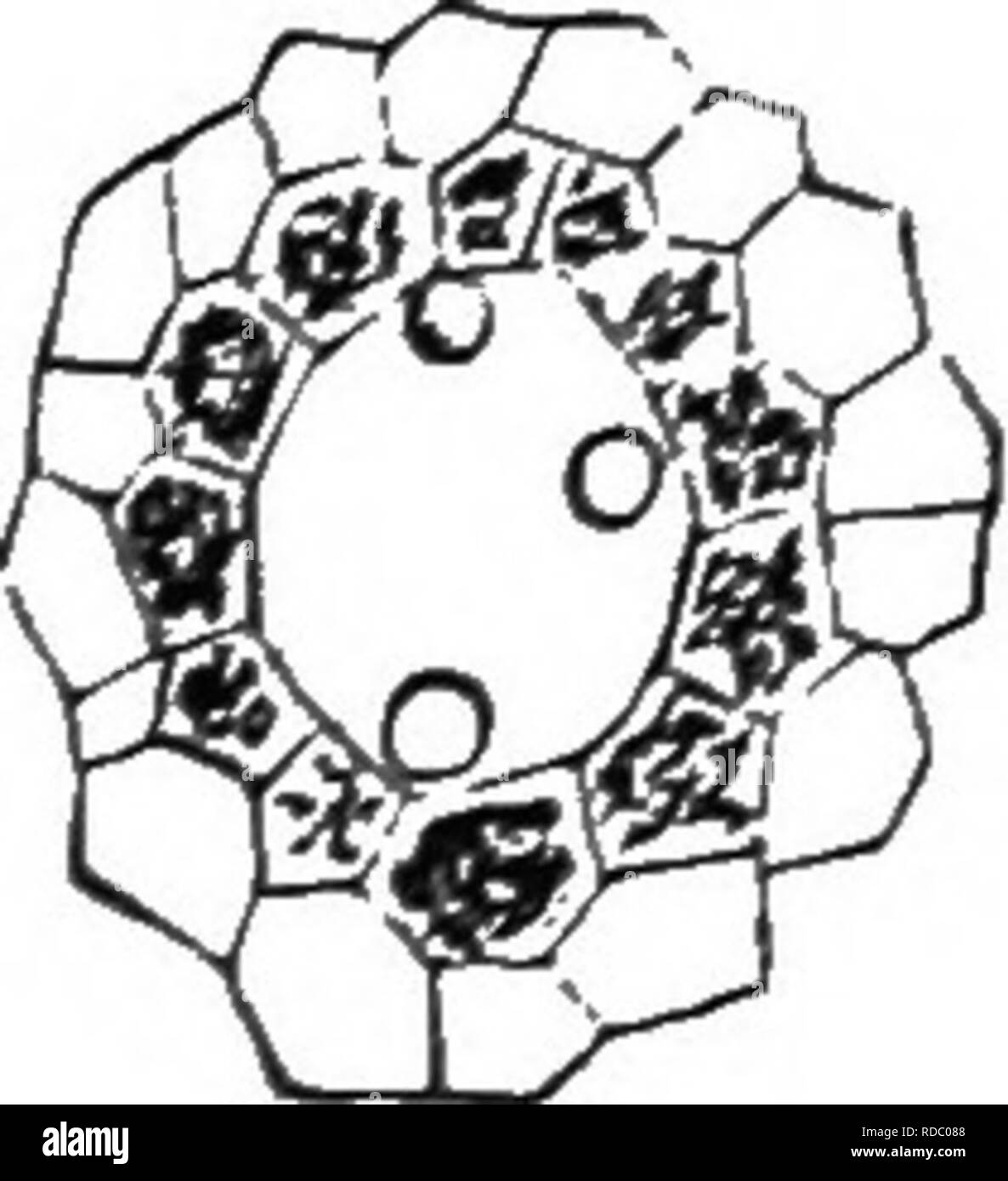 . The origin of floral structures : through insect and other agencies. Plants; Flowers; Flowers. 164. THE STRUCTURE OF FLOWERS. CHAPTER XVIII. IRRITATION OF THE POLLEX-TUBE—THE ORIGIN OF CONDUCTING TISSDES. The first effect produced by the action of the germination of the pollen-tube is the formation of the so-called conducting tissue or layers of specialized cells which nourish the tube in its downward growth. Like glandular nectaries, this tissue consists of small merismatic-like cells, highly charged with nutritive and saccharine substances. In some cases it is a metamorphosed condition of Stock Photohttps://www.alamy.com/image-license-details/?v=1https://www.alamy.com/the-origin-of-floral-structures-through-insect-and-other-agencies-plants-flowers-flowers-164-the-structure-of-flowers-chapter-xviii-irritation-of-the-pollex-tubethe-origin-of-conducting-tissdes-the-first-effect-produced-by-the-action-of-the-germination-of-the-pollen-tube-is-the-formation-of-the-so-called-conducting-tissue-or-layers-of-specialized-cells-which-nourish-the-tube-in-its-downward-growth-like-glandular-nectaries-this-tissue-consists-of-small-merismatic-like-cells-highly-charged-with-nutritive-and-saccharine-substances-in-some-cases-it-is-a-metamorphosed-condition-of-image231988968.html
. The origin of floral structures : through insect and other agencies. Plants; Flowers; Flowers. 164. THE STRUCTURE OF FLOWERS. CHAPTER XVIII. IRRITATION OF THE POLLEX-TUBE—THE ORIGIN OF CONDUCTING TISSDES. The first effect produced by the action of the germination of the pollen-tube is the formation of the so-called conducting tissue or layers of specialized cells which nourish the tube in its downward growth. Like glandular nectaries, this tissue consists of small merismatic-like cells, highly charged with nutritive and saccharine substances. In some cases it is a metamorphosed condition of Stock Photohttps://www.alamy.com/image-license-details/?v=1https://www.alamy.com/the-origin-of-floral-structures-through-insect-and-other-agencies-plants-flowers-flowers-164-the-structure-of-flowers-chapter-xviii-irritation-of-the-pollex-tubethe-origin-of-conducting-tissdes-the-first-effect-produced-by-the-action-of-the-germination-of-the-pollen-tube-is-the-formation-of-the-so-called-conducting-tissue-or-layers-of-specialized-cells-which-nourish-the-tube-in-its-downward-growth-like-glandular-nectaries-this-tissue-consists-of-small-merismatic-like-cells-highly-charged-with-nutritive-and-saccharine-substances-in-some-cases-it-is-a-metamorphosed-condition-of-image231988968.htmlRMRDC088–. The origin of floral structures : through insect and other agencies. Plants; Flowers; Flowers. 164. THE STRUCTURE OF FLOWERS. CHAPTER XVIII. IRRITATION OF THE POLLEX-TUBE—THE ORIGIN OF CONDUCTING TISSDES. The first effect produced by the action of the germination of the pollen-tube is the formation of the so-called conducting tissue or layers of specialized cells which nourish the tube in its downward growth. Like glandular nectaries, this tissue consists of small merismatic-like cells, highly charged with nutritive and saccharine substances. In some cases it is a metamorphosed condition of
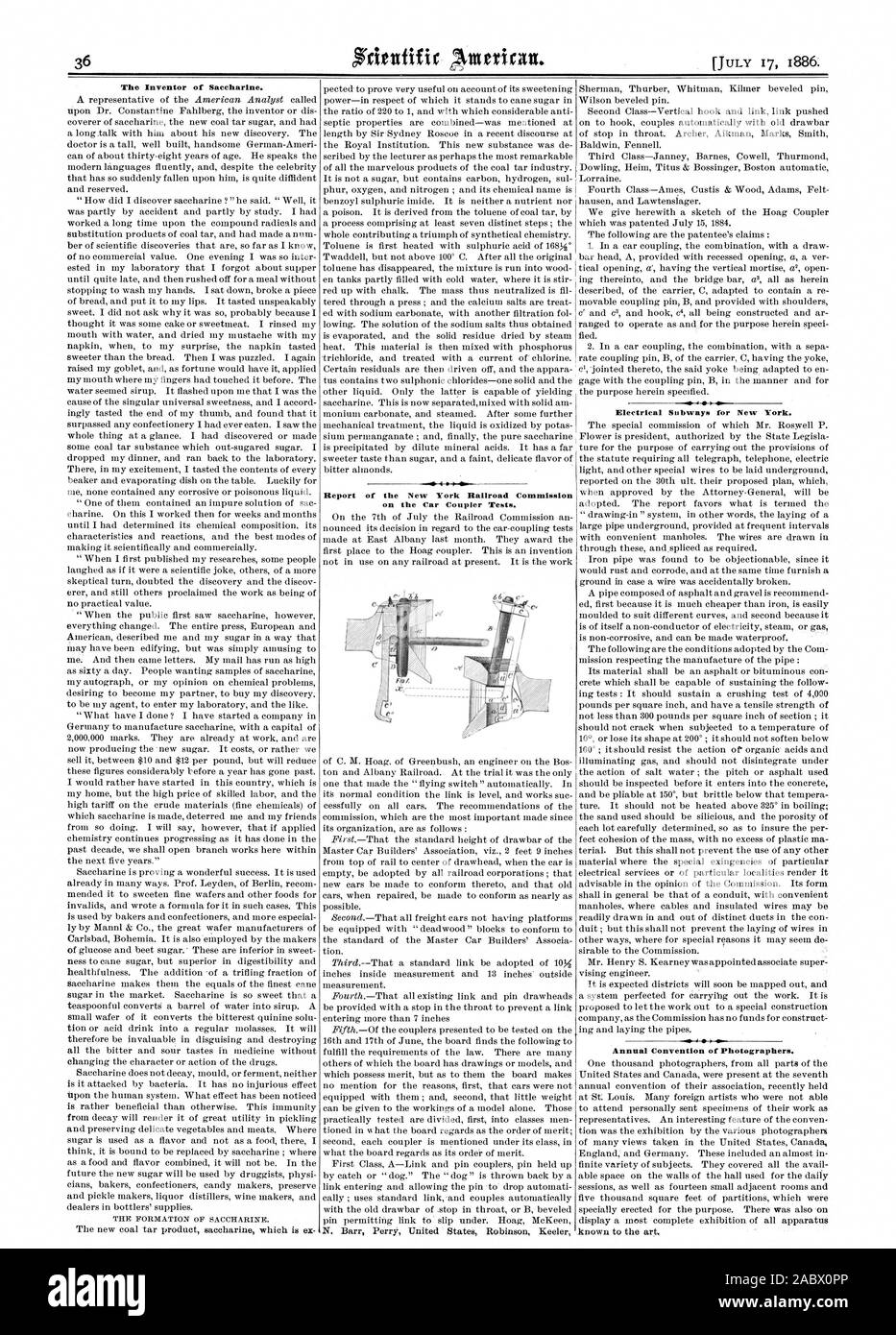 The Inventor of Saccharine. Report of the New York Railroad Commission on the Car Coupler Tests. N. Barr Perry United States Robinson Keeler Electrical Subways for New York. Annual Convention of Photographers., scientific american, 1886-07-17 Stock Photohttps://www.alamy.com/image-license-details/?v=1https://www.alamy.com/the-inventor-of-saccharine-report-of-the-new-york-railroad-commission-on-the-car-coupler-tests-n-barr-perry-united-states-robinson-keeler-electrical-subways-for-new-york-annual-convention-of-photographers-scientific-american-1886-07-17-image334329598.html
The Inventor of Saccharine. Report of the New York Railroad Commission on the Car Coupler Tests. N. Barr Perry United States Robinson Keeler Electrical Subways for New York. Annual Convention of Photographers., scientific american, 1886-07-17 Stock Photohttps://www.alamy.com/image-license-details/?v=1https://www.alamy.com/the-inventor-of-saccharine-report-of-the-new-york-railroad-commission-on-the-car-coupler-tests-n-barr-perry-united-states-robinson-keeler-electrical-subways-for-new-york-annual-convention-of-photographers-scientific-american-1886-07-17-image334329598.htmlRM2ABX0PP–The Inventor of Saccharine. Report of the New York Railroad Commission on the Car Coupler Tests. N. Barr Perry United States Robinson Keeler Electrical Subways for New York. Annual Convention of Photographers., scientific american, 1886-07-17
RF3BMNJKF–Icon for sweet, ladoo
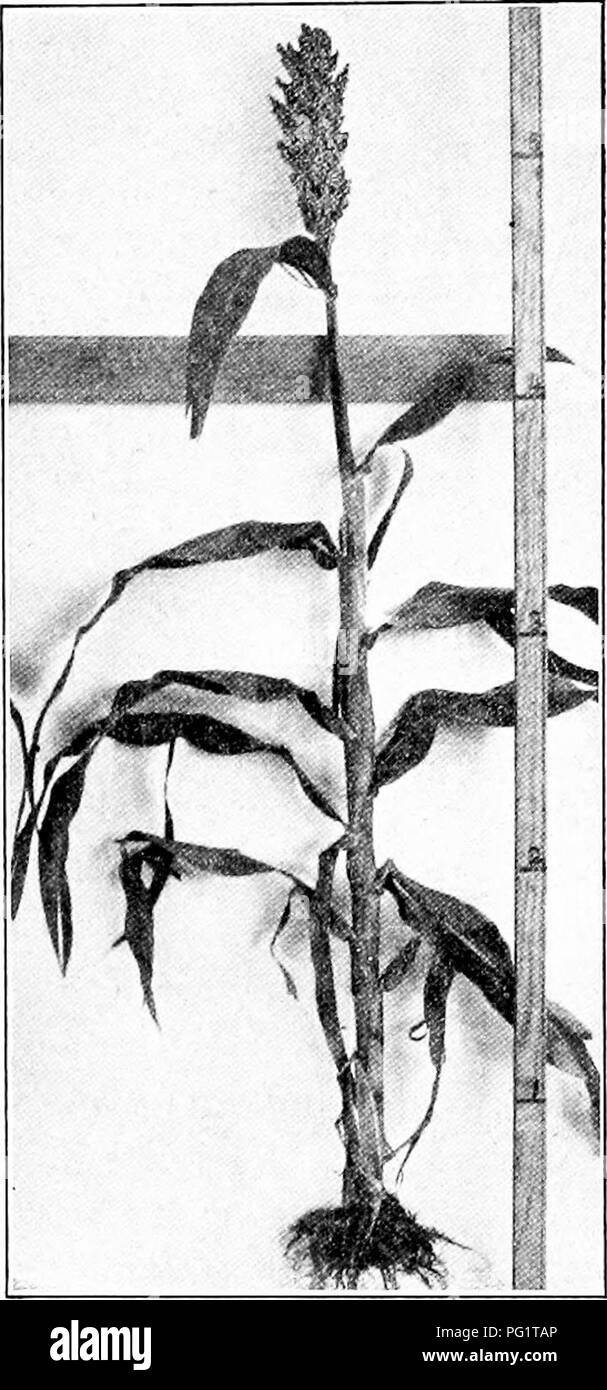 . The corn crops: a discussion of maize, kafirs, and sorghums as grown in the United States and Canada. Corn; Kafir corn; Sorghum. 310 CORN CROPS be a later introduction, having attracted attention about 1896. It had all the good qualities of Red Kafir, and in addition the seed was not astringent. This variety probably furnishes nine- tenths of the kafir crop to-day, and Red Kafir the other tenth. 238. Durra.—The char- acteristics of this group are that the heads are mostly " goosenecked " and the seeds are large and flat. The extensive cultiu'e of non-saccharine sorghums in this cou Stock Photohttps://www.alamy.com/image-license-details/?v=1https://www.alamy.com/the-corn-crops-a-discussion-of-maize-kafirs-and-sorghums-as-grown-in-the-united-states-and-canada-corn-kafir-corn-sorghum-310-corn-crops-be-a-later-introduction-having-attracted-attention-about-1896-it-had-all-the-good-qualities-of-red-kafir-and-in-addition-the-seed-was-not-astringent-this-variety-probably-furnishes-nine-tenths-of-the-kafir-crop-to-day-and-red-kafir-the-other-tenth-238-durrathe-char-acteristics-of-this-group-are-that-the-heads-are-mostly-quot-goosenecked-quot-and-the-seeds-are-large-and-flat-the-extensive-cultiue-of-non-saccharine-sorghums-in-this-cou-image216399982.html
. The corn crops: a discussion of maize, kafirs, and sorghums as grown in the United States and Canada. Corn; Kafir corn; Sorghum. 310 CORN CROPS be a later introduction, having attracted attention about 1896. It had all the good qualities of Red Kafir, and in addition the seed was not astringent. This variety probably furnishes nine- tenths of the kafir crop to-day, and Red Kafir the other tenth. 238. Durra.—The char- acteristics of this group are that the heads are mostly " goosenecked " and the seeds are large and flat. The extensive cultiu'e of non-saccharine sorghums in this cou Stock Photohttps://www.alamy.com/image-license-details/?v=1https://www.alamy.com/the-corn-crops-a-discussion-of-maize-kafirs-and-sorghums-as-grown-in-the-united-states-and-canada-corn-kafir-corn-sorghum-310-corn-crops-be-a-later-introduction-having-attracted-attention-about-1896-it-had-all-the-good-qualities-of-red-kafir-and-in-addition-the-seed-was-not-astringent-this-variety-probably-furnishes-nine-tenths-of-the-kafir-crop-to-day-and-red-kafir-the-other-tenth-238-durrathe-char-acteristics-of-this-group-are-that-the-heads-are-mostly-quot-goosenecked-quot-and-the-seeds-are-large-and-flat-the-extensive-cultiue-of-non-saccharine-sorghums-in-this-cou-image216399982.htmlRMPG1TAP–. The corn crops: a discussion of maize, kafirs, and sorghums as grown in the United States and Canada. Corn; Kafir corn; Sorghum. 310 CORN CROPS be a later introduction, having attracted attention about 1896. It had all the good qualities of Red Kafir, and in addition the seed was not astringent. This variety probably furnishes nine- tenths of the kafir crop to-day, and Red Kafir the other tenth. 238. Durra.—The char- acteristics of this group are that the heads are mostly " goosenecked " and the seeds are large and flat. The extensive cultiu'e of non-saccharine sorghums in this cou
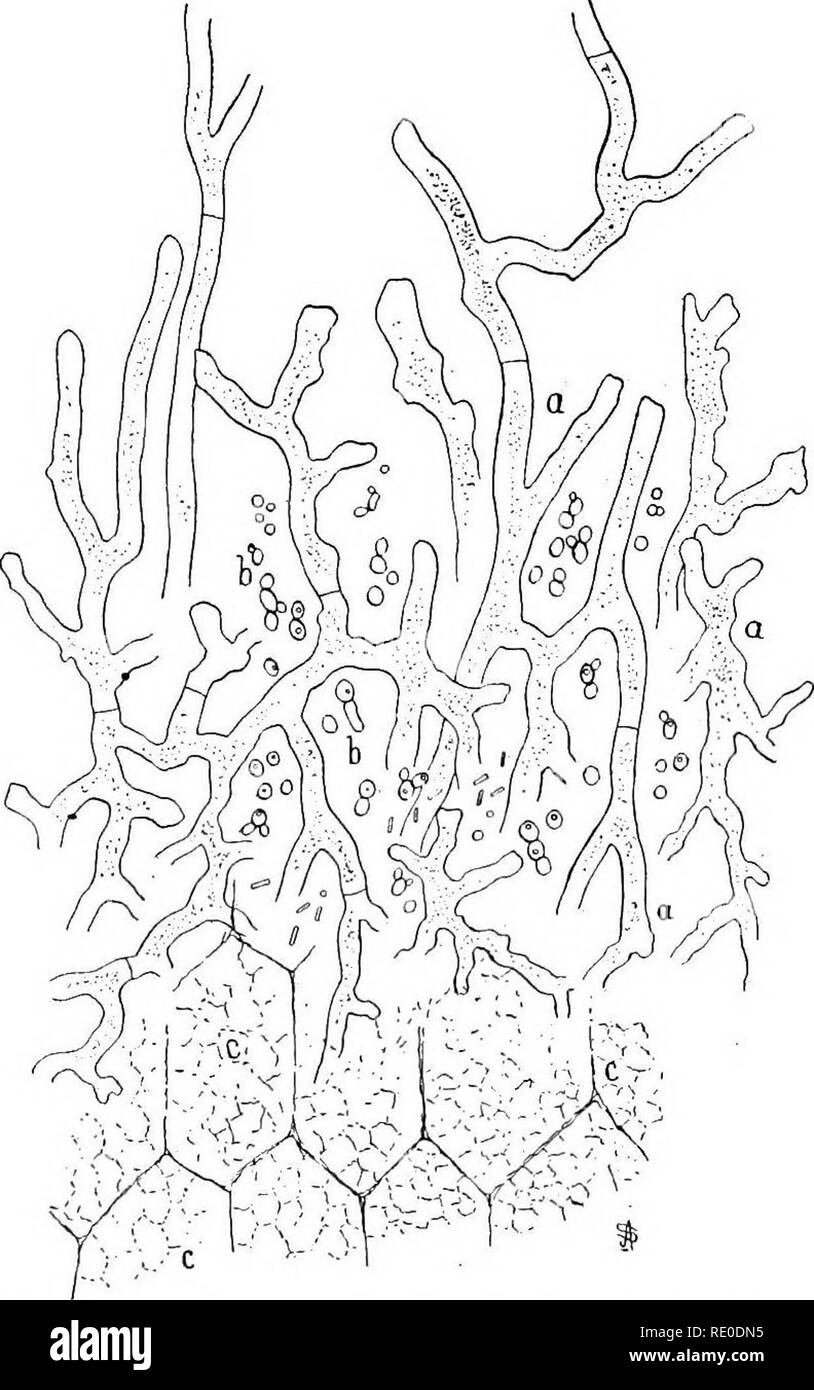 . Bacteriological methods in food and drugs laboratories : with an introduction to micro-analytical methods . Bacteriology; Food; Drugs. WINE AND SAKE 223 wine is in reality a normal process and which must be expected to develop under ordinary condition. It is, however, most desirable to retard or check this process as much as possible.. Fig. 77.—Sake. Steamed rice cells (c) attacked by the fungus {Aspergillus oryza). The fungus changes the starch into saccharine substances. Yeasts and bacteria are usually associated with the hyphal fungus, feeding upon the saccharine substances formed. 4. Sak Stock Photohttps://www.alamy.com/image-license-details/?v=1https://www.alamy.com/bacteriological-methods-in-food-and-drugs-laboratories-with-an-introduction-to-micro-analytical-methods-bacteriology-food-drugs-wine-and-sake-223-wine-is-in-reality-a-normal-process-and-which-must-be-expected-to-develop-under-ordinary-condition-it-is-however-most-desirable-to-retard-or-check-this-process-as-much-as-possible-fig-77sake-steamed-rice-cells-c-attacked-by-the-fungus-aspergillus-oryza-the-fungus-changes-the-starch-into-saccharine-substances-yeasts-and-bacteria-are-usually-associated-with-the-hyphal-fungus-feeding-upon-the-saccharine-substances-formed-4-sak-image232350753.html
. Bacteriological methods in food and drugs laboratories : with an introduction to micro-analytical methods . Bacteriology; Food; Drugs. WINE AND SAKE 223 wine is in reality a normal process and which must be expected to develop under ordinary condition. It is, however, most desirable to retard or check this process as much as possible.. Fig. 77.—Sake. Steamed rice cells (c) attacked by the fungus {Aspergillus oryza). The fungus changes the starch into saccharine substances. Yeasts and bacteria are usually associated with the hyphal fungus, feeding upon the saccharine substances formed. 4. Sak Stock Photohttps://www.alamy.com/image-license-details/?v=1https://www.alamy.com/bacteriological-methods-in-food-and-drugs-laboratories-with-an-introduction-to-micro-analytical-methods-bacteriology-food-drugs-wine-and-sake-223-wine-is-in-reality-a-normal-process-and-which-must-be-expected-to-develop-under-ordinary-condition-it-is-however-most-desirable-to-retard-or-check-this-process-as-much-as-possible-fig-77sake-steamed-rice-cells-c-attacked-by-the-fungus-aspergillus-oryza-the-fungus-changes-the-starch-into-saccharine-substances-yeasts-and-bacteria-are-usually-associated-with-the-hyphal-fungus-feeding-upon-the-saccharine-substances-formed-4-sak-image232350753.htmlRMRE0DN5–. Bacteriological methods in food and drugs laboratories : with an introduction to micro-analytical methods . Bacteriology; Food; Drugs. WINE AND SAKE 223 wine is in reality a normal process and which must be expected to develop under ordinary condition. It is, however, most desirable to retard or check this process as much as possible.. Fig. 77.—Sake. Steamed rice cells (c) attacked by the fungus {Aspergillus oryza). The fungus changes the starch into saccharine substances. Yeasts and bacteria are usually associated with the hyphal fungus, feeding upon the saccharine substances formed. 4. Sak
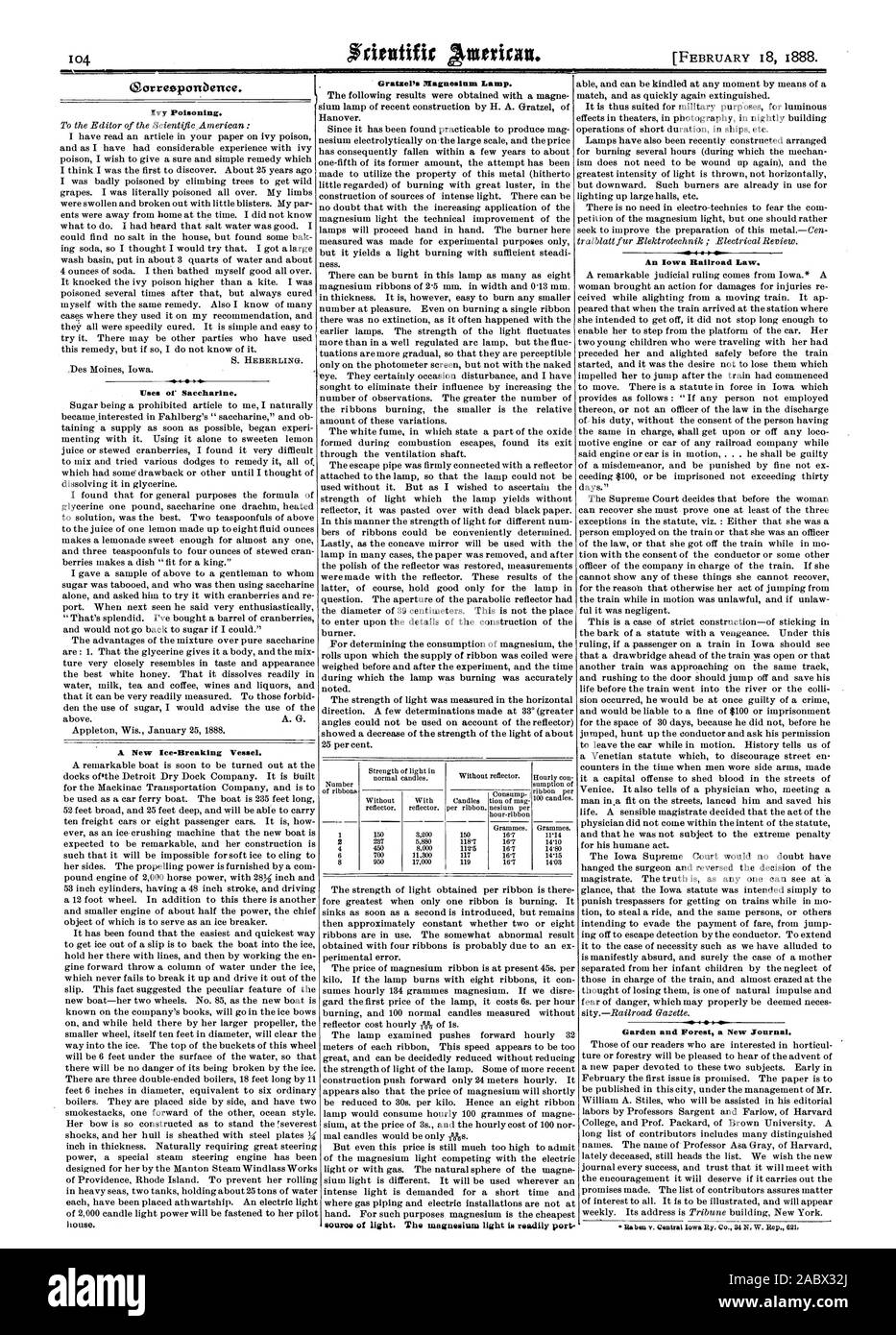 Oarreeponbence. Ivy Poisoning. Uses of Saccharine. A New Ice-Breaking Vessel. GratzePs Magnesium Lamp. 1 2 source of light The magnesium light is readily port An Iowa Railroad Law. Garden and Forest a New Journal., scientific american, 1888-02-18 Stock Photohttps://www.alamy.com/image-license-details/?v=1https://www.alamy.com/oarreeponbence-ivy-poisoning-uses-of-saccharine-a-new-ice-breaking-vessel-gratzeps-magnesium-lamp-1-2-source-of-light-the-magnesium-light-is-readily-port-an-iowa-railroad-law-garden-and-forest-a-new-journal-scientific-american-1888-02-18-image334331386.html
Oarreeponbence. Ivy Poisoning. Uses of Saccharine. A New Ice-Breaking Vessel. GratzePs Magnesium Lamp. 1 2 source of light The magnesium light is readily port An Iowa Railroad Law. Garden and Forest a New Journal., scientific american, 1888-02-18 Stock Photohttps://www.alamy.com/image-license-details/?v=1https://www.alamy.com/oarreeponbence-ivy-poisoning-uses-of-saccharine-a-new-ice-breaking-vessel-gratzeps-magnesium-lamp-1-2-source-of-light-the-magnesium-light-is-readily-port-an-iowa-railroad-law-garden-and-forest-a-new-journal-scientific-american-1888-02-18-image334331386.htmlRM2ABX32J–Oarreeponbence. Ivy Poisoning. Uses of Saccharine. A New Ice-Breaking Vessel. GratzePs Magnesium Lamp. 1 2 source of light The magnesium light is readily port An Iowa Railroad Law. Garden and Forest a New Journal., scientific american, 1888-02-18
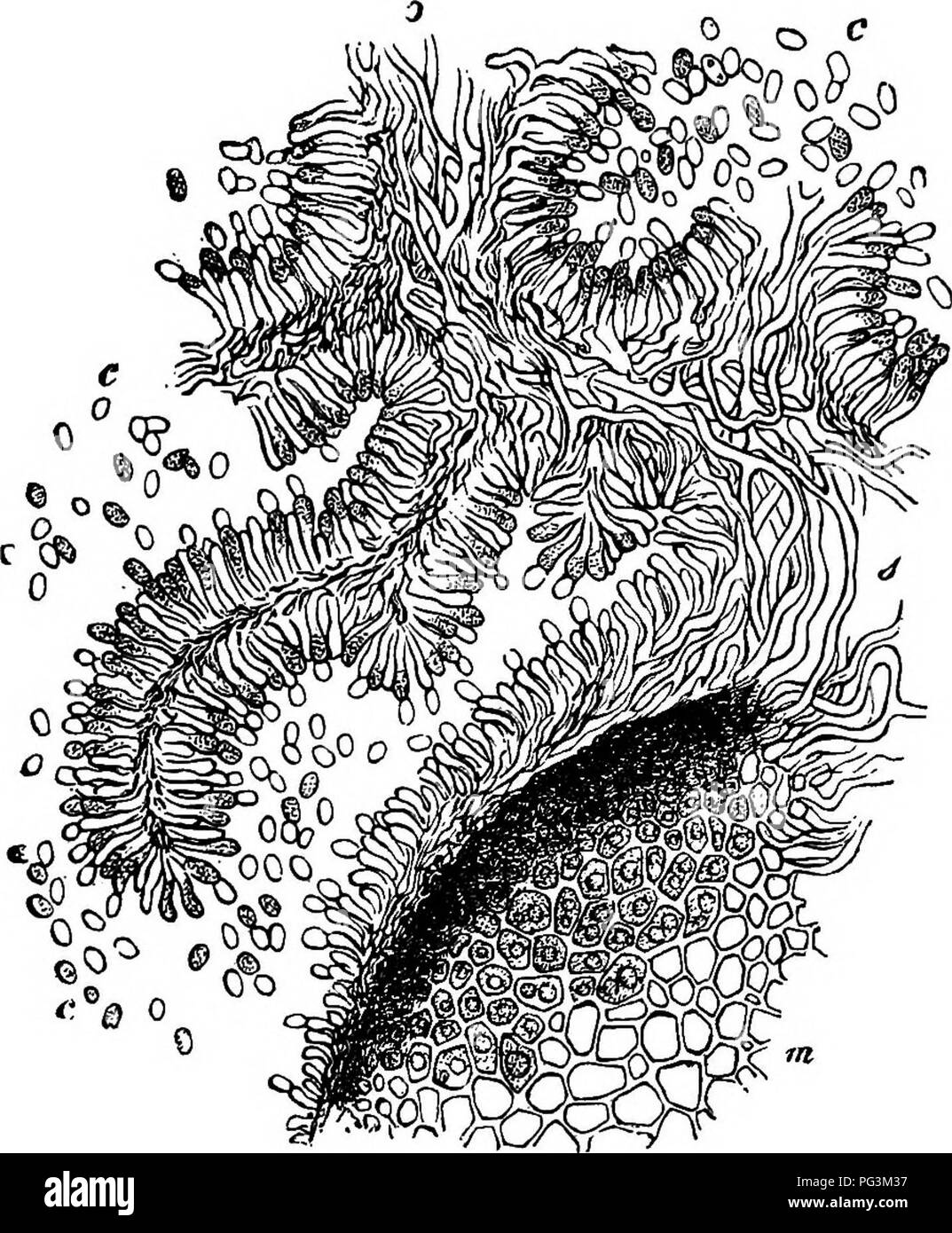 . Comparative morphology and biology of the fungi, mycetozoa and bacteria . Plant morphology; Fungi; Myxomycetes; Bacteriology. izS DIVISION II.—COURSE OF DEVELOPMENT OF FUNGI. the hymenium the well-known saccharine fluid is secreted, which oozes out from between the paleae in thick drops rendered turbid by count- less gonidia, and thus betrays the presence of the parasite. This juice is eagerly sought by in- sects, which thus carry away the gonidia. Soon the formation of the scle- rotium begins in the basal portion of the gonidia- forming body in the way already described. The sclerotium reac Stock Photohttps://www.alamy.com/image-license-details/?v=1https://www.alamy.com/comparative-morphology-and-biology-of-the-fungi-mycetozoa-and-bacteria-plant-morphology-fungi-myxomycetes-bacteriology-izs-division-iicourse-of-development-of-fungi-the-hymenium-the-well-known-saccharine-fluid-is-secreted-which-oozes-out-from-between-the-paleae-in-thick-drops-rendered-turbid-by-count-less-gonidia-and-thus-betrays-the-presence-of-the-parasite-this-juice-is-eagerly-sought-by-in-sects-which-thus-carry-away-the-gonidia-soon-the-formation-of-the-scle-rotium-begins-in-the-basal-portion-of-the-gonidia-forming-body-in-the-way-already-described-the-sclerotium-reac-image216440539.html
. Comparative morphology and biology of the fungi, mycetozoa and bacteria . Plant morphology; Fungi; Myxomycetes; Bacteriology. izS DIVISION II.—COURSE OF DEVELOPMENT OF FUNGI. the hymenium the well-known saccharine fluid is secreted, which oozes out from between the paleae in thick drops rendered turbid by count- less gonidia, and thus betrays the presence of the parasite. This juice is eagerly sought by in- sects, which thus carry away the gonidia. Soon the formation of the scle- rotium begins in the basal portion of the gonidia- forming body in the way already described. The sclerotium reac Stock Photohttps://www.alamy.com/image-license-details/?v=1https://www.alamy.com/comparative-morphology-and-biology-of-the-fungi-mycetozoa-and-bacteria-plant-morphology-fungi-myxomycetes-bacteriology-izs-division-iicourse-of-development-of-fungi-the-hymenium-the-well-known-saccharine-fluid-is-secreted-which-oozes-out-from-between-the-paleae-in-thick-drops-rendered-turbid-by-count-less-gonidia-and-thus-betrays-the-presence-of-the-parasite-this-juice-is-eagerly-sought-by-in-sects-which-thus-carry-away-the-gonidia-soon-the-formation-of-the-scle-rotium-begins-in-the-basal-portion-of-the-gonidia-forming-body-in-the-way-already-described-the-sclerotium-reac-image216440539.htmlRMPG3M37–. Comparative morphology and biology of the fungi, mycetozoa and bacteria . Plant morphology; Fungi; Myxomycetes; Bacteriology. izS DIVISION II.—COURSE OF DEVELOPMENT OF FUNGI. the hymenium the well-known saccharine fluid is secreted, which oozes out from between the paleae in thick drops rendered turbid by count- less gonidia, and thus betrays the presence of the parasite. This juice is eagerly sought by in- sects, which thus carry away the gonidia. Soon the formation of the scle- rotium begins in the basal portion of the gonidia- forming body in the way already described. The sclerotium reac
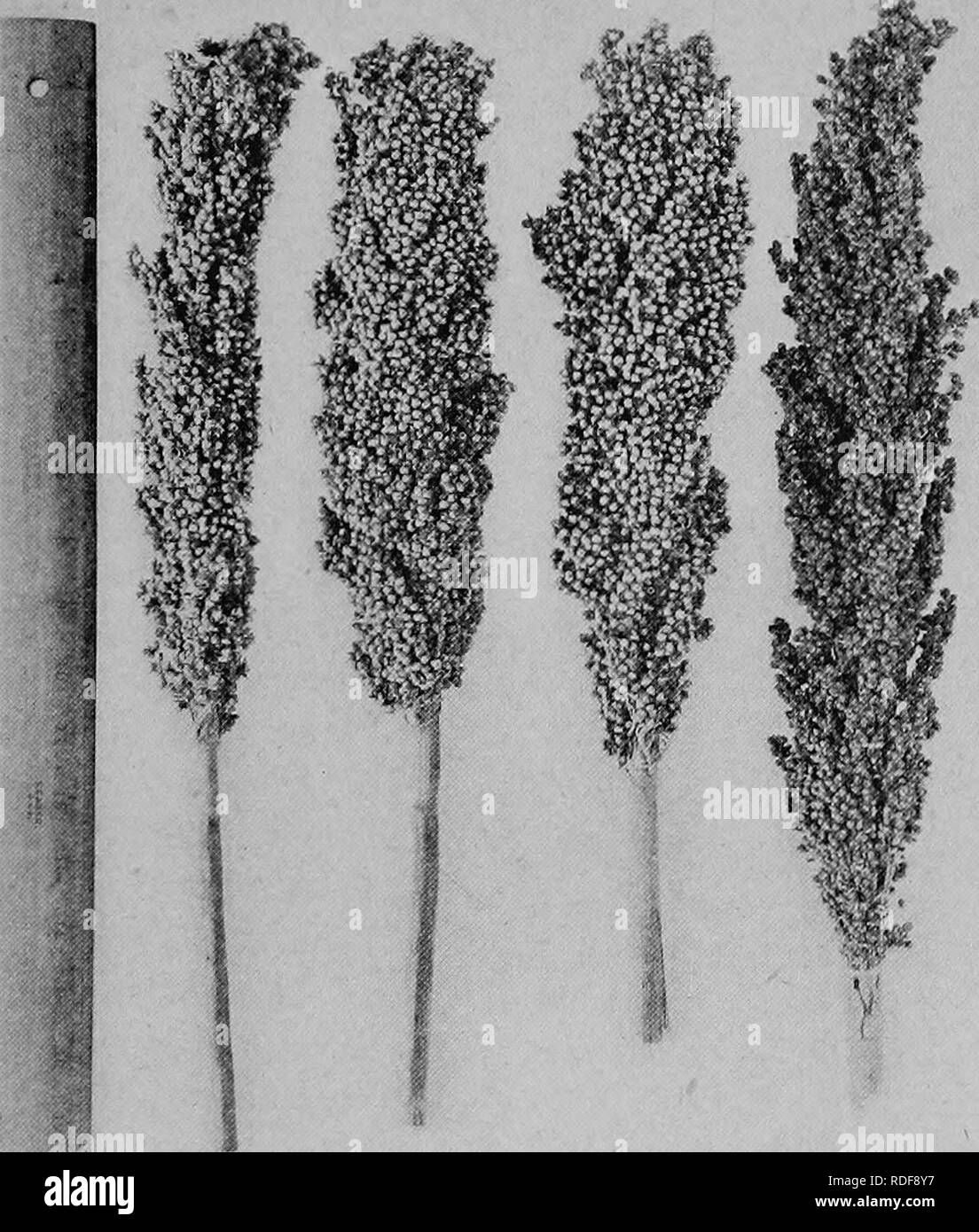 . Field crops for the cotton-belt. Agriculture. THE NON-SACCHARINE SORGHUMS 391. Fio. 66. — Heads of four varieties of kafir: 1, White Kafir; 2, Guinea Kafir "(Guinea corn of the West Indies); 3, Blackhull Kafir; 4, Red Kafir.. Please note that these images are extracted from scanned page images that may have been digitally enhanced for readability - coloration and appearance of these illustrations may not perfectly resemble the original work.. Morgan, James Oscar. New York, The Macmillan company Stock Photohttps://www.alamy.com/image-license-details/?v=1https://www.alamy.com/field-crops-for-the-cotton-belt-agriculture-the-non-saccharine-sorghums-391-fio-66-heads-of-four-varieties-of-kafir-1-white-kafir-2-guinea-kafir-quotguinea-corn-of-the-west-indies-3-blackhull-kafir-4-red-kafir-please-note-that-these-images-are-extracted-from-scanned-page-images-that-may-have-been-digitally-enhanced-for-readability-coloration-and-appearance-of-these-illustrations-may-not-perfectly-resemble-the-original-work-morgan-james-oscar-new-york-the-macmillan-company-image232061627.html
. Field crops for the cotton-belt. Agriculture. THE NON-SACCHARINE SORGHUMS 391. Fio. 66. — Heads of four varieties of kafir: 1, White Kafir; 2, Guinea Kafir "(Guinea corn of the West Indies); 3, Blackhull Kafir; 4, Red Kafir.. Please note that these images are extracted from scanned page images that may have been digitally enhanced for readability - coloration and appearance of these illustrations may not perfectly resemble the original work.. Morgan, James Oscar. New York, The Macmillan company Stock Photohttps://www.alamy.com/image-license-details/?v=1https://www.alamy.com/field-crops-for-the-cotton-belt-agriculture-the-non-saccharine-sorghums-391-fio-66-heads-of-four-varieties-of-kafir-1-white-kafir-2-guinea-kafir-quotguinea-corn-of-the-west-indies-3-blackhull-kafir-4-red-kafir-please-note-that-these-images-are-extracted-from-scanned-page-images-that-may-have-been-digitally-enhanced-for-readability-coloration-and-appearance-of-these-illustrations-may-not-perfectly-resemble-the-original-work-morgan-james-oscar-new-york-the-macmillan-company-image232061627.htmlRMRDF8Y7–. Field crops for the cotton-belt. Agriculture. THE NON-SACCHARINE SORGHUMS 391. Fio. 66. — Heads of four varieties of kafir: 1, White Kafir; 2, Guinea Kafir "(Guinea corn of the West Indies); 3, Blackhull Kafir; 4, Red Kafir.. Please note that these images are extracted from scanned page images that may have been digitally enhanced for readability - coloration and appearance of these illustrations may not perfectly resemble the original work.. Morgan, James Oscar. New York, The Macmillan company
 Useful Recipes for the Shop the Household and the Farm. Improved Milk-Testing Process. Improved Combined Cupboard and Sink. Improved Boot and Shoe. Improved Piston for Steam Engines Pumps etc. Improved Gas Wrench. Improved Machine for Inserting Fibrous Screw Fastenings in Boots and Shoes. Improved Chemical Fire Extinguisher. Improved Elastic Force Cup. Improved Earth Auger. Improved Cotton Bale Tie. Improved Chemical Fire Extinguisher. ImproVed Carriage Bow Rest. Improved Lock for Pocket Books. Improved Process of Manufacturing Ammonia. Improved Wagon Seat Fastening. Improved Pocket Book Stock Photohttps://www.alamy.com/image-license-details/?v=1https://www.alamy.com/useful-recipes-for-the-shop-the-household-and-the-farm-improved-milk-testing-process-improved-combined-cupboard-and-sink-improved-boot-and-shoe-improved-piston-for-steam-engines-pumps-etc-improved-gas-wrench-improved-machine-for-inserting-fibrous-screw-fastenings-in-boots-and-shoes-improved-chemical-fire-extinguisher-improved-elastic-force-cup-improved-earth-auger-improved-cotton-bale-tie-improved-chemical-fire-extinguisher-improved-carriage-bow-rest-improved-lock-for-pocket-books-improved-process-of-manufacturing-ammonia-improved-wagon-seat-fastening-improved-pocket-book-image334317504.html
Useful Recipes for the Shop the Household and the Farm. Improved Milk-Testing Process. Improved Combined Cupboard and Sink. Improved Boot and Shoe. Improved Piston for Steam Engines Pumps etc. Improved Gas Wrench. Improved Machine for Inserting Fibrous Screw Fastenings in Boots and Shoes. Improved Chemical Fire Extinguisher. Improved Elastic Force Cup. Improved Earth Auger. Improved Cotton Bale Tie. Improved Chemical Fire Extinguisher. ImproVed Carriage Bow Rest. Improved Lock for Pocket Books. Improved Process of Manufacturing Ammonia. Improved Wagon Seat Fastening. Improved Pocket Book Stock Photohttps://www.alamy.com/image-license-details/?v=1https://www.alamy.com/useful-recipes-for-the-shop-the-household-and-the-farm-improved-milk-testing-process-improved-combined-cupboard-and-sink-improved-boot-and-shoe-improved-piston-for-steam-engines-pumps-etc-improved-gas-wrench-improved-machine-for-inserting-fibrous-screw-fastenings-in-boots-and-shoes-improved-chemical-fire-extinguisher-improved-elastic-force-cup-improved-earth-auger-improved-cotton-bale-tie-improved-chemical-fire-extinguisher-improved-carriage-bow-rest-improved-lock-for-pocket-books-improved-process-of-manufacturing-ammonia-improved-wagon-seat-fastening-improved-pocket-book-image334317504.htmlRM2ABWDAT–Useful Recipes for the Shop the Household and the Farm. Improved Milk-Testing Process. Improved Combined Cupboard and Sink. Improved Boot and Shoe. Improved Piston for Steam Engines Pumps etc. Improved Gas Wrench. Improved Machine for Inserting Fibrous Screw Fastenings in Boots and Shoes. Improved Chemical Fire Extinguisher. Improved Elastic Force Cup. Improved Earth Auger. Improved Cotton Bale Tie. Improved Chemical Fire Extinguisher. ImproVed Carriage Bow Rest. Improved Lock for Pocket Books. Improved Process of Manufacturing Ammonia. Improved Wagon Seat Fastening. Improved Pocket Book
 . Field crops for the cotton-belt. Agriculture. THE SACCHARINE SORGHUMS 383 compactness, and present an orange tinge due to the par- tially exserted orange colored seeds. It matures in about the same length of time as Sumac sorghum. Orange sor- ghum is an excellent va- riety for sirup production, and being rather leafy, is also a good variety for forage. 472. Amber sorghum is probably the most largely grown variety of sweet sorghum in the United States. It is very early, maturing usually in less than 100 days, and for this reason - has practically crowded all other varieties out of the section Stock Photohttps://www.alamy.com/image-license-details/?v=1https://www.alamy.com/field-crops-for-the-cotton-belt-agriculture-the-saccharine-sorghums-383-compactness-and-present-an-orange-tinge-due-to-the-par-tially-exserted-orange-colored-seeds-it-matures-in-about-the-same-length-of-time-as-sumac-sorghum-orange-sor-ghum-is-an-excellent-va-riety-for-sirup-production-and-being-rather-leafy-is-also-a-good-variety-for-forage-472-amber-sorghum-is-probably-the-most-largely-grown-variety-of-sweet-sorghum-in-the-united-states-it-is-very-early-maturing-usually-in-less-than-100-days-and-for-this-reason-has-practically-crowded-all-other-varieties-out-of-the-section-image216361517.html
. Field crops for the cotton-belt. Agriculture. THE SACCHARINE SORGHUMS 383 compactness, and present an orange tinge due to the par- tially exserted orange colored seeds. It matures in about the same length of time as Sumac sorghum. Orange sor- ghum is an excellent va- riety for sirup production, and being rather leafy, is also a good variety for forage. 472. Amber sorghum is probably the most largely grown variety of sweet sorghum in the United States. It is very early, maturing usually in less than 100 days, and for this reason - has practically crowded all other varieties out of the section Stock Photohttps://www.alamy.com/image-license-details/?v=1https://www.alamy.com/field-crops-for-the-cotton-belt-agriculture-the-saccharine-sorghums-383-compactness-and-present-an-orange-tinge-due-to-the-par-tially-exserted-orange-colored-seeds-it-matures-in-about-the-same-length-of-time-as-sumac-sorghum-orange-sor-ghum-is-an-excellent-va-riety-for-sirup-production-and-being-rather-leafy-is-also-a-good-variety-for-forage-472-amber-sorghum-is-probably-the-most-largely-grown-variety-of-sweet-sorghum-in-the-united-states-it-is-very-early-maturing-usually-in-less-than-100-days-and-for-this-reason-has-practically-crowded-all-other-varieties-out-of-the-section-image216361517.htmlRMPG0391–. Field crops for the cotton-belt. Agriculture. THE SACCHARINE SORGHUMS 383 compactness, and present an orange tinge due to the par- tially exserted orange colored seeds. It matures in about the same length of time as Sumac sorghum. Orange sor- ghum is an excellent va- riety for sirup production, and being rather leafy, is also a good variety for forage. 472. Amber sorghum is probably the most largely grown variety of sweet sorghum in the United States. It is very early, maturing usually in less than 100 days, and for this reason - has practically crowded all other varieties out of the section
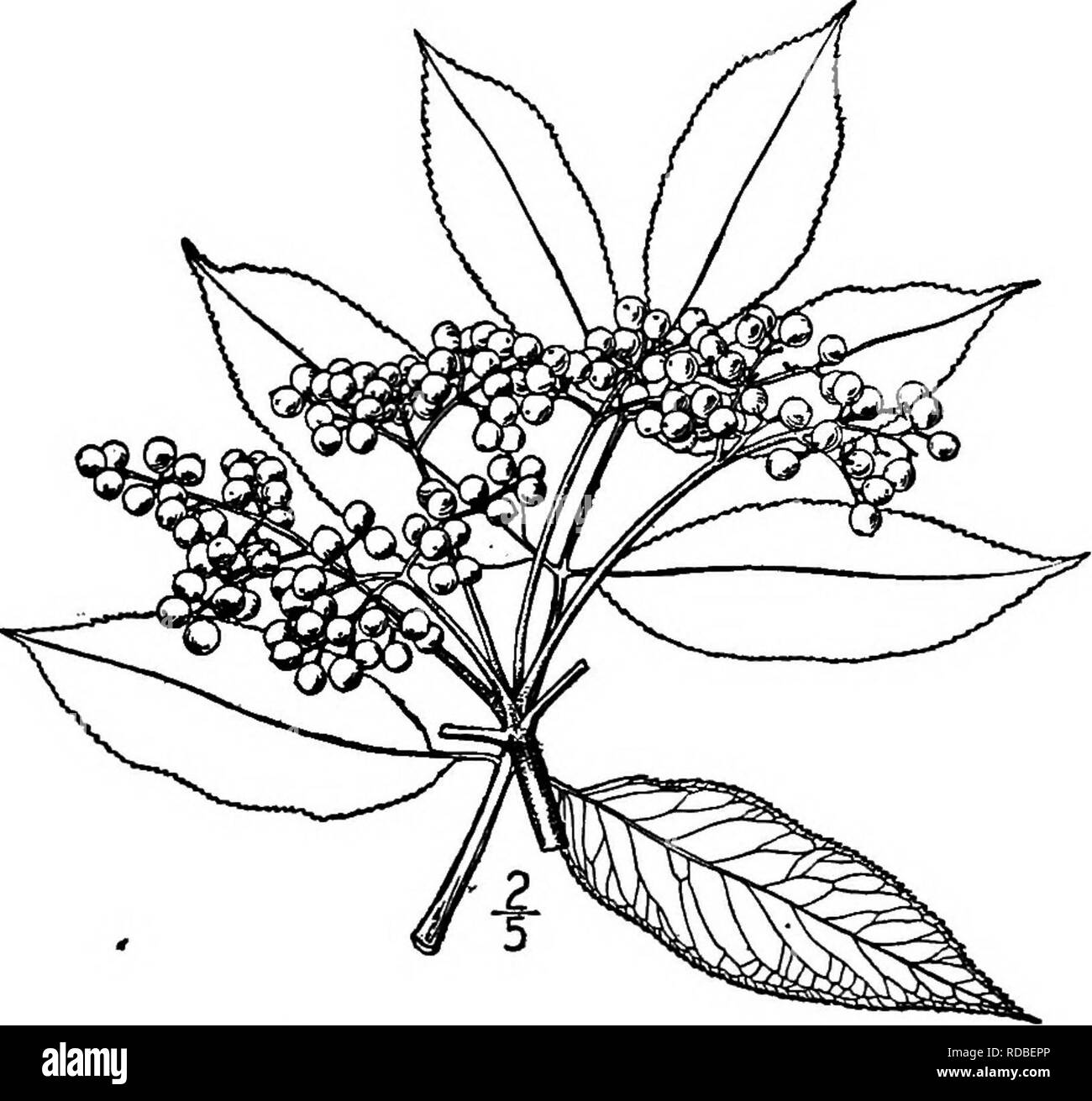 . North American trees : being descriptions and illustrations of the trees growing independently of cultivation in North America, north of Mexico and the West Indies . Trees. 852 The Elders with saccharine matter they are fermented into "elder-flower wine." The dried flowers are used in decoction as a diaphoretic. The fruit is likewise made into wine, and when mixed with some acidulous fruit, as apples, is made into pies and jeUies. The woody stems with the large pith removed have been used as tubes, especially for tapping maple-sugar trees. The bark and root are said to be poisonous Stock Photohttps://www.alamy.com/image-license-details/?v=1https://www.alamy.com/north-american-trees-being-descriptions-and-illustrations-of-the-trees-growing-independently-of-cultivation-in-north-america-north-of-mexico-and-the-west-indies-trees-852-the-elders-with-saccharine-matter-they-are-fermented-into-quotelder-flower-winequot-the-dried-flowers-are-used-in-decoction-as-a-diaphoretic-the-fruit-is-likewise-made-into-wine-and-when-mixed-with-some-acidulous-fruit-as-apples-is-made-into-pies-and-jeuies-the-woody-stems-with-the-large-pith-removed-have-been-used-as-tubes-especially-for-tapping-maple-sugar-trees-the-bark-and-root-are-said-to-be-poisonous-image231978398.html
. North American trees : being descriptions and illustrations of the trees growing independently of cultivation in North America, north of Mexico and the West Indies . Trees. 852 The Elders with saccharine matter they are fermented into "elder-flower wine." The dried flowers are used in decoction as a diaphoretic. The fruit is likewise made into wine, and when mixed with some acidulous fruit, as apples, is made into pies and jeUies. The woody stems with the large pith removed have been used as tubes, especially for tapping maple-sugar trees. The bark and root are said to be poisonous Stock Photohttps://www.alamy.com/image-license-details/?v=1https://www.alamy.com/north-american-trees-being-descriptions-and-illustrations-of-the-trees-growing-independently-of-cultivation-in-north-america-north-of-mexico-and-the-west-indies-trees-852-the-elders-with-saccharine-matter-they-are-fermented-into-quotelder-flower-winequot-the-dried-flowers-are-used-in-decoction-as-a-diaphoretic-the-fruit-is-likewise-made-into-wine-and-when-mixed-with-some-acidulous-fruit-as-apples-is-made-into-pies-and-jeuies-the-woody-stems-with-the-large-pith-removed-have-been-used-as-tubes-especially-for-tapping-maple-sugar-trees-the-bark-and-root-are-said-to-be-poisonous-image231978398.htmlRMRDBEPP–. North American trees : being descriptions and illustrations of the trees growing independently of cultivation in North America, north of Mexico and the West Indies . Trees. 852 The Elders with saccharine matter they are fermented into "elder-flower wine." The dried flowers are used in decoction as a diaphoretic. The fruit is likewise made into wine, and when mixed with some acidulous fruit, as apples, is made into pies and jeUies. The woody stems with the large pith removed have been used as tubes, especially for tapping maple-sugar trees. The bark and root are said to be poisonous
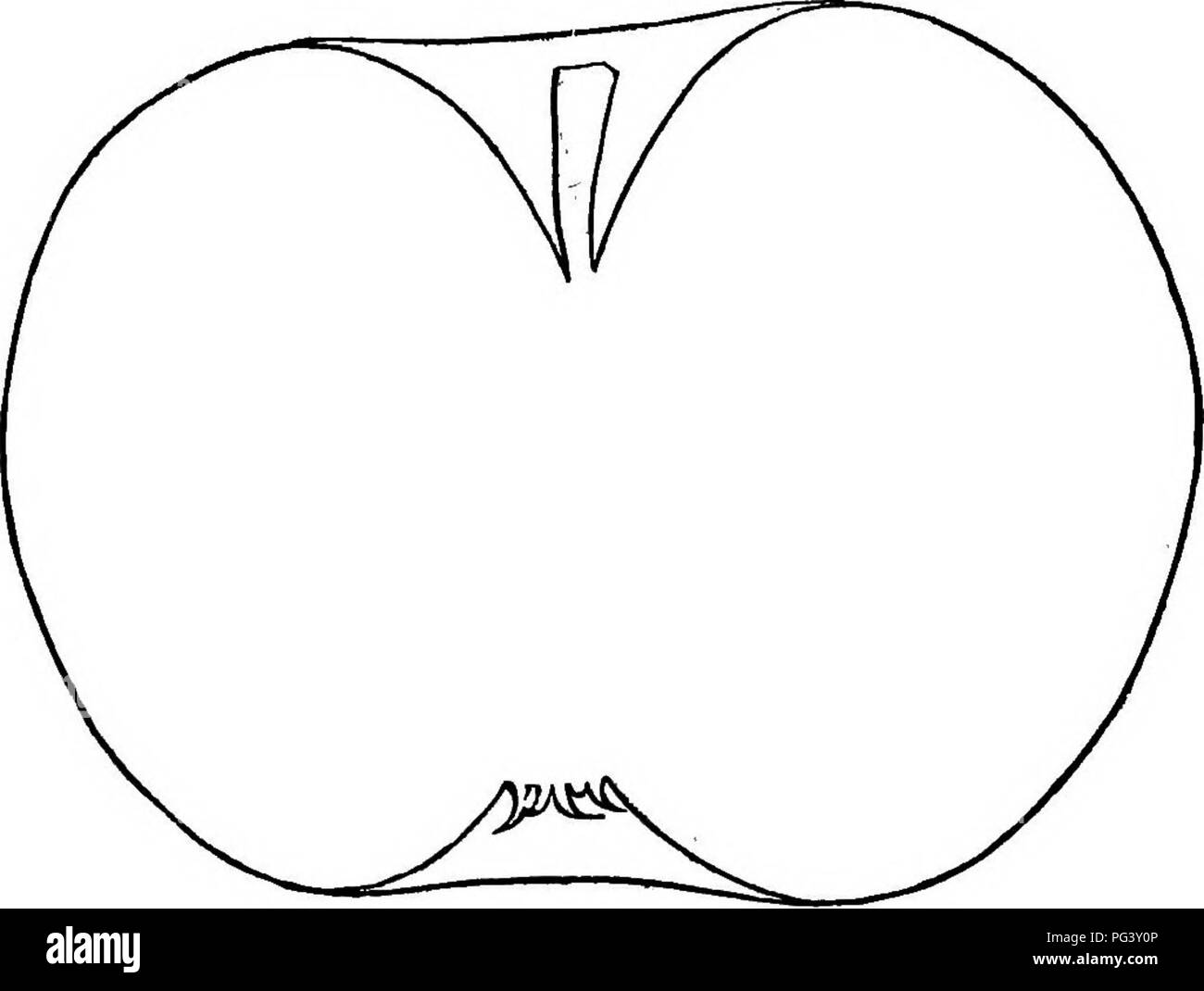 . The fruits and fruit trees of America : or, The culture, propagation and management, in the garden and orchard, of fruit trees generally, with descriptions of all the finest varieties of fruit, native and foreign, cultivated in this country . Fruit-culture; Fruit. APPLES. 79 basm. bkin light yellow, spriniied with green or grey dots, having a blush on the sunny side. Flesh yellowish, juicy, tender, melting with a very rich, mild, sub-acid flavour. By some the saccharine would suppose to predommate. Ripe November to March.. Gakden Rotal. Origin Sudbury, Mass., farm of Mr. Bowler. Tree of mod Stock Photohttps://www.alamy.com/image-license-details/?v=1https://www.alamy.com/the-fruits-and-fruit-trees-of-america-or-the-culture-propagation-and-management-in-the-garden-and-orchard-of-fruit-trees-generally-with-descriptions-of-all-the-finest-varieties-of-fruit-native-and-foreign-cultivated-in-this-country-fruit-culture-fruit-apples-79-basm-bkin-light-yellow-spriniied-with-green-or-grey-dots-having-a-blush-on-the-sunny-side-flesh-yellowish-juicy-tender-melting-with-a-very-rich-mild-sub-acid-flavour-by-some-the-saccharine-would-suppose-to-predommate-ripe-november-to-march-gakden-rotal-origin-sudbury-mass-farm-of-mr-bowler-tree-of-mod-image216445958.html
. The fruits and fruit trees of America : or, The culture, propagation and management, in the garden and orchard, of fruit trees generally, with descriptions of all the finest varieties of fruit, native and foreign, cultivated in this country . Fruit-culture; Fruit. APPLES. 79 basm. bkin light yellow, spriniied with green or grey dots, having a blush on the sunny side. Flesh yellowish, juicy, tender, melting with a very rich, mild, sub-acid flavour. By some the saccharine would suppose to predommate. Ripe November to March.. Gakden Rotal. Origin Sudbury, Mass., farm of Mr. Bowler. Tree of mod Stock Photohttps://www.alamy.com/image-license-details/?v=1https://www.alamy.com/the-fruits-and-fruit-trees-of-america-or-the-culture-propagation-and-management-in-the-garden-and-orchard-of-fruit-trees-generally-with-descriptions-of-all-the-finest-varieties-of-fruit-native-and-foreign-cultivated-in-this-country-fruit-culture-fruit-apples-79-basm-bkin-light-yellow-spriniied-with-green-or-grey-dots-having-a-blush-on-the-sunny-side-flesh-yellowish-juicy-tender-melting-with-a-very-rich-mild-sub-acid-flavour-by-some-the-saccharine-would-suppose-to-predommate-ripe-november-to-march-gakden-rotal-origin-sudbury-mass-farm-of-mr-bowler-tree-of-mod-image216445958.htmlRMPG3Y0P–. The fruits and fruit trees of America : or, The culture, propagation and management, in the garden and orchard, of fruit trees generally, with descriptions of all the finest varieties of fruit, native and foreign, cultivated in this country . Fruit-culture; Fruit. APPLES. 79 basm. bkin light yellow, spriniied with green or grey dots, having a blush on the sunny side. Flesh yellowish, juicy, tender, melting with a very rich, mild, sub-acid flavour. By some the saccharine would suppose to predommate. Ripe November to March.. Gakden Rotal. Origin Sudbury, Mass., farm of Mr. Bowler. Tree of mod
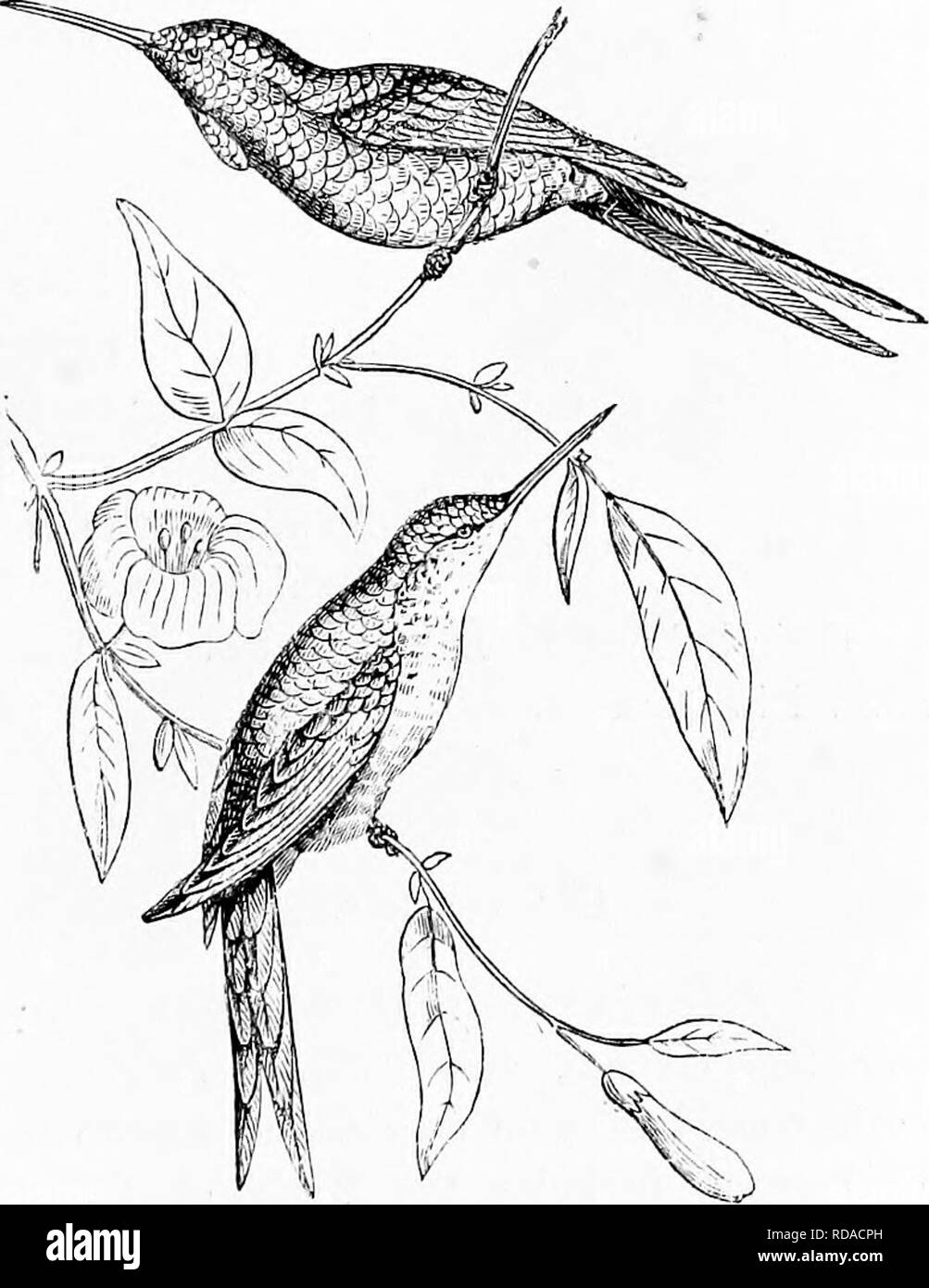 . Reptiles and birds. A popular account of the various orders; with a description of the habits and economy of the most interesting. Birds; Reptiles. SUCEIERS. 497 tliat of tlie Annumhi is fifteen inches in diameter by twenty- inches in height. The SucRTEKS (Cinnyridm) are American birds, so called from their attachment to saccharine substances. They feed on honey they extract from flowers, and the sap from the sugar-cane, the juice of which they suck through crevices in the stem. Like the Humming-birds, they have the tongue divided into two parts, by which they are enabled to seize insects, w Stock Photohttps://www.alamy.com/image-license-details/?v=1https://www.alamy.com/reptiles-and-birds-a-popular-account-of-the-various-orders-with-a-description-of-the-habits-and-economy-of-the-most-interesting-birds-reptiles-suceiers-497-tliat-of-tlie-annumhi-is-fifteen-inches-in-diameter-by-twenty-inches-in-height-the-sucrteks-cinnyridm-are-american-birds-so-called-from-their-attachment-to-saccharine-substances-they-feed-on-honey-they-extract-from-flowers-and-the-sap-from-the-sugar-cane-the-juice-of-which-they-suck-through-crevices-in-the-stem-like-the-humming-birds-they-have-the-tongue-divided-into-two-parts-by-which-they-are-enabled-to-seize-insects-w-image231954873.html
. Reptiles and birds. A popular account of the various orders; with a description of the habits and economy of the most interesting. Birds; Reptiles. SUCEIERS. 497 tliat of tlie Annumhi is fifteen inches in diameter by twenty- inches in height. The SucRTEKS (Cinnyridm) are American birds, so called from their attachment to saccharine substances. They feed on honey they extract from flowers, and the sap from the sugar-cane, the juice of which they suck through crevices in the stem. Like the Humming-birds, they have the tongue divided into two parts, by which they are enabled to seize insects, w Stock Photohttps://www.alamy.com/image-license-details/?v=1https://www.alamy.com/reptiles-and-birds-a-popular-account-of-the-various-orders-with-a-description-of-the-habits-and-economy-of-the-most-interesting-birds-reptiles-suceiers-497-tliat-of-tlie-annumhi-is-fifteen-inches-in-diameter-by-twenty-inches-in-height-the-sucrteks-cinnyridm-are-american-birds-so-called-from-their-attachment-to-saccharine-substances-they-feed-on-honey-they-extract-from-flowers-and-the-sap-from-the-sugar-cane-the-juice-of-which-they-suck-through-crevices-in-the-stem-like-the-humming-birds-they-have-the-tongue-divided-into-two-parts-by-which-they-are-enabled-to-seize-insects-w-image231954873.htmlRMRDACPH–. Reptiles and birds. A popular account of the various orders; with a description of the habits and economy of the most interesting. Birds; Reptiles. SUCEIERS. 497 tliat of tlie Annumhi is fifteen inches in diameter by twenty- inches in height. The SucRTEKS (Cinnyridm) are American birds, so called from their attachment to saccharine substances. They feed on honey they extract from flowers, and the sap from the sugar-cane, the juice of which they suck through crevices in the stem. Like the Humming-birds, they have the tongue divided into two parts, by which they are enabled to seize insects, w
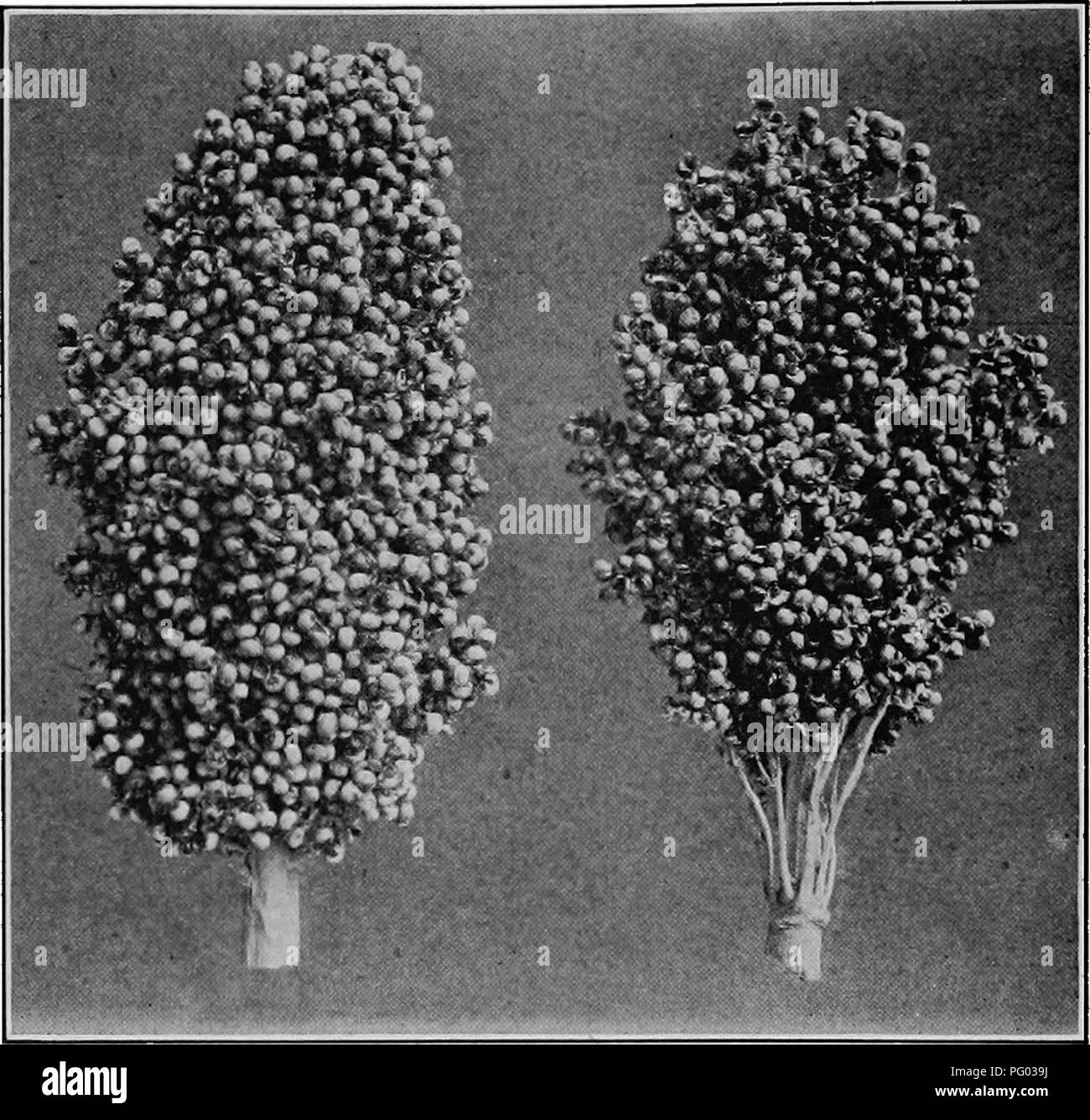 . Field crops for the cotton-belt. Agriculture. 378 FIELD CROPS FOR THE COTTON^BELT bagged each year and used for planting the breeding-plot of the next year. The quaUties selected for in improving the saccharine. Fig. 63. — Two heads of Milo showing desirable form (on left) and unde- sirable form (on right). sorghums are juiciness and high sugar content, yield, disease-resistance, drought-resistance, and erecfoess. In the improvement of the grain-sorghums the prin- cipal considerations should be (1) increased grain produc- tion; (2) increased drought-resistance; (3) increased earli- ness; (4) Stock Photohttps://www.alamy.com/image-license-details/?v=1https://www.alamy.com/field-crops-for-the-cotton-belt-agriculture-378-field-crops-for-the-cottonbelt-bagged-each-year-and-used-for-planting-the-breeding-plot-of-the-next-year-the-quauties-selected-for-in-improving-the-saccharine-fig-63-two-heads-of-milo-showing-desirable-form-on-left-and-unde-sirable-form-on-right-sorghums-are-juiciness-and-high-sugar-content-yield-disease-resistance-drought-resistance-and-erecfoess-in-the-improvement-of-the-grain-sorghums-the-prin-cipal-considerations-should-be-1-increased-grain-produc-tion-2-increased-drought-resistance-3-increased-earli-ness-4-image216361534.html
. Field crops for the cotton-belt. Agriculture. 378 FIELD CROPS FOR THE COTTON^BELT bagged each year and used for planting the breeding-plot of the next year. The quaUties selected for in improving the saccharine. Fig. 63. — Two heads of Milo showing desirable form (on left) and unde- sirable form (on right). sorghums are juiciness and high sugar content, yield, disease-resistance, drought-resistance, and erecfoess. In the improvement of the grain-sorghums the prin- cipal considerations should be (1) increased grain produc- tion; (2) increased drought-resistance; (3) increased earli- ness; (4) Stock Photohttps://www.alamy.com/image-license-details/?v=1https://www.alamy.com/field-crops-for-the-cotton-belt-agriculture-378-field-crops-for-the-cottonbelt-bagged-each-year-and-used-for-planting-the-breeding-plot-of-the-next-year-the-quauties-selected-for-in-improving-the-saccharine-fig-63-two-heads-of-milo-showing-desirable-form-on-left-and-unde-sirable-form-on-right-sorghums-are-juiciness-and-high-sugar-content-yield-disease-resistance-drought-resistance-and-erecfoess-in-the-improvement-of-the-grain-sorghums-the-prin-cipal-considerations-should-be-1-increased-grain-produc-tion-2-increased-drought-resistance-3-increased-earli-ness-4-image216361534.htmlRMPG039J–. Field crops for the cotton-belt. Agriculture. 378 FIELD CROPS FOR THE COTTON^BELT bagged each year and used for planting the breeding-plot of the next year. The quaUties selected for in improving the saccharine. Fig. 63. — Two heads of Milo showing desirable form (on left) and unde- sirable form (on right). sorghums are juiciness and high sugar content, yield, disease-resistance, drought-resistance, and erecfoess. In the improvement of the grain-sorghums the prin- cipal considerations should be (1) increased grain produc- tion; (2) increased drought-resistance; (3) increased earli- ness; (4)
 . The corn crops: a discussion of maize, kafirs, and sorghums as grown in the United States and Canada. Corn; Kafir corn; Sorghum. THE SACCHARINE SORGHUMS 295. $ORGi , CCMSUV1 II) THOUUNOS Fig. 97—Production of sorghum sirup middle of laat century.. Please note that these images are extracted from scanned page images that may have been digitally enhanced for readability - coloration and appearance of these illustrations may not perfectly resemble the original work.. Montgomery, Edward Gerrard, 1878-. New York, The Macmillan company Stock Photohttps://www.alamy.com/image-license-details/?v=1https://www.alamy.com/the-corn-crops-a-discussion-of-maize-kafirs-and-sorghums-as-grown-in-the-united-states-and-canada-corn-kafir-corn-sorghum-the-saccharine-sorghums-295-orgi-ccmsuv1-ii-thouunos-fig-97production-of-sorghum-sirup-middle-of-laat-century-please-note-that-these-images-are-extracted-from-scanned-page-images-that-may-have-been-digitally-enhanced-for-readability-coloration-and-appearance-of-these-illustrations-may-not-perfectly-resemble-the-original-work-montgomery-edward-gerrard-1878-new-york-the-macmillan-company-image232085668.html
. The corn crops: a discussion of maize, kafirs, and sorghums as grown in the United States and Canada. Corn; Kafir corn; Sorghum. THE SACCHARINE SORGHUMS 295. $ORGi , CCMSUV1 II) THOUUNOS Fig. 97—Production of sorghum sirup middle of laat century.. Please note that these images are extracted from scanned page images that may have been digitally enhanced for readability - coloration and appearance of these illustrations may not perfectly resemble the original work.. Montgomery, Edward Gerrard, 1878-. New York, The Macmillan company Stock Photohttps://www.alamy.com/image-license-details/?v=1https://www.alamy.com/the-corn-crops-a-discussion-of-maize-kafirs-and-sorghums-as-grown-in-the-united-states-and-canada-corn-kafir-corn-sorghum-the-saccharine-sorghums-295-orgi-ccmsuv1-ii-thouunos-fig-97production-of-sorghum-sirup-middle-of-laat-century-please-note-that-these-images-are-extracted-from-scanned-page-images-that-may-have-been-digitally-enhanced-for-readability-coloration-and-appearance-of-these-illustrations-may-not-perfectly-resemble-the-original-work-montgomery-edward-gerrard-1878-new-york-the-macmillan-company-image232085668.htmlRMRDGBHT–. The corn crops: a discussion of maize, kafirs, and sorghums as grown in the United States and Canada. Corn; Kafir corn; Sorghum. THE SACCHARINE SORGHUMS 295. $ORGi , CCMSUV1 II) THOUUNOS Fig. 97—Production of sorghum sirup middle of laat century.. Please note that these images are extracted from scanned page images that may have been digitally enhanced for readability - coloration and appearance of these illustrations may not perfectly resemble the original work.. Montgomery, Edward Gerrard, 1878-. New York, The Macmillan company
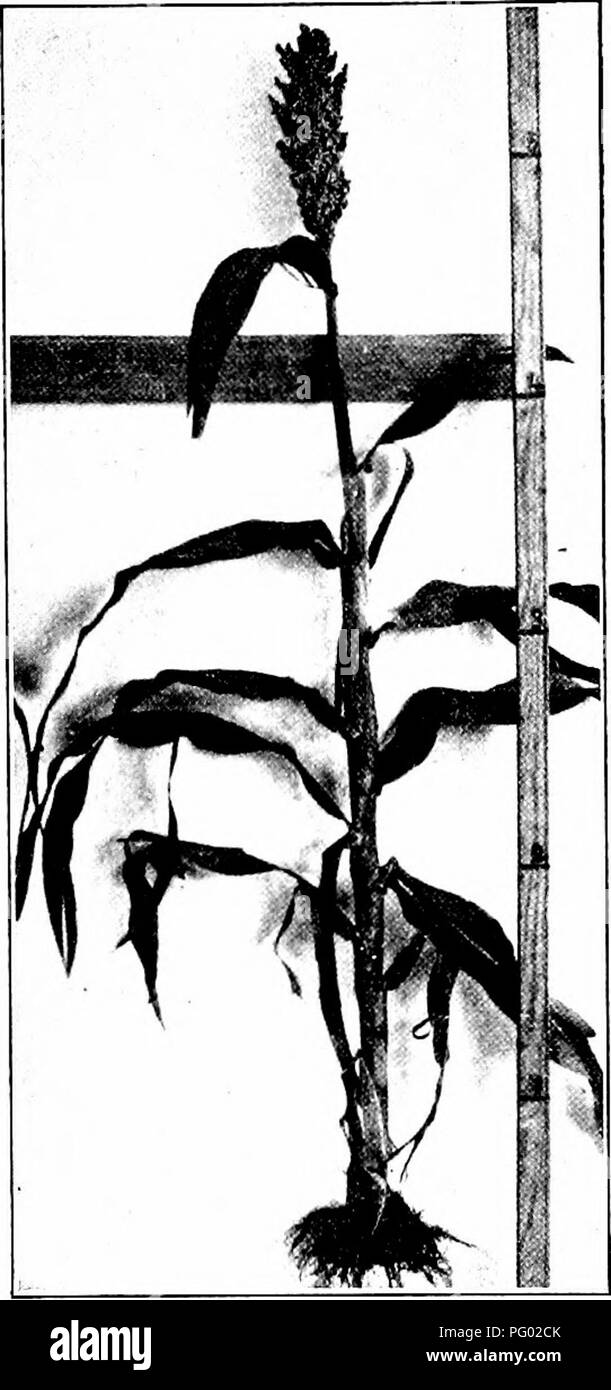 . The corn crops: a discussion of maize, kafirs, and sorghums as grown in the United States and Canada. Corn; Kafir corn; Sorghum. 310 CORN CROPS be a later introduction, having attracted attention about 1896. It had aU the good qualities of Red Kafir, and in addition the seed was not astringent. This variety probably furnishes nine- tenths of the kafir crop to-day, and Red Kafir the other tenth. 238. Durra. — The char- acteristics of this group are that the heads are mostly " goosenecked " and the seeds are large and flat. The extensive culture of non-saccharine sorghums in this cou Stock Photohttps://www.alamy.com/image-license-details/?v=1https://www.alamy.com/the-corn-crops-a-discussion-of-maize-kafirs-and-sorghums-as-grown-in-the-united-states-and-canada-corn-kafir-corn-sorghum-310-corn-crops-be-a-later-introduction-having-attracted-attention-about-1896-it-had-au-the-good-qualities-of-red-kafir-and-in-addition-the-seed-was-not-astringent-this-variety-probably-furnishes-nine-tenths-of-the-kafir-crop-to-day-and-red-kafir-the-other-tenth-238-durra-the-char-acteristics-of-this-group-are-that-the-heads-are-mostly-quot-goosenecked-quot-and-the-seeds-are-large-and-flat-the-extensive-culture-of-non-saccharine-sorghums-in-this-cou-image216360835.html
. The corn crops: a discussion of maize, kafirs, and sorghums as grown in the United States and Canada. Corn; Kafir corn; Sorghum. 310 CORN CROPS be a later introduction, having attracted attention about 1896. It had aU the good qualities of Red Kafir, and in addition the seed was not astringent. This variety probably furnishes nine- tenths of the kafir crop to-day, and Red Kafir the other tenth. 238. Durra. — The char- acteristics of this group are that the heads are mostly " goosenecked " and the seeds are large and flat. The extensive culture of non-saccharine sorghums in this cou Stock Photohttps://www.alamy.com/image-license-details/?v=1https://www.alamy.com/the-corn-crops-a-discussion-of-maize-kafirs-and-sorghums-as-grown-in-the-united-states-and-canada-corn-kafir-corn-sorghum-310-corn-crops-be-a-later-introduction-having-attracted-attention-about-1896-it-had-au-the-good-qualities-of-red-kafir-and-in-addition-the-seed-was-not-astringent-this-variety-probably-furnishes-nine-tenths-of-the-kafir-crop-to-day-and-red-kafir-the-other-tenth-238-durra-the-char-acteristics-of-this-group-are-that-the-heads-are-mostly-quot-goosenecked-quot-and-the-seeds-are-large-and-flat-the-extensive-culture-of-non-saccharine-sorghums-in-this-cou-image216360835.htmlRMPG02CK–. The corn crops: a discussion of maize, kafirs, and sorghums as grown in the United States and Canada. Corn; Kafir corn; Sorghum. 310 CORN CROPS be a later introduction, having attracted attention about 1896. It had aU the good qualities of Red Kafir, and in addition the seed was not astringent. This variety probably furnishes nine- tenths of the kafir crop to-day, and Red Kafir the other tenth. 238. Durra. — The char- acteristics of this group are that the heads are mostly " goosenecked " and the seeds are large and flat. The extensive culture of non-saccharine sorghums in this cou
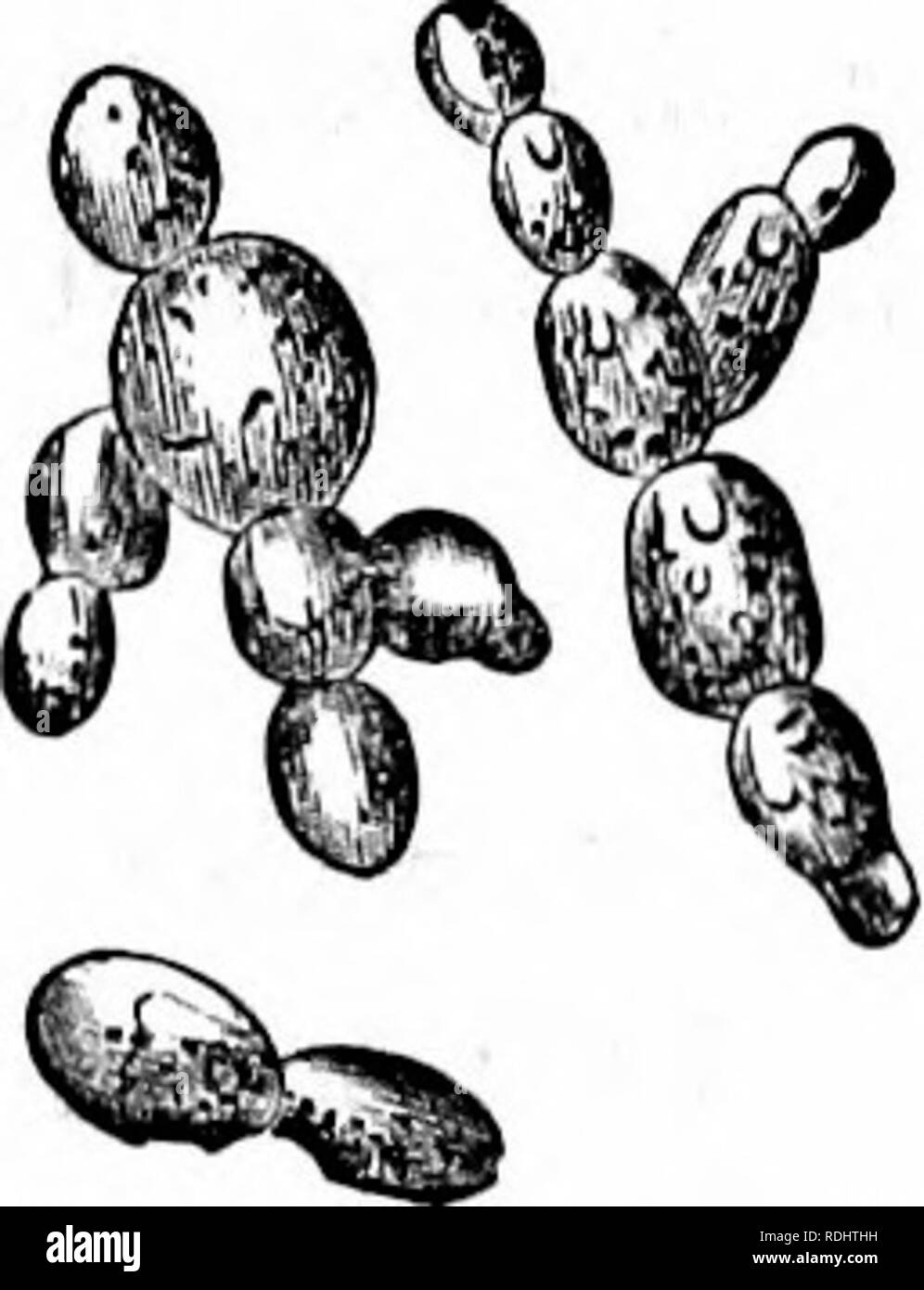 . Microbes, ferments and moulds . Bacteria; Fungi; Fermentation. FERMENTS AND ABTIFICIAL FERMENTATIONS. 79 all the ferments, and may be regarded as the type of the family. Its cells are round or o'^al, from eight to nine micro-millimetres in their longest diameter, isolated or united in pairs (Fig. 35). When these cells are â deposited in a saccharine liquid, which is therefore susceptible to fermentation, vesicular swellings, filled with protoplasm at the expense of the mother cell, may be observed at one. Please note that these images are extracted from scanned page images that may have been Stock Photohttps://www.alamy.com/image-license-details/?v=1https://www.alamy.com/microbes-ferments-and-moulds-bacteria-fungi-fermentation-ferments-and-abtificial-fermentations-79-all-the-ferments-and-may-be-regarded-as-the-type-of-the-family-its-cells-are-round-or-oal-from-eight-to-nine-micro-millimetres-in-their-longest-diameter-isolated-or-united-in-pairs-fig-35-when-these-cells-are-deposited-in-a-saccharine-liquid-which-is-therefore-susceptible-to-fermentation-vesicular-swellings-filled-with-protoplasm-at-the-expense-of-the-mother-cell-may-be-observed-at-one-please-note-that-these-images-are-extracted-from-scanned-page-images-that-may-have-been-image232117805.html
. Microbes, ferments and moulds . Bacteria; Fungi; Fermentation. FERMENTS AND ABTIFICIAL FERMENTATIONS. 79 all the ferments, and may be regarded as the type of the family. Its cells are round or o'^al, from eight to nine micro-millimetres in their longest diameter, isolated or united in pairs (Fig. 35). When these cells are â deposited in a saccharine liquid, which is therefore susceptible to fermentation, vesicular swellings, filled with protoplasm at the expense of the mother cell, may be observed at one. Please note that these images are extracted from scanned page images that may have been Stock Photohttps://www.alamy.com/image-license-details/?v=1https://www.alamy.com/microbes-ferments-and-moulds-bacteria-fungi-fermentation-ferments-and-abtificial-fermentations-79-all-the-ferments-and-may-be-regarded-as-the-type-of-the-family-its-cells-are-round-or-oal-from-eight-to-nine-micro-millimetres-in-their-longest-diameter-isolated-or-united-in-pairs-fig-35-when-these-cells-are-deposited-in-a-saccharine-liquid-which-is-therefore-susceptible-to-fermentation-vesicular-swellings-filled-with-protoplasm-at-the-expense-of-the-mother-cell-may-be-observed-at-one-please-note-that-these-images-are-extracted-from-scanned-page-images-that-may-have-been-image232117805.htmlRMRDHTHH–. Microbes, ferments and moulds . Bacteria; Fungi; Fermentation. FERMENTS AND ABTIFICIAL FERMENTATIONS. 79 all the ferments, and may be regarded as the type of the family. Its cells are round or o'^al, from eight to nine micro-millimetres in their longest diameter, isolated or united in pairs (Fig. 35). When these cells are â deposited in a saccharine liquid, which is therefore susceptible to fermentation, vesicular swellings, filled with protoplasm at the expense of the mother cell, may be observed at one. Please note that these images are extracted from scanned page images that may have been
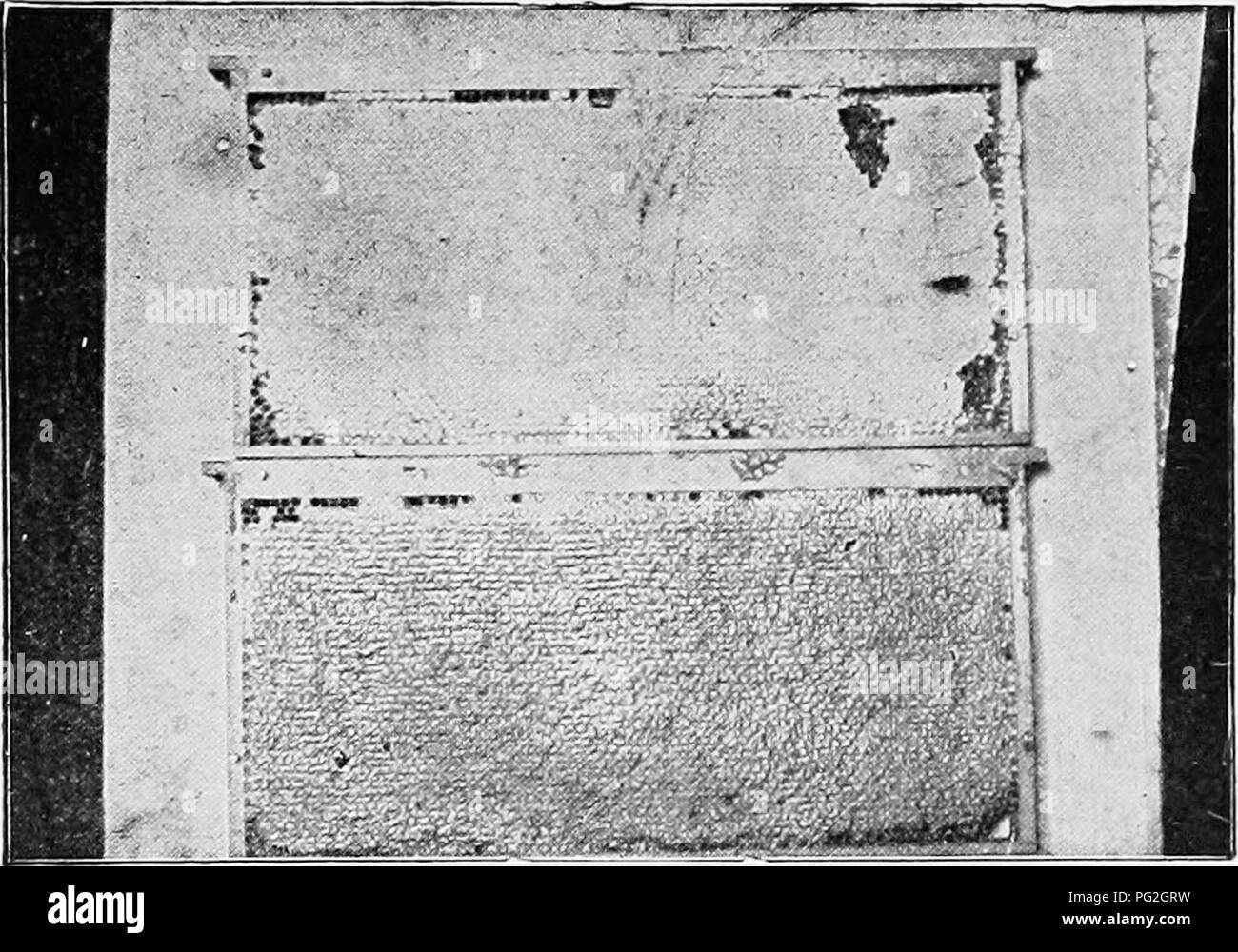 . Langstroth on the hive and honey-bee. Bees. HOXEY. 117 to eighty per cent of water, there are many late plants that give honey which needs little evaporation: The honey from heather is said to be difficult to extract from the combs (746), owing to its density. 250. The quantity of nectar produced by the flowers decreases duruig drought, and increases on the first or second day after a rain. But it is then more watery. In some sea- sons the saccharine juices abound, while in others they are so deficient that bees can obtain scarcely any food from fields all. Pig. 48. COMBS CONTAINING SEAiED H Stock Photohttps://www.alamy.com/image-license-details/?v=1https://www.alamy.com/langstroth-on-the-hive-and-honey-bee-bees-hoxey-117-to-eighty-per-cent-of-water-there-are-many-late-plants-that-give-honey-which-needs-little-evaporation-the-honey-from-heather-is-said-to-be-difficult-to-extract-from-the-combs-746-owing-to-its-density-250-the-quantity-of-nectar-produced-by-the-flowers-decreases-duruig-drought-and-increases-on-the-first-or-second-day-after-a-rain-but-it-is-then-more-watery-in-some-sea-sons-the-saccharine-juices-abound-while-in-others-they-are-so-deficient-that-bees-can-obtain-scarcely-any-food-from-fields-all-pig-48-combs-containing-seaied-h-image216416029.html
. Langstroth on the hive and honey-bee. Bees. HOXEY. 117 to eighty per cent of water, there are many late plants that give honey which needs little evaporation: The honey from heather is said to be difficult to extract from the combs (746), owing to its density. 250. The quantity of nectar produced by the flowers decreases duruig drought, and increases on the first or second day after a rain. But it is then more watery. In some sea- sons the saccharine juices abound, while in others they are so deficient that bees can obtain scarcely any food from fields all. Pig. 48. COMBS CONTAINING SEAiED H Stock Photohttps://www.alamy.com/image-license-details/?v=1https://www.alamy.com/langstroth-on-the-hive-and-honey-bee-bees-hoxey-117-to-eighty-per-cent-of-water-there-are-many-late-plants-that-give-honey-which-needs-little-evaporation-the-honey-from-heather-is-said-to-be-difficult-to-extract-from-the-combs-746-owing-to-its-density-250-the-quantity-of-nectar-produced-by-the-flowers-decreases-duruig-drought-and-increases-on-the-first-or-second-day-after-a-rain-but-it-is-then-more-watery-in-some-sea-sons-the-saccharine-juices-abound-while-in-others-they-are-so-deficient-that-bees-can-obtain-scarcely-any-food-from-fields-all-pig-48-combs-containing-seaied-h-image216416029.htmlRMPG2GRW–. Langstroth on the hive and honey-bee. Bees. HOXEY. 117 to eighty per cent of water, there are many late plants that give honey which needs little evaporation: The honey from heather is said to be difficult to extract from the combs (746), owing to its density. 250. The quantity of nectar produced by the flowers decreases duruig drought, and increases on the first or second day after a rain. But it is then more watery. In some sea- sons the saccharine juices abound, while in others they are so deficient that bees can obtain scarcely any food from fields all. Pig. 48. COMBS CONTAINING SEAiED H
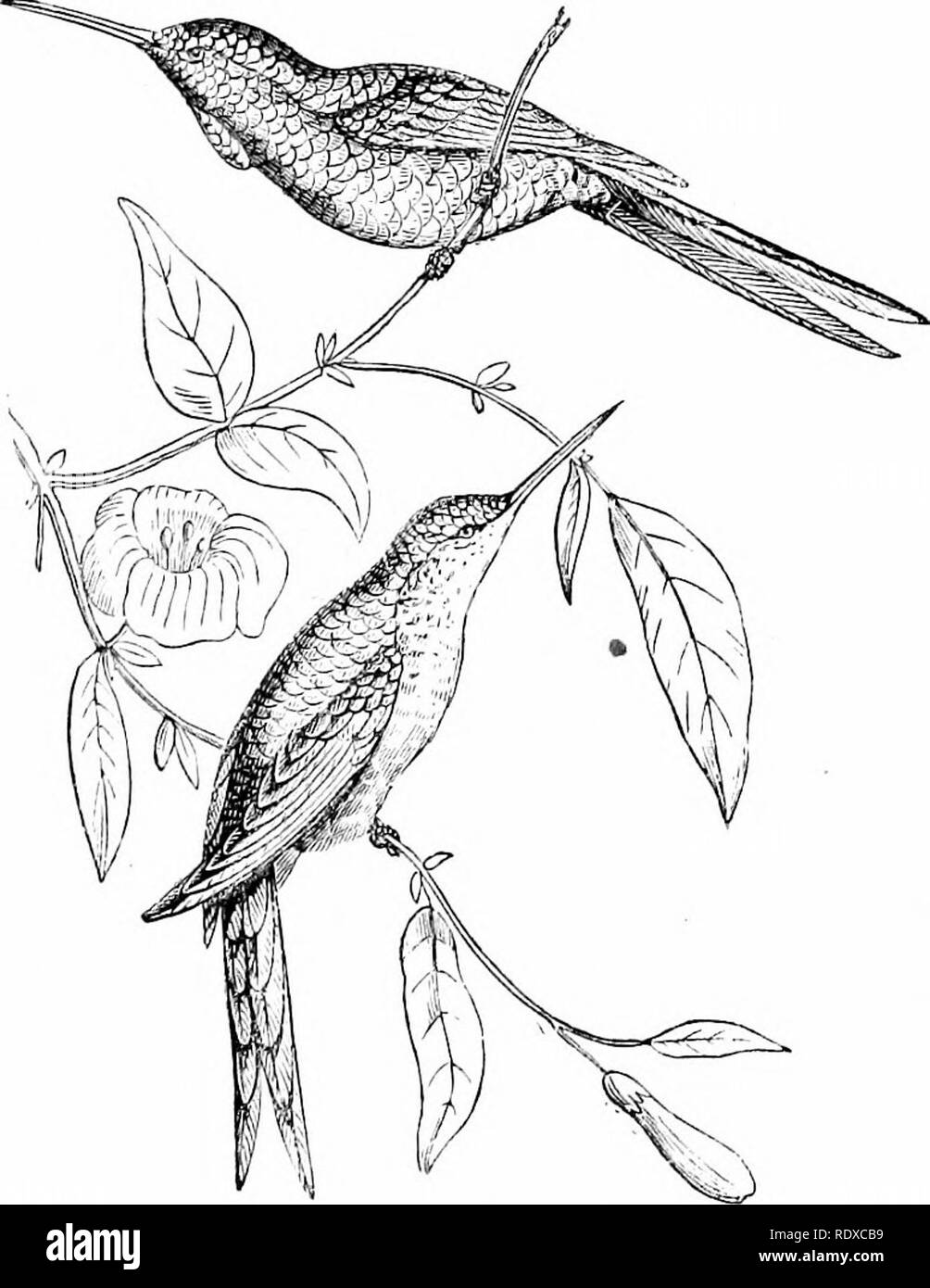 . Reptiles and birds : a popular account of their various orders : with a description of the habits and economy of the most interesting . Birds; Reptiles. SUCEIEES. 497 that of the Anjiumbi is fifteen inches in diameter by twenty inches in height. The SucRiERS (Cinnyridce) are American birds, so called from their attachment to saccharine substances. They feed on honey they extract from flowers, and the sap from the sugar-cane, the juice of which they suck through crevices in the stem. Like the Humming-birds, they have the tongue divided into two parts, by which they are enabled to seize insect Stock Photohttps://www.alamy.com/image-license-details/?v=1https://www.alamy.com/reptiles-and-birds-a-popular-account-of-their-various-orders-with-a-description-of-the-habits-and-economy-of-the-most-interesting-birds-reptiles-suceiees-497-that-of-the-anjiumbi-is-fifteen-inches-in-diameter-by-twenty-inches-in-height-the-sucriers-cinnyridce-are-american-birds-so-called-from-their-attachment-to-saccharine-substances-they-feed-on-honey-they-extract-from-flowers-and-the-sap-from-the-sugar-cane-the-juice-of-which-they-suck-through-crevices-in-the-stem-like-the-humming-birds-they-have-the-tongue-divided-into-two-parts-by-which-they-are-enabled-to-seize-insect-image232305789.html
. Reptiles and birds : a popular account of their various orders : with a description of the habits and economy of the most interesting . Birds; Reptiles. SUCEIEES. 497 that of the Anjiumbi is fifteen inches in diameter by twenty inches in height. The SucRiERS (Cinnyridce) are American birds, so called from their attachment to saccharine substances. They feed on honey they extract from flowers, and the sap from the sugar-cane, the juice of which they suck through crevices in the stem. Like the Humming-birds, they have the tongue divided into two parts, by which they are enabled to seize insect Stock Photohttps://www.alamy.com/image-license-details/?v=1https://www.alamy.com/reptiles-and-birds-a-popular-account-of-their-various-orders-with-a-description-of-the-habits-and-economy-of-the-most-interesting-birds-reptiles-suceiees-497-that-of-the-anjiumbi-is-fifteen-inches-in-diameter-by-twenty-inches-in-height-the-sucriers-cinnyridce-are-american-birds-so-called-from-their-attachment-to-saccharine-substances-they-feed-on-honey-they-extract-from-flowers-and-the-sap-from-the-sugar-cane-the-juice-of-which-they-suck-through-crevices-in-the-stem-like-the-humming-birds-they-have-the-tongue-divided-into-two-parts-by-which-they-are-enabled-to-seize-insect-image232305789.htmlRMRDXCB9–. Reptiles and birds : a popular account of their various orders : with a description of the habits and economy of the most interesting . Birds; Reptiles. SUCEIEES. 497 that of the Anjiumbi is fifteen inches in diameter by twenty inches in height. The SucRiERS (Cinnyridce) are American birds, so called from their attachment to saccharine substances. They feed on honey they extract from flowers, and the sap from the sugar-cane, the juice of which they suck through crevices in the stem. Like the Humming-birds, they have the tongue divided into two parts, by which they are enabled to seize insect
 . The corn crops: a discussion of maize, kafirs, and sorghums as grown in the United States and Canada. Corn; Kafir corn; Sorghum. THK SACCHARINE SORGHUMS 299 and the plant is more leafy. The variety name refers to the deep orange color of the ripe heads. This variety is excellent for sirup pro- duction and it makes a heavy yield of for- age, especially on good land. However, for cured forage farmers object somewhat to heavy stalks, as they are more difficult to handle and cure. Orange sorghum is second in popularity to Amber and is grown principally from Kan- sas southward. Collier and Colema Stock Photohttps://www.alamy.com/image-license-details/?v=1https://www.alamy.com/the-corn-crops-a-discussion-of-maize-kafirs-and-sorghums-as-grown-in-the-united-states-and-canada-corn-kafir-corn-sorghum-thk-saccharine-sorghums-299-and-the-plant-is-more-leafy-the-variety-name-refers-to-the-deep-orange-color-of-the-ripe-heads-this-variety-is-excellent-for-sirup-pro-duction-and-it-makes-a-heavy-yield-of-for-age-especially-on-good-land-however-for-cured-forage-farmers-object-somewhat-to-heavy-stalks-as-they-are-more-difficult-to-handle-and-cure-orange-sorghum-is-second-in-popularity-to-amber-and-is-grown-principally-from-kan-sas-southward-collier-and-colema-image216400003.html
. The corn crops: a discussion of maize, kafirs, and sorghums as grown in the United States and Canada. Corn; Kafir corn; Sorghum. THK SACCHARINE SORGHUMS 299 and the plant is more leafy. The variety name refers to the deep orange color of the ripe heads. This variety is excellent for sirup pro- duction and it makes a heavy yield of for- age, especially on good land. However, for cured forage farmers object somewhat to heavy stalks, as they are more difficult to handle and cure. Orange sorghum is second in popularity to Amber and is grown principally from Kan- sas southward. Collier and Colema Stock Photohttps://www.alamy.com/image-license-details/?v=1https://www.alamy.com/the-corn-crops-a-discussion-of-maize-kafirs-and-sorghums-as-grown-in-the-united-states-and-canada-corn-kafir-corn-sorghum-thk-saccharine-sorghums-299-and-the-plant-is-more-leafy-the-variety-name-refers-to-the-deep-orange-color-of-the-ripe-heads-this-variety-is-excellent-for-sirup-pro-duction-and-it-makes-a-heavy-yield-of-for-age-especially-on-good-land-however-for-cured-forage-farmers-object-somewhat-to-heavy-stalks-as-they-are-more-difficult-to-handle-and-cure-orange-sorghum-is-second-in-popularity-to-amber-and-is-grown-principally-from-kan-sas-southward-collier-and-colema-image216400003.htmlRMPG1TBF–. The corn crops: a discussion of maize, kafirs, and sorghums as grown in the United States and Canada. Corn; Kafir corn; Sorghum. THK SACCHARINE SORGHUMS 299 and the plant is more leafy. The variety name refers to the deep orange color of the ripe heads. This variety is excellent for sirup pro- duction and it makes a heavy yield of for- age, especially on good land. However, for cured forage farmers object somewhat to heavy stalks, as they are more difficult to handle and cure. Orange sorghum is second in popularity to Amber and is grown principally from Kan- sas southward. Collier and Colema
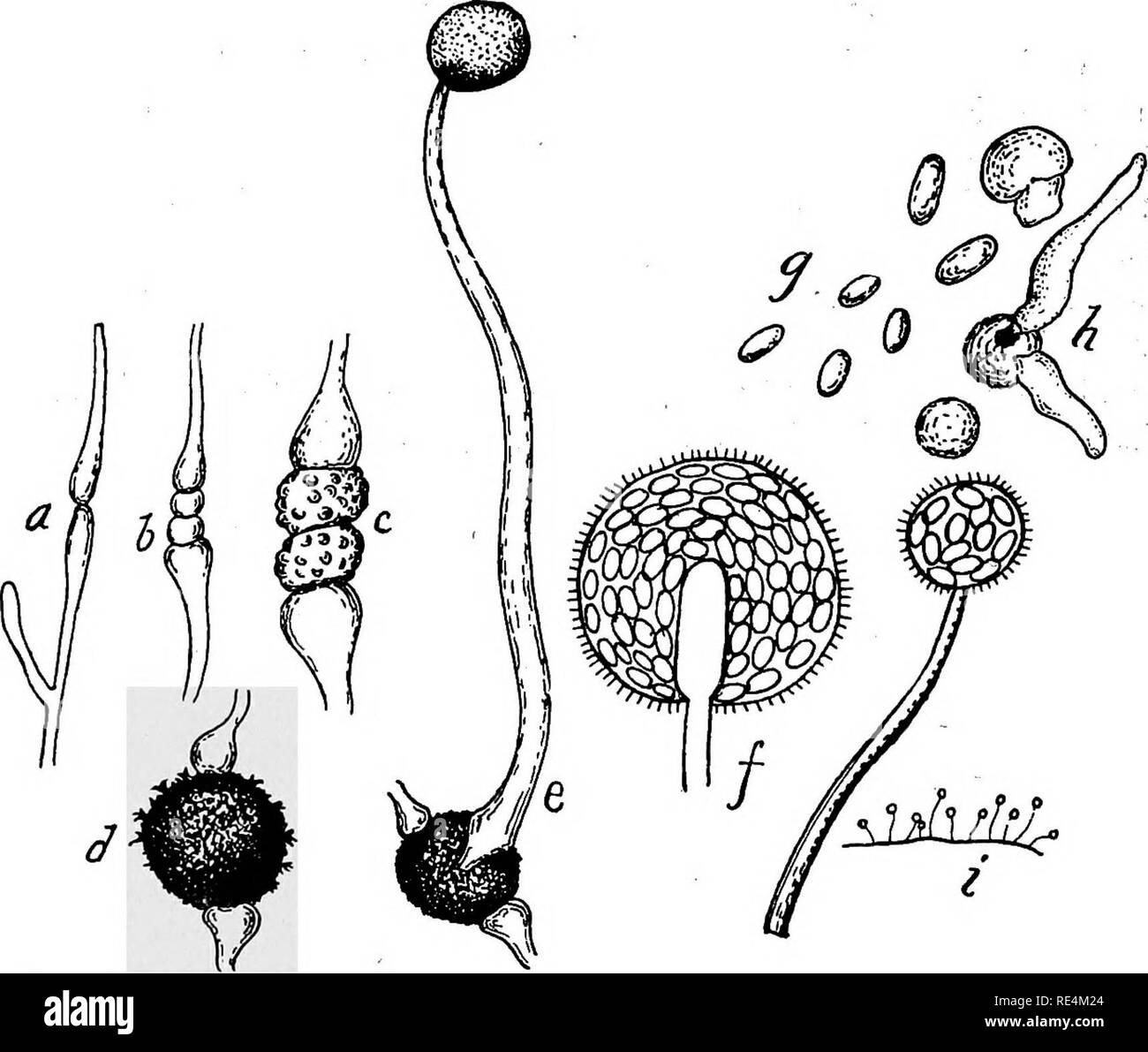 . Pharmaceutical bacteriology. Bacteriology; Disinfection and disinfectants. CHAPTER XIII YEASTS AND MOLDS The organisms commonly designated as yeasts and molds, though not belonging to the bacteria (Schizomycetes), are of the greatest importance in^human economy and play a most active part in life. Some of them are most beneficent while others are very injurious to health. The yeast organisms (Saccharomyces) cause the alcoholic fermentations in saccharine. Fig. 69.—Development of Mucor mucedo. a, b, c, d, stages in tlie £onnation of the zygospore; d, mature zygospore; e,f, endospore formation Stock Photohttps://www.alamy.com/image-license-details/?v=1https://www.alamy.com/pharmaceutical-bacteriology-bacteriology-disinfection-and-disinfectants-chapter-xiii-yeasts-and-molds-the-organisms-commonly-designated-as-yeasts-and-molds-though-not-belonging-to-the-bacteria-schizomycetes-are-of-the-greatest-importance-inhuman-economy-and-play-a-most-active-part-in-life-some-of-them-are-most-beneficent-while-others-are-very-injurious-to-health-the-yeast-organisms-saccharomyces-cause-the-alcoholic-fermentations-in-saccharine-fig-69development-of-mucor-mucedo-a-b-c-d-stages-in-tlie-onnation-of-the-zygospore-d-mature-zygospore-ef-endospore-formation-image232443516.html
. Pharmaceutical bacteriology. Bacteriology; Disinfection and disinfectants. CHAPTER XIII YEASTS AND MOLDS The organisms commonly designated as yeasts and molds, though not belonging to the bacteria (Schizomycetes), are of the greatest importance in^human economy and play a most active part in life. Some of them are most beneficent while others are very injurious to health. The yeast organisms (Saccharomyces) cause the alcoholic fermentations in saccharine. Fig. 69.—Development of Mucor mucedo. a, b, c, d, stages in tlie £onnation of the zygospore; d, mature zygospore; e,f, endospore formation Stock Photohttps://www.alamy.com/image-license-details/?v=1https://www.alamy.com/pharmaceutical-bacteriology-bacteriology-disinfection-and-disinfectants-chapter-xiii-yeasts-and-molds-the-organisms-commonly-designated-as-yeasts-and-molds-though-not-belonging-to-the-bacteria-schizomycetes-are-of-the-greatest-importance-inhuman-economy-and-play-a-most-active-part-in-life-some-of-them-are-most-beneficent-while-others-are-very-injurious-to-health-the-yeast-organisms-saccharomyces-cause-the-alcoholic-fermentations-in-saccharine-fig-69development-of-mucor-mucedo-a-b-c-d-stages-in-tlie-onnation-of-the-zygospore-d-mature-zygospore-ef-endospore-formation-image232443516.htmlRMRE4M24–. Pharmaceutical bacteriology. Bacteriology; Disinfection and disinfectants. CHAPTER XIII YEASTS AND MOLDS The organisms commonly designated as yeasts and molds, though not belonging to the bacteria (Schizomycetes), are of the greatest importance in^human economy and play a most active part in life. Some of them are most beneficent while others are very injurious to health. The yeast organisms (Saccharomyces) cause the alcoholic fermentations in saccharine. Fig. 69.—Development of Mucor mucedo. a, b, c, d, stages in tlie £onnation of the zygospore; d, mature zygospore; e,f, endospore formation
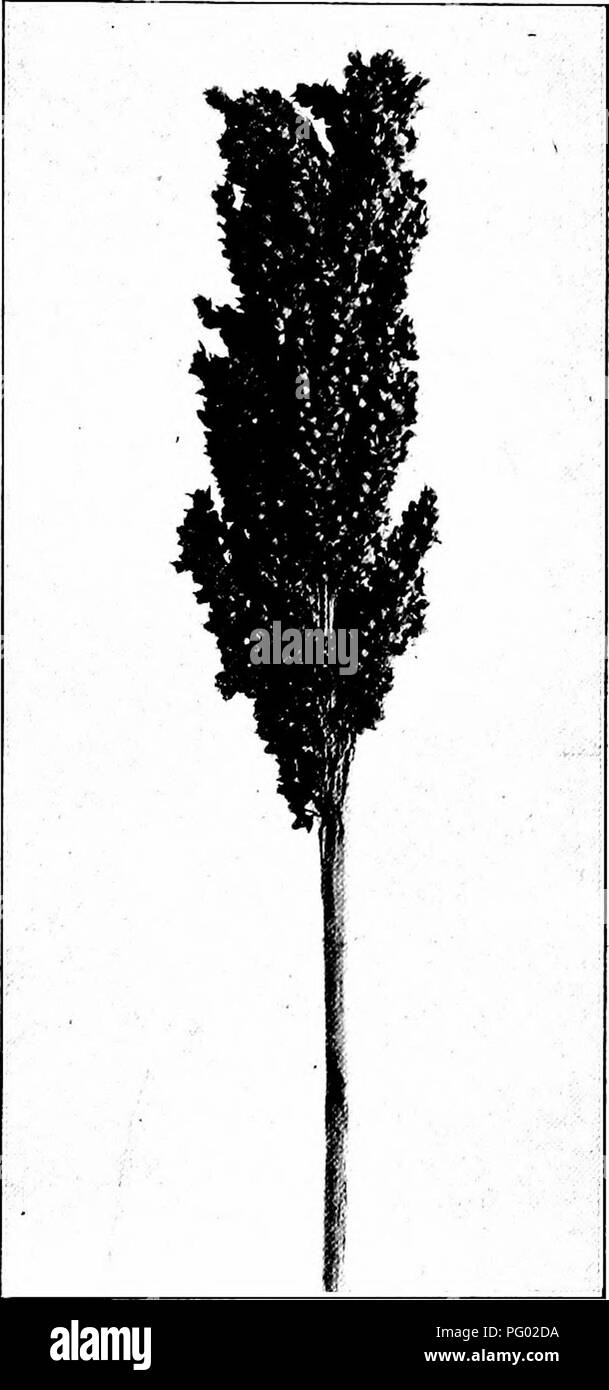 . The corn crops: a discussion of maize, kafirs, and sorghums as grown in the United States and Canada. Corn; Kafir corn; Sorghum. THE SACCHARINE SOBGHUMS 299 and the plant is more leafy. The variety name refers to the deep orange color of the ripe heads. This variety is excellent for sirup pro- duction and it makes a heavy yield of for- age, especially on good land. However, for cured forage farmers object somewhat to heavy stalks, as they are more difficult to handle and cure. Orange sorghum is second in popularity to Amber and is grown principally from Kan- sas southward. Collier and Colema Stock Photohttps://www.alamy.com/image-license-details/?v=1https://www.alamy.com/the-corn-crops-a-discussion-of-maize-kafirs-and-sorghums-as-grown-in-the-united-states-and-canada-corn-kafir-corn-sorghum-the-saccharine-sobghums-299-and-the-plant-is-more-leafy-the-variety-name-refers-to-the-deep-orange-color-of-the-ripe-heads-this-variety-is-excellent-for-sirup-pro-duction-and-it-makes-a-heavy-yield-of-for-age-especially-on-good-land-however-for-cured-forage-farmers-object-somewhat-to-heavy-stalks-as-they-are-more-difficult-to-handle-and-cure-orange-sorghum-is-second-in-popularity-to-amber-and-is-grown-principally-from-kan-sas-southward-collier-and-colema-image216360854.html
. The corn crops: a discussion of maize, kafirs, and sorghums as grown in the United States and Canada. Corn; Kafir corn; Sorghum. THE SACCHARINE SOBGHUMS 299 and the plant is more leafy. The variety name refers to the deep orange color of the ripe heads. This variety is excellent for sirup pro- duction and it makes a heavy yield of for- age, especially on good land. However, for cured forage farmers object somewhat to heavy stalks, as they are more difficult to handle and cure. Orange sorghum is second in popularity to Amber and is grown principally from Kan- sas southward. Collier and Colema Stock Photohttps://www.alamy.com/image-license-details/?v=1https://www.alamy.com/the-corn-crops-a-discussion-of-maize-kafirs-and-sorghums-as-grown-in-the-united-states-and-canada-corn-kafir-corn-sorghum-the-saccharine-sobghums-299-and-the-plant-is-more-leafy-the-variety-name-refers-to-the-deep-orange-color-of-the-ripe-heads-this-variety-is-excellent-for-sirup-pro-duction-and-it-makes-a-heavy-yield-of-for-age-especially-on-good-land-however-for-cured-forage-farmers-object-somewhat-to-heavy-stalks-as-they-are-more-difficult-to-handle-and-cure-orange-sorghum-is-second-in-popularity-to-amber-and-is-grown-principally-from-kan-sas-southward-collier-and-colema-image216360854.htmlRMPG02DA–. The corn crops: a discussion of maize, kafirs, and sorghums as grown in the United States and Canada. Corn; Kafir corn; Sorghum. THE SACCHARINE SOBGHUMS 299 and the plant is more leafy. The variety name refers to the deep orange color of the ripe heads. This variety is excellent for sirup pro- duction and it makes a heavy yield of for- age, especially on good land. However, for cured forage farmers object somewhat to heavy stalks, as they are more difficult to handle and cure. Orange sorghum is second in popularity to Amber and is grown principally from Kan- sas southward. Collier and Colema
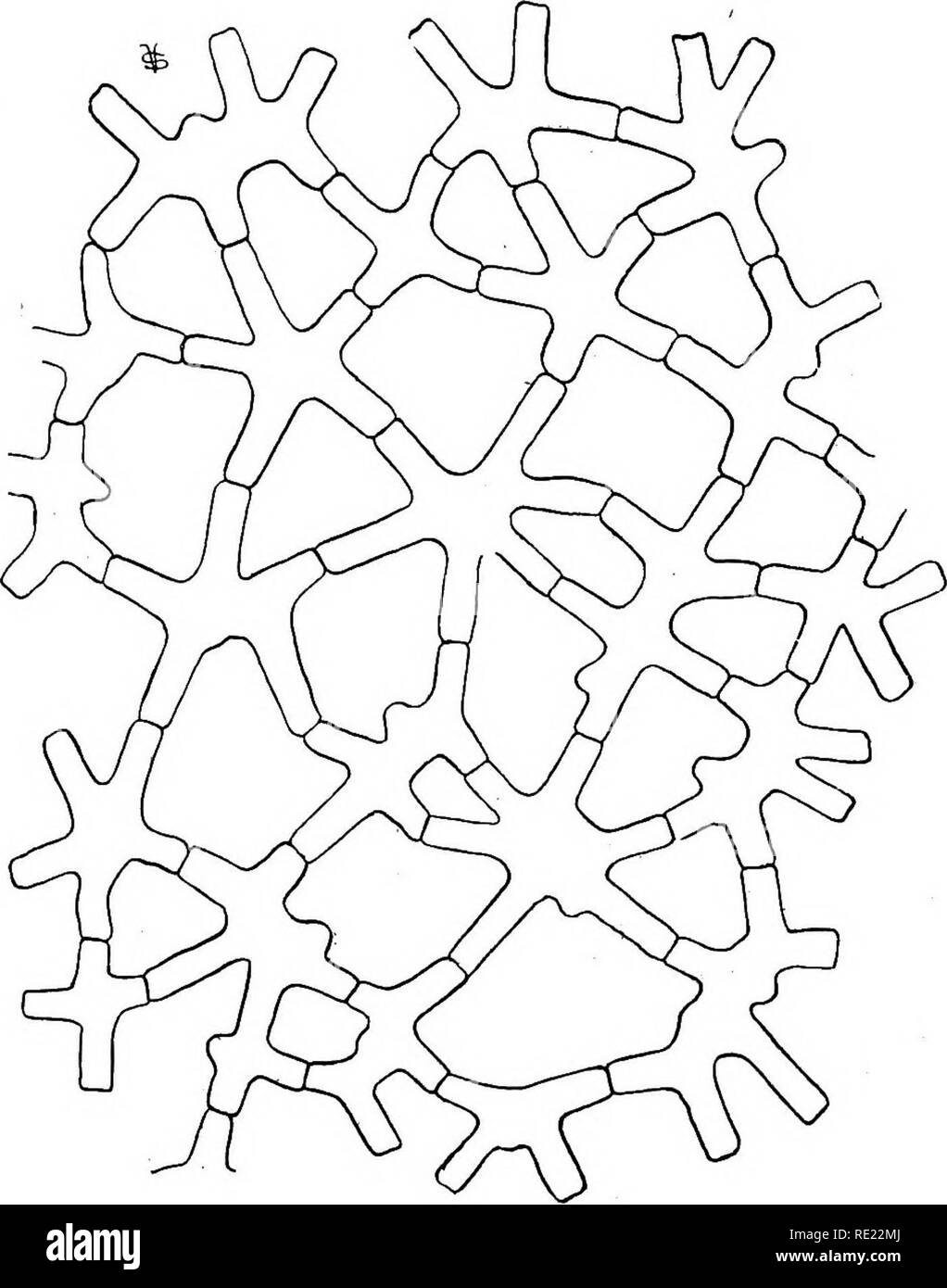 . Pharmaceutical bacteriology. Bacteriology; Disinfection and disinfectants. 3o6 PHARMACEUTICAL BACTERIOLOGY resulting in an alcoholic drink which is said to have a very peculiar flavor. Pressed yeast cakes for bread making are prepared as follows: The iiltered saccharine yeast mash in vats, is inoculated with pure cultures of Saccharomyces cerevisem. Active fermentation takes place in the presence of pure air which is supplied through pipes leading into the vat.. Fig. 79-—Showing the characteristic stellate cells of the pith of some reed used as filtering material in clarifying sak6. Bundles Stock Photohttps://www.alamy.com/image-license-details/?v=1https://www.alamy.com/pharmaceutical-bacteriology-bacteriology-disinfection-and-disinfectants-3o6-pharmaceutical-bacteriology-resulting-in-an-alcoholic-drink-which-is-said-to-have-a-very-peculiar-flavor-pressed-yeast-cakes-for-bread-making-are-prepared-as-follows-the-iiltered-saccharine-yeast-mash-in-vats-is-inoculated-with-pure-cultures-of-saccharomyces-cerevisem-active-fermentation-takes-place-in-the-presence-of-pure-air-which-is-supplied-through-pipes-leading-into-the-vat-fig-79-showing-the-characteristic-stellate-cells-of-the-pith-of-some-reed-used-as-filtering-material-in-clarifying-sak6-bundles-image232386018.html
. Pharmaceutical bacteriology. Bacteriology; Disinfection and disinfectants. 3o6 PHARMACEUTICAL BACTERIOLOGY resulting in an alcoholic drink which is said to have a very peculiar flavor. Pressed yeast cakes for bread making are prepared as follows: The iiltered saccharine yeast mash in vats, is inoculated with pure cultures of Saccharomyces cerevisem. Active fermentation takes place in the presence of pure air which is supplied through pipes leading into the vat.. Fig. 79-—Showing the characteristic stellate cells of the pith of some reed used as filtering material in clarifying sak6. Bundles Stock Photohttps://www.alamy.com/image-license-details/?v=1https://www.alamy.com/pharmaceutical-bacteriology-bacteriology-disinfection-and-disinfectants-3o6-pharmaceutical-bacteriology-resulting-in-an-alcoholic-drink-which-is-said-to-have-a-very-peculiar-flavor-pressed-yeast-cakes-for-bread-making-are-prepared-as-follows-the-iiltered-saccharine-yeast-mash-in-vats-is-inoculated-with-pure-cultures-of-saccharomyces-cerevisem-active-fermentation-takes-place-in-the-presence-of-pure-air-which-is-supplied-through-pipes-leading-into-the-vat-fig-79-showing-the-characteristic-stellate-cells-of-the-pith-of-some-reed-used-as-filtering-material-in-clarifying-sak6-bundles-image232386018.htmlRMRE22MJ–. Pharmaceutical bacteriology. Bacteriology; Disinfection and disinfectants. 3o6 PHARMACEUTICAL BACTERIOLOGY resulting in an alcoholic drink which is said to have a very peculiar flavor. Pressed yeast cakes for bread making are prepared as follows: The iiltered saccharine yeast mash in vats, is inoculated with pure cultures of Saccharomyces cerevisem. Active fermentation takes place in the presence of pure air which is supplied through pipes leading into the vat.. Fig. 79-—Showing the characteristic stellate cells of the pith of some reed used as filtering material in clarifying sak6. Bundles
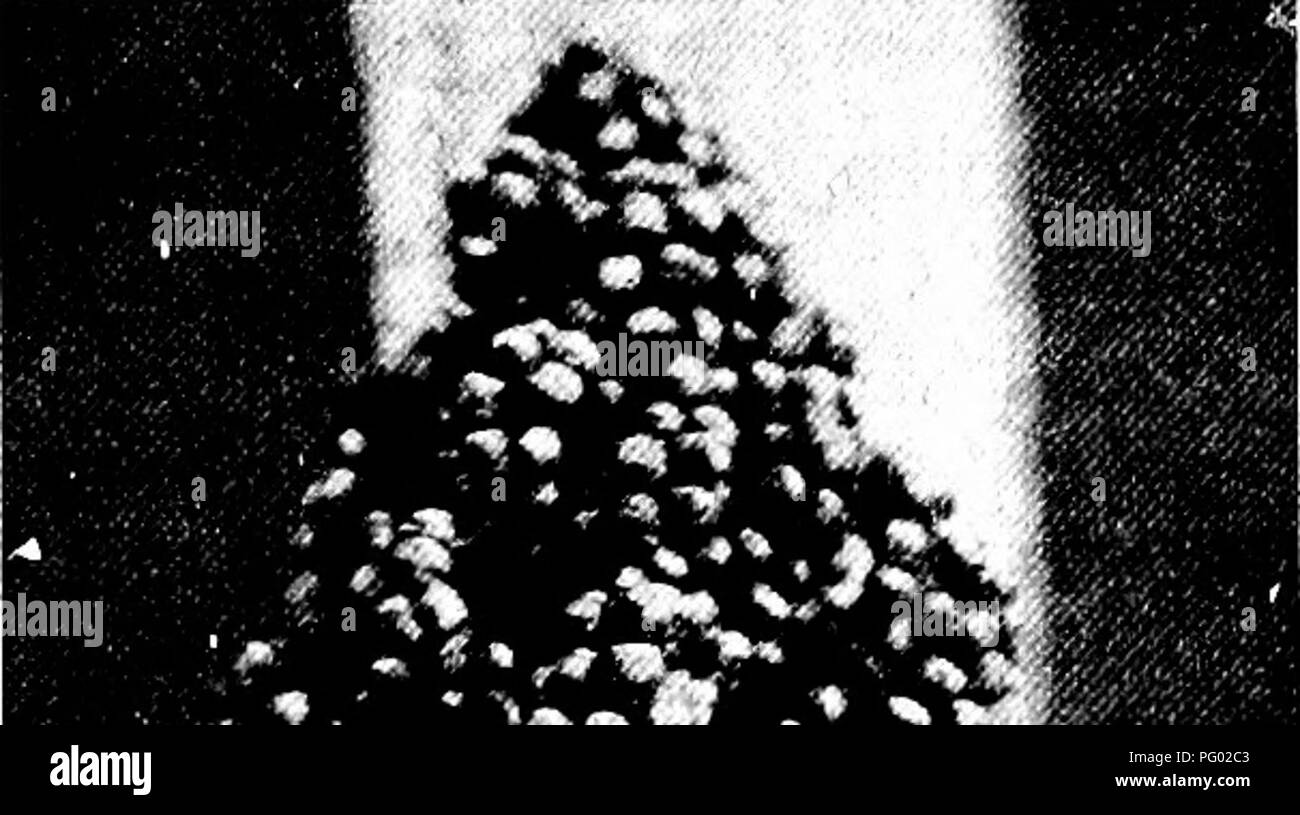 . The corn crops: a discussion of maize, kafirs, and sorghums as grown in the United States and Canada. Corn; Kafir corn; Sorghum. THE NON-SACCHARINE SORGHUMS 313. â â %»$*'ji«^ wide range of conditions, and this plant, together with Blackhull Kafir, is the best of the sorghums for grain production. The milos, being about three weeks earher in maturing than the kafirs, have two distinct advan- tages : in Oklahoma and Texas they can be planted early and will more nearly ma- ture before the severe midsummer drought; also, they may be grown farther north and at higher alti- tudes. 240. Shallu.â Stock Photohttps://www.alamy.com/image-license-details/?v=1https://www.alamy.com/the-corn-crops-a-discussion-of-maize-kafirs-and-sorghums-as-grown-in-the-united-states-and-canada-corn-kafir-corn-sorghum-the-non-saccharine-sorghums-313-ji-wide-range-of-conditions-and-this-plant-together-with-blackhull-kafir-is-the-best-of-the-sorghums-for-grain-production-the-milos-being-about-three-weeks-earher-in-maturing-than-the-kafirs-have-two-distinct-advan-tages-in-oklahoma-and-texas-they-can-be-planted-early-and-will-more-nearly-ma-ture-before-the-severe-midsummer-drought-also-they-may-be-grown-farther-north-and-at-higher-alti-tudes-240-shallu-image216360819.html
. The corn crops: a discussion of maize, kafirs, and sorghums as grown in the United States and Canada. Corn; Kafir corn; Sorghum. THE NON-SACCHARINE SORGHUMS 313. â â %»$*'ji«^ wide range of conditions, and this plant, together with Blackhull Kafir, is the best of the sorghums for grain production. The milos, being about three weeks earher in maturing than the kafirs, have two distinct advan- tages : in Oklahoma and Texas they can be planted early and will more nearly ma- ture before the severe midsummer drought; also, they may be grown farther north and at higher alti- tudes. 240. Shallu.â Stock Photohttps://www.alamy.com/image-license-details/?v=1https://www.alamy.com/the-corn-crops-a-discussion-of-maize-kafirs-and-sorghums-as-grown-in-the-united-states-and-canada-corn-kafir-corn-sorghum-the-non-saccharine-sorghums-313-ji-wide-range-of-conditions-and-this-plant-together-with-blackhull-kafir-is-the-best-of-the-sorghums-for-grain-production-the-milos-being-about-three-weeks-earher-in-maturing-than-the-kafirs-have-two-distinct-advan-tages-in-oklahoma-and-texas-they-can-be-planted-early-and-will-more-nearly-ma-ture-before-the-severe-midsummer-drought-also-they-may-be-grown-farther-north-and-at-higher-alti-tudes-240-shallu-image216360819.htmlRMPG02C3–. The corn crops: a discussion of maize, kafirs, and sorghums as grown in the United States and Canada. Corn; Kafir corn; Sorghum. THE NON-SACCHARINE SORGHUMS 313. â â %»$*'ji«^ wide range of conditions, and this plant, together with Blackhull Kafir, is the best of the sorghums for grain production. The milos, being about three weeks earher in maturing than the kafirs, have two distinct advan- tages : in Oklahoma and Texas they can be planted early and will more nearly ma- ture before the severe midsummer drought; also, they may be grown farther north and at higher alti- tudes. 240. Shallu.â
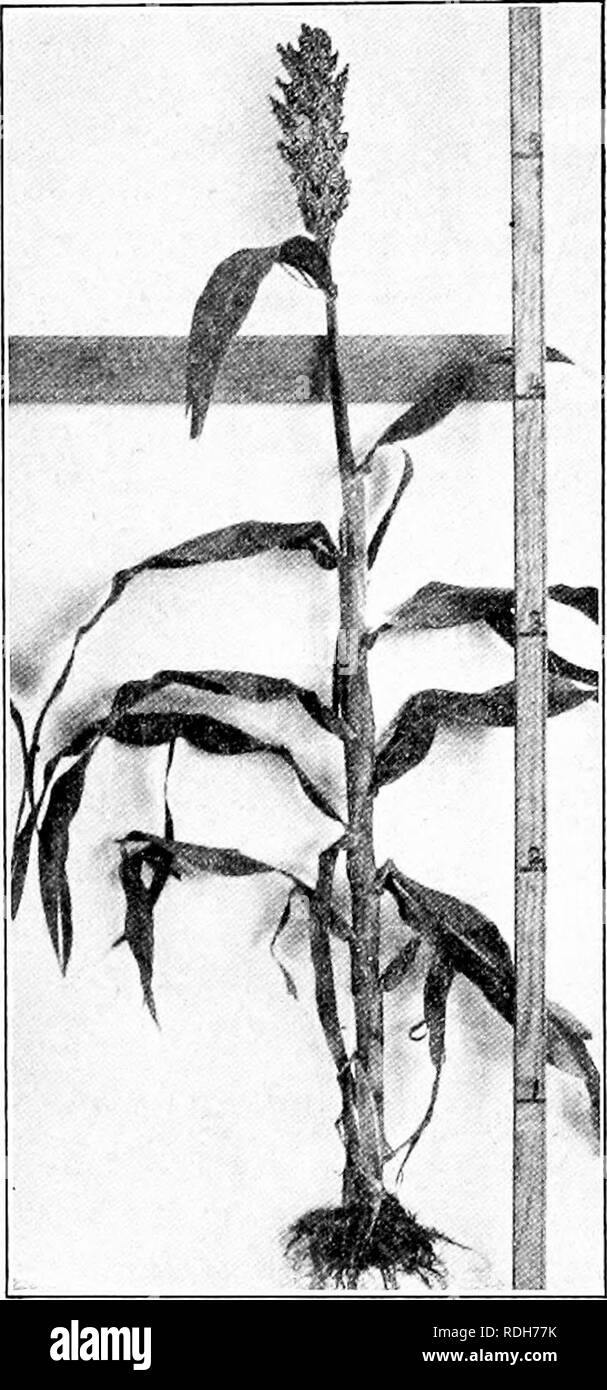 . The corn crops: a discussion of maize, kafirs, and sorghums as grown in the United States and Canada. Corn; Kafir corn; Sorghum. 310 CORN CROPS be a later introduction, having attracted attention about 1896. It had all the good qualities of Red Kafir, and in addition the seed was not astringent. This variety probably furnishes nine- tenths of the kafir crop to-day, and Red Kafir the other tenth. 238. Durra.—The char- acteristics of this group are that the heads are mostly " goosenecked " and the seeds are large and flat. The extensive cultiu'e of non-saccharine sorghums in this cou Stock Photohttps://www.alamy.com/image-license-details/?v=1https://www.alamy.com/the-corn-crops-a-discussion-of-maize-kafirs-and-sorghums-as-grown-in-the-united-states-and-canada-corn-kafir-corn-sorghum-310-corn-crops-be-a-later-introduction-having-attracted-attention-about-1896-it-had-all-the-good-qualities-of-red-kafir-and-in-addition-the-seed-was-not-astringent-this-variety-probably-furnishes-nine-tenths-of-the-kafir-crop-to-day-and-red-kafir-the-other-tenth-238-durrathe-char-acteristics-of-this-group-are-that-the-heads-are-mostly-quot-goosenecked-quot-and-the-seeds-are-large-and-flat-the-extensive-cultiue-of-non-saccharine-sorghums-in-this-cou-image232104199.html
. The corn crops: a discussion of maize, kafirs, and sorghums as grown in the United States and Canada. Corn; Kafir corn; Sorghum. 310 CORN CROPS be a later introduction, having attracted attention about 1896. It had all the good qualities of Red Kafir, and in addition the seed was not astringent. This variety probably furnishes nine- tenths of the kafir crop to-day, and Red Kafir the other tenth. 238. Durra.—The char- acteristics of this group are that the heads are mostly " goosenecked " and the seeds are large and flat. The extensive cultiu'e of non-saccharine sorghums in this cou Stock Photohttps://www.alamy.com/image-license-details/?v=1https://www.alamy.com/the-corn-crops-a-discussion-of-maize-kafirs-and-sorghums-as-grown-in-the-united-states-and-canada-corn-kafir-corn-sorghum-310-corn-crops-be-a-later-introduction-having-attracted-attention-about-1896-it-had-all-the-good-qualities-of-red-kafir-and-in-addition-the-seed-was-not-astringent-this-variety-probably-furnishes-nine-tenths-of-the-kafir-crop-to-day-and-red-kafir-the-other-tenth-238-durrathe-char-acteristics-of-this-group-are-that-the-heads-are-mostly-quot-goosenecked-quot-and-the-seeds-are-large-and-flat-the-extensive-cultiue-of-non-saccharine-sorghums-in-this-cou-image232104199.htmlRMRDH77K–. The corn crops: a discussion of maize, kafirs, and sorghums as grown in the United States and Canada. Corn; Kafir corn; Sorghum. 310 CORN CROPS be a later introduction, having attracted attention about 1896. It had all the good qualities of Red Kafir, and in addition the seed was not astringent. This variety probably furnishes nine- tenths of the kafir crop to-day, and Red Kafir the other tenth. 238. Durra.—The char- acteristics of this group are that the heads are mostly " goosenecked " and the seeds are large and flat. The extensive cultiu'e of non-saccharine sorghums in this cou
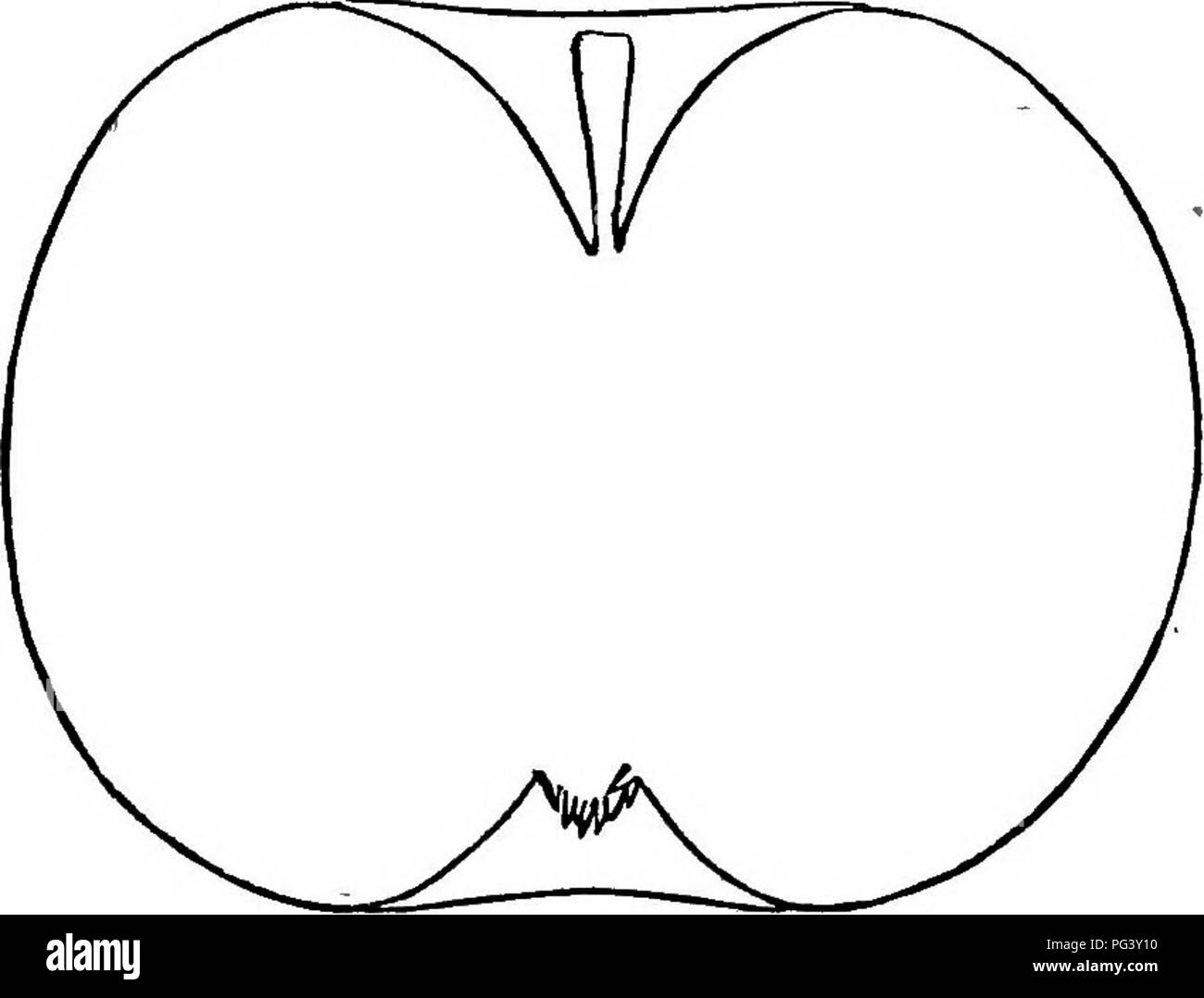 . The fruits and fruit trees of America : or, The culture, propagation and management, in the garden and orchard, of fruit trees generally, with descriptions of all the finest varieties of fruit, native and foreign, cultivated in this country . Fruit-culture; Fruit. APPLES. 77 Evening Party, Origin Berks Co, Pa. Fruit small or medium, oblate, sligt tly ipclining to oval. Skin yellow chiefly, shaded and sometimes. mg Pa/iiy. stripped with red. Stem short, inserted in a round, deep cavity, sometimes russeted. Calyx closed, basin large. Flesh juicy, tender, crisp, with a brisk saccharine, somewha Stock Photohttps://www.alamy.com/image-license-details/?v=1https://www.alamy.com/the-fruits-and-fruit-trees-of-america-or-the-culture-propagation-and-management-in-the-garden-and-orchard-of-fruit-trees-generally-with-descriptions-of-all-the-finest-varieties-of-fruit-native-and-foreign-cultivated-in-this-country-fruit-culture-fruit-apples-77-evening-party-origin-berks-co-pa-fruit-small-or-medium-oblate-sligt-tly-ipclining-to-oval-skin-yellow-chiefly-shaded-and-sometimes-mg-paiiy-stripped-with-red-stem-short-inserted-in-a-round-deep-cavity-sometimes-russeted-calyx-closed-basin-large-flesh-juicy-tender-crisp-with-a-brisk-saccharine-somewha-image216445964.html
. The fruits and fruit trees of America : or, The culture, propagation and management, in the garden and orchard, of fruit trees generally, with descriptions of all the finest varieties of fruit, native and foreign, cultivated in this country . Fruit-culture; Fruit. APPLES. 77 Evening Party, Origin Berks Co, Pa. Fruit small or medium, oblate, sligt tly ipclining to oval. Skin yellow chiefly, shaded and sometimes. mg Pa/iiy. stripped with red. Stem short, inserted in a round, deep cavity, sometimes russeted. Calyx closed, basin large. Flesh juicy, tender, crisp, with a brisk saccharine, somewha Stock Photohttps://www.alamy.com/image-license-details/?v=1https://www.alamy.com/the-fruits-and-fruit-trees-of-america-or-the-culture-propagation-and-management-in-the-garden-and-orchard-of-fruit-trees-generally-with-descriptions-of-all-the-finest-varieties-of-fruit-native-and-foreign-cultivated-in-this-country-fruit-culture-fruit-apples-77-evening-party-origin-berks-co-pa-fruit-small-or-medium-oblate-sligt-tly-ipclining-to-oval-skin-yellow-chiefly-shaded-and-sometimes-mg-paiiy-stripped-with-red-stem-short-inserted-in-a-round-deep-cavity-sometimes-russeted-calyx-closed-basin-large-flesh-juicy-tender-crisp-with-a-brisk-saccharine-somewha-image216445964.htmlRMPG3Y10–. The fruits and fruit trees of America : or, The culture, propagation and management, in the garden and orchard, of fruit trees generally, with descriptions of all the finest varieties of fruit, native and foreign, cultivated in this country . Fruit-culture; Fruit. APPLES. 77 Evening Party, Origin Berks Co, Pa. Fruit small or medium, oblate, sligt tly ipclining to oval. Skin yellow chiefly, shaded and sometimes. mg Pa/iiy. stripped with red. Stem short, inserted in a round, deep cavity, sometimes russeted. Calyx closed, basin large. Flesh juicy, tender, crisp, with a brisk saccharine, somewha
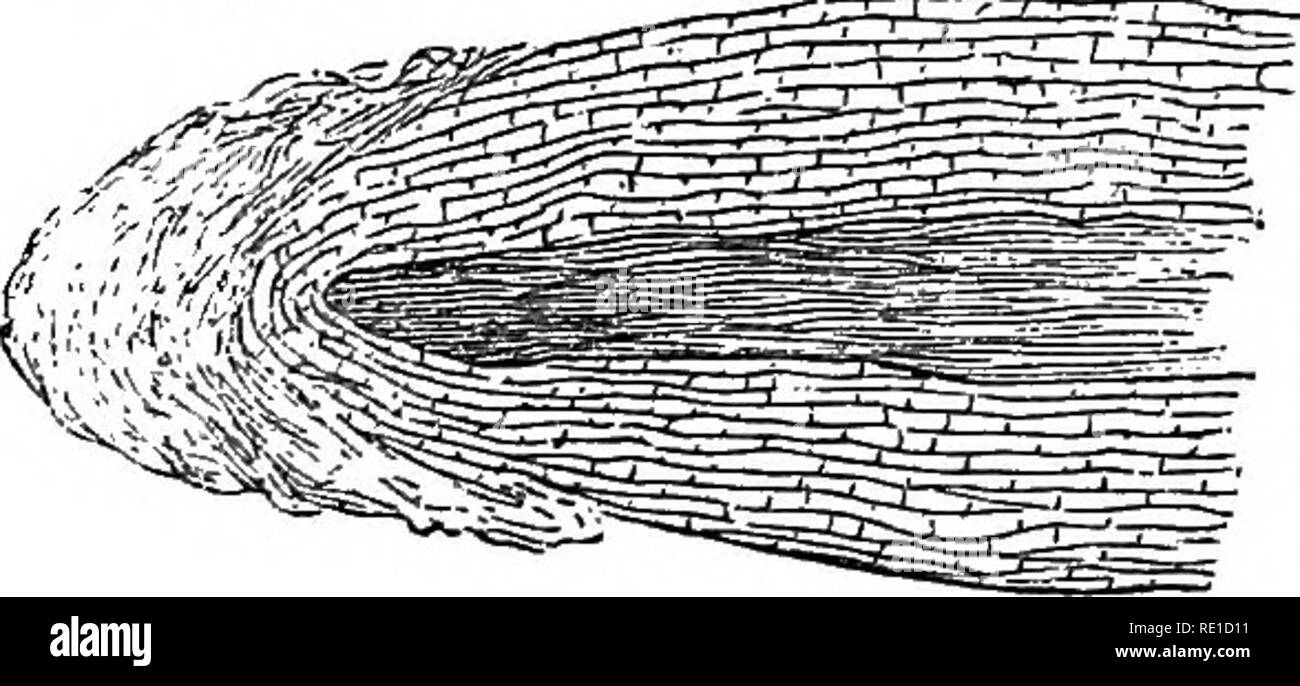 . The American fruit culturist : containing directions for the propagation and culture of fruit trees in the nursery, orchid and garden : with descriptions of the principal American and foreign varieties cultivated in the United States . Fruit-culture. PROPAGATION. 31 the spongioles, or minute spongy extremities of the fibrous roots,* at which time it consists merely of water, with minute portions of other substances in solution. It passes up through the alburnum or sap-wood, dissolving mucilage in its pro- gress ; it becomes further charged in a very slight degree, and acquires a saccharine c Stock Photohttps://www.alamy.com/image-license-details/?v=1https://www.alamy.com/the-american-fruit-culturist-containing-directions-for-the-propagation-and-culture-of-fruit-trees-in-the-nursery-orchid-and-garden-with-descriptions-of-the-principal-american-and-foreign-varieties-cultivated-in-the-united-states-fruit-culture-propagation-31-the-spongioles-or-minute-spongy-extremities-of-the-fibrous-roots-at-which-time-it-consists-merely-of-water-with-minute-portions-of-other-substances-in-solution-it-passes-up-through-the-alburnum-or-sap-wood-dissolving-mucilage-in-its-pro-gress-it-becomes-further-charged-in-a-very-slight-degree-and-acquires-a-saccharine-c-image232372141.html
. The American fruit culturist : containing directions for the propagation and culture of fruit trees in the nursery, orchid and garden : with descriptions of the principal American and foreign varieties cultivated in the United States . Fruit-culture. PROPAGATION. 31 the spongioles, or minute spongy extremities of the fibrous roots,* at which time it consists merely of water, with minute portions of other substances in solution. It passes up through the alburnum or sap-wood, dissolving mucilage in its pro- gress ; it becomes further charged in a very slight degree, and acquires a saccharine c Stock Photohttps://www.alamy.com/image-license-details/?v=1https://www.alamy.com/the-american-fruit-culturist-containing-directions-for-the-propagation-and-culture-of-fruit-trees-in-the-nursery-orchid-and-garden-with-descriptions-of-the-principal-american-and-foreign-varieties-cultivated-in-the-united-states-fruit-culture-propagation-31-the-spongioles-or-minute-spongy-extremities-of-the-fibrous-roots-at-which-time-it-consists-merely-of-water-with-minute-portions-of-other-substances-in-solution-it-passes-up-through-the-alburnum-or-sap-wood-dissolving-mucilage-in-its-pro-gress-it-becomes-further-charged-in-a-very-slight-degree-and-acquires-a-saccharine-c-image232372141.htmlRMRE1D11–. The American fruit culturist : containing directions for the propagation and culture of fruit trees in the nursery, orchid and garden : with descriptions of the principal American and foreign varieties cultivated in the United States . Fruit-culture. PROPAGATION. 31 the spongioles, or minute spongy extremities of the fibrous roots,* at which time it consists merely of water, with minute portions of other substances in solution. It passes up through the alburnum or sap-wood, dissolving mucilage in its pro- gress ; it becomes further charged in a very slight degree, and acquires a saccharine c
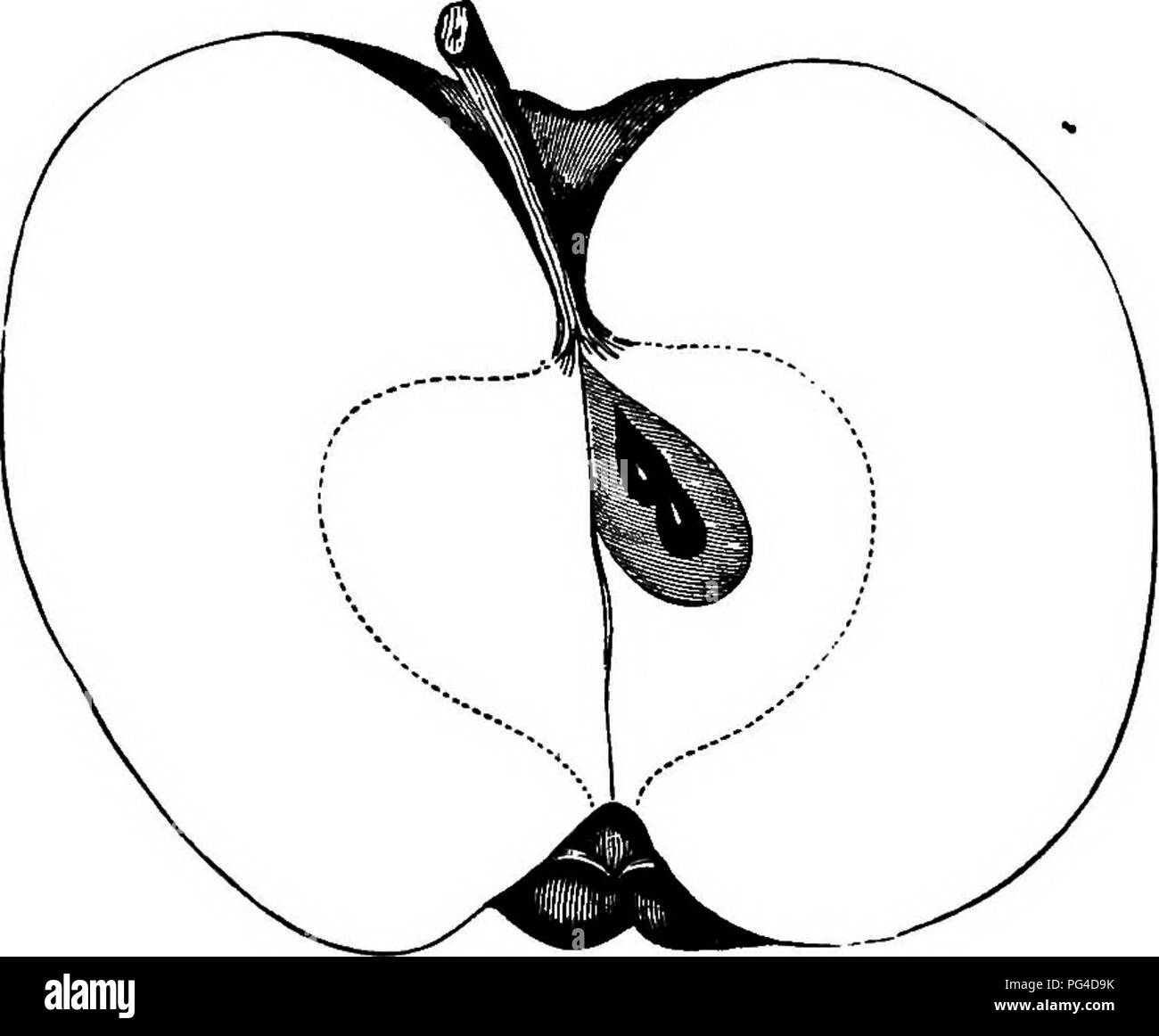 . American pomology : apples . Apples. 474 DESCBIPnONS OF APPLES. mostly shaded with crimson, sprinkled with gray or green- ish dots; Stalk short, inserted into a large cavity surround- ed by russet; Calyx open, set in a deep, irregular basin; Flesh rich, pleasant, vinous, almost saccharine." — [Downing. Spice Siireeting. The specimens described were from Mr. Warren, of Massachusetts. Others, found in Ohio and Bliaois under this name, have a deep, abrupt basin, large or long eye, and yellow flesh; they must be different fruits. An old variety; Tree vigorous, productive. Fruit full medium Stock Photohttps://www.alamy.com/image-license-details/?v=1https://www.alamy.com/american-pomology-apples-apples-474-descbipnons-of-apples-mostly-shaded-with-crimson-sprinkled-with-gray-or-green-ish-dots-stalk-short-inserted-into-a-large-cavity-surround-ed-by-russet-calyx-open-set-in-a-deep-irregular-basin-flesh-rich-pleasant-vinous-almost-saccharinequot-downing-spice-siireeting-the-specimens-described-were-from-mr-warren-of-massachusetts-others-found-in-ohio-and-bliaois-under-this-name-have-a-deep-abrupt-basin-large-or-long-eye-and-yellow-flesh-they-must-be-different-fruits-an-old-variety-tree-vigorous-productive-fruit-full-medium-image216457183.html
. American pomology : apples . Apples. 474 DESCBIPnONS OF APPLES. mostly shaded with crimson, sprinkled with gray or green- ish dots; Stalk short, inserted into a large cavity surround- ed by russet; Calyx open, set in a deep, irregular basin; Flesh rich, pleasant, vinous, almost saccharine." — [Downing. Spice Siireeting. The specimens described were from Mr. Warren, of Massachusetts. Others, found in Ohio and Bliaois under this name, have a deep, abrupt basin, large or long eye, and yellow flesh; they must be different fruits. An old variety; Tree vigorous, productive. Fruit full medium Stock Photohttps://www.alamy.com/image-license-details/?v=1https://www.alamy.com/american-pomology-apples-apples-474-descbipnons-of-apples-mostly-shaded-with-crimson-sprinkled-with-gray-or-green-ish-dots-stalk-short-inserted-into-a-large-cavity-surround-ed-by-russet-calyx-open-set-in-a-deep-irregular-basin-flesh-rich-pleasant-vinous-almost-saccharinequot-downing-spice-siireeting-the-specimens-described-were-from-mr-warren-of-massachusetts-others-found-in-ohio-and-bliaois-under-this-name-have-a-deep-abrupt-basin-large-or-long-eye-and-yellow-flesh-they-must-be-different-fruits-an-old-variety-tree-vigorous-productive-fruit-full-medium-image216457183.htmlRMPG4D9K–. American pomology : apples . Apples. 474 DESCBIPnONS OF APPLES. mostly shaded with crimson, sprinkled with gray or green- ish dots; Stalk short, inserted into a large cavity surround- ed by russet; Calyx open, set in a deep, irregular basin; Flesh rich, pleasant, vinous, almost saccharine." — [Downing. Spice Siireeting. The specimens described were from Mr. Warren, of Massachusetts. Others, found in Ohio and Bliaois under this name, have a deep, abrupt basin, large or long eye, and yellow flesh; they must be different fruits. An old variety; Tree vigorous, productive. Fruit full medium
 . Field crops for the cotton-belt. Agriculture. THE SACCHARINE SORGHUMS 383 compactness, and present an orange tinge due to the par- tially exserted orange colored seeds. It matures in about the same length of time as Sumac sorghum. Orange sor- ghum is an excellent va- riety for sirup production, and being rather leafy, is also a good variety for forage. 472. Amber sorghum is probably the most largely grown variety of sweet sorghum in the United States. It is very early, maturing usually in less than 100 days, and for this reason - has practically crowded all other varieties out of the section Stock Photohttps://www.alamy.com/image-license-details/?v=1https://www.alamy.com/field-crops-for-the-cotton-belt-agriculture-the-saccharine-sorghums-383-compactness-and-present-an-orange-tinge-due-to-the-par-tially-exserted-orange-colored-seeds-it-matures-in-about-the-same-length-of-time-as-sumac-sorghum-orange-sor-ghum-is-an-excellent-va-riety-for-sirup-production-and-being-rather-leafy-is-also-a-good-variety-for-forage-472-amber-sorghum-is-probably-the-most-largely-grown-variety-of-sweet-sorghum-in-the-united-states-it-is-very-early-maturing-usually-in-less-than-100-days-and-for-this-reason-has-practically-crowded-all-other-varieties-out-of-the-section-image232061635.html
. Field crops for the cotton-belt. Agriculture. THE SACCHARINE SORGHUMS 383 compactness, and present an orange tinge due to the par- tially exserted orange colored seeds. It matures in about the same length of time as Sumac sorghum. Orange sor- ghum is an excellent va- riety for sirup production, and being rather leafy, is also a good variety for forage. 472. Amber sorghum is probably the most largely grown variety of sweet sorghum in the United States. It is very early, maturing usually in less than 100 days, and for this reason - has practically crowded all other varieties out of the section Stock Photohttps://www.alamy.com/image-license-details/?v=1https://www.alamy.com/field-crops-for-the-cotton-belt-agriculture-the-saccharine-sorghums-383-compactness-and-present-an-orange-tinge-due-to-the-par-tially-exserted-orange-colored-seeds-it-matures-in-about-the-same-length-of-time-as-sumac-sorghum-orange-sor-ghum-is-an-excellent-va-riety-for-sirup-production-and-being-rather-leafy-is-also-a-good-variety-for-forage-472-amber-sorghum-is-probably-the-most-largely-grown-variety-of-sweet-sorghum-in-the-united-states-it-is-very-early-maturing-usually-in-less-than-100-days-and-for-this-reason-has-practically-crowded-all-other-varieties-out-of-the-section-image232061635.htmlRMRDF8YF–. Field crops for the cotton-belt. Agriculture. THE SACCHARINE SORGHUMS 383 compactness, and present an orange tinge due to the par- tially exserted orange colored seeds. It matures in about the same length of time as Sumac sorghum. Orange sor- ghum is an excellent va- riety for sirup production, and being rather leafy, is also a good variety for forage. 472. Amber sorghum is probably the most largely grown variety of sweet sorghum in the United States. It is very early, maturing usually in less than 100 days, and for this reason - has practically crowded all other varieties out of the section
 . The corn crops: a discussion of maize, kafirs, and sorghums as grown in the United States and Canada. Corn; Kafir corn; Sorghum. THE SACCHARINE SORGHUMS 295 ' V; .1 ".â A ⢠1 â «., s t ^ ;⢠r 1?' ⢠SORGh lH THOUi/INOS i SIRUP Fig. 97. â Production of sorghum sirup middle of last century.. SAUCNS Fig. 98. â Production of sirup at close of century.. Please note that these images are extracted from scanned page images that may have been digitally enhanced for readability - coloration and appearance of these illustrations may not perfectly resemble the original work.. Montgomery, Edwar Stock Photohttps://www.alamy.com/image-license-details/?v=1https://www.alamy.com/the-corn-crops-a-discussion-of-maize-kafirs-and-sorghums-as-grown-in-the-united-states-and-canada-corn-kafir-corn-sorghum-the-saccharine-sorghums-295-v-1-quot-a-1-s-t-r-1-sorgh-lh-thouiinos-i-sirup-fig-97-production-of-sorghum-sirup-middle-of-last-century-saucns-fig-98-production-of-sirup-at-close-of-century-please-note-that-these-images-are-extracted-from-scanned-page-images-that-may-have-been-digitally-enhanced-for-readability-coloration-and-appearance-of-these-illustrations-may-not-perfectly-resemble-the-original-work-montgomery-edwar-image216360858.html
. The corn crops: a discussion of maize, kafirs, and sorghums as grown in the United States and Canada. Corn; Kafir corn; Sorghum. THE SACCHARINE SORGHUMS 295 ' V; .1 ".â A ⢠1 â «., s t ^ ;⢠r 1?' ⢠SORGh lH THOUi/INOS i SIRUP Fig. 97. â Production of sorghum sirup middle of last century.. SAUCNS Fig. 98. â Production of sirup at close of century.. Please note that these images are extracted from scanned page images that may have been digitally enhanced for readability - coloration and appearance of these illustrations may not perfectly resemble the original work.. Montgomery, Edwar Stock Photohttps://www.alamy.com/image-license-details/?v=1https://www.alamy.com/the-corn-crops-a-discussion-of-maize-kafirs-and-sorghums-as-grown-in-the-united-states-and-canada-corn-kafir-corn-sorghum-the-saccharine-sorghums-295-v-1-quot-a-1-s-t-r-1-sorgh-lh-thouiinos-i-sirup-fig-97-production-of-sorghum-sirup-middle-of-last-century-saucns-fig-98-production-of-sirup-at-close-of-century-please-note-that-these-images-are-extracted-from-scanned-page-images-that-may-have-been-digitally-enhanced-for-readability-coloration-and-appearance-of-these-illustrations-may-not-perfectly-resemble-the-original-work-montgomery-edwar-image216360858.htmlRMPG02DE–. The corn crops: a discussion of maize, kafirs, and sorghums as grown in the United States and Canada. Corn; Kafir corn; Sorghum. THE SACCHARINE SORGHUMS 295 ' V; .1 ".â A ⢠1 â «., s t ^ ;⢠r 1?' ⢠SORGh lH THOUi/INOS i SIRUP Fig. 97. â Production of sorghum sirup middle of last century.. SAUCNS Fig. 98. â Production of sirup at close of century.. Please note that these images are extracted from scanned page images that may have been digitally enhanced for readability - coloration and appearance of these illustrations may not perfectly resemble the original work.. Montgomery, Edwar
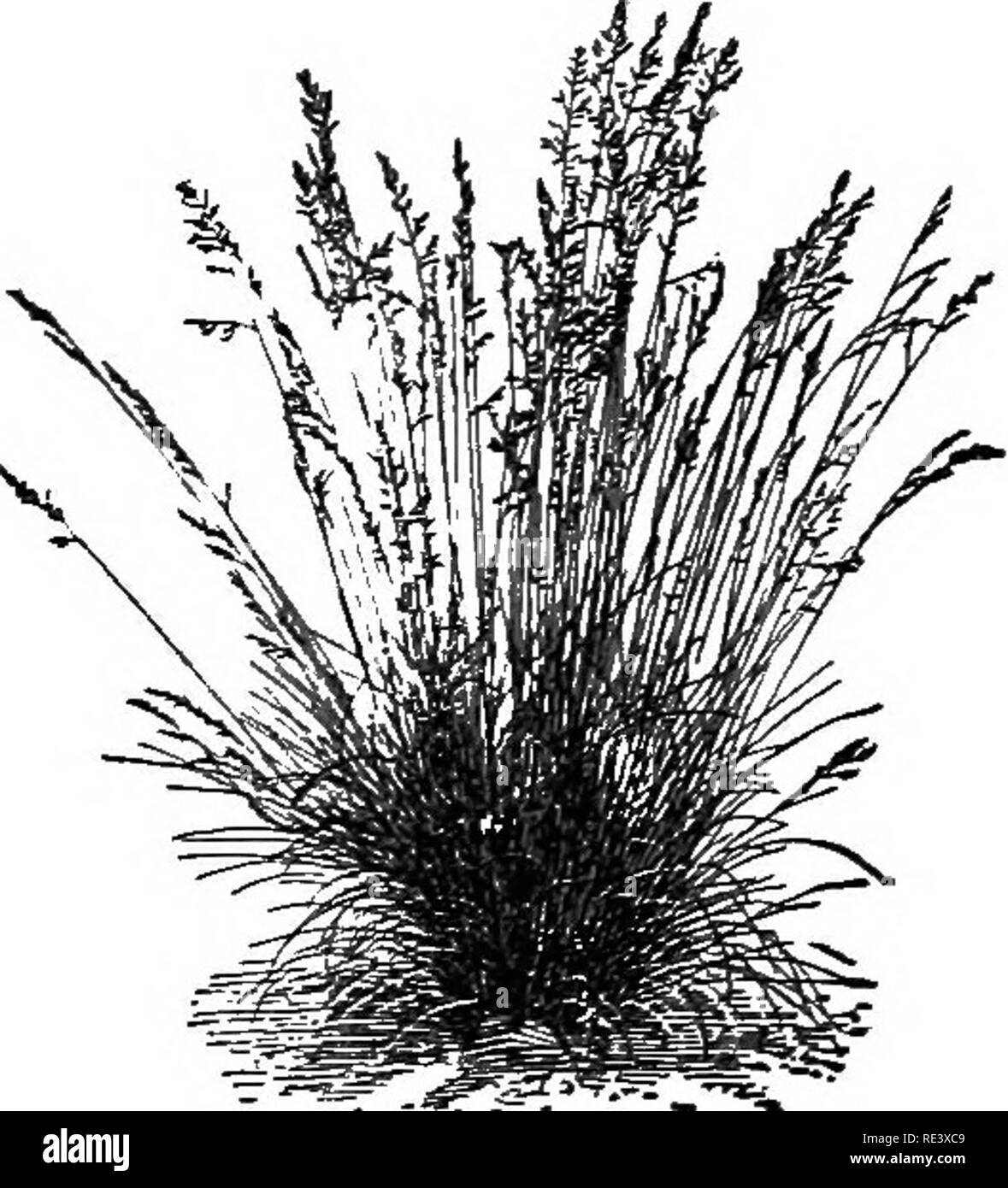 . Farm crops; a practical treatise on the growing of American field crops: containing brief and popular advice on the seeding, cultivating, handling and marketing of farm crops, and on the management of lands for the largest returns. Agriculture. SORGHUM 215 is used in the production of molasses and sugar and as a forage plant. Some varieties of sorghum contain more sugar properties than others. They fall into two classes—the saccharine and the non- saccharine varieties. This plant will grow any- where that Indian corn will grow and will do very well on poor soils and in the drouth regions. Wh Stock Photohttps://www.alamy.com/image-license-details/?v=1https://www.alamy.com/farm-crops-a-practical-treatise-on-the-growing-of-american-field-crops-containing-brief-and-popular-advice-on-the-seeding-cultivating-handling-and-marketing-of-farm-crops-and-on-the-management-of-lands-for-the-largest-returns-agriculture-sorghum-215-is-used-in-the-production-of-molasses-and-sugar-and-as-a-forage-plant-some-varieties-of-sorghum-contain-more-sugar-properties-than-others-they-fall-into-two-classesthe-saccharine-and-the-non-saccharine-varieties-this-plant-will-grow-any-where-that-indian-corn-will-grow-and-will-do-very-well-on-poor-soils-and-in-the-drouth-regions-wh-image232426553.html
. Farm crops; a practical treatise on the growing of American field crops: containing brief and popular advice on the seeding, cultivating, handling and marketing of farm crops, and on the management of lands for the largest returns. Agriculture. SORGHUM 215 is used in the production of molasses and sugar and as a forage plant. Some varieties of sorghum contain more sugar properties than others. They fall into two classes—the saccharine and the non- saccharine varieties. This plant will grow any- where that Indian corn will grow and will do very well on poor soils and in the drouth regions. Wh Stock Photohttps://www.alamy.com/image-license-details/?v=1https://www.alamy.com/farm-crops-a-practical-treatise-on-the-growing-of-american-field-crops-containing-brief-and-popular-advice-on-the-seeding-cultivating-handling-and-marketing-of-farm-crops-and-on-the-management-of-lands-for-the-largest-returns-agriculture-sorghum-215-is-used-in-the-production-of-molasses-and-sugar-and-as-a-forage-plant-some-varieties-of-sorghum-contain-more-sugar-properties-than-others-they-fall-into-two-classesthe-saccharine-and-the-non-saccharine-varieties-this-plant-will-grow-any-where-that-indian-corn-will-grow-and-will-do-very-well-on-poor-soils-and-in-the-drouth-regions-wh-image232426553.htmlRMRE3XC9–. Farm crops; a practical treatise on the growing of American field crops: containing brief and popular advice on the seeding, cultivating, handling and marketing of farm crops, and on the management of lands for the largest returns. Agriculture. SORGHUM 215 is used in the production of molasses and sugar and as a forage plant. Some varieties of sorghum contain more sugar properties than others. They fall into two classes—the saccharine and the non- saccharine varieties. This plant will grow any- where that Indian corn will grow and will do very well on poor soils and in the drouth regions. Wh
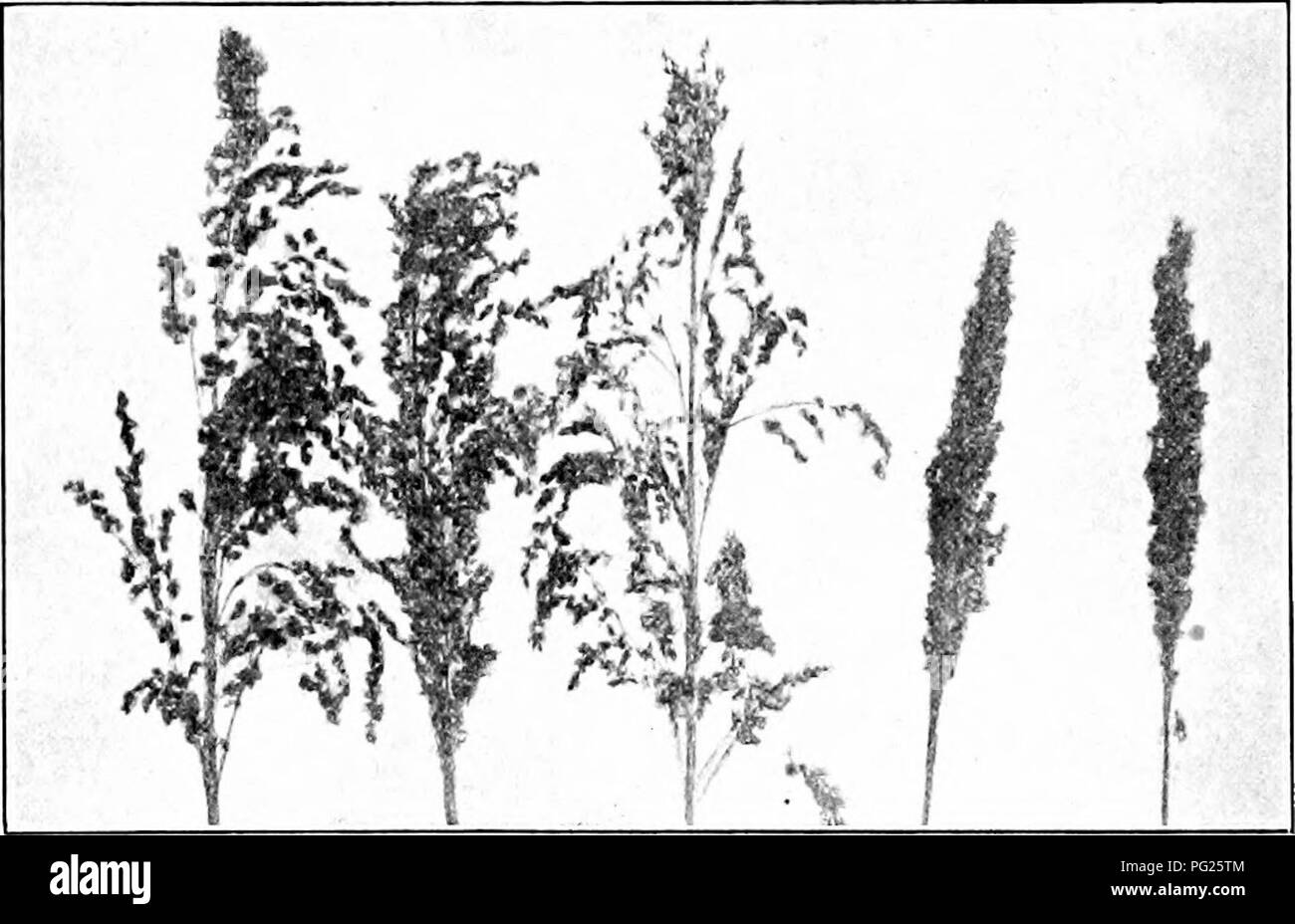 This agricultural work focuses on the cultivation and uses of southern field crops, with particular emphasis on sweet sorghum, a plant used for syrup production and as forage for livestock. Stock Photohttps://www.alamy.com/image-license-details/?v=1https://www.alamy.com/this-agricultural-work-focuses-on-the-cultivation-and-uses-of-southern-field-crops-with-particular-emphasis-on-sweet-sorghum-a-plant-used-for-syrup-production-and-as-forage-for-livestock-image216407428.html
This agricultural work focuses on the cultivation and uses of southern field crops, with particular emphasis on sweet sorghum, a plant used for syrup production and as forage for livestock. Stock Photohttps://www.alamy.com/image-license-details/?v=1https://www.alamy.com/this-agricultural-work-focuses-on-the-cultivation-and-uses-of-southern-field-crops-with-particular-emphasis-on-sweet-sorghum-a-plant-used-for-syrup-production-and-as-forage-for-livestock-image216407428.htmlRMPG25TM–This agricultural work focuses on the cultivation and uses of southern field crops, with particular emphasis on sweet sorghum, a plant used for syrup production and as forage for livestock.
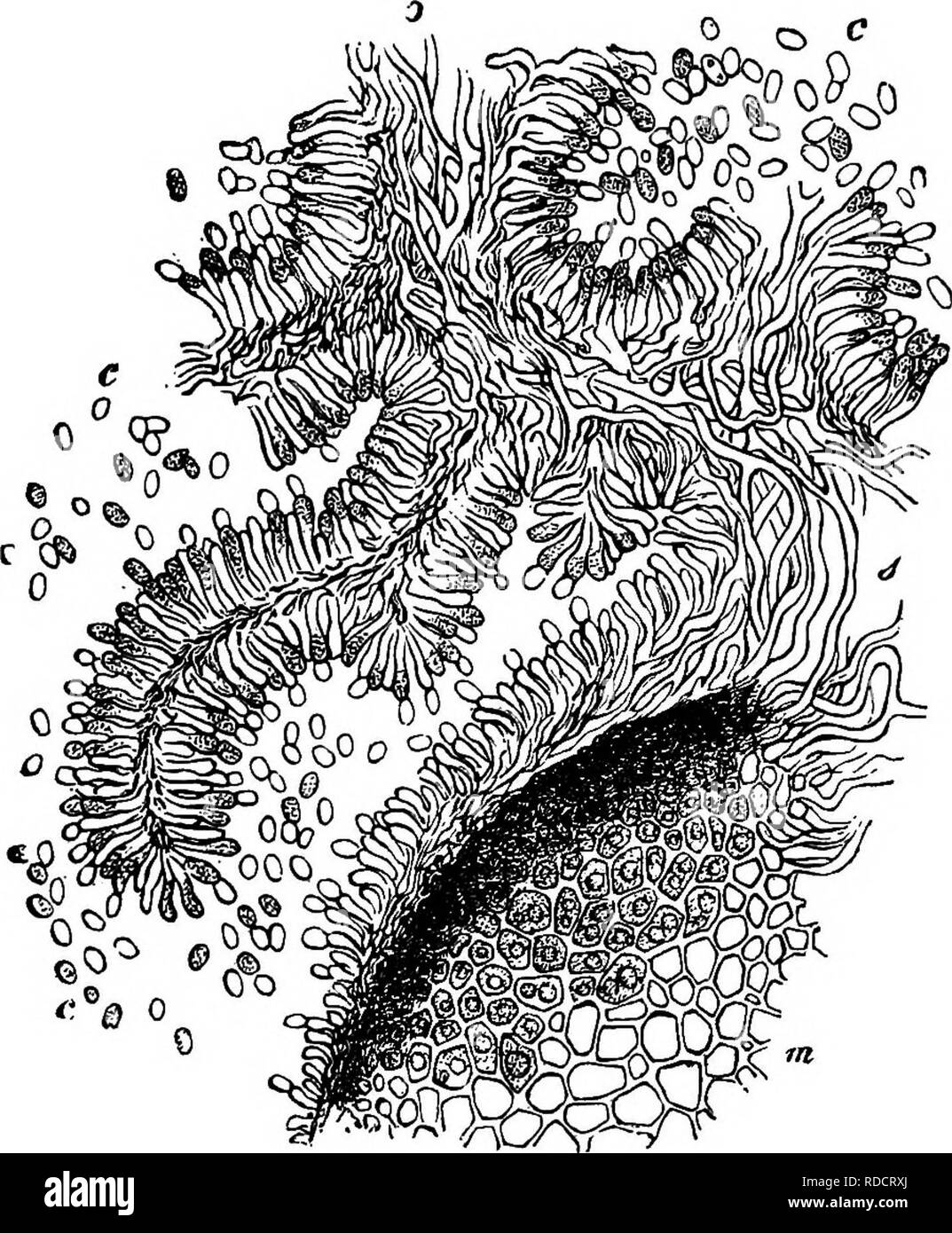 . Comparative morphology and biology of the fungi, mycetozoa and bacteria . Plant morphology; Fungi; Myxomycetes; Bacteriology. izS DIVISION II.—COURSE OF DEVELOPMENT OF FUNGI. the hymenium the well-known saccharine fluid is secreted, which oozes out from between the paleae in thick drops rendered turbid by count- less gonidia, and thus betrays the presence of the parasite. This juice is eagerly sought by in- sects, which thus carry away the gonidia. Soon the formation of the scle- rotium begins in the basal portion of the gonidia- forming body in the way already described. The sclerotium reac Stock Photohttps://www.alamy.com/image-license-details/?v=1https://www.alamy.com/comparative-morphology-and-biology-of-the-fungi-mycetozoa-and-bacteria-plant-morphology-fungi-myxomycetes-bacteriology-izs-division-iicourse-of-development-of-fungi-the-hymenium-the-well-known-saccharine-fluid-is-secreted-which-oozes-out-from-between-the-paleae-in-thick-drops-rendered-turbid-by-count-less-gonidia-and-thus-betrays-the-presence-of-the-parasite-this-juice-is-eagerly-sought-by-in-sects-which-thus-carry-away-the-gonidia-soon-the-formation-of-the-scle-rotium-begins-in-the-basal-portion-of-the-gonidia-forming-body-in-the-way-already-described-the-sclerotium-reac-image232007514.html
. Comparative morphology and biology of the fungi, mycetozoa and bacteria . Plant morphology; Fungi; Myxomycetes; Bacteriology. izS DIVISION II.—COURSE OF DEVELOPMENT OF FUNGI. the hymenium the well-known saccharine fluid is secreted, which oozes out from between the paleae in thick drops rendered turbid by count- less gonidia, and thus betrays the presence of the parasite. This juice is eagerly sought by in- sects, which thus carry away the gonidia. Soon the formation of the scle- rotium begins in the basal portion of the gonidia- forming body in the way already described. The sclerotium reac Stock Photohttps://www.alamy.com/image-license-details/?v=1https://www.alamy.com/comparative-morphology-and-biology-of-the-fungi-mycetozoa-and-bacteria-plant-morphology-fungi-myxomycetes-bacteriology-izs-division-iicourse-of-development-of-fungi-the-hymenium-the-well-known-saccharine-fluid-is-secreted-which-oozes-out-from-between-the-paleae-in-thick-drops-rendered-turbid-by-count-less-gonidia-and-thus-betrays-the-presence-of-the-parasite-this-juice-is-eagerly-sought-by-in-sects-which-thus-carry-away-the-gonidia-soon-the-formation-of-the-scle-rotium-begins-in-the-basal-portion-of-the-gonidia-forming-body-in-the-way-already-described-the-sclerotium-reac-image232007514.htmlRMRDCRXJ–. Comparative morphology and biology of the fungi, mycetozoa and bacteria . Plant morphology; Fungi; Myxomycetes; Bacteriology. izS DIVISION II.—COURSE OF DEVELOPMENT OF FUNGI. the hymenium the well-known saccharine fluid is secreted, which oozes out from between the paleae in thick drops rendered turbid by count- less gonidia, and thus betrays the presence of the parasite. This juice is eagerly sought by in- sects, which thus carry away the gonidia. Soon the formation of the scle- rotium begins in the basal portion of the gonidia- forming body in the way already described. The sclerotium reac
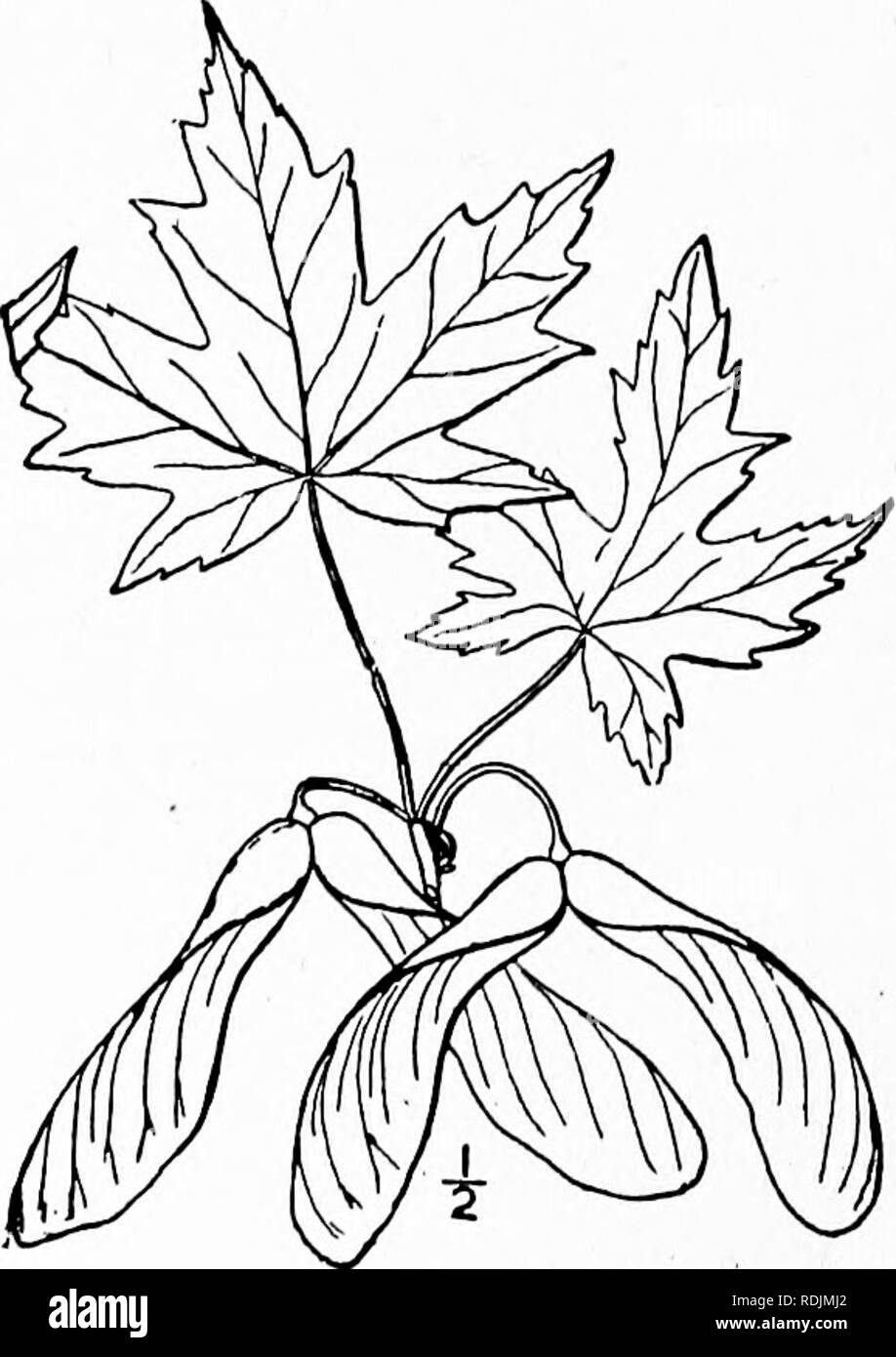 . An illustrated flora of the northern United States, Canada and the British possessions, from Newfoundland to the parallel of the southern boundary of Virginia, and from the Atlantic Ocean westward to the 102d meridian. Botany; Botany. 494 ACERACEAE. Vol. II. Family 79. ACERACEAE St. Hil. Expos. Fam. 2 : 15., 1805. Maple Family. Trees or shrubs, with watery often saccharine sap, opposite simple and palmately lobed (rarely entire) or pinnate leaves, and axillary or terminal cymose or racemose regular polygamous or dioecious flowers. Calyx generally 5-parted, the segments imbricated. Petals of Stock Photohttps://www.alamy.com/image-license-details/?v=1https://www.alamy.com/an-illustrated-flora-of-the-northern-united-states-canada-and-the-british-possessions-from-newfoundland-to-the-parallel-of-the-southern-boundary-of-virginia-and-from-the-atlantic-ocean-westward-to-the-102d-meridian-botany-botany-494-aceraceae-vol-ii-family-79-aceraceae-st-hil-expos-fam-2-15-1805-maple-family-trees-or-shrubs-with-watery-often-saccharine-sap-opposite-simple-and-palmately-lobed-rarely-entire-or-pinnate-leaves-and-axillary-or-terminal-cymose-or-racemose-regular-polygamous-or-dioecious-flowers-calyx-generally-5-parted-the-segments-imbricated-petals-of-image232136634.html
. An illustrated flora of the northern United States, Canada and the British possessions, from Newfoundland to the parallel of the southern boundary of Virginia, and from the Atlantic Ocean westward to the 102d meridian. Botany; Botany. 494 ACERACEAE. Vol. II. Family 79. ACERACEAE St. Hil. Expos. Fam. 2 : 15., 1805. Maple Family. Trees or shrubs, with watery often saccharine sap, opposite simple and palmately lobed (rarely entire) or pinnate leaves, and axillary or terminal cymose or racemose regular polygamous or dioecious flowers. Calyx generally 5-parted, the segments imbricated. Petals of Stock Photohttps://www.alamy.com/image-license-details/?v=1https://www.alamy.com/an-illustrated-flora-of-the-northern-united-states-canada-and-the-british-possessions-from-newfoundland-to-the-parallel-of-the-southern-boundary-of-virginia-and-from-the-atlantic-ocean-westward-to-the-102d-meridian-botany-botany-494-aceraceae-vol-ii-family-79-aceraceae-st-hil-expos-fam-2-15-1805-maple-family-trees-or-shrubs-with-watery-often-saccharine-sap-opposite-simple-and-palmately-lobed-rarely-entire-or-pinnate-leaves-and-axillary-or-terminal-cymose-or-racemose-regular-polygamous-or-dioecious-flowers-calyx-generally-5-parted-the-segments-imbricated-petals-of-image232136634.htmlRMRDJMJ2–. An illustrated flora of the northern United States, Canada and the British possessions, from Newfoundland to the parallel of the southern boundary of Virginia, and from the Atlantic Ocean westward to the 102d meridian. Botany; Botany. 494 ACERACEAE. Vol. II. Family 79. ACERACEAE St. Hil. Expos. Fam. 2 : 15., 1805. Maple Family. Trees or shrubs, with watery often saccharine sap, opposite simple and palmately lobed (rarely entire) or pinnate leaves, and axillary or terminal cymose or racemose regular polygamous or dioecious flowers. Calyx generally 5-parted, the segments imbricated. Petals of
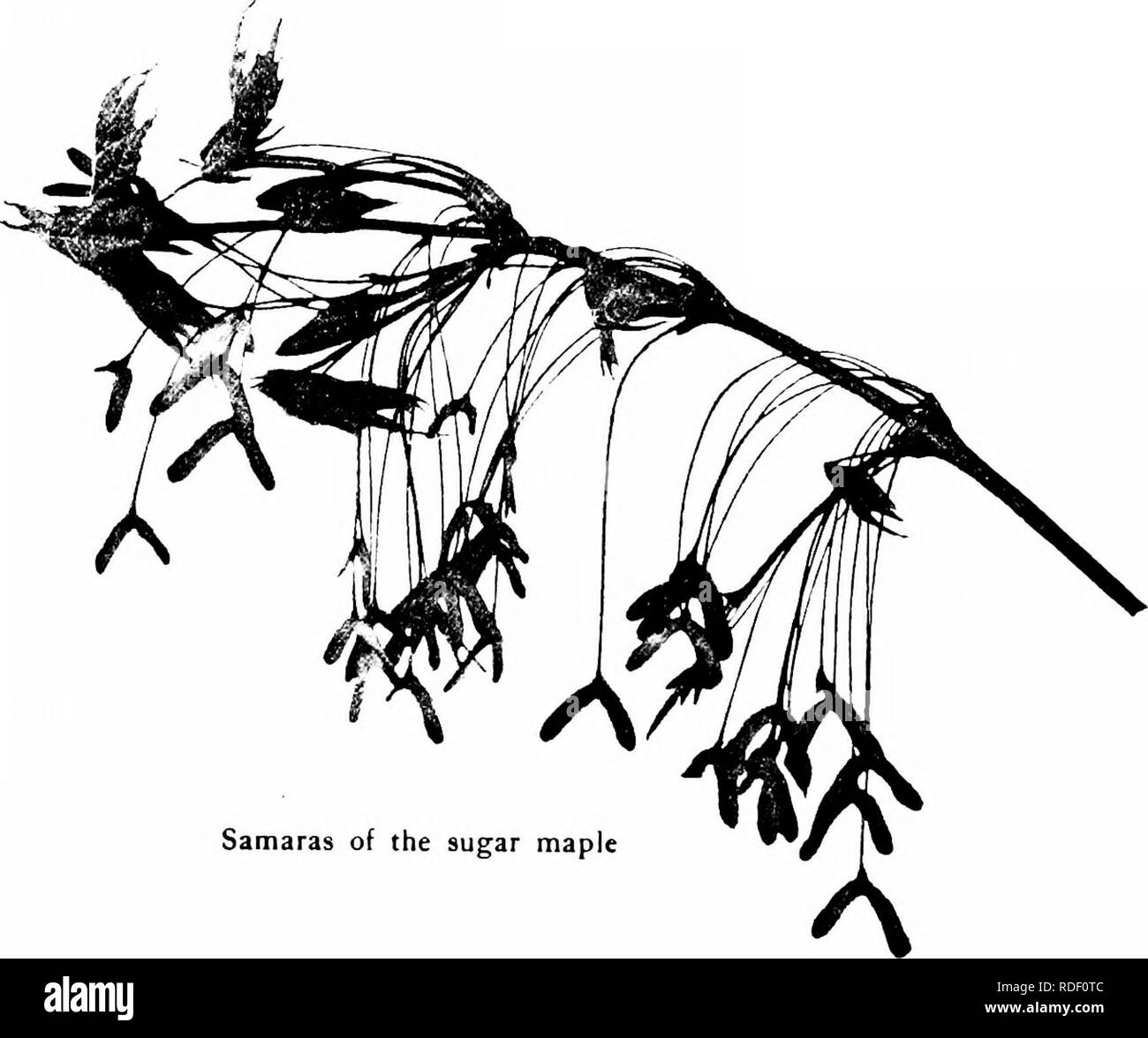 . Getting acquainted with the trees . Trees. Samaras of the sugar maple sweetness from its sap, the other because of the hardness of its wood. The sugar maples of New England, to me, are more individual and almost more essentially beautiful than the famed elms. No saccharine life-blood is drawn from the elm; therefore its elegance is considered. I notice that we seldom think much of beauty when it attaches to something we can eat! Who realizes that the common corn, the American maize, is a stately and elegant plant, far more beautiful than many a pampered pet of the green- II. Please note that Stock Photohttps://www.alamy.com/image-license-details/?v=1https://www.alamy.com/getting-acquainted-with-the-trees-trees-samaras-of-the-sugar-maple-sweetness-from-its-sap-the-other-because-of-the-hardness-of-its-wood-the-sugar-maples-of-new-england-to-me-are-more-individual-and-almost-more-essentially-beautiful-than-the-famed-elms-no-saccharine-life-blood-is-drawn-from-the-elm-therefore-its-elegance-is-considered-i-notice-that-we-seldom-think-much-of-beauty-when-it-attaches-to-something-we-can-eat!-who-realizes-that-the-common-corn-the-american-maize-is-a-stately-and-elegant-plant-far-more-beautiful-than-many-a-pampered-pet-of-the-green-ii-please-note-that-image232055276.html
. Getting acquainted with the trees . Trees. Samaras of the sugar maple sweetness from its sap, the other because of the hardness of its wood. The sugar maples of New England, to me, are more individual and almost more essentially beautiful than the famed elms. No saccharine life-blood is drawn from the elm; therefore its elegance is considered. I notice that we seldom think much of beauty when it attaches to something we can eat! Who realizes that the common corn, the American maize, is a stately and elegant plant, far more beautiful than many a pampered pet of the green- II. Please note that Stock Photohttps://www.alamy.com/image-license-details/?v=1https://www.alamy.com/getting-acquainted-with-the-trees-trees-samaras-of-the-sugar-maple-sweetness-from-its-sap-the-other-because-of-the-hardness-of-its-wood-the-sugar-maples-of-new-england-to-me-are-more-individual-and-almost-more-essentially-beautiful-than-the-famed-elms-no-saccharine-life-blood-is-drawn-from-the-elm-therefore-its-elegance-is-considered-i-notice-that-we-seldom-think-much-of-beauty-when-it-attaches-to-something-we-can-eat!-who-realizes-that-the-common-corn-the-american-maize-is-a-stately-and-elegant-plant-far-more-beautiful-than-many-a-pampered-pet-of-the-green-ii-please-note-that-image232055276.htmlRMRDF0TC–. Getting acquainted with the trees . Trees. Samaras of the sugar maple sweetness from its sap, the other because of the hardness of its wood. The sugar maples of New England, to me, are more individual and almost more essentially beautiful than the famed elms. No saccharine life-blood is drawn from the elm; therefore its elegance is considered. I notice that we seldom think much of beauty when it attaches to something we can eat! Who realizes that the common corn, the American maize, is a stately and elegant plant, far more beautiful than many a pampered pet of the green- II. Please note that
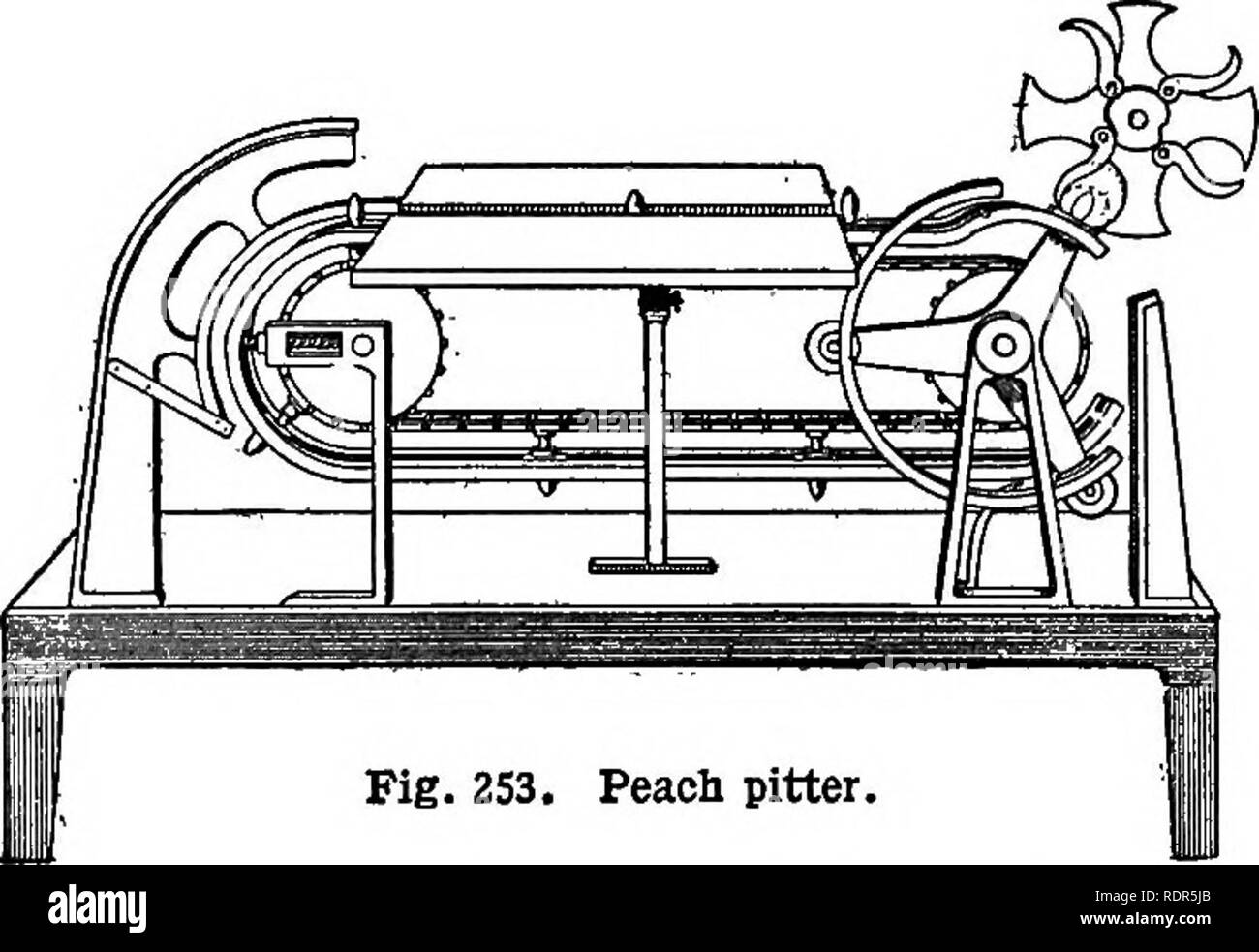 . Cyclopedia of farm crops, a popular survey of crops and crop-making methods in the United States and Canada;. Farm produce; Agriculture. Fig. 252. Peacb peelers for canning factory. water, starch and the like, variations of fifty to seventy-five minutes being found in different fac- tories. Sweet corn undergoes fermentative changes even more rapidly than do peas, because of its high percentage of sugar, and especially from the fact that the kernels are broken, thus allowing direct access of bacteria to the saccharine juices. Unless means were taken to prevent it, fermentation would take plac Stock Photohttps://www.alamy.com/image-license-details/?v=1https://www.alamy.com/cyclopedia-of-farm-crops-a-popular-survey-of-crops-and-crop-making-methods-in-the-united-states-and-canada-farm-produce-agriculture-fig-252-peacb-peelers-for-canning-factory-water-starch-and-the-like-variations-of-fifty-to-seventy-five-minutes-being-found-in-different-fac-tories-sweet-corn-undergoes-fermentative-changes-even-more-rapidly-than-do-peas-because-of-its-high-percentage-of-sugar-and-especially-from-the-fact-that-the-kernels-are-broken-thus-allowing-direct-access-of-bacteria-to-the-saccharine-juices-unless-means-were-taken-to-prevent-it-fermentation-would-take-plac-image232234643.html
. Cyclopedia of farm crops, a popular survey of crops and crop-making methods in the United States and Canada;. Farm produce; Agriculture. Fig. 252. Peacb peelers for canning factory. water, starch and the like, variations of fifty to seventy-five minutes being found in different fac- tories. Sweet corn undergoes fermentative changes even more rapidly than do peas, because of its high percentage of sugar, and especially from the fact that the kernels are broken, thus allowing direct access of bacteria to the saccharine juices. Unless means were taken to prevent it, fermentation would take plac Stock Photohttps://www.alamy.com/image-license-details/?v=1https://www.alamy.com/cyclopedia-of-farm-crops-a-popular-survey-of-crops-and-crop-making-methods-in-the-united-states-and-canada-farm-produce-agriculture-fig-252-peacb-peelers-for-canning-factory-water-starch-and-the-like-variations-of-fifty-to-seventy-five-minutes-being-found-in-different-fac-tories-sweet-corn-undergoes-fermentative-changes-even-more-rapidly-than-do-peas-because-of-its-high-percentage-of-sugar-and-especially-from-the-fact-that-the-kernels-are-broken-thus-allowing-direct-access-of-bacteria-to-the-saccharine-juices-unless-means-were-taken-to-prevent-it-fermentation-would-take-plac-image232234643.htmlRMRDR5JB–. Cyclopedia of farm crops, a popular survey of crops and crop-making methods in the United States and Canada;. Farm produce; Agriculture. Fig. 252. Peacb peelers for canning factory. water, starch and the like, variations of fifty to seventy-five minutes being found in different fac- tories. Sweet corn undergoes fermentative changes even more rapidly than do peas, because of its high percentage of sugar, and especially from the fact that the kernels are broken, thus allowing direct access of bacteria to the saccharine juices. Unless means were taken to prevent it, fermentation would take plac
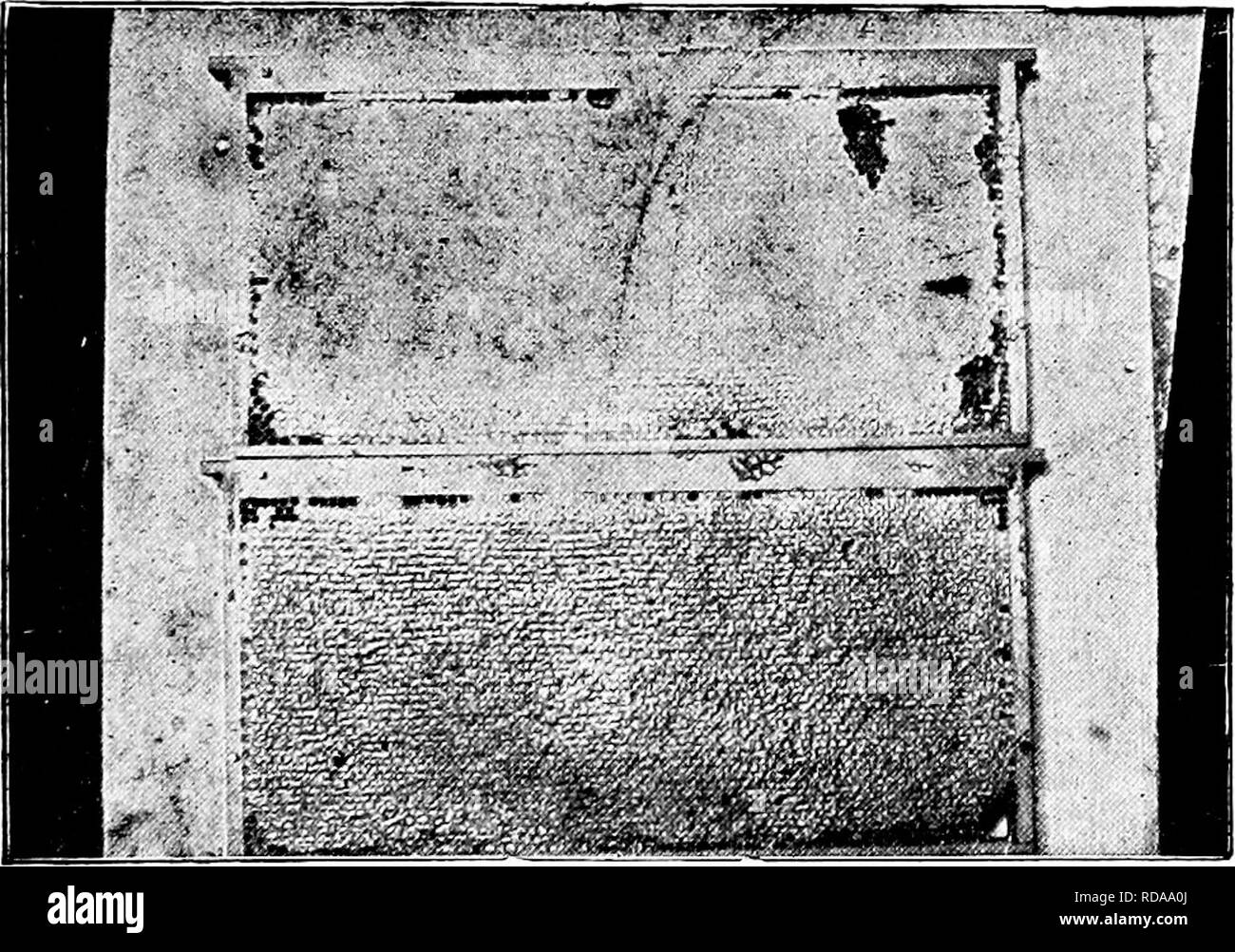 . Langstroth on the hive & honey bee. Bees. IIOXEY. 117 to eighty per cent of water, there are many late plants that give honey which needs little evaporation. The honey from heather is said to he difficult to extract from the combs (YiG), owing to its density. 250. The quantity of nectar produced by the flowers decreases during drought, and increases on the first or second da5' after a rain. But it is then more watery. In some sea- sons the saccharine juices abound, while in others thej' are so deficient that bees can obtain scarcely any food from fields all. Fig. 48. COMES CONTAINING SEA Stock Photohttps://www.alamy.com/image-license-details/?v=1https://www.alamy.com/langstroth-on-the-hive-amp-honey-bee-bees-iioxey-117-to-eighty-per-cent-of-water-there-are-many-late-plants-that-give-honey-which-needs-little-evaporation-the-honey-from-heather-is-said-to-he-difficult-to-extract-from-the-combs-yig-owing-to-its-density-250-the-quantity-of-nectar-produced-by-the-flowers-decreases-during-drought-and-increases-on-the-first-or-second-da5-after-a-rain-but-it-is-then-more-watery-in-some-sea-sons-the-saccharine-juices-abound-while-in-others-thej-are-so-deficient-that-bees-can-obtain-scarcely-any-food-from-fields-all-fig-48-comes-containing-sea-image231952690.html
. Langstroth on the hive & honey bee. Bees. IIOXEY. 117 to eighty per cent of water, there are many late plants that give honey which needs little evaporation. The honey from heather is said to he difficult to extract from the combs (YiG), owing to its density. 250. The quantity of nectar produced by the flowers decreases during drought, and increases on the first or second da5' after a rain. But it is then more watery. In some sea- sons the saccharine juices abound, while in others thej' are so deficient that bees can obtain scarcely any food from fields all. Fig. 48. COMES CONTAINING SEA Stock Photohttps://www.alamy.com/image-license-details/?v=1https://www.alamy.com/langstroth-on-the-hive-amp-honey-bee-bees-iioxey-117-to-eighty-per-cent-of-water-there-are-many-late-plants-that-give-honey-which-needs-little-evaporation-the-honey-from-heather-is-said-to-he-difficult-to-extract-from-the-combs-yig-owing-to-its-density-250-the-quantity-of-nectar-produced-by-the-flowers-decreases-during-drought-and-increases-on-the-first-or-second-da5-after-a-rain-but-it-is-then-more-watery-in-some-sea-sons-the-saccharine-juices-abound-while-in-others-thej-are-so-deficient-that-bees-can-obtain-scarcely-any-food-from-fields-all-fig-48-comes-containing-sea-image231952690.htmlRMRDAA0J–. Langstroth on the hive & honey bee. Bees. IIOXEY. 117 to eighty per cent of water, there are many late plants that give honey which needs little evaporation. The honey from heather is said to he difficult to extract from the combs (YiG), owing to its density. 250. The quantity of nectar produced by the flowers decreases during drought, and increases on the first or second da5' after a rain. But it is then more watery. In some sea- sons the saccharine juices abound, while in others thej' are so deficient that bees can obtain scarcely any food from fields all. Fig. 48. COMES CONTAINING SEA
 . The corn crops: a discussion of maize, kafirs, and sorghums as grown in the United States and Canada. Corn; Kafir corn; Sorghum. THK SACCHARINE SORGHUMS 299 and the plant is more leafy. The variety name refers to the deep orange color of the ripe heads. This variety is excellent for sirup pro- duction and it makes a heavy yield of for- age, especially on good land. However, for cured forage farmers object somewhat to heavy stalks, as they are more difficult to handle and cure. Orange sorghum is second in popularity to Amber and is grown principally from Kan- sas southward. Collier and Colema Stock Photohttps://www.alamy.com/image-license-details/?v=1https://www.alamy.com/the-corn-crops-a-discussion-of-maize-kafirs-and-sorghums-as-grown-in-the-united-states-and-canada-corn-kafir-corn-sorghum-thk-saccharine-sorghums-299-and-the-plant-is-more-leafy-the-variety-name-refers-to-the-deep-orange-color-of-the-ripe-heads-this-variety-is-excellent-for-sirup-pro-duction-and-it-makes-a-heavy-yield-of-for-age-especially-on-good-land-however-for-cured-forage-farmers-object-somewhat-to-heavy-stalks-as-they-are-more-difficult-to-handle-and-cure-orange-sorghum-is-second-in-popularity-to-amber-and-is-grown-principally-from-kan-sas-southward-collier-and-colema-image232076662.html
. The corn crops: a discussion of maize, kafirs, and sorghums as grown in the United States and Canada. Corn; Kafir corn; Sorghum. THK SACCHARINE SORGHUMS 299 and the plant is more leafy. The variety name refers to the deep orange color of the ripe heads. This variety is excellent for sirup pro- duction and it makes a heavy yield of for- age, especially on good land. However, for cured forage farmers object somewhat to heavy stalks, as they are more difficult to handle and cure. Orange sorghum is second in popularity to Amber and is grown principally from Kan- sas southward. Collier and Colema Stock Photohttps://www.alamy.com/image-license-details/?v=1https://www.alamy.com/the-corn-crops-a-discussion-of-maize-kafirs-and-sorghums-as-grown-in-the-united-states-and-canada-corn-kafir-corn-sorghum-thk-saccharine-sorghums-299-and-the-plant-is-more-leafy-the-variety-name-refers-to-the-deep-orange-color-of-the-ripe-heads-this-variety-is-excellent-for-sirup-pro-duction-and-it-makes-a-heavy-yield-of-for-age-especially-on-good-land-however-for-cured-forage-farmers-object-somewhat-to-heavy-stalks-as-they-are-more-difficult-to-handle-and-cure-orange-sorghum-is-second-in-popularity-to-amber-and-is-grown-principally-from-kan-sas-southward-collier-and-colema-image232076662.htmlRMRDG046–. The corn crops: a discussion of maize, kafirs, and sorghums as grown in the United States and Canada. Corn; Kafir corn; Sorghum. THK SACCHARINE SORGHUMS 299 and the plant is more leafy. The variety name refers to the deep orange color of the ripe heads. This variety is excellent for sirup pro- duction and it makes a heavy yield of for- age, especially on good land. However, for cured forage farmers object somewhat to heavy stalks, as they are more difficult to handle and cure. Orange sorghum is second in popularity to Amber and is grown principally from Kan- sas southward. Collier and Colema
![. A text-book of animal physiology [microform] : with introductory chapters on general biology and a full treatment of reproduction, for students of human and comparative (veterinary) medicine and of general biology. Physiology, Comparative; Veterinary physiology; Physiologie comparée; Physiologie vétérinaire. CNICEM LAR PLANTS. 11 3 analyzed, tn, calcium, H, O, N, S, I by drying o a solution carbon di- >me frothy; {fermentor ) process de- j saccharine All of these ; sunlight, tundantly in ation of cer- ay be legiti- of about the imiting wall which latter » all living trodnce their ation gi Stock Photo . A text-book of animal physiology [microform] : with introductory chapters on general biology and a full treatment of reproduction, for students of human and comparative (veterinary) medicine and of general biology. Physiology, Comparative; Veterinary physiology; Physiologie comparée; Physiologie vétérinaire. CNICEM LAR PLANTS. 11 3 analyzed, tn, calcium, H, O, N, S, I by drying o a solution carbon di- >me frothy; {fermentor ) process de- j saccharine All of these ; sunlight, tundantly in ation of cer- ay be legiti- of about the imiting wall which latter » all living trodnce their ation gi Stock Photo](https://c8.alamy.com/comp/REW187/a-text-book-of-animal-physiology-microform-with-introductory-chapters-on-general-biology-and-a-full-treatment-of-reproduction-for-students-of-human-and-comparative-veterinary-medicine-and-of-general-biology-physiology-comparative-veterinary-physiology-physiologie-compare-physiologie-vtrinaire-cnicem-lar-plants-11-3-analyzed-tn-calcium-h-o-n-s-i-by-drying-o-a-solution-carbon-di-gtme-frothy-fermentor-process-de-j-saccharine-all-of-these-sunlight-tundantly-in-ation-of-cer-ay-be-legiti-of-about-the-imiting-wall-which-latter-all-living-trodnce-their-ation-gi-REW187.jpg) . A text-book of animal physiology [microform] : with introductory chapters on general biology and a full treatment of reproduction, for students of human and comparative (veterinary) medicine and of general biology. Physiology, Comparative; Veterinary physiology; Physiologie comparée; Physiologie vétérinaire. CNICEM LAR PLANTS. 11 3 analyzed, tn, calcium, H, O, N, S, I by drying o a solution carbon di- >me frothy; {fermentor ) process de- j saccharine All of these ; sunlight, tundantly in ation of cer- ay be legiti- of about the imiting wall which latter » all living trodnce their ation gi Stock Photohttps://www.alamy.com/image-license-details/?v=1https://www.alamy.com/a-text-book-of-animal-physiology-microform-with-introductory-chapters-on-general-biology-and-a-full-treatment-of-reproduction-for-students-of-human-and-comparative-veterinary-medicine-and-of-general-biology-physiology-comparative-veterinary-physiology-physiologie-compare-physiologie-vtrinaire-cnicem-lar-plants-11-3-analyzed-tn-calcium-h-o-n-s-i-by-drying-o-a-solution-carbon-di-gtme-frothy-fermentor-process-de-j-saccharine-all-of-these-sunlight-tundantly-in-ation-of-cer-ay-be-legiti-of-about-the-imiting-wall-which-latter-all-living-trodnce-their-ation-gi-image232889783.html
. A text-book of animal physiology [microform] : with introductory chapters on general biology and a full treatment of reproduction, for students of human and comparative (veterinary) medicine and of general biology. Physiology, Comparative; Veterinary physiology; Physiologie comparée; Physiologie vétérinaire. CNICEM LAR PLANTS. 11 3 analyzed, tn, calcium, H, O, N, S, I by drying o a solution carbon di- >me frothy; {fermentor ) process de- j saccharine All of these ; sunlight, tundantly in ation of cer- ay be legiti- of about the imiting wall which latter » all living trodnce their ation gi Stock Photohttps://www.alamy.com/image-license-details/?v=1https://www.alamy.com/a-text-book-of-animal-physiology-microform-with-introductory-chapters-on-general-biology-and-a-full-treatment-of-reproduction-for-students-of-human-and-comparative-veterinary-medicine-and-of-general-biology-physiology-comparative-veterinary-physiology-physiologie-compare-physiologie-vtrinaire-cnicem-lar-plants-11-3-analyzed-tn-calcium-h-o-n-s-i-by-drying-o-a-solution-carbon-di-gtme-frothy-fermentor-process-de-j-saccharine-all-of-these-sunlight-tundantly-in-ation-of-cer-ay-be-legiti-of-about-the-imiting-wall-which-latter-all-living-trodnce-their-ation-gi-image232889783.htmlRMREW187–. A text-book of animal physiology [microform] : with introductory chapters on general biology and a full treatment of reproduction, for students of human and comparative (veterinary) medicine and of general biology. Physiology, Comparative; Veterinary physiology; Physiologie comparée; Physiologie vétérinaire. CNICEM LAR PLANTS. 11 3 analyzed, tn, calcium, H, O, N, S, I by drying o a solution carbon di- >me frothy; {fermentor ) process de- j saccharine All of these ; sunlight, tundantly in ation of cer- ay be legiti- of about the imiting wall which latter » all living trodnce their ation gi
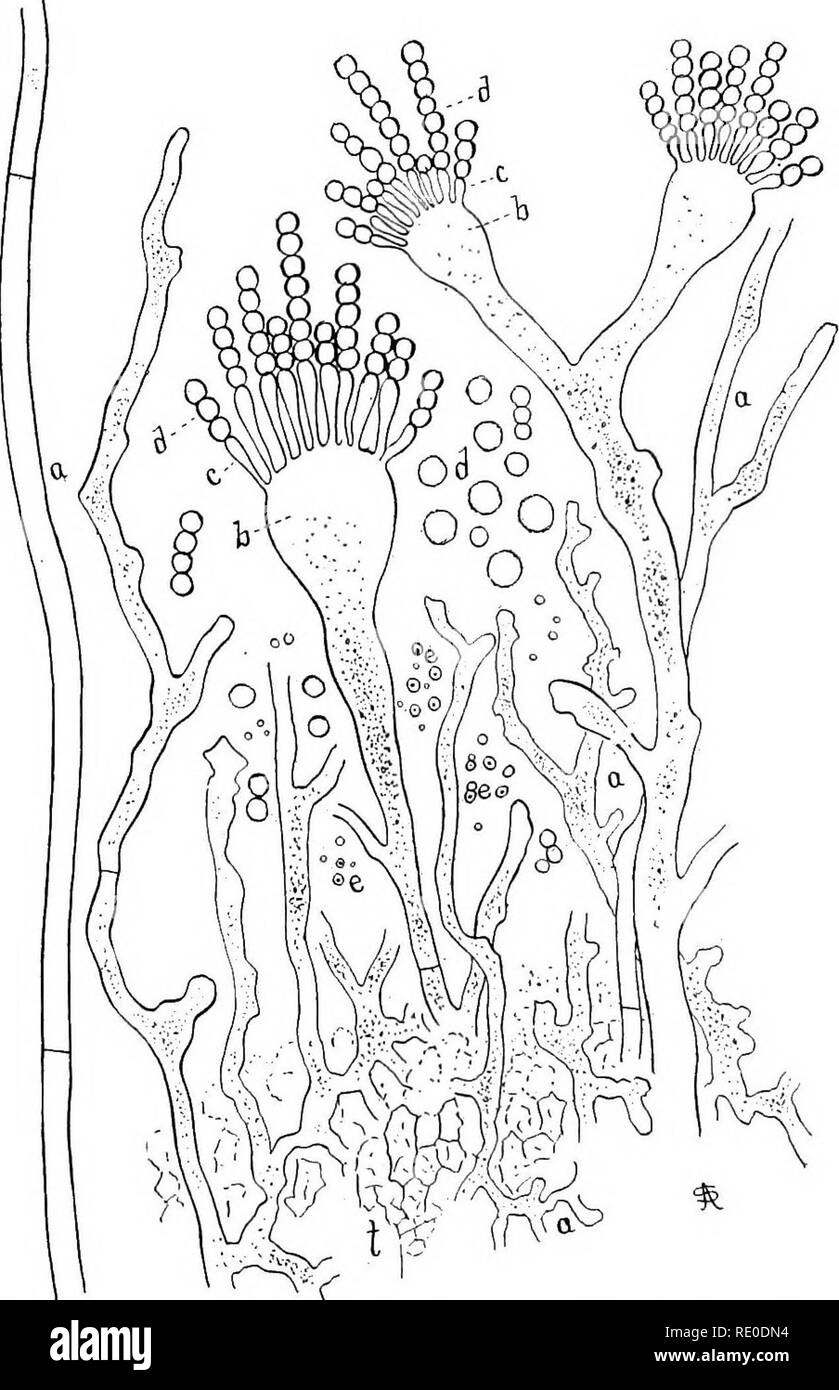 . Bacteriological methods in food and drugs laboratories : with an introduction to micro-analytical methods . Bacteriology; Food; Drugs. 224 BACTERIOLOGICAL METHODS the fungus aspergillus oryza may convert the starch into saccharine compounds. The fungus is kept on hand in pure culture and. Fig. 78.—Sak6. Aspergillus oryza, showing vegetative hyplias (a) and the spore- forming hyphse (b, c, d). mixed with the steamed rice and the sugar fermentation takes place in a warm room. The alcoholic fermentation, which follows, is much like that in beer making. Likewise the final processes of. Please no Stock Photohttps://www.alamy.com/image-license-details/?v=1https://www.alamy.com/bacteriological-methods-in-food-and-drugs-laboratories-with-an-introduction-to-micro-analytical-methods-bacteriology-food-drugs-224-bacteriological-methods-the-fungus-aspergillus-oryza-may-convert-the-starch-into-saccharine-compounds-the-fungus-is-kept-on-hand-in-pure-culture-and-fig-78sak6-aspergillus-oryza-showing-vegetative-hyplias-a-and-the-spore-forming-hyphse-b-c-d-mixed-with-the-steamed-rice-and-the-sugar-fermentation-takes-place-in-a-warm-room-the-alcoholic-fermentation-which-follows-is-much-like-that-in-beer-making-likewise-the-final-processes-of-please-no-image232350752.html
. Bacteriological methods in food and drugs laboratories : with an introduction to micro-analytical methods . Bacteriology; Food; Drugs. 224 BACTERIOLOGICAL METHODS the fungus aspergillus oryza may convert the starch into saccharine compounds. The fungus is kept on hand in pure culture and. Fig. 78.—Sak6. Aspergillus oryza, showing vegetative hyplias (a) and the spore- forming hyphse (b, c, d). mixed with the steamed rice and the sugar fermentation takes place in a warm room. The alcoholic fermentation, which follows, is much like that in beer making. Likewise the final processes of. Please no Stock Photohttps://www.alamy.com/image-license-details/?v=1https://www.alamy.com/bacteriological-methods-in-food-and-drugs-laboratories-with-an-introduction-to-micro-analytical-methods-bacteriology-food-drugs-224-bacteriological-methods-the-fungus-aspergillus-oryza-may-convert-the-starch-into-saccharine-compounds-the-fungus-is-kept-on-hand-in-pure-culture-and-fig-78sak6-aspergillus-oryza-showing-vegetative-hyplias-a-and-the-spore-forming-hyphse-b-c-d-mixed-with-the-steamed-rice-and-the-sugar-fermentation-takes-place-in-a-warm-room-the-alcoholic-fermentation-which-follows-is-much-like-that-in-beer-making-likewise-the-final-processes-of-please-no-image232350752.htmlRMRE0DN4–. Bacteriological methods in food and drugs laboratories : with an introduction to micro-analytical methods . Bacteriology; Food; Drugs. 224 BACTERIOLOGICAL METHODS the fungus aspergillus oryza may convert the starch into saccharine compounds. The fungus is kept on hand in pure culture and. Fig. 78.—Sak6. Aspergillus oryza, showing vegetative hyplias (a) and the spore- forming hyphse (b, c, d). mixed with the steamed rice and the sugar fermentation takes place in a warm room. The alcoholic fermentation, which follows, is much like that in beer making. Likewise the final processes of. Please no
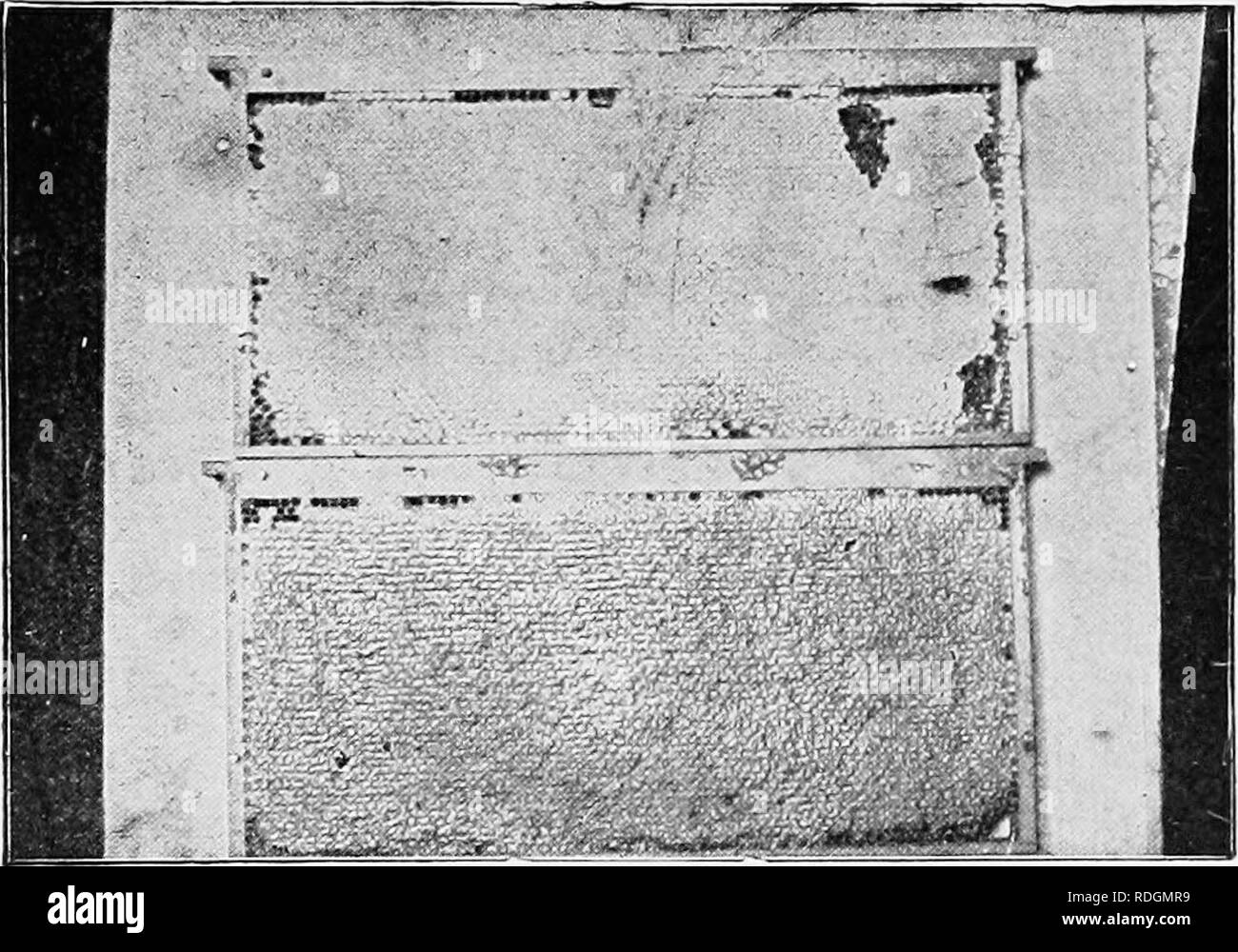 . Langstroth on the hive and honey-bee. Bees. HOXEY. 117 to eighty per cent of water, there are many late plants that give honey which needs little evaporation: The honey from heather is said to be difficult to extract from the combs (746), owing to its density. 250. The quantity of nectar produced by the flowers decreases duruig drought, and increases on the first or second day after a rain. But it is then more watery. In some sea- sons the saccharine juices abound, while in others they are so deficient that bees can obtain scarcely any food from fields all. Pig. 48. COMBS CONTAINING SEAiED H Stock Photohttps://www.alamy.com/image-license-details/?v=1https://www.alamy.com/langstroth-on-the-hive-and-honey-bee-bees-hoxey-117-to-eighty-per-cent-of-water-there-are-many-late-plants-that-give-honey-which-needs-little-evaporation-the-honey-from-heather-is-said-to-be-difficult-to-extract-from-the-combs-746-owing-to-its-density-250-the-quantity-of-nectar-produced-by-the-flowers-decreases-duruig-drought-and-increases-on-the-first-or-second-day-after-a-rain-but-it-is-then-more-watery-in-some-sea-sons-the-saccharine-juices-abound-while-in-others-they-are-so-deficient-that-bees-can-obtain-scarcely-any-food-from-fields-all-pig-48-combs-containing-seaied-h-image232092877.html
. Langstroth on the hive and honey-bee. Bees. HOXEY. 117 to eighty per cent of water, there are many late plants that give honey which needs little evaporation: The honey from heather is said to be difficult to extract from the combs (746), owing to its density. 250. The quantity of nectar produced by the flowers decreases duruig drought, and increases on the first or second day after a rain. But it is then more watery. In some sea- sons the saccharine juices abound, while in others they are so deficient that bees can obtain scarcely any food from fields all. Pig. 48. COMBS CONTAINING SEAiED H Stock Photohttps://www.alamy.com/image-license-details/?v=1https://www.alamy.com/langstroth-on-the-hive-and-honey-bee-bees-hoxey-117-to-eighty-per-cent-of-water-there-are-many-late-plants-that-give-honey-which-needs-little-evaporation-the-honey-from-heather-is-said-to-be-difficult-to-extract-from-the-combs-746-owing-to-its-density-250-the-quantity-of-nectar-produced-by-the-flowers-decreases-duruig-drought-and-increases-on-the-first-or-second-day-after-a-rain-but-it-is-then-more-watery-in-some-sea-sons-the-saccharine-juices-abound-while-in-others-they-are-so-deficient-that-bees-can-obtain-scarcely-any-food-from-fields-all-pig-48-combs-containing-seaied-h-image232092877.htmlRMRDGMR9–. Langstroth on the hive and honey-bee. Bees. HOXEY. 117 to eighty per cent of water, there are many late plants that give honey which needs little evaporation: The honey from heather is said to be difficult to extract from the combs (746), owing to its density. 250. The quantity of nectar produced by the flowers decreases duruig drought, and increases on the first or second day after a rain. But it is then more watery. In some sea- sons the saccharine juices abound, while in others they are so deficient that bees can obtain scarcely any food from fields all. Pig. 48. COMBS CONTAINING SEAiED H
 . The corn crops: a discussion of maize, kafirs, and sorghums as grown in the United States and Canada. Corn; Kafir corn; Sorghum. THE SACCHARINE SOBGHUMS 299 and the plant is more leafy. The variety name refers to the deep orange color of the ripe heads. This variety is excellent for sirup pro- duction and it makes a heavy yield of for- age, especially on good land. However, for cured forage farmers object somewhat to heavy stalks, as they are more difficult to handle and cure. Orange sorghum is second in popularity to Amber and is grown principally from Kan- sas southward. Collier and Colema Stock Photohttps://www.alamy.com/image-license-details/?v=1https://www.alamy.com/the-corn-crops-a-discussion-of-maize-kafirs-and-sorghums-as-grown-in-the-united-states-and-canada-corn-kafir-corn-sorghum-the-saccharine-sobghums-299-and-the-plant-is-more-leafy-the-variety-name-refers-to-the-deep-orange-color-of-the-ripe-heads-this-variety-is-excellent-for-sirup-pro-duction-and-it-makes-a-heavy-yield-of-for-age-especially-on-good-land-however-for-cured-forage-farmers-object-somewhat-to-heavy-stalks-as-they-are-more-difficult-to-handle-and-cure-orange-sorghum-is-second-in-popularity-to-amber-and-is-grown-principally-from-kan-sas-southward-collier-and-colema-image232020388.html
. The corn crops: a discussion of maize, kafirs, and sorghums as grown in the United States and Canada. Corn; Kafir corn; Sorghum. THE SACCHARINE SOBGHUMS 299 and the plant is more leafy. The variety name refers to the deep orange color of the ripe heads. This variety is excellent for sirup pro- duction and it makes a heavy yield of for- age, especially on good land. However, for cured forage farmers object somewhat to heavy stalks, as they are more difficult to handle and cure. Orange sorghum is second in popularity to Amber and is grown principally from Kan- sas southward. Collier and Colema Stock Photohttps://www.alamy.com/image-license-details/?v=1https://www.alamy.com/the-corn-crops-a-discussion-of-maize-kafirs-and-sorghums-as-grown-in-the-united-states-and-canada-corn-kafir-corn-sorghum-the-saccharine-sobghums-299-and-the-plant-is-more-leafy-the-variety-name-refers-to-the-deep-orange-color-of-the-ripe-heads-this-variety-is-excellent-for-sirup-pro-duction-and-it-makes-a-heavy-yield-of-for-age-especially-on-good-land-however-for-cured-forage-farmers-object-somewhat-to-heavy-stalks-as-they-are-more-difficult-to-handle-and-cure-orange-sorghum-is-second-in-popularity-to-amber-and-is-grown-principally-from-kan-sas-southward-collier-and-colema-image232020388.htmlRMRDDCAC–. The corn crops: a discussion of maize, kafirs, and sorghums as grown in the United States and Canada. Corn; Kafir corn; Sorghum. THE SACCHARINE SOBGHUMS 299 and the plant is more leafy. The variety name refers to the deep orange color of the ripe heads. This variety is excellent for sirup pro- duction and it makes a heavy yield of for- age, especially on good land. However, for cured forage farmers object somewhat to heavy stalks, as they are more difficult to handle and cure. Orange sorghum is second in popularity to Amber and is grown principally from Kan- sas southward. Collier and Colema
![. A text-book of animal physiology [microform] : with introductory chapters on general biology and a full treatment of reproduction, for students of human and comparative (veterinary) medicine and of general biology. Physiology, Comparative; Veterinary physiology; Physiologie comparée; Physiologie vétérinaire. CNICEM LAR PLANTS. 11 3 analyzed, tn, calcium, H, O, N, S, I by drying o a solution carbon di- >me frothy; {fermentor ) process de- j saccharine All of these ; sunlight, tundantly in ation of cer- ay be legiti- of about the imiting wall which latter » all living trodnce their ation gi Stock Photo . A text-book of animal physiology [microform] : with introductory chapters on general biology and a full treatment of reproduction, for students of human and comparative (veterinary) medicine and of general biology. Physiology, Comparative; Veterinary physiology; Physiologie comparée; Physiologie vétérinaire. CNICEM LAR PLANTS. 11 3 analyzed, tn, calcium, H, O, N, S, I by drying o a solution carbon di- >me frothy; {fermentor ) process de- j saccharine All of these ; sunlight, tundantly in ation of cer- ay be legiti- of about the imiting wall which latter » all living trodnce their ation gi Stock Photo](https://c8.alamy.com/comp/RHYW42/a-text-book-of-animal-physiology-microform-with-introductory-chapters-on-general-biology-and-a-full-treatment-of-reproduction-for-students-of-human-and-comparative-veterinary-medicine-and-of-general-biology-physiology-comparative-veterinary-physiology-physiologie-compare-physiologie-vtrinaire-cnicem-lar-plants-11-3-analyzed-tn-calcium-h-o-n-s-i-by-drying-o-a-solution-carbon-di-gtme-frothy-fermentor-process-de-j-saccharine-all-of-these-sunlight-tundantly-in-ation-of-cer-ay-be-legiti-of-about-the-imiting-wall-which-latter-all-living-trodnce-their-ation-gi-RHYW42.jpg) . A text-book of animal physiology [microform] : with introductory chapters on general biology and a full treatment of reproduction, for students of human and comparative (veterinary) medicine and of general biology. Physiology, Comparative; Veterinary physiology; Physiologie comparée; Physiologie vétérinaire. CNICEM LAR PLANTS. 11 3 analyzed, tn, calcium, H, O, N, S, I by drying o a solution carbon di- >me frothy; {fermentor ) process de- j saccharine All of these ; sunlight, tundantly in ation of cer- ay be legiti- of about the imiting wall which latter » all living trodnce their ation gi Stock Photohttps://www.alamy.com/image-license-details/?v=1https://www.alamy.com/a-text-book-of-animal-physiology-microform-with-introductory-chapters-on-general-biology-and-a-full-treatment-of-reproduction-for-students-of-human-and-comparative-veterinary-medicine-and-of-general-biology-physiology-comparative-veterinary-physiology-physiologie-compare-physiologie-vtrinaire-cnicem-lar-plants-11-3-analyzed-tn-calcium-h-o-n-s-i-by-drying-o-a-solution-carbon-di-gtme-frothy-fermentor-process-de-j-saccharine-all-of-these-sunlight-tundantly-in-ation-of-cer-ay-be-legiti-of-about-the-imiting-wall-which-latter-all-living-trodnce-their-ation-gi-image234796354.html
. A text-book of animal physiology [microform] : with introductory chapters on general biology and a full treatment of reproduction, for students of human and comparative (veterinary) medicine and of general biology. Physiology, Comparative; Veterinary physiology; Physiologie comparée; Physiologie vétérinaire. CNICEM LAR PLANTS. 11 3 analyzed, tn, calcium, H, O, N, S, I by drying o a solution carbon di- >me frothy; {fermentor ) process de- j saccharine All of these ; sunlight, tundantly in ation of cer- ay be legiti- of about the imiting wall which latter » all living trodnce their ation gi Stock Photohttps://www.alamy.com/image-license-details/?v=1https://www.alamy.com/a-text-book-of-animal-physiology-microform-with-introductory-chapters-on-general-biology-and-a-full-treatment-of-reproduction-for-students-of-human-and-comparative-veterinary-medicine-and-of-general-biology-physiology-comparative-veterinary-physiology-physiologie-compare-physiologie-vtrinaire-cnicem-lar-plants-11-3-analyzed-tn-calcium-h-o-n-s-i-by-drying-o-a-solution-carbon-di-gtme-frothy-fermentor-process-de-j-saccharine-all-of-these-sunlight-tundantly-in-ation-of-cer-ay-be-legiti-of-about-the-imiting-wall-which-latter-all-living-trodnce-their-ation-gi-image234796354.htmlRMRHYW42–. A text-book of animal physiology [microform] : with introductory chapters on general biology and a full treatment of reproduction, for students of human and comparative (veterinary) medicine and of general biology. Physiology, Comparative; Veterinary physiology; Physiologie comparée; Physiologie vétérinaire. CNICEM LAR PLANTS. 11 3 analyzed, tn, calcium, H, O, N, S, I by drying o a solution carbon di- >me frothy; {fermentor ) process de- j saccharine All of these ; sunlight, tundantly in ation of cer- ay be legiti- of about the imiting wall which latter » all living trodnce their ation gi
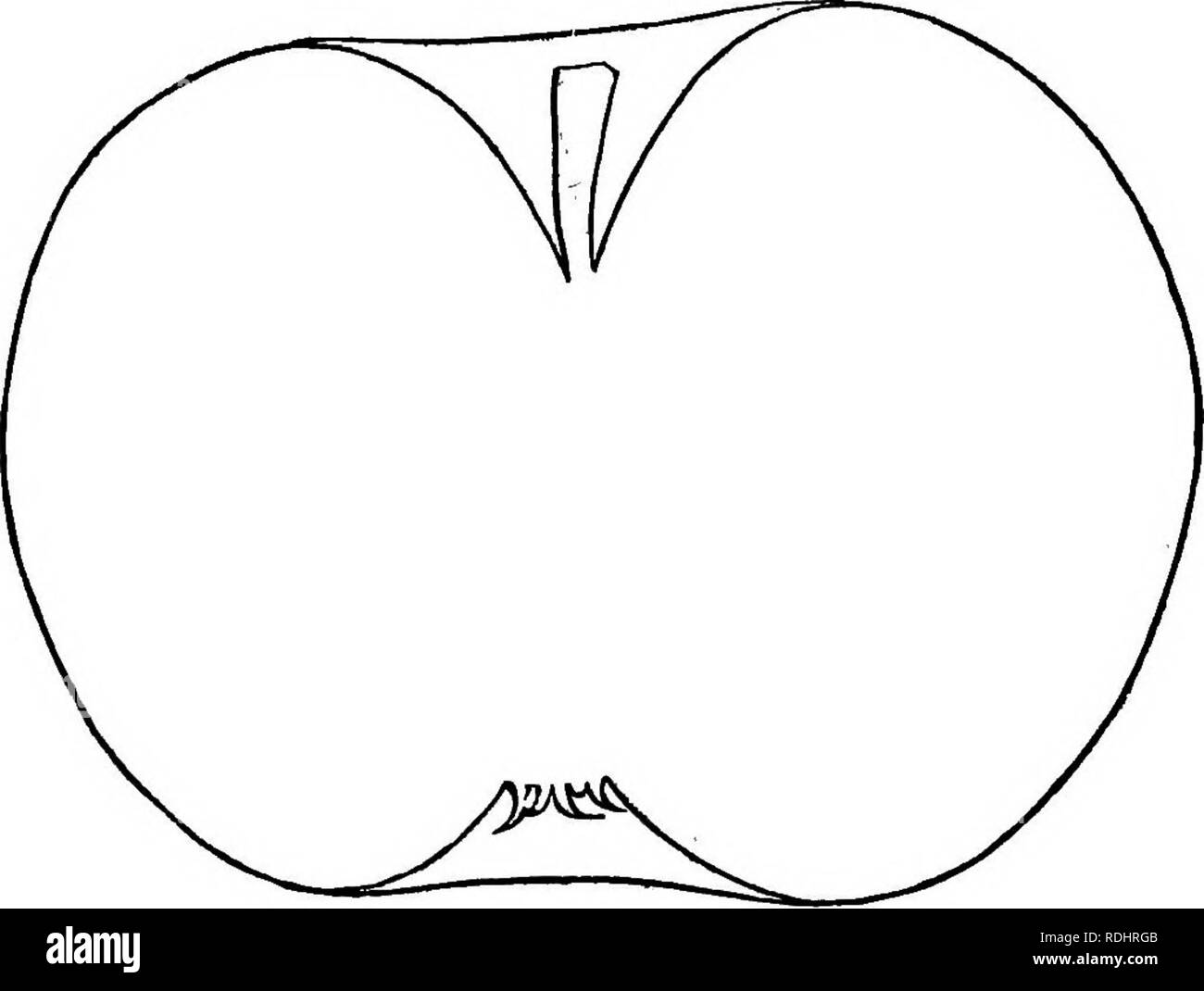 . The fruits and fruit trees of America : or, The culture, propagation and management, in the garden and orchard, of fruit trees generally, with descriptions of all the finest varieties of fruit, native and foreign, cultivated in this country . Fruit-culture; Fruit. APPLES. 79 basm. bkin light yellow, spriniied with green or grey dots, having a blush on the sunny side. Flesh yellowish, juicy, tender, melting with a very rich, mild, sub-acid flavour. By some the saccharine would suppose to predommate. Ripe November to March.. Gakden Rotal. Origin Sudbury, Mass., farm of Mr. Bowler. Tree of mod Stock Photohttps://www.alamy.com/image-license-details/?v=1https://www.alamy.com/the-fruits-and-fruit-trees-of-america-or-the-culture-propagation-and-management-in-the-garden-and-orchard-of-fruit-trees-generally-with-descriptions-of-all-the-finest-varieties-of-fruit-native-and-foreign-cultivated-in-this-country-fruit-culture-fruit-apples-79-basm-bkin-light-yellow-spriniied-with-green-or-grey-dots-having-a-blush-on-the-sunny-side-flesh-yellowish-juicy-tender-melting-with-a-very-rich-mild-sub-acid-flavour-by-some-the-saccharine-would-suppose-to-predommate-ripe-november-to-march-gakden-rotal-origin-sudbury-mass-farm-of-mr-bowler-tree-of-mod-image232116987.html
. The fruits and fruit trees of America : or, The culture, propagation and management, in the garden and orchard, of fruit trees generally, with descriptions of all the finest varieties of fruit, native and foreign, cultivated in this country . Fruit-culture; Fruit. APPLES. 79 basm. bkin light yellow, spriniied with green or grey dots, having a blush on the sunny side. Flesh yellowish, juicy, tender, melting with a very rich, mild, sub-acid flavour. By some the saccharine would suppose to predommate. Ripe November to March.. Gakden Rotal. Origin Sudbury, Mass., farm of Mr. Bowler. Tree of mod Stock Photohttps://www.alamy.com/image-license-details/?v=1https://www.alamy.com/the-fruits-and-fruit-trees-of-america-or-the-culture-propagation-and-management-in-the-garden-and-orchard-of-fruit-trees-generally-with-descriptions-of-all-the-finest-varieties-of-fruit-native-and-foreign-cultivated-in-this-country-fruit-culture-fruit-apples-79-basm-bkin-light-yellow-spriniied-with-green-or-grey-dots-having-a-blush-on-the-sunny-side-flesh-yellowish-juicy-tender-melting-with-a-very-rich-mild-sub-acid-flavour-by-some-the-saccharine-would-suppose-to-predommate-ripe-november-to-march-gakden-rotal-origin-sudbury-mass-farm-of-mr-bowler-tree-of-mod-image232116987.htmlRMRDHRGB–. The fruits and fruit trees of America : or, The culture, propagation and management, in the garden and orchard, of fruit trees generally, with descriptions of all the finest varieties of fruit, native and foreign, cultivated in this country . Fruit-culture; Fruit. APPLES. 79 basm. bkin light yellow, spriniied with green or grey dots, having a blush on the sunny side. Flesh yellowish, juicy, tender, melting with a very rich, mild, sub-acid flavour. By some the saccharine would suppose to predommate. Ripe November to March.. Gakden Rotal. Origin Sudbury, Mass., farm of Mr. Bowler. Tree of mod
![. A popular handbook of the ornithology of eastern North America [microform]. Birds; Ornithology; Oiseaux; Ornithologie. 454 WOODPECKERS. Ill â I' 1 n obsen-ed these borers busy ta[)ping the small Uve trunks of several wax-myrtles {A/yrica cerifera) ; and these perforations were carried down into the alburnum, or sajj-wood, but no farther: no insects could be expected, of course, in such situ- ations, and at this season very few could be obtained anywhere. On examining the oozing sap, 1 fountl it to be exceedingly saccharine, but in some instances astringent or nearly taste- less, 'io a bird l Stock Photo . A popular handbook of the ornithology of eastern North America [microform]. Birds; Ornithology; Oiseaux; Ornithologie. 454 WOODPECKERS. Ill â I' 1 n obsen-ed these borers busy ta[)ping the small Uve trunks of several wax-myrtles {A/yrica cerifera) ; and these perforations were carried down into the alburnum, or sajj-wood, but no farther: no insects could be expected, of course, in such situ- ations, and at this season very few could be obtained anywhere. On examining the oozing sap, 1 fountl it to be exceedingly saccharine, but in some instances astringent or nearly taste- less, 'io a bird l Stock Photo](https://c8.alamy.com/comp/RJ274H/a-popular-handbook-of-the-ornithology-of-eastern-north-america-microform-birds-ornithology-oiseaux-ornithologie-454-woodpeckers-ill-i-1-n-obsen-ed-these-borers-busy-ta-ping-the-small-uve-trunks-of-several-wax-myrtles-ayrica-cerifera-and-these-perforations-were-carried-down-into-the-alburnum-or-sajj-wood-but-no-farther-no-insects-could-be-expected-of-course-in-such-situ-ations-and-at-this-season-very-few-could-be-obtained-anywhere-on-examining-the-oozing-sap-1-fountl-it-to-be-exceedingly-saccharine-but-in-some-instances-astringent-or-nearly-taste-less-io-a-bird-l-RJ274H.jpg) . A popular handbook of the ornithology of eastern North America [microform]. Birds; Ornithology; Oiseaux; Ornithologie. 454 WOODPECKERS. Ill â I' 1 n obsen-ed these borers busy ta[)ping the small Uve trunks of several wax-myrtles {A/yrica cerifera) ; and these perforations were carried down into the alburnum, or sajj-wood, but no farther: no insects could be expected, of course, in such situ- ations, and at this season very few could be obtained anywhere. On examining the oozing sap, 1 fountl it to be exceedingly saccharine, but in some instances astringent or nearly taste- less, 'io a bird l Stock Photohttps://www.alamy.com/image-license-details/?v=1https://www.alamy.com/a-popular-handbook-of-the-ornithology-of-eastern-north-america-microform-birds-ornithology-oiseaux-ornithologie-454-woodpeckers-ill-i-1-n-obsen-ed-these-borers-busy-ta-ping-the-small-uve-trunks-of-several-wax-myrtles-ayrica-cerifera-and-these-perforations-were-carried-down-into-the-alburnum-or-sajj-wood-but-no-farther-no-insects-could-be-expected-of-course-in-such-situ-ations-and-at-this-season-very-few-could-be-obtained-anywhere-on-examining-the-oozing-sap-1-fountl-it-to-be-exceedingly-saccharine-but-in-some-instances-astringent-or-nearly-taste-less-io-a-bird-l-image234848113.html
. A popular handbook of the ornithology of eastern North America [microform]. Birds; Ornithology; Oiseaux; Ornithologie. 454 WOODPECKERS. Ill â I' 1 n obsen-ed these borers busy ta[)ping the small Uve trunks of several wax-myrtles {A/yrica cerifera) ; and these perforations were carried down into the alburnum, or sajj-wood, but no farther: no insects could be expected, of course, in such situ- ations, and at this season very few could be obtained anywhere. On examining the oozing sap, 1 fountl it to be exceedingly saccharine, but in some instances astringent or nearly taste- less, 'io a bird l Stock Photohttps://www.alamy.com/image-license-details/?v=1https://www.alamy.com/a-popular-handbook-of-the-ornithology-of-eastern-north-america-microform-birds-ornithology-oiseaux-ornithologie-454-woodpeckers-ill-i-1-n-obsen-ed-these-borers-busy-ta-ping-the-small-uve-trunks-of-several-wax-myrtles-ayrica-cerifera-and-these-perforations-were-carried-down-into-the-alburnum-or-sajj-wood-but-no-farther-no-insects-could-be-expected-of-course-in-such-situ-ations-and-at-this-season-very-few-could-be-obtained-anywhere-on-examining-the-oozing-sap-1-fountl-it-to-be-exceedingly-saccharine-but-in-some-instances-astringent-or-nearly-taste-less-io-a-bird-l-image234848113.htmlRMRJ274H–. A popular handbook of the ornithology of eastern North America [microform]. Birds; Ornithology; Oiseaux; Ornithologie. 454 WOODPECKERS. Ill â I' 1 n obsen-ed these borers busy ta[)ping the small Uve trunks of several wax-myrtles {A/yrica cerifera) ; and these perforations were carried down into the alburnum, or sajj-wood, but no farther: no insects could be expected, of course, in such situ- ations, and at this season very few could be obtained anywhere. On examining the oozing sap, 1 fountl it to be exceedingly saccharine, but in some instances astringent or nearly taste- less, 'io a bird l
 . The corn crops: a discussion of maize, kafirs, and sorghums as grown in the United States and Canada. Corn; Kafir corn; Sorghum. THE NON-SACCHARINE SORGHUMS 313 wide range of conditions, and this plant, together with BlackhuU Kafir, is the best of the sorghums for grain production. The milos, being about three weeks earlier in maturing than the kafirs, have two distinct advan- tages : in Oklahoma and Texas they can be planted early and will more nearly ma- ture before the severe midsummer drought; also, they may be grown farther north and at higher alti- tudes. 240. Shallu.—This plant is of Stock Photohttps://www.alamy.com/image-license-details/?v=1https://www.alamy.com/the-corn-crops-a-discussion-of-maize-kafirs-and-sorghums-as-grown-in-the-united-states-and-canada-corn-kafir-corn-sorghum-the-non-saccharine-sorghums-313-wide-range-of-conditions-and-this-plant-together-with-blackhuu-kafir-is-the-best-of-the-sorghums-for-grain-production-the-milos-being-about-three-weeks-earlier-in-maturing-than-the-kafirs-have-two-distinct-advan-tages-in-oklahoma-and-texas-they-can-be-planted-early-and-will-more-nearly-ma-ture-before-the-severe-midsummer-drought-also-they-may-be-grown-farther-north-and-at-higher-alti-tudes-240-shalluthis-plant-is-of-image232094062.html
. The corn crops: a discussion of maize, kafirs, and sorghums as grown in the United States and Canada. Corn; Kafir corn; Sorghum. THE NON-SACCHARINE SORGHUMS 313 wide range of conditions, and this plant, together with BlackhuU Kafir, is the best of the sorghums for grain production. The milos, being about three weeks earlier in maturing than the kafirs, have two distinct advan- tages : in Oklahoma and Texas they can be planted early and will more nearly ma- ture before the severe midsummer drought; also, they may be grown farther north and at higher alti- tudes. 240. Shallu.—This plant is of Stock Photohttps://www.alamy.com/image-license-details/?v=1https://www.alamy.com/the-corn-crops-a-discussion-of-maize-kafirs-and-sorghums-as-grown-in-the-united-states-and-canada-corn-kafir-corn-sorghum-the-non-saccharine-sorghums-313-wide-range-of-conditions-and-this-plant-together-with-blackhuu-kafir-is-the-best-of-the-sorghums-for-grain-production-the-milos-being-about-three-weeks-earlier-in-maturing-than-the-kafirs-have-two-distinct-advan-tages-in-oklahoma-and-texas-they-can-be-planted-early-and-will-more-nearly-ma-ture-before-the-severe-midsummer-drought-also-they-may-be-grown-farther-north-and-at-higher-alti-tudes-240-shalluthis-plant-is-of-image232094062.htmlRMRDGP9J–. The corn crops: a discussion of maize, kafirs, and sorghums as grown in the United States and Canada. Corn; Kafir corn; Sorghum. THE NON-SACCHARINE SORGHUMS 313 wide range of conditions, and this plant, together with BlackhuU Kafir, is the best of the sorghums for grain production. The milos, being about three weeks earlier in maturing than the kafirs, have two distinct advan- tages : in Oklahoma and Texas they can be planted early and will more nearly ma- ture before the severe midsummer drought; also, they may be grown farther north and at higher alti- tudes. 240. Shallu.—This plant is of
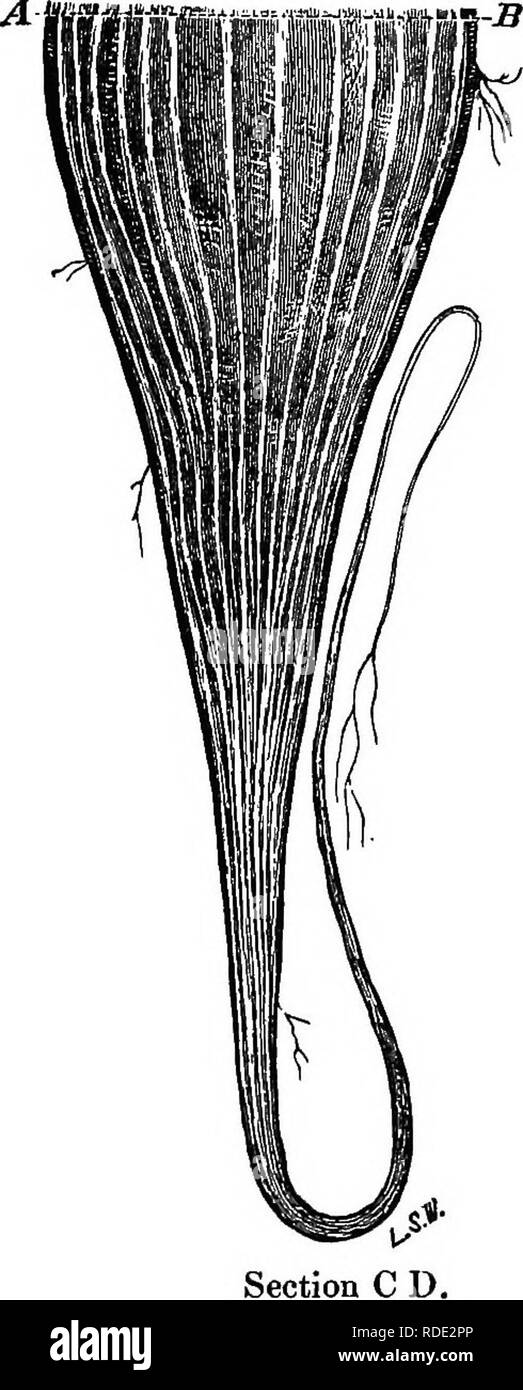 . The sugar beet : including a history of the beet sugar industry in Europe, varieties of the sugar beet, examination, soils, tillage, seeds and sowing, yield and cost of cultivation, harvesting, transportation, conservation, feeding qualities of the beet and of the pulp, etc. Sugar beet; Sugar beet; Sugar beet industry; Sugar beet industry; Beet sugar; Beet sugar; Beet sugar industry; Beet sugar industry. EXAMINATION 03? THE BEET. 85 little difference' in their saccharine composition. As for the mineral salts, etc., it is more striking. The amount of sulphuric acid is greatly in excess in the Stock Photohttps://www.alamy.com/image-license-details/?v=1https://www.alamy.com/the-sugar-beet-including-a-history-of-the-beet-sugar-industry-in-europe-varieties-of-the-sugar-beet-examination-soils-tillage-seeds-and-sowing-yield-and-cost-of-cultivation-harvesting-transportation-conservation-feeding-qualities-of-the-beet-and-of-the-pulp-etc-sugar-beet-sugar-beet-sugar-beet-industry-sugar-beet-industry-beet-sugar-beet-sugar-beet-sugar-industry-beet-sugar-industry-examination-03-the-beet-85-little-difference-in-their-saccharine-composition-as-for-the-mineral-salts-etc-it-is-more-striking-the-amount-of-sulphuric-acid-is-greatly-in-excess-in-the-image232034846.html
. The sugar beet : including a history of the beet sugar industry in Europe, varieties of the sugar beet, examination, soils, tillage, seeds and sowing, yield and cost of cultivation, harvesting, transportation, conservation, feeding qualities of the beet and of the pulp, etc. Sugar beet; Sugar beet; Sugar beet industry; Sugar beet industry; Beet sugar; Beet sugar; Beet sugar industry; Beet sugar industry. EXAMINATION 03? THE BEET. 85 little difference' in their saccharine composition. As for the mineral salts, etc., it is more striking. The amount of sulphuric acid is greatly in excess in the Stock Photohttps://www.alamy.com/image-license-details/?v=1https://www.alamy.com/the-sugar-beet-including-a-history-of-the-beet-sugar-industry-in-europe-varieties-of-the-sugar-beet-examination-soils-tillage-seeds-and-sowing-yield-and-cost-of-cultivation-harvesting-transportation-conservation-feeding-qualities-of-the-beet-and-of-the-pulp-etc-sugar-beet-sugar-beet-sugar-beet-industry-sugar-beet-industry-beet-sugar-beet-sugar-beet-sugar-industry-beet-sugar-industry-examination-03-the-beet-85-little-difference-in-their-saccharine-composition-as-for-the-mineral-salts-etc-it-is-more-striking-the-amount-of-sulphuric-acid-is-greatly-in-excess-in-the-image232034846.htmlRMRDE2PP–. The sugar beet : including a history of the beet sugar industry in Europe, varieties of the sugar beet, examination, soils, tillage, seeds and sowing, yield and cost of cultivation, harvesting, transportation, conservation, feeding qualities of the beet and of the pulp, etc. Sugar beet; Sugar beet; Sugar beet industry; Sugar beet industry; Beet sugar; Beet sugar; Beet sugar industry; Beet sugar industry. EXAMINATION 03? THE BEET. 85 little difference' in their saccharine composition. As for the mineral salts, etc., it is more striking. The amount of sulphuric acid is greatly in excess in the
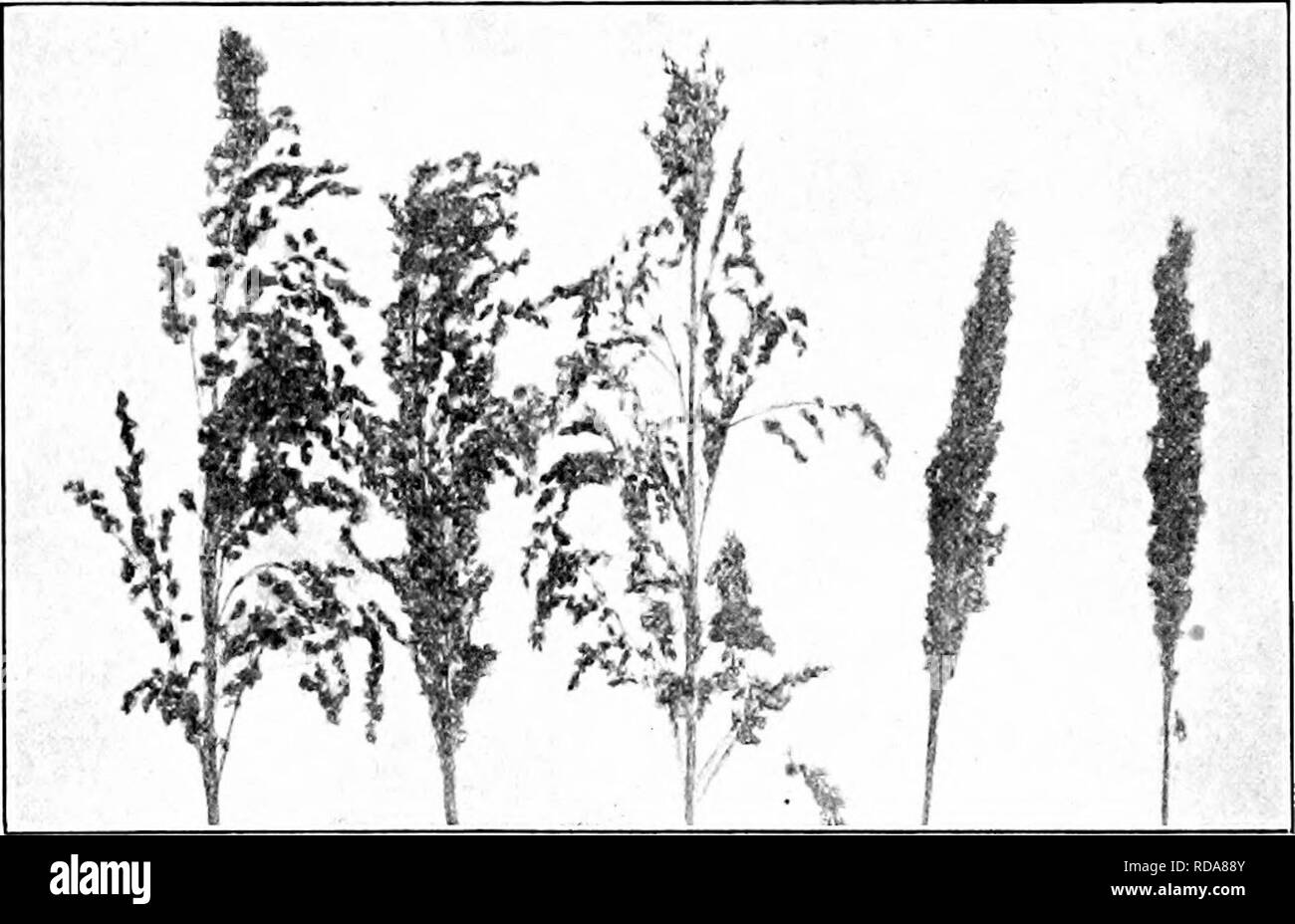 . Southern field crops (exclusive of forage plants). Agriculture. 234 SOUTHERN FIELD CHOPS Saccharine or Sweet Sorghums 214. Description and uses. — The sweet sorghums are 8 to 12 feet high, and are distinguished from other classes of sorghum by the great abundance of sweet juice in the stem. " Sugar millet" is a local name sometimes given to the sweet sorghmns, although this plant is not a millet. When the word " sorghum " is used alone, it usually refers to the sweet sorghum. This group is used for the production of sirup as well as for green and cured forage. It is treat Stock Photohttps://www.alamy.com/image-license-details/?v=1https://www.alamy.com/southern-field-crops-exclusive-of-forage-plants-agriculture-234-southern-field-chops-saccharine-or-sweet-sorghums-214-description-and-uses-the-sweet-sorghums-are-8-to-12-feet-high-and-are-distinguished-from-other-classes-of-sorghum-by-the-great-abundance-of-sweet-juice-in-the-stem-quot-sugar-milletquot-is-a-local-name-sometimes-given-to-the-sweet-sorghmns-although-this-plant-is-not-a-millet-when-the-word-quot-sorghum-quot-is-used-alone-it-usually-refers-to-the-sweet-sorghum-this-group-is-used-for-the-production-of-sirup-as-well-as-for-green-and-cured-forage-it-is-treat-image231951355.html
. Southern field crops (exclusive of forage plants). Agriculture. 234 SOUTHERN FIELD CHOPS Saccharine or Sweet Sorghums 214. Description and uses. — The sweet sorghums are 8 to 12 feet high, and are distinguished from other classes of sorghum by the great abundance of sweet juice in the stem. " Sugar millet" is a local name sometimes given to the sweet sorghmns, although this plant is not a millet. When the word " sorghum " is used alone, it usually refers to the sweet sorghum. This group is used for the production of sirup as well as for green and cured forage. It is treat Stock Photohttps://www.alamy.com/image-license-details/?v=1https://www.alamy.com/southern-field-crops-exclusive-of-forage-plants-agriculture-234-southern-field-chops-saccharine-or-sweet-sorghums-214-description-and-uses-the-sweet-sorghums-are-8-to-12-feet-high-and-are-distinguished-from-other-classes-of-sorghum-by-the-great-abundance-of-sweet-juice-in-the-stem-quot-sugar-milletquot-is-a-local-name-sometimes-given-to-the-sweet-sorghmns-although-this-plant-is-not-a-millet-when-the-word-quot-sorghum-quot-is-used-alone-it-usually-refers-to-the-sweet-sorghum-this-group-is-used-for-the-production-of-sirup-as-well-as-for-green-and-cured-forage-it-is-treat-image231951355.htmlRMRDA88Y–. Southern field crops (exclusive of forage plants). Agriculture. 234 SOUTHERN FIELD CHOPS Saccharine or Sweet Sorghums 214. Description and uses. — The sweet sorghums are 8 to 12 feet high, and are distinguished from other classes of sorghum by the great abundance of sweet juice in the stem. " Sugar millet" is a local name sometimes given to the sweet sorghmns, although this plant is not a millet. When the word " sorghum " is used alone, it usually refers to the sweet sorghum. This group is used for the production of sirup as well as for green and cured forage. It is treat
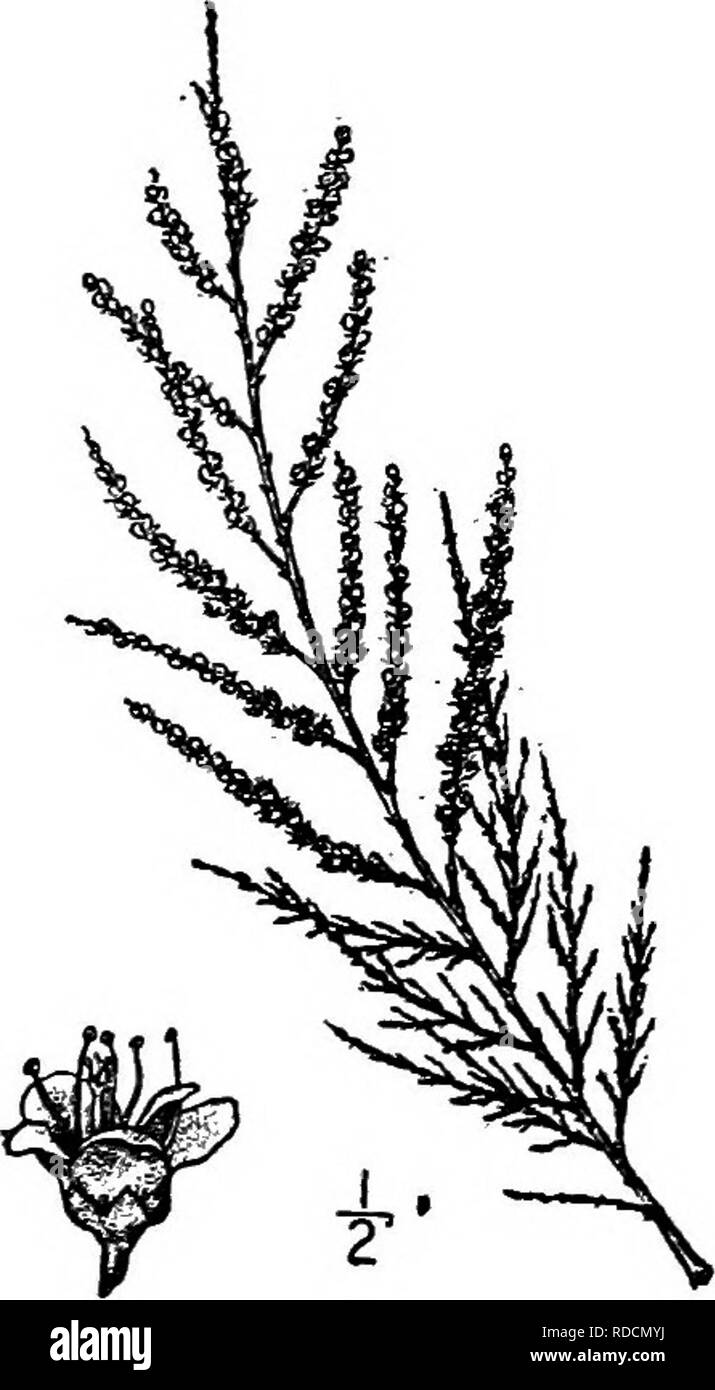 . North American trees : being descriptions and illustrations of the trees growing independently of cultivation in North America, north of Mexico and the West Indies . Trees. 702 Tamarisk Its wood is quite hard and tough, rather strong, coarse-grained, and light red- dish in color. The bark is sometimes used in tanning and dyeing, also the galls caused by the sting of a coleopterous insect, known as Mogador gaUs; these are a source of tannic acid, of which they contain about 40 per cent. A saccharine exudation of this or a closely related species in Arabia, also caused by the pimcture of an. F Stock Photohttps://www.alamy.com/image-license-details/?v=1https://www.alamy.com/north-american-trees-being-descriptions-and-illustrations-of-the-trees-growing-independently-of-cultivation-in-north-america-north-of-mexico-and-the-west-indies-trees-702-tamarisk-its-wood-is-quite-hard-and-tough-rather-strong-coarse-grained-and-light-red-dish-in-color-the-bark-is-sometimes-used-in-tanning-and-dyeing-also-the-galls-caused-by-the-sting-of-a-coleopterous-insect-known-as-mogador-gaus-these-are-a-source-of-tannic-acid-of-which-they-contain-about-40-per-cent-a-saccharine-exudation-of-this-or-a-closely-related-species-in-arabia-also-caused-by-the-pimcture-of-an-f-image232005190.html
. North American trees : being descriptions and illustrations of the trees growing independently of cultivation in North America, north of Mexico and the West Indies . Trees. 702 Tamarisk Its wood is quite hard and tough, rather strong, coarse-grained, and light red- dish in color. The bark is sometimes used in tanning and dyeing, also the galls caused by the sting of a coleopterous insect, known as Mogador gaUs; these are a source of tannic acid, of which they contain about 40 per cent. A saccharine exudation of this or a closely related species in Arabia, also caused by the pimcture of an. F Stock Photohttps://www.alamy.com/image-license-details/?v=1https://www.alamy.com/north-american-trees-being-descriptions-and-illustrations-of-the-trees-growing-independently-of-cultivation-in-north-america-north-of-mexico-and-the-west-indies-trees-702-tamarisk-its-wood-is-quite-hard-and-tough-rather-strong-coarse-grained-and-light-red-dish-in-color-the-bark-is-sometimes-used-in-tanning-and-dyeing-also-the-galls-caused-by-the-sting-of-a-coleopterous-insect-known-as-mogador-gaus-these-are-a-source-of-tannic-acid-of-which-they-contain-about-40-per-cent-a-saccharine-exudation-of-this-or-a-closely-related-species-in-arabia-also-caused-by-the-pimcture-of-an-f-image232005190.htmlRMRDCMYJ–. North American trees : being descriptions and illustrations of the trees growing independently of cultivation in North America, north of Mexico and the West Indies . Trees. 702 Tamarisk Its wood is quite hard and tough, rather strong, coarse-grained, and light red- dish in color. The bark is sometimes used in tanning and dyeing, also the galls caused by the sting of a coleopterous insect, known as Mogador gaUs; these are a source of tannic acid, of which they contain about 40 per cent. A saccharine exudation of this or a closely related species in Arabia, also caused by the pimcture of an. F
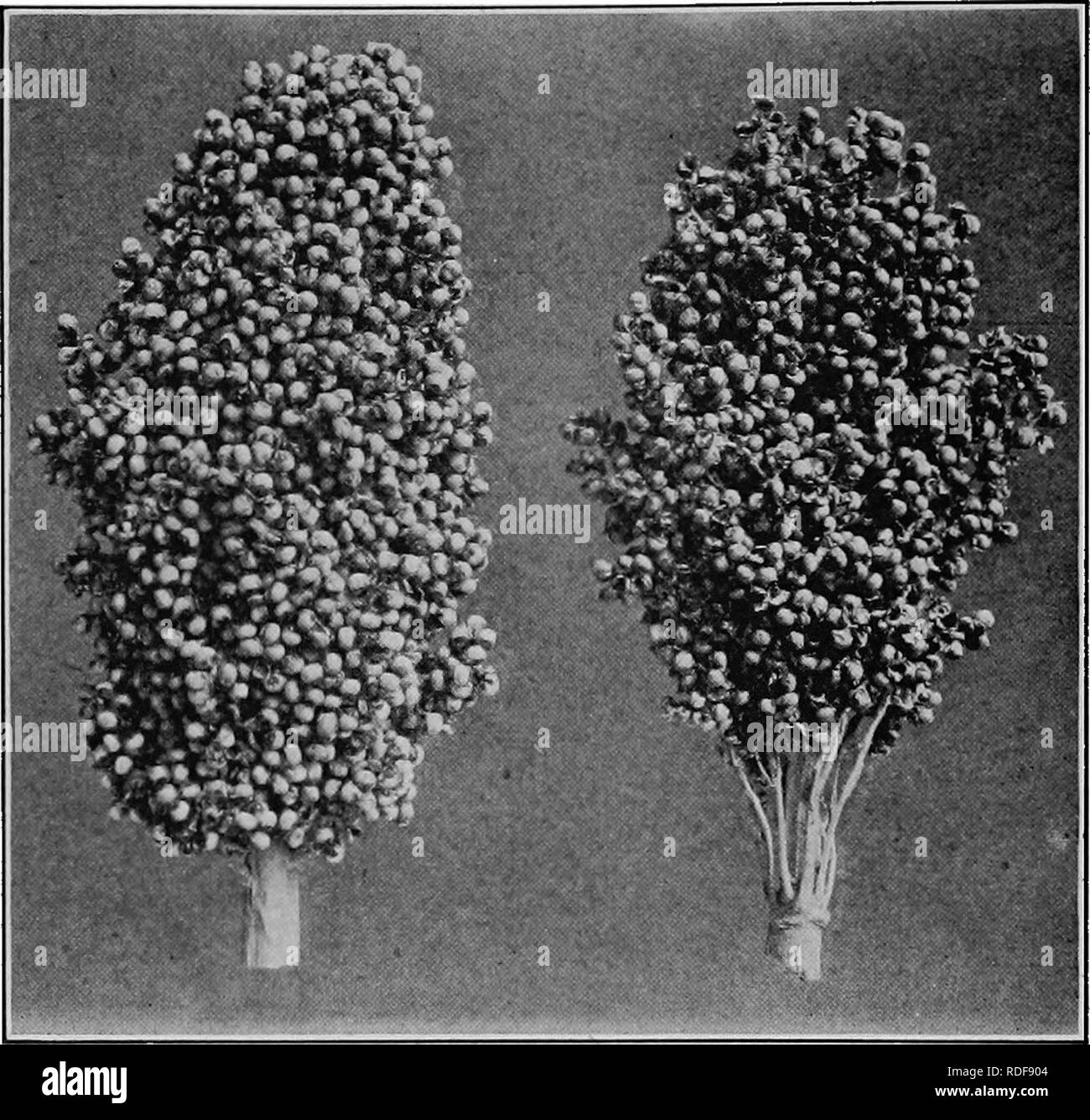 . Field crops for the cotton-belt. Agriculture. 378 FIELD CROPS FOR THE COTTON^BELT bagged each year and used for planting the breeding-plot of the next year. The quaUties selected for in improving the saccharine. Fig. 63. — Two heads of Milo showing desirable form (on left) and unde- sirable form (on right). sorghums are juiciness and high sugar content, yield, disease-resistance, drought-resistance, and erecfoess. In the improvement of the grain-sorghums the prin- cipal considerations should be (1) increased grain produc- tion; (2) increased drought-resistance; (3) increased earli- ness; (4) Stock Photohttps://www.alamy.com/image-license-details/?v=1https://www.alamy.com/field-crops-for-the-cotton-belt-agriculture-378-field-crops-for-the-cottonbelt-bagged-each-year-and-used-for-planting-the-breeding-plot-of-the-next-year-the-quauties-selected-for-in-improving-the-saccharine-fig-63-two-heads-of-milo-showing-desirable-form-on-left-and-unde-sirable-form-on-right-sorghums-are-juiciness-and-high-sugar-content-yield-disease-resistance-drought-resistance-and-erecfoess-in-the-improvement-of-the-grain-sorghums-the-prin-cipal-considerations-should-be-1-increased-grain-produc-tion-2-increased-drought-resistance-3-increased-earli-ness-4-image232061652.html
. Field crops for the cotton-belt. Agriculture. 378 FIELD CROPS FOR THE COTTON^BELT bagged each year and used for planting the breeding-plot of the next year. The quaUties selected for in improving the saccharine. Fig. 63. — Two heads of Milo showing desirable form (on left) and unde- sirable form (on right). sorghums are juiciness and high sugar content, yield, disease-resistance, drought-resistance, and erecfoess. In the improvement of the grain-sorghums the prin- cipal considerations should be (1) increased grain produc- tion; (2) increased drought-resistance; (3) increased earli- ness; (4) Stock Photohttps://www.alamy.com/image-license-details/?v=1https://www.alamy.com/field-crops-for-the-cotton-belt-agriculture-378-field-crops-for-the-cottonbelt-bagged-each-year-and-used-for-planting-the-breeding-plot-of-the-next-year-the-quauties-selected-for-in-improving-the-saccharine-fig-63-two-heads-of-milo-showing-desirable-form-on-left-and-unde-sirable-form-on-right-sorghums-are-juiciness-and-high-sugar-content-yield-disease-resistance-drought-resistance-and-erecfoess-in-the-improvement-of-the-grain-sorghums-the-prin-cipal-considerations-should-be-1-increased-grain-produc-tion-2-increased-drought-resistance-3-increased-earli-ness-4-image232061652.htmlRMRDF904–. Field crops for the cotton-belt. Agriculture. 378 FIELD CROPS FOR THE COTTON^BELT bagged each year and used for planting the breeding-plot of the next year. The quaUties selected for in improving the saccharine. Fig. 63. — Two heads of Milo showing desirable form (on left) and unde- sirable form (on right). sorghums are juiciness and high sugar content, yield, disease-resistance, drought-resistance, and erecfoess. In the improvement of the grain-sorghums the prin- cipal considerations should be (1) increased grain produc- tion; (2) increased drought-resistance; (3) increased earli- ness; (4)
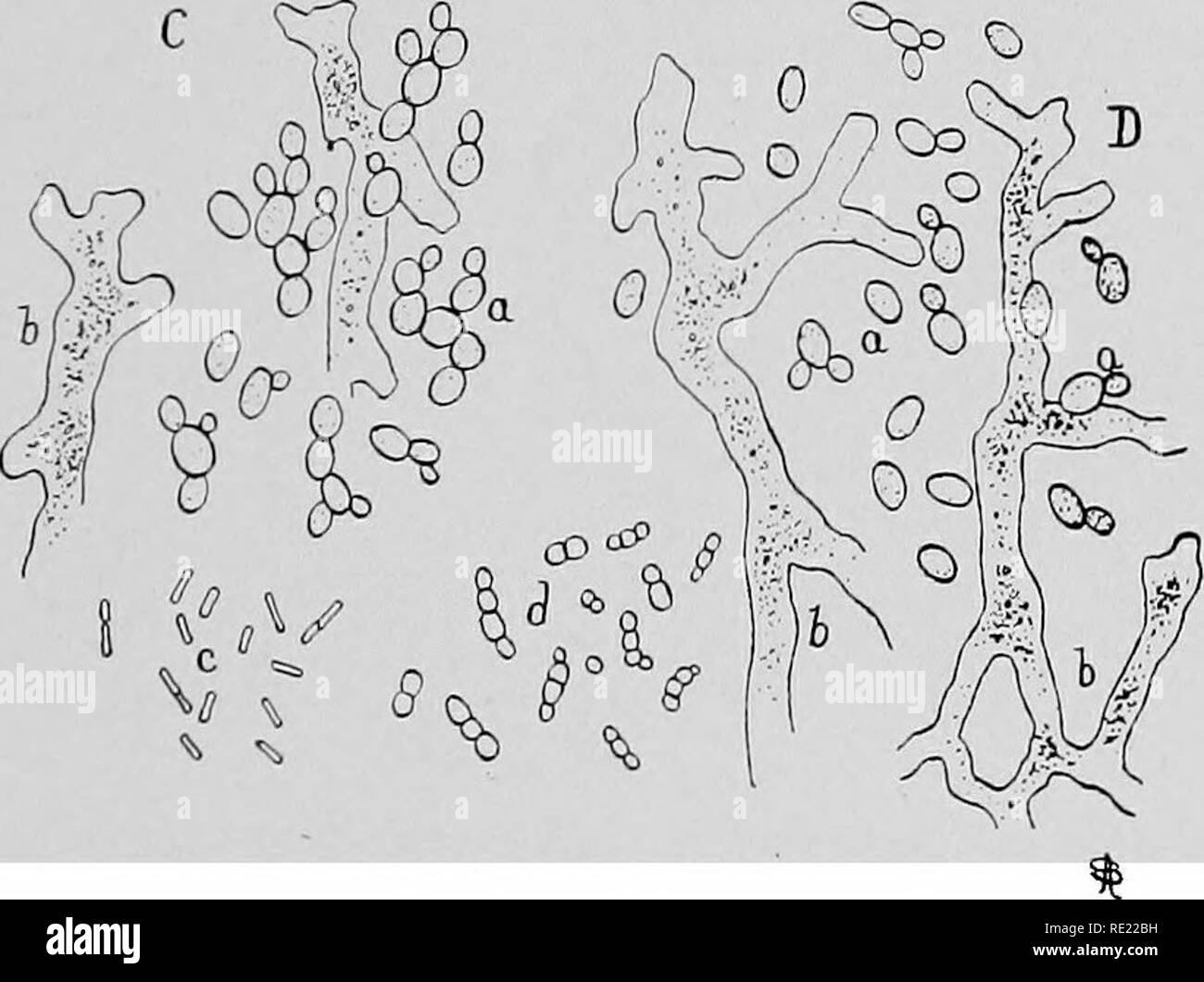 . Pharmaceutical bacteriology, with special reference to disinfection and sterilization. Bacteriology. C&-, 0 . .^ ©. Fig. 72.—Sake making. A, Dead or dying yeast cells; B, active yeast cells which convert the saccharine substances formed by the aspergiUus into alcohol. C, D, yeast cells and hyphae of aspergillus frona the fermenting vats. The Japanese soya sauce (fermented soya beans, Glycine hispidus) and miso, a soup stock of wheat and soya beans, is prepared through the action of Aspergillus oryza and A. wentii. The Javanese arrak is made from rice which is first acted upon by a fungus Stock Photohttps://www.alamy.com/image-license-details/?v=1https://www.alamy.com/pharmaceutical-bacteriology-with-special-reference-to-disinfection-and-sterilization-bacteriology-camp-0-fig-72sake-making-a-dead-or-dying-yeast-cells-b-active-yeast-cells-which-convert-the-saccharine-substances-formed-by-the-aspergiuus-into-alcohol-c-d-yeast-cells-and-hyphae-of-aspergillus-frona-the-fermenting-vats-the-japanese-soya-sauce-fermented-soya-beans-glycine-hispidus-and-miso-a-soup-stock-of-wheat-and-soya-beans-is-prepared-through-the-action-of-aspergillus-oryza-and-a-wentii-the-javanese-arrak-is-made-from-rice-which-is-first-acted-upon-by-a-fungus-image232385765.html
. Pharmaceutical bacteriology, with special reference to disinfection and sterilization. Bacteriology. C&-, 0 . .^ ©. Fig. 72.—Sake making. A, Dead or dying yeast cells; B, active yeast cells which convert the saccharine substances formed by the aspergiUus into alcohol. C, D, yeast cells and hyphae of aspergillus frona the fermenting vats. The Japanese soya sauce (fermented soya beans, Glycine hispidus) and miso, a soup stock of wheat and soya beans, is prepared through the action of Aspergillus oryza and A. wentii. The Javanese arrak is made from rice which is first acted upon by a fungus Stock Photohttps://www.alamy.com/image-license-details/?v=1https://www.alamy.com/pharmaceutical-bacteriology-with-special-reference-to-disinfection-and-sterilization-bacteriology-camp-0-fig-72sake-making-a-dead-or-dying-yeast-cells-b-active-yeast-cells-which-convert-the-saccharine-substances-formed-by-the-aspergiuus-into-alcohol-c-d-yeast-cells-and-hyphae-of-aspergillus-frona-the-fermenting-vats-the-japanese-soya-sauce-fermented-soya-beans-glycine-hispidus-and-miso-a-soup-stock-of-wheat-and-soya-beans-is-prepared-through-the-action-of-aspergillus-oryza-and-a-wentii-the-javanese-arrak-is-made-from-rice-which-is-first-acted-upon-by-a-fungus-image232385765.htmlRMRE22BH–. Pharmaceutical bacteriology, with special reference to disinfection and sterilization. Bacteriology. C&-, 0 . .^ ©. Fig. 72.—Sake making. A, Dead or dying yeast cells; B, active yeast cells which convert the saccharine substances formed by the aspergiUus into alcohol. C, D, yeast cells and hyphae of aspergillus frona the fermenting vats. The Japanese soya sauce (fermented soya beans, Glycine hispidus) and miso, a soup stock of wheat and soya beans, is prepared through the action of Aspergillus oryza and A. wentii. The Javanese arrak is made from rice which is first acted upon by a fungus
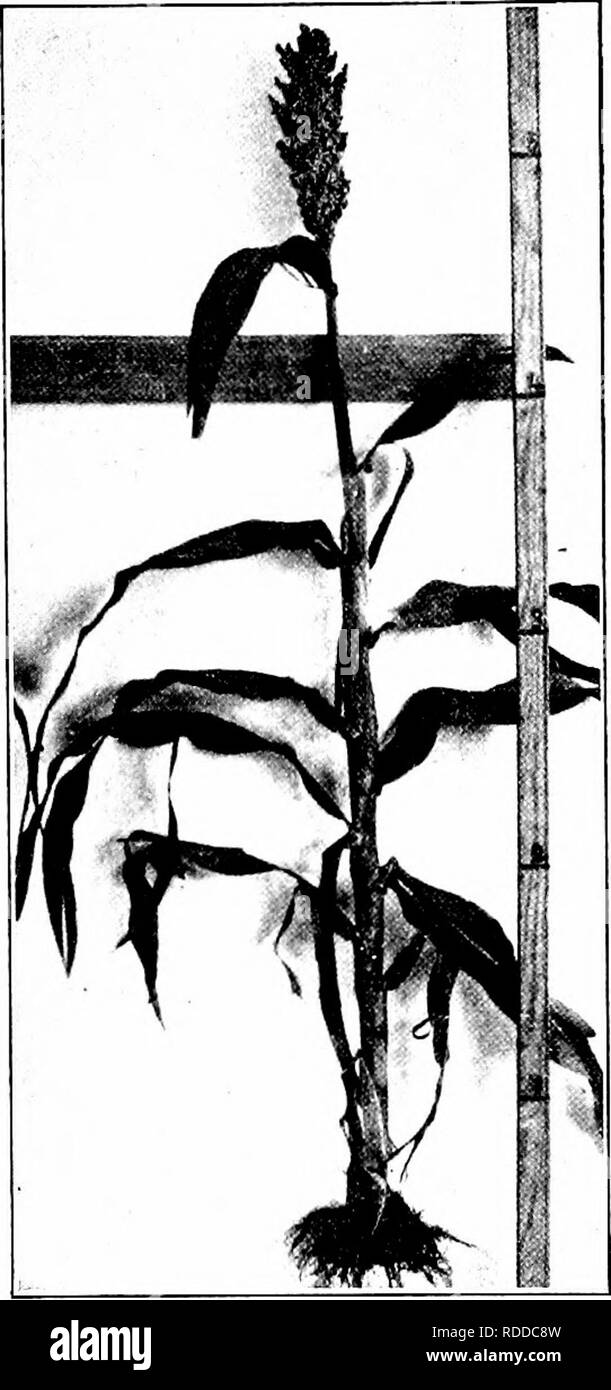 . The corn crops: a discussion of maize, kafirs, and sorghums as grown in the United States and Canada. Corn; Kafir corn; Sorghum. 310 CORN CROPS be a later introduction, having attracted attention about 1896. It had aU the good qualities of Red Kafir, and in addition the seed was not astringent. This variety probably furnishes nine- tenths of the kafir crop to-day, and Red Kafir the other tenth. 238. Durra. — The char- acteristics of this group are that the heads are mostly " goosenecked " and the seeds are large and flat. The extensive culture of non-saccharine sorghums in this cou Stock Photohttps://www.alamy.com/image-license-details/?v=1https://www.alamy.com/the-corn-crops-a-discussion-of-maize-kafirs-and-sorghums-as-grown-in-the-united-states-and-canada-corn-kafir-corn-sorghum-310-corn-crops-be-a-later-introduction-having-attracted-attention-about-1896-it-had-au-the-good-qualities-of-red-kafir-and-in-addition-the-seed-was-not-astringent-this-variety-probably-furnishes-nine-tenths-of-the-kafir-crop-to-day-and-red-kafir-the-other-tenth-238-durra-the-char-acteristics-of-this-group-are-that-the-heads-are-mostly-quot-goosenecked-quot-and-the-seeds-are-large-and-flat-the-extensive-culture-of-non-saccharine-sorghums-in-this-cou-image232020345.html
. The corn crops: a discussion of maize, kafirs, and sorghums as grown in the United States and Canada. Corn; Kafir corn; Sorghum. 310 CORN CROPS be a later introduction, having attracted attention about 1896. It had aU the good qualities of Red Kafir, and in addition the seed was not astringent. This variety probably furnishes nine- tenths of the kafir crop to-day, and Red Kafir the other tenth. 238. Durra. — The char- acteristics of this group are that the heads are mostly " goosenecked " and the seeds are large and flat. The extensive culture of non-saccharine sorghums in this cou Stock Photohttps://www.alamy.com/image-license-details/?v=1https://www.alamy.com/the-corn-crops-a-discussion-of-maize-kafirs-and-sorghums-as-grown-in-the-united-states-and-canada-corn-kafir-corn-sorghum-310-corn-crops-be-a-later-introduction-having-attracted-attention-about-1896-it-had-au-the-good-qualities-of-red-kafir-and-in-addition-the-seed-was-not-astringent-this-variety-probably-furnishes-nine-tenths-of-the-kafir-crop-to-day-and-red-kafir-the-other-tenth-238-durra-the-char-acteristics-of-this-group-are-that-the-heads-are-mostly-quot-goosenecked-quot-and-the-seeds-are-large-and-flat-the-extensive-culture-of-non-saccharine-sorghums-in-this-cou-image232020345.htmlRMRDDC8W–. The corn crops: a discussion of maize, kafirs, and sorghums as grown in the United States and Canada. Corn; Kafir corn; Sorghum. 310 CORN CROPS be a later introduction, having attracted attention about 1896. It had aU the good qualities of Red Kafir, and in addition the seed was not astringent. This variety probably furnishes nine- tenths of the kafir crop to-day, and Red Kafir the other tenth. 238. Durra. — The char- acteristics of this group are that the heads are mostly " goosenecked " and the seeds are large and flat. The extensive culture of non-saccharine sorghums in this cou
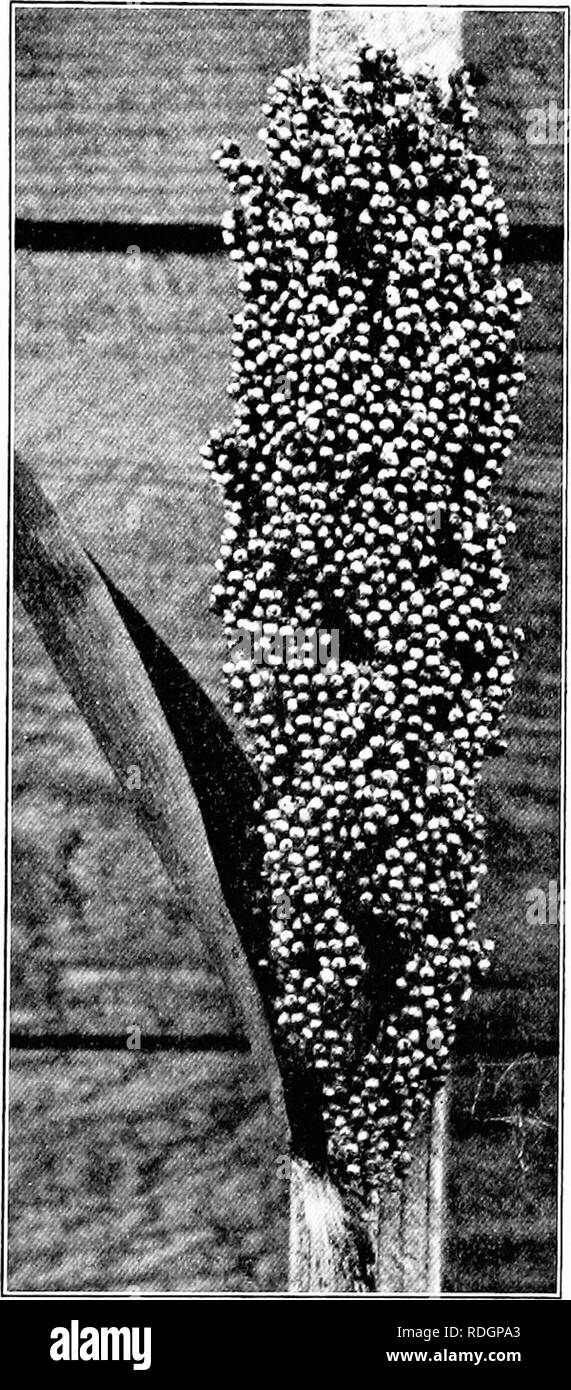 . The corn crops: a discussion of maize, kafirs, and sorghums as grown in the United States and Canada. Corn; Kafir corn; Sorghum. TB.E NON-SACCHARINE SORGHUMS 311 and Brown Durras was estimated at 50,000 to 60,000 acres in 1908.1 239. Milo, or Yellow Milo, was introduced about 1885, ten years later than the White and Brown Dur- ras, but it quickly be- came the most popular of the group, the area in 1908 being estimated at 300,000 acres. This variety will mature in 90 to 100 days and is adapted to culture as far north as south- western Nebraska. In addition to the standard varieties, there is Stock Photohttps://www.alamy.com/image-license-details/?v=1https://www.alamy.com/the-corn-crops-a-discussion-of-maize-kafirs-and-sorghums-as-grown-in-the-united-states-and-canada-corn-kafir-corn-sorghum-tbe-non-saccharine-sorghums-311-and-brown-durras-was-estimated-at-50000-to-60000-acres-in-19081-239-milo-or-yellow-milo-was-introduced-about-1885-ten-years-later-than-the-white-and-brown-dur-ras-but-it-quickly-be-came-the-most-popular-of-the-group-the-area-in-1908-being-estimated-at-300000-acres-this-variety-will-mature-in-90-to-100-days-and-is-adapted-to-culture-as-far-north-as-south-western-nebraska-in-addition-to-the-standard-varieties-there-is-image232094075.html
. The corn crops: a discussion of maize, kafirs, and sorghums as grown in the United States and Canada. Corn; Kafir corn; Sorghum. TB.E NON-SACCHARINE SORGHUMS 311 and Brown Durras was estimated at 50,000 to 60,000 acres in 1908.1 239. Milo, or Yellow Milo, was introduced about 1885, ten years later than the White and Brown Dur- ras, but it quickly be- came the most popular of the group, the area in 1908 being estimated at 300,000 acres. This variety will mature in 90 to 100 days and is adapted to culture as far north as south- western Nebraska. In addition to the standard varieties, there is Stock Photohttps://www.alamy.com/image-license-details/?v=1https://www.alamy.com/the-corn-crops-a-discussion-of-maize-kafirs-and-sorghums-as-grown-in-the-united-states-and-canada-corn-kafir-corn-sorghum-tbe-non-saccharine-sorghums-311-and-brown-durras-was-estimated-at-50000-to-60000-acres-in-19081-239-milo-or-yellow-milo-was-introduced-about-1885-ten-years-later-than-the-white-and-brown-dur-ras-but-it-quickly-be-came-the-most-popular-of-the-group-the-area-in-1908-being-estimated-at-300000-acres-this-variety-will-mature-in-90-to-100-days-and-is-adapted-to-culture-as-far-north-as-south-western-nebraska-in-addition-to-the-standard-varieties-there-is-image232094075.htmlRMRDGPA3–. The corn crops: a discussion of maize, kafirs, and sorghums as grown in the United States and Canada. Corn; Kafir corn; Sorghum. TB.E NON-SACCHARINE SORGHUMS 311 and Brown Durras was estimated at 50,000 to 60,000 acres in 1908.1 239. Milo, or Yellow Milo, was introduced about 1885, ten years later than the White and Brown Dur- ras, but it quickly be- came the most popular of the group, the area in 1908 being estimated at 300,000 acres. This variety will mature in 90 to 100 days and is adapted to culture as far north as south- western Nebraska. In addition to the standard varieties, there is
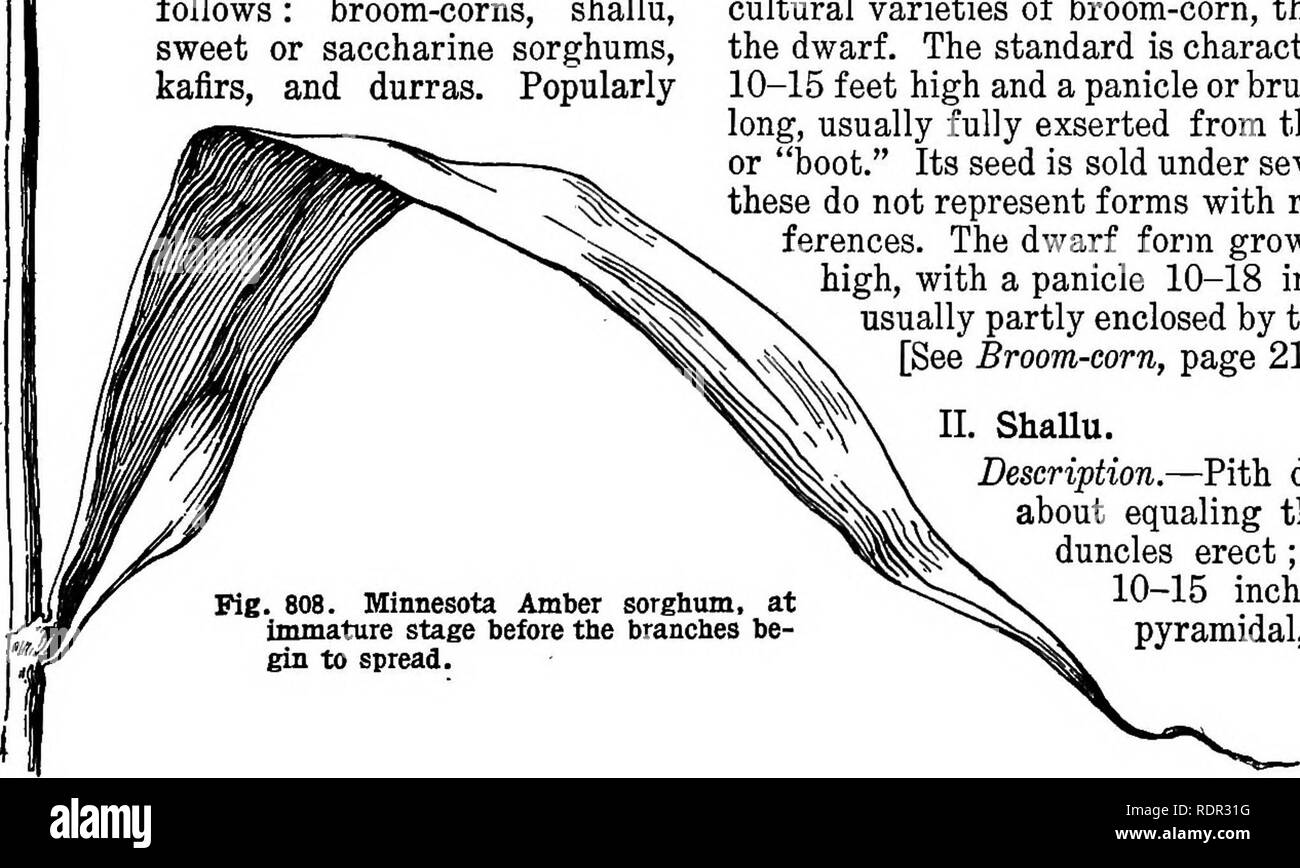 . Cyclopedia of farm crops, a popular survey of crops and crop-making methods in the United States and Canada;. Farm produce; Agriculture. ' some of the kafirs have a fairly sweet juice and could doubtless be developed into saccharine varieties. The term kaoliang, mentioned on page 572, designates Chinese varieties in general, it being the Chinese name for sorghums. KEY TO GROUPS A. Pith dry: Head loose, 10-28 inches long; spikelets oval or obovate, small: Rachis very short; seeds reddish Eaohis as long as head ; seeds white or pearly . Head compact, 4-9 inches long; spikelets broadly obovate, Stock Photohttps://www.alamy.com/image-license-details/?v=1https://www.alamy.com/cyclopedia-of-farm-crops-a-popular-survey-of-crops-and-crop-making-methods-in-the-united-states-and-canada-farm-produce-agriculture-some-of-the-kafirs-have-a-fairly-sweet-juice-and-could-doubtless-be-developed-into-saccharine-varieties-the-term-kaoliang-mentioned-on-page-572-designates-chinese-varieties-in-general-it-being-the-chinese-name-for-sorghums-key-to-groups-a-pith-dry-head-loose-10-28-inches-long-spikelets-oval-or-obovate-small-rachis-very-short-seeds-reddish-eaohis-as-long-as-head-seeds-white-or-pearly-head-compact-4-9-inches-long-spikelets-broadly-obovate-image232232604.html
. Cyclopedia of farm crops, a popular survey of crops and crop-making methods in the United States and Canada;. Farm produce; Agriculture. ' some of the kafirs have a fairly sweet juice and could doubtless be developed into saccharine varieties. The term kaoliang, mentioned on page 572, designates Chinese varieties in general, it being the Chinese name for sorghums. KEY TO GROUPS A. Pith dry: Head loose, 10-28 inches long; spikelets oval or obovate, small: Rachis very short; seeds reddish Eaohis as long as head ; seeds white or pearly . Head compact, 4-9 inches long; spikelets broadly obovate, Stock Photohttps://www.alamy.com/image-license-details/?v=1https://www.alamy.com/cyclopedia-of-farm-crops-a-popular-survey-of-crops-and-crop-making-methods-in-the-united-states-and-canada-farm-produce-agriculture-some-of-the-kafirs-have-a-fairly-sweet-juice-and-could-doubtless-be-developed-into-saccharine-varieties-the-term-kaoliang-mentioned-on-page-572-designates-chinese-varieties-in-general-it-being-the-chinese-name-for-sorghums-key-to-groups-a-pith-dry-head-loose-10-28-inches-long-spikelets-oval-or-obovate-small-rachis-very-short-seeds-reddish-eaohis-as-long-as-head-seeds-white-or-pearly-head-compact-4-9-inches-long-spikelets-broadly-obovate-image232232604.htmlRMRDR31G–. Cyclopedia of farm crops, a popular survey of crops and crop-making methods in the United States and Canada;. Farm produce; Agriculture. ' some of the kafirs have a fairly sweet juice and could doubtless be developed into saccharine varieties. The term kaoliang, mentioned on page 572, designates Chinese varieties in general, it being the Chinese name for sorghums. KEY TO GROUPS A. Pith dry: Head loose, 10-28 inches long; spikelets oval or obovate, small: Rachis very short; seeds reddish Eaohis as long as head ; seeds white or pearly . Head compact, 4-9 inches long; spikelets broadly obovate,
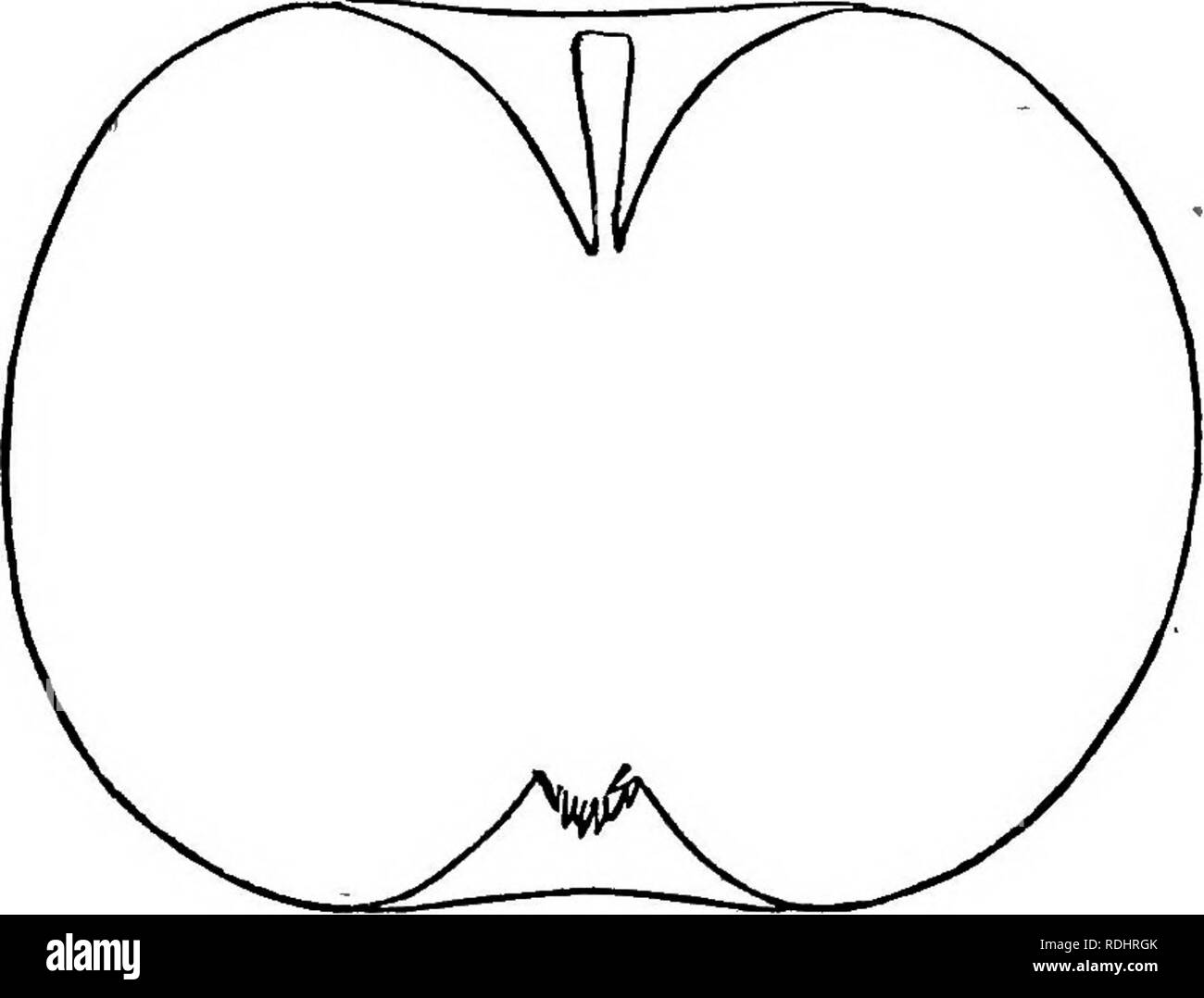 . The fruits and fruit trees of America : or, The culture, propagation and management, in the garden and orchard, of fruit trees generally, with descriptions of all the finest varieties of fruit, native and foreign, cultivated in this country . Fruit-culture; Fruit. APPLES. 77 Evening Party, Origin Berks Co, Pa. Fruit small or medium, oblate, sligt tly ipclining to oval. Skin yellow chiefly, shaded and sometimes. mg Pa/iiy. stripped with red. Stem short, inserted in a round, deep cavity, sometimes russeted. Calyx closed, basin large. Flesh juicy, tender, crisp, with a brisk saccharine, somewha Stock Photohttps://www.alamy.com/image-license-details/?v=1https://www.alamy.com/the-fruits-and-fruit-trees-of-america-or-the-culture-propagation-and-management-in-the-garden-and-orchard-of-fruit-trees-generally-with-descriptions-of-all-the-finest-varieties-of-fruit-native-and-foreign-cultivated-in-this-country-fruit-culture-fruit-apples-77-evening-party-origin-berks-co-pa-fruit-small-or-medium-oblate-sligt-tly-ipclining-to-oval-skin-yellow-chiefly-shaded-and-sometimes-mg-paiiy-stripped-with-red-stem-short-inserted-in-a-round-deep-cavity-sometimes-russeted-calyx-closed-basin-large-flesh-juicy-tender-crisp-with-a-brisk-saccharine-somewha-image232116995.html
. The fruits and fruit trees of America : or, The culture, propagation and management, in the garden and orchard, of fruit trees generally, with descriptions of all the finest varieties of fruit, native and foreign, cultivated in this country . Fruit-culture; Fruit. APPLES. 77 Evening Party, Origin Berks Co, Pa. Fruit small or medium, oblate, sligt tly ipclining to oval. Skin yellow chiefly, shaded and sometimes. mg Pa/iiy. stripped with red. Stem short, inserted in a round, deep cavity, sometimes russeted. Calyx closed, basin large. Flesh juicy, tender, crisp, with a brisk saccharine, somewha Stock Photohttps://www.alamy.com/image-license-details/?v=1https://www.alamy.com/the-fruits-and-fruit-trees-of-america-or-the-culture-propagation-and-management-in-the-garden-and-orchard-of-fruit-trees-generally-with-descriptions-of-all-the-finest-varieties-of-fruit-native-and-foreign-cultivated-in-this-country-fruit-culture-fruit-apples-77-evening-party-origin-berks-co-pa-fruit-small-or-medium-oblate-sligt-tly-ipclining-to-oval-skin-yellow-chiefly-shaded-and-sometimes-mg-paiiy-stripped-with-red-stem-short-inserted-in-a-round-deep-cavity-sometimes-russeted-calyx-closed-basin-large-flesh-juicy-tender-crisp-with-a-brisk-saccharine-somewha-image232116995.htmlRMRDHRGK–. The fruits and fruit trees of America : or, The culture, propagation and management, in the garden and orchard, of fruit trees generally, with descriptions of all the finest varieties of fruit, native and foreign, cultivated in this country . Fruit-culture; Fruit. APPLES. 77 Evening Party, Origin Berks Co, Pa. Fruit small or medium, oblate, sligt tly ipclining to oval. Skin yellow chiefly, shaded and sometimes. mg Pa/iiy. stripped with red. Stem short, inserted in a round, deep cavity, sometimes russeted. Calyx closed, basin large. Flesh juicy, tender, crisp, with a brisk saccharine, somewha
 . The corn crops: a discussion of maize, kafirs, and sorghums as grown in the United States and Canada. Corn; Kafir corn; Sorghum. THE NON-SACCHARINE SORGHUMS 313. â â %»$*'ji«^ wide range of conditions, and this plant, together with Blackhull Kafir, is the best of the sorghums for grain production. The milos, being about three weeks earher in maturing than the kafirs, have two distinct advan- tages : in Oklahoma and Texas they can be planted early and will more nearly ma- ture before the severe midsummer drought; also, they may be grown farther north and at higher alti- tudes. 240. Shallu.â Stock Photohttps://www.alamy.com/image-license-details/?v=1https://www.alamy.com/the-corn-crops-a-discussion-of-maize-kafirs-and-sorghums-as-grown-in-the-united-states-and-canada-corn-kafir-corn-sorghum-the-non-saccharine-sorghums-313-ji-wide-range-of-conditions-and-this-plant-together-with-blackhull-kafir-is-the-best-of-the-sorghums-for-grain-production-the-milos-being-about-three-weeks-earher-in-maturing-than-the-kafirs-have-two-distinct-advan-tages-in-oklahoma-and-texas-they-can-be-planted-early-and-will-more-nearly-ma-ture-before-the-severe-midsummer-drought-also-they-may-be-grown-farther-north-and-at-higher-alti-tudes-240-shallu-image232020315.html
. The corn crops: a discussion of maize, kafirs, and sorghums as grown in the United States and Canada. Corn; Kafir corn; Sorghum. THE NON-SACCHARINE SORGHUMS 313. â â %»$*'ji«^ wide range of conditions, and this plant, together with Blackhull Kafir, is the best of the sorghums for grain production. The milos, being about three weeks earher in maturing than the kafirs, have two distinct advan- tages : in Oklahoma and Texas they can be planted early and will more nearly ma- ture before the severe midsummer drought; also, they may be grown farther north and at higher alti- tudes. 240. Shallu.â Stock Photohttps://www.alamy.com/image-license-details/?v=1https://www.alamy.com/the-corn-crops-a-discussion-of-maize-kafirs-and-sorghums-as-grown-in-the-united-states-and-canada-corn-kafir-corn-sorghum-the-non-saccharine-sorghums-313-ji-wide-range-of-conditions-and-this-plant-together-with-blackhull-kafir-is-the-best-of-the-sorghums-for-grain-production-the-milos-being-about-three-weeks-earher-in-maturing-than-the-kafirs-have-two-distinct-advan-tages-in-oklahoma-and-texas-they-can-be-planted-early-and-will-more-nearly-ma-ture-before-the-severe-midsummer-drought-also-they-may-be-grown-farther-north-and-at-higher-alti-tudes-240-shallu-image232020315.htmlRMRDDC7R–. The corn crops: a discussion of maize, kafirs, and sorghums as grown in the United States and Canada. Corn; Kafir corn; Sorghum. THE NON-SACCHARINE SORGHUMS 313. â â %»$*'ji«^ wide range of conditions, and this plant, together with Blackhull Kafir, is the best of the sorghums for grain production. The milos, being about three weeks earher in maturing than the kafirs, have two distinct advan- tages : in Oklahoma and Texas they can be planted early and will more nearly ma- ture before the severe midsummer drought; also, they may be grown farther north and at higher alti- tudes. 240. Shallu.â
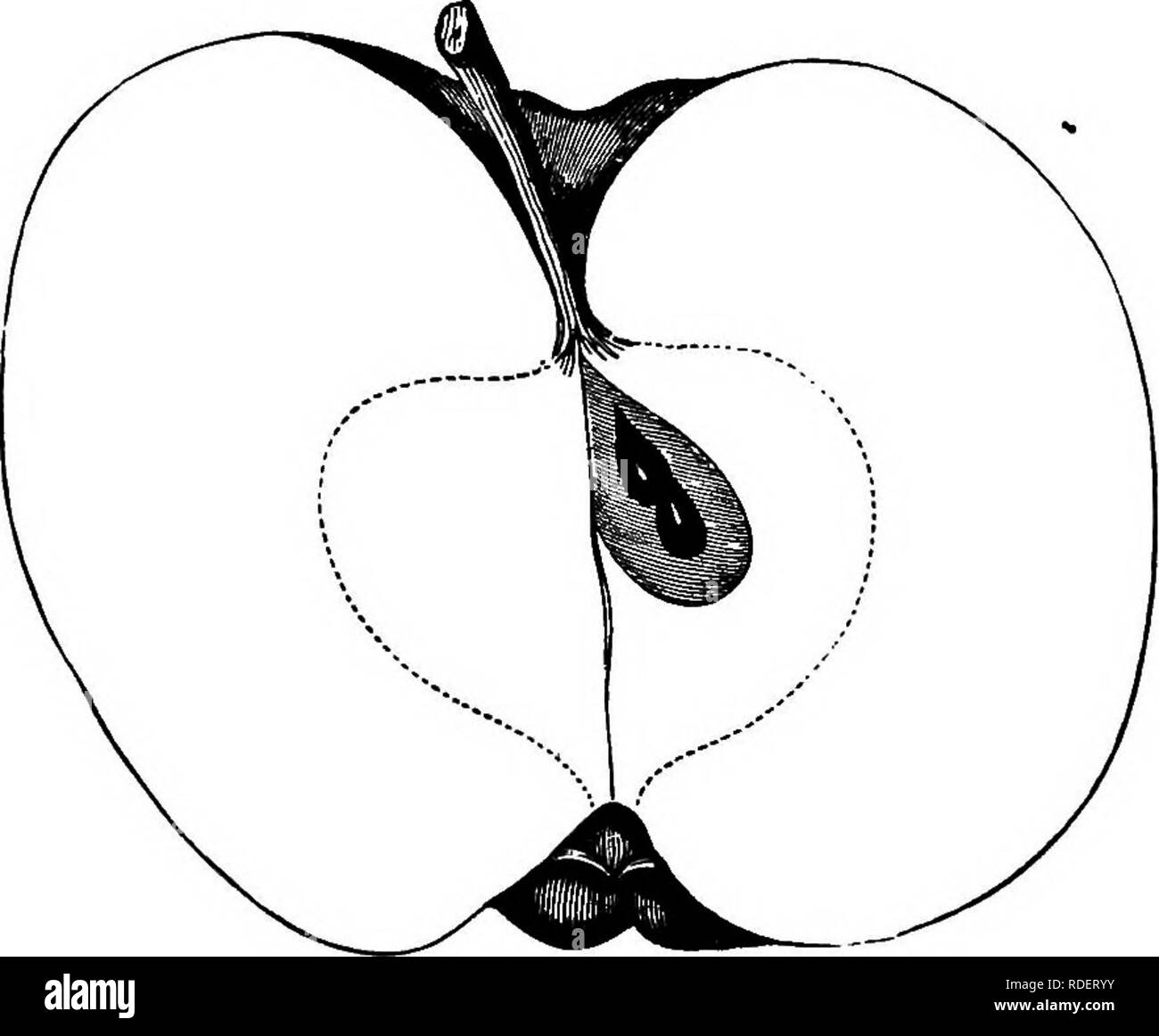 . American pomology : apples . Apples. 474 DESCBIPnONS OF APPLES. mostly shaded with crimson, sprinkled with gray or green- ish dots; Stalk short, inserted into a large cavity surround- ed by russet; Calyx open, set in a deep, irregular basin; Flesh rich, pleasant, vinous, almost saccharine." — [Downing. Spice Siireeting. The specimens described were from Mr. Warren, of Massachusetts. Others, found in Ohio and Bliaois under this name, have a deep, abrupt basin, large or long eye, and yellow flesh; they must be different fruits. An old variety; Tree vigorous, productive. Fruit full medium Stock Photohttps://www.alamy.com/image-license-details/?v=1https://www.alamy.com/american-pomology-apples-apples-474-descbipnons-of-apples-mostly-shaded-with-crimson-sprinkled-with-gray-or-green-ish-dots-stalk-short-inserted-into-a-large-cavity-surround-ed-by-russet-calyx-open-set-in-a-deep-irregular-basin-flesh-rich-pleasant-vinous-almost-saccharinequot-downing-spice-siireeting-the-specimens-described-were-from-mr-warren-of-massachusetts-others-found-in-ohio-and-bliaois-under-this-name-have-a-deep-abrupt-basin-large-or-long-eye-and-yellow-flesh-they-must-be-different-fruits-an-old-variety-tree-vigorous-productive-fruit-full-medium-image232051455.html
. American pomology : apples . Apples. 474 DESCBIPnONS OF APPLES. mostly shaded with crimson, sprinkled with gray or green- ish dots; Stalk short, inserted into a large cavity surround- ed by russet; Calyx open, set in a deep, irregular basin; Flesh rich, pleasant, vinous, almost saccharine." — [Downing. Spice Siireeting. The specimens described were from Mr. Warren, of Massachusetts. Others, found in Ohio and Bliaois under this name, have a deep, abrupt basin, large or long eye, and yellow flesh; they must be different fruits. An old variety; Tree vigorous, productive. Fruit full medium Stock Photohttps://www.alamy.com/image-license-details/?v=1https://www.alamy.com/american-pomology-apples-apples-474-descbipnons-of-apples-mostly-shaded-with-crimson-sprinkled-with-gray-or-green-ish-dots-stalk-short-inserted-into-a-large-cavity-surround-ed-by-russet-calyx-open-set-in-a-deep-irregular-basin-flesh-rich-pleasant-vinous-almost-saccharinequot-downing-spice-siireeting-the-specimens-described-were-from-mr-warren-of-massachusetts-others-found-in-ohio-and-bliaois-under-this-name-have-a-deep-abrupt-basin-large-or-long-eye-and-yellow-flesh-they-must-be-different-fruits-an-old-variety-tree-vigorous-productive-fruit-full-medium-image232051455.htmlRMRDERYY–. American pomology : apples . Apples. 474 DESCBIPnONS OF APPLES. mostly shaded with crimson, sprinkled with gray or green- ish dots; Stalk short, inserted into a large cavity surround- ed by russet; Calyx open, set in a deep, irregular basin; Flesh rich, pleasant, vinous, almost saccharine." — [Downing. Spice Siireeting. The specimens described were from Mr. Warren, of Massachusetts. Others, found in Ohio and Bliaois under this name, have a deep, abrupt basin, large or long eye, and yellow flesh; they must be different fruits. An old variety; Tree vigorous, productive. Fruit full medium
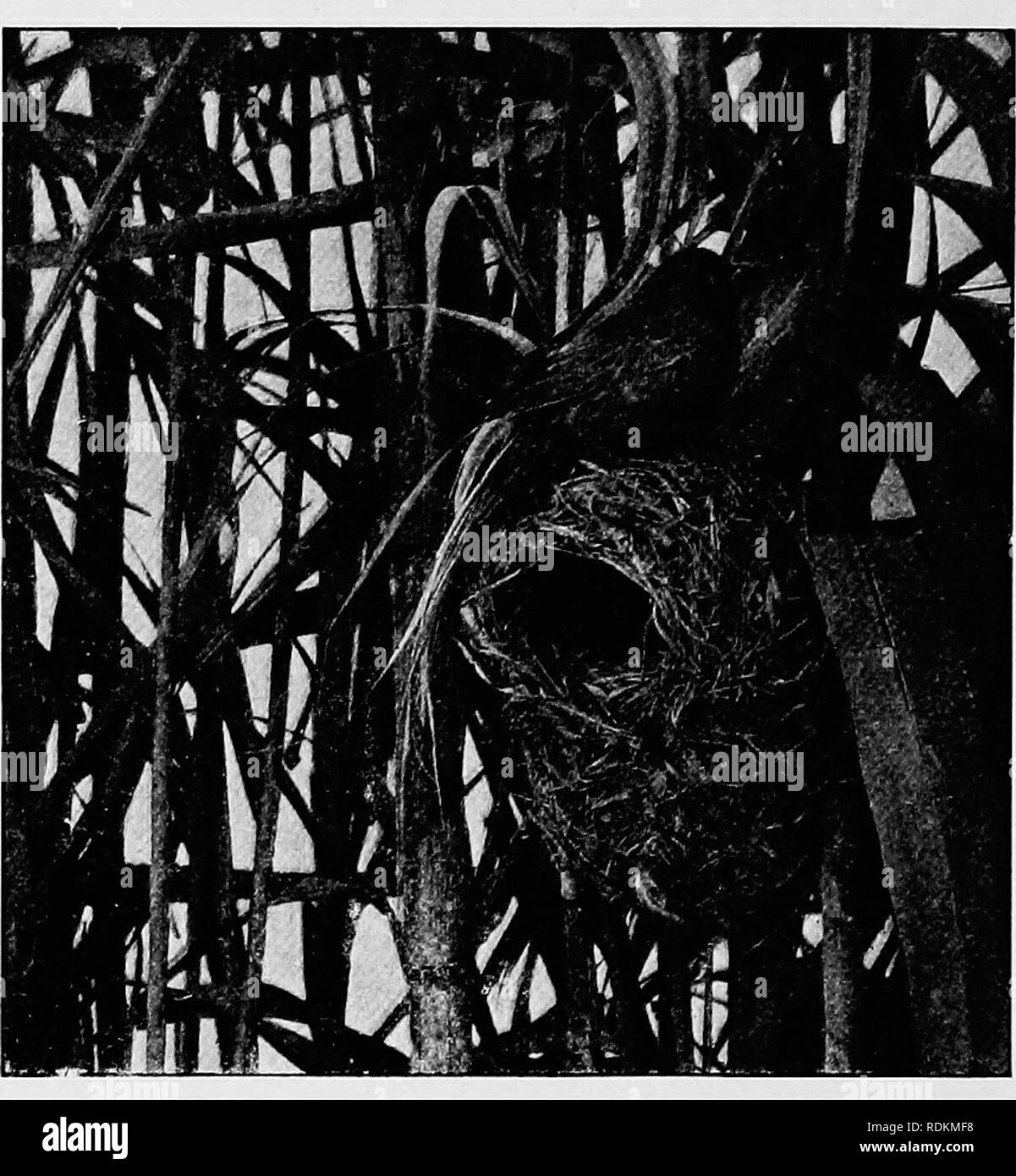 . Sketches of South African bird-life. Birds. 112 BIRD ARCHITECTS It is fond of sucking the pollen from flowers, and the feathers of the forehead are often caked with the saccharine juices.. Fig. 60.—Cape Weaver-Bird at nest. The Forest Weaver {S. gregalis) is rusty-black above and golden-yellow below. Its habitat is from Algoa Bay in the Eastern Province of the Cape to Zululand. This bird is not gregarious as its name would indicate, being found in pairs in the thickly wooded kloofs, where it suspends its necked and retort-shaped nest, woven of fine tendrils of creeping plants, high up over a Stock Photohttps://www.alamy.com/image-license-details/?v=1https://www.alamy.com/sketches-of-south-african-bird-life-birds-112-bird-architects-it-is-fond-of-sucking-the-pollen-from-flowers-and-the-feathers-of-the-forehead-are-often-caked-with-the-saccharine-juices-fig-60cape-weaver-bird-at-nest-the-forest-weaver-s-gregalis-is-rusty-black-above-and-golden-yellow-below-its-habitat-is-from-algoa-bay-in-the-eastern-province-of-the-cape-to-zululand-this-bird-is-not-gregarious-as-its-name-would-indicate-being-found-in-pairs-in-the-thickly-wooded-kloofs-where-it-suspends-its-necked-and-retort-shaped-nest-woven-of-fine-tendrils-of-creeping-plants-high-up-over-a-image232158508.html
. Sketches of South African bird-life. Birds. 112 BIRD ARCHITECTS It is fond of sucking the pollen from flowers, and the feathers of the forehead are often caked with the saccharine juices.. Fig. 60.—Cape Weaver-Bird at nest. The Forest Weaver {S. gregalis) is rusty-black above and golden-yellow below. Its habitat is from Algoa Bay in the Eastern Province of the Cape to Zululand. This bird is not gregarious as its name would indicate, being found in pairs in the thickly wooded kloofs, where it suspends its necked and retort-shaped nest, woven of fine tendrils of creeping plants, high up over a Stock Photohttps://www.alamy.com/image-license-details/?v=1https://www.alamy.com/sketches-of-south-african-bird-life-birds-112-bird-architects-it-is-fond-of-sucking-the-pollen-from-flowers-and-the-feathers-of-the-forehead-are-often-caked-with-the-saccharine-juices-fig-60cape-weaver-bird-at-nest-the-forest-weaver-s-gregalis-is-rusty-black-above-and-golden-yellow-below-its-habitat-is-from-algoa-bay-in-the-eastern-province-of-the-cape-to-zululand-this-bird-is-not-gregarious-as-its-name-would-indicate-being-found-in-pairs-in-the-thickly-wooded-kloofs-where-it-suspends-its-necked-and-retort-shaped-nest-woven-of-fine-tendrils-of-creeping-plants-high-up-over-a-image232158508.htmlRMRDKMF8–. Sketches of South African bird-life. Birds. 112 BIRD ARCHITECTS It is fond of sucking the pollen from flowers, and the feathers of the forehead are often caked with the saccharine juices.. Fig. 60.—Cape Weaver-Bird at nest. The Forest Weaver {S. gregalis) is rusty-black above and golden-yellow below. Its habitat is from Algoa Bay in the Eastern Province of the Cape to Zululand. This bird is not gregarious as its name would indicate, being found in pairs in the thickly wooded kloofs, where it suspends its necked and retort-shaped nest, woven of fine tendrils of creeping plants, high up over a